Gharial Conservation

- 20 Jun 2025
In News:
On World Crocodile Day (June 17, 2025), Etawah district in Uttar Pradesh marked the 50th anniversary of India’s pioneering Gharial Conservation Programme, commemorating five decades of sustained efforts to protect the endangered gharial (Gavialis gangeticus) along the Chambal River.
About the Gharial Conservation Programme
- Launched in: 1975
- Initiated by: Forest Department of Uttar Pradesh and Society for Conservation of Nature (SCON)
- Supported by: UNDP, FAO, and Government of India
- Location: Primarily focused on Chambal River in Etawah district, Uttar Pradesh
- Breeding Facility: Kukrail Gharial Rehabilitation Centre, Lucknow
Why Gharial Conservation Matters
- Species: Gharial (Gavialis gangeticus) — endemic, freshwater crocodilian
- Status: Critically Endangered (IUCN Red List)
- Habitat: Prefers deep, fast-flowing rivers with sandy banks and minimal human interference
- Threats: Habitat destruction, sand mining, illegal fishing, entanglement in nets, and declining fish stocks
Programme Objectives
- Protect wild gharial populations in natural river habitats.
- Enhance population through captive breeding and release.
- Study habitat biology and gharial behaviour to inform scientific conservation.
- Promote coexistence between gharials and local fishing communities.
- Create awareness and engage local populations in conservation.
Key Features of the Programme
- Egg Collection: Gharial eggs are safely collected from natural nests on riverbanks.
- Artificial Incubation: Maintained under controlled temperature and humidity to improve hatching success.
- Captive Rearing: Hatchlings are reared for 3–5 years at Kukrail Centre until they are strong enough for survival in the wild.
- Release Strategy: Tagged juveniles are released in protected stretches of the Chambal River.
- Community Involvement: Local fishermen and villagers are involved in conservation-linked livelihoods to reduce human-wildlife conflict.
Impact and Legacy (1975–2025)
- One of India’s earliest species-specific conservation programmes.
- Created a successful model of “rear-and-release” conservation.
- Helped stabilize the gharial population in Chambal, now one of the last strongholds for the species.
- Promoted community-based conservation and scientific habitat management.
Global Drought Outlook 2025
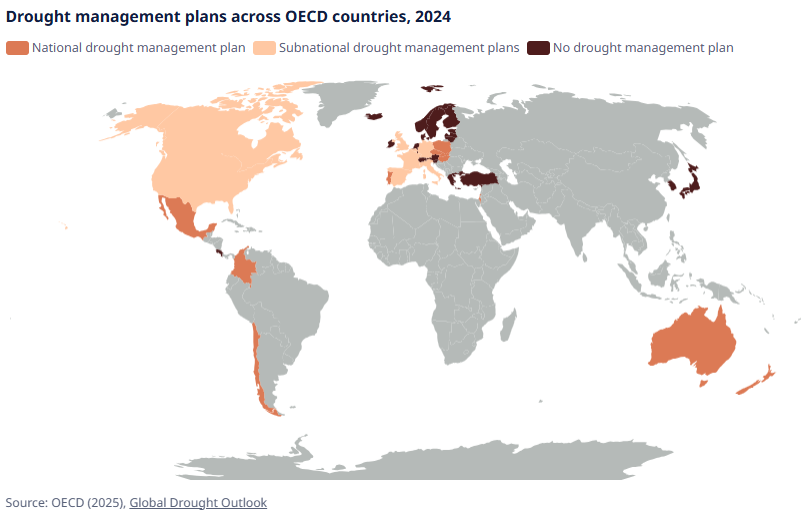
- 20 Jun 2025
In News:
- The Organisation for Economic Co-operation and Development (OECD) has released the “Global Drought Outlook 2025”, presenting a stark warning about the increasing frequency, severity, and impact of droughts worldwide.
- The report, titled “Global Drought Outlook: Trends, Impacts and Policies to Adapt to a Drier World”, offers a comprehensive assessment of drought patterns, consequences, and adaptation strategies, making it crucial for policymakers and global environmental governance.
Understanding Drought:
Drought is defined as a hydrological imbalance, characterised by prolonged periods of “drier-than-normal” conditions that deplete soil moisture, surface water, and groundwater. The report identifies three main types:
- Meteorological Drought: Caused by significantly below-average rainfall over an extended period.
- Agricultural Drought: Occurs when soil moisture becomes insufficient for crops and vegetation.
- Hydrological Drought: Involves declining water levels in rivers, lakes, and aquifers, affecting supply for human and ecological needs.
Global Trends and Projections
- Drought-Affected Land: The share of global land experiencing drought has doubled since 1900, driven by climate change and unsustainable land use.
- Current Impact (2023): Nearly 48% of the world’s land experienced at least one month of extreme drought.
- Regional Hotspots: Western USA, South America, Europe, Africa, and Australia are increasingly vulnerable.
- Groundwater Stress: Around 62% of monitored aquifers show declining trends.
- Future Risk: At +4°C global warming, droughts could become 7 times more frequent and severe by 2100, posing systemic global threats to food, water, and economic security.
Multidimensional Impacts of Drought
Ecological:
- 37% of global soils have dried significantly since 1980.
- River and groundwater depletion are threatening biodiversity and ecosystem services.
Economic:
- Drought-related losses are increasing by 3–7.5% annually.
- Modern droughts are twice as costly as in 2000; costs may rise 35% by 2035.
- Agriculture is most affected: crop yields drop up to 22% in drought years.
- Drought causes a 40% drop in river-based trade and a 25% decline in hydropower output.
Social:
- Droughts account for 34% of disaster-related deaths, though only 6% of disasters are droughts.
- It is a major driver of food insecurity, internal displacement, and climate migration, especially in Sub-Saharan Africa.
- Political instability and conflict often correlate with drought-induced resource scarcity.
Adaptation and Mitigation Strategies
The OECD emphasizes a multi-sectoral approach to manage drought risks:
- Integrated Water Resource Management (IWRM):
- Balancing water use and renewal.
- Promoting efficient and equitable water allocation.
- Nature-based Solutions (NbS):
- Urban de-sealing to enhance groundwater recharge.
- Landscape restoration to improve water retention and ecosystem resilience.
- Sustainable Agriculture:
- Adoption of drought-resistant crops and micro-irrigation systems.
- Can reduce water use by up to 76%.
- Urban Planning: Permeable infrastructure restores aquifers (e.g., US examples show 780 million m³/year recovery).
- Early Warning Systems: Enhanced drought monitoring, forecasting, and risk mapping.
- Policy Integration: Embedding climate resilience into national water and land-use policies.
- Cross-Sector Coordination: Engaging sectors like agriculture, energy, transport, construction, and health.
- Economic Benefits: Every $1 invested in drought resilience yields $2–$10 in benefits.
International Big Cat Alliance (IBCA)
- 18 Jun 2025
In News:
The first General Assembly of the International Big Cat Alliance (IBCA) was held in New Delhi, marking a significant moment in global biodiversity governance. Chaired by Union Environment Minister Bhupender Yadav, who was unanimously elected President of the IBCA, the event underscored India’s leadership in international wildlife conservation diplomacy.
What is IBCA?
- The International Big Cat Alliance (IBCA) is a multinational initiative launched by India in March 2024 to conserve the world’s seven major big cat species—Tiger, Lion, Leopard, Snow Leopard, Cheetah, Jaguar, and Puma—through collective action, knowledge exchange, and capacity building.
- It is coordinated by the National Tiger Conservation Authority (NTCA) under the Ministry of Environment, Forest and Climate Change (MoEFCC).
- The Alliance was conceptualized following Prime Minister Narendra Modi’s announcement during the 50th anniversary of Project Tiger in April 2023.
Objectives of IBCA
- Promote global collaboration for the protection and conservation of big cats.
- Replicate successful conservation practices across member nations.
- Create a common pool of financial, technical, and institutional resources.
- Address gaps in capacity building, financing, and data sharing.
- Link conservation efforts with livelihood enhancement and climate resilience in big cat habitats.
- Strengthen efforts against poaching and illegal wildlife trade through joint surveillance and data exchange.
Membership
- 95 Range Countries (where the species naturally occur) are eligible to join.
- By September 2024, 25 countries including Bangladesh, Nigeria, Peru, and Ecuador had joined.
- Membership is open to all UN member states through a Note Verbale.
- The IBCA attained legal status after five countries—Nicaragua, Eswatini, India, Somalia, and Liberia—signed the Framework Agreement.
Key Functions of IBCA
- Shared Repository: Compilation of proven conservation strategies for scalable, science-based solutions.
- Training and Capacity Building: Organizes technical workshops and institutional exchanges.
- Scientific and Policy Support: Funds research, drives policy reforms, and raises awareness.
- Technological Innovation: Introduces advanced tools to tackle habitat degradation and prey base decline.
- Sustainable Livelihoods: Integrates conservation with community-based development models.
- Anti-Poaching Collaboration: Facilitates real-time data sharing and joint actions against wildlife trafficking.
Highlights from the 2025 General Assembly
- Venue: New Delhi, India
- Participating Nations: Ministerial delegations from nine countries including Bhutan, Cambodia, Kazakhstan, Liberia, Suriname, Somalia, Republic of Guinea, Eswatini, and India.
- Institutional Milestones:
- India ratified as the permanent headquarters of IBCA.
- The Headquarters Agreement was formally ratified, enabling the establishment of IBCA offices in India.
- Leadership: Bhupender Yadav, India’s Environment Minister, was elected as the first President of IBCA.
- Funding Commitment: India pledged ?150 crore (2023–28) to support IBCA’s establishment, coordination, and conservation activities.
Significance for India and the Global South
- Reinforces India’s role as a conservation leader and soft power in environmental diplomacy.
- Positions India as the epicentre for global big cat conservation, akin to its leadership in tiger conservation under Project Tiger.
- Encourages South-South cooperation in biodiversity preservation.
- Aligns with global commitments like CBD, CITES, and SDG 15 (Life on Land).
Bonn Climate Change Conference 2025
- 18 Jun 2025
In News:
The Bonn Climate Change Conference 2025 began in Bonn, Germany, with over 5,000 delegates from governments, international organisations, civil society, and scientific bodies. It serves as a crucial platform for setting the technical and political groundwork ahead of COP29.
What is the Bonn Climate Conference?
- A mid-year climate summit held annually under the United Nations Framework Convention on Climate Change (UNFCCC).
- Also referred to as the Sessions of the UNFCCC Subsidiary Bodies (SBs).
- First held in 1995, after the UNFCCC was signed in 1992.
- Hosted in: Bonn, Germany (home of the UNFCCC headquarters).
- Organised by: The UNFCCC Secretariat.
Main Objectives
- Prepare for COP Summits: Provides a platform for technical discussions that shape the COP agenda (COP29 in this case).
- Review of Commitments: Tracks implementation of earlier climate agreements like the Paris Agreement.
- Science–Policy Integration: Connects IPCC research with policymaking processes.
- Support for Developing Nations: Discusses climate finance and technology transfer mechanisms.
- Inclusive Participation: Engages Indigenous communities, NGOs, experts, and private stakeholders.
Subsidiary Bodies of the UNFCCC
- SBI (Subsidiary Body for Implementation):
- Reviews how climate commitments are implemented.
- Facilitates support for developing countries.
- SBSTA (Subsidiary Body for Scientific and Technological Advice):
- Provides scientific guidance.
- Bridges IPCC reports with UNFCCC decision-making.
Key Focus in 2025
Global Goal on Adaptation (GGA)
- Originally mentioned in the Paris Agreement (2015).
- Received major progress only during COP28 (Dubai).
- Aim: Establish a global, measurable, and equitable adaptation framework, similar to the 1.5°C target for mitigation.
- Bonn 2025 focuses on operationalising this goal, especially for climate-vulnerable nations.
Importance of the Bonn Conference
- Pre-COP Platform: Decisions taken here set the tone and agenda for COP summits.
- Technical + Political Dialogue: Encourages cooperation between scientists, policymakers, and climate negotiators.
- Influences Global Climate Action: Outcomes impact the direction of global climate governance.
AviList
- 17 Jun 2025
In News:
Recently, the global ornithological and conservation community witnessed a landmark development with the launch of AviList, the first-ever unified global checklist of bird species. This effort is the culmination of four years of work by the Working Group on Avian Checklists, representing leading ornithological and conservation institutions.
About AviList:
- What is it? AviList is a comprehensive, standardized, and freely accessible global bird species checklist.
- Total Entries (2025 Edition):
- Species: 11,131
- Subspecies: 19,879
- Genera: 2,376
- Families: 252
- Orders: 46
- Replacing Previous Lists:
- International Ornithological Committee (IOC) List
- Clements Checklist
- Update Mechanism: To be updated annually
- Access and Formats:
- Available freely at www.avilist.org
- Downloadable in full or short versions in .xlsx and .csv formats.
Developed By:
Working Group on Avian Checklists, comprising representatives from:
- BirdLife International
- Cornell Lab of Ornithology
- American Ornithologists' Society
- International Ornithologists’ Union
- Avibase (Global Bird Database)
Significance and Benefits:
- Conservation and Research Clarity:
- A unified taxonomy helps prioritize conservation efforts by eliminating taxonomic inconsistencies.
- Scientists can now communicate uniformly on species classification and distribution.
- Global Standardization: Replaces multiple competing checklists, reducing confusion and ensuring consistency across countries and platforms.
- Interdisciplinary Use: Supports birdwatchers, scientists, policymakers, and conservationists in sharing data, linking platforms, and enhancing global collaborations.
- Improved Policy and Decision-Making: Aids in aligning biodiversity policies across nations by ensuring a standardized species concept.
- Technological Integration: Enables harmonization of databases and online tools like eBird, Avibase, and global biodiversity monitoring platforms.
Spartaeus karigiri
- 15 Jun 2025
In News:
A team of researchers has identified a new species of jumping spiders of the Spartaeinae subfamily in southern India, known for their intelligent hunting skills and web-invasion tactics.
Source: European Journal of Taxonomy (June 2025)
Key Facts:
- Species Name: Spartaeus karigiri
- Taxonomy:
- Family: Salticidae (Jumping Spiders)
- Subfamily: Spartaeinae
- Genus: Spartaeus
- Named After: Karigiri (Elephant Hill) in Devarayanadurga, Karnataka.
Significance:
- First recorded presence of Spartaeus and Sonoita genera in India.
- These genera were previously known only from Southeast Asia and Africa.
- Discovery expands India’s Spartaeinae spider fauna to 15 species across 10 genera.
Features of Spartaeus karigiri:
- Noted for intelligent hunting and web-invasion tactics.
- Possesses keen eyesight and mimics prey to deceive other spiders.
- Males were found in rocky crevices; females guarding egg clutches.
- Found in Karnataka and Villupuram, Tamil Nadu.
Other Findings:
- Sonoita cf. lightfooti, previously known from Africa, was also found in Karnataka.
- A taxonomic correction: Marpissa gangasagarensis (2005) is the same as Phaeacius fimbriatus (1900).
Conservation and Research Insight:
- India's arachnid diversity remains under-studied.
- New discoveries indicate rich but undocumented biodiversity in Indian terrains.
Ocean Darkening
- 16 Jun 2025
In News:
A recent study titled "Darkening of the Global Ocean", led by researchers from the University of Plymouth, has revealed that over 21% of the global ocean has darkened between 2003 and 2022, marking a significant environmental concern. The phenomenon, known as ocean darkening, is increasingly disrupting marine ecosystems and global climate regulation.
What is Ocean Darkening?
Ocean darkening refers to the reduction in the photic zone — the upper layer of the ocean (up to ~200 meters deep) where sunlight penetrates to support photosynthesis. This zone is foundational to:
- ~90% of marine biodiversity
- Climate regulation
- Ocean productivity
- Global fisheries
The study used satellite data and modeling based on the Diffuse Attenuation Coefficient (Kd 490), which measures how rapidly light fades through seawater. It found:
- 21% of global oceans experienced darkening in two decades.
- 9% saw photic depth decline by over 50 meters.
- 2.6% saw a reduction exceeding 100 meters — an area roughly equal to the size of Africa.
Geographic Distribution
- High darkening: Arctic, Antarctic, Gulf Stream, North Sea, eastern UK coast.
- Lesser darkening or even brightening: Some parts of the English Channel.
- The open ocean and climate-sensitive zones have witnessed the most pronounced declines.
Causes of Ocean Darkening
- Coastal Zones:
- Runoff of agricultural nutrients, organic matter, and sediments.
- Leads to algal blooms that block sunlight.
- Open Ocean:
- Shifts in plankton dynamics
- Rising sea surface temperatures
- Altered ocean circulation patterns
These changes may be linked to climate change, land-use modifications, and increased rainfall-driven erosion.
Impact on Marine Ecosystems
Ocean darkening leads to:
- Shrinking habitats for light-sensitive species like Calanus copepods (key zooplankton and food web base).
- Disrupted feeding, migration, and reproduction cycles due to reduced solar and lunar light cues.
- Increased crowding in shallower waters, intensifying competition and predation.
- Collapse of marine food chains, even in areas with minimal fishing pressure.
Experts warn that this could represent one of the largest habitat losses in recent history, with implications for:
- Biodiversity
- Carbon cycling
- Oxygen production
- Ocean buffering against climate change
State of World Marine Fishery Resources 2025
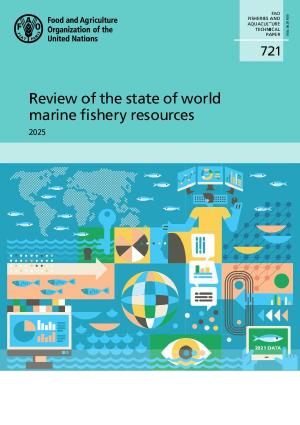
- 14 Jun 2025
In News:
The Food and Agriculture Organization’s (FAO) 2025 Report on the State of World Marine Fishery Resources, released during the UN Ocean Conference (UNOC3) in Nice, France, offers a comprehensive assessment of global fish stock sustainability, regional disparities, and governance challenges.
Key Findings:
- Global Sustainability: 64.5% of marine fishery stocks are fished within biologically sustainable levels, indicating modest improvement. However, 35.5% remain overexploited.
- Deep-Sea Species Vulnerability: Only 29% of deep-sea species are sustainably harvested, largely due to biological traits like slow growth, delayed maturity, and low reproductive rates. These characteristics impair recovery from overfishing.
- Migratory Shark Concerns: Of the 23 shark stocks assessed, 43.5% are overfished, especially in the tropical Indo-Pacific where they frequently become bycatch in tuna fisheries.
- Tuna Success Story: 87% of evaluated tuna and tuna-like species are sustainably fished, a result of effective regulation by Regional Fisheries Management Organizations (RFMOs).
- Regional Disparities: The northeast and southwest Pacific show high sustainability levels, while areas such as the Mediterranean and Black Sea lag, with only 35.1% of stocks sustainably managed.
- Data Gaps: Despite high reported sustainability (72.7%) in the eastern Indian Ocean, concerns remain due to insufficient species-specific stock assessments.
Governance and Policy Challenges:
- Illegal, Unreported and Unregulated (IUU) Fishing: Continues to threaten stock sustainability. IUU encompasses:
- Illegal: Breaches of domestic or international laws.
- Unreported: Failure to report or misreport catches.
- Unregulated: Conducted by vessels operating beyond jurisdictional authority, undermining conservation efforts.
- Subsidy Prohibitions (WTO Agreement):
- Bans financial support to vessels engaging in IUU fishing.
- Restricts subsidies for overfished stocks unless recovery measures are implemented.
- Prohibits aid for fishing in unregulated high seas zones.
Critical Analysis:
Positives:
- The rise in sustainable stocks signifies improved management awareness, particularly in regulated regions like the Pacific.
- Tuna fisheries demonstrate successful use of scientific tools—catch reporting and onboard observers—under RFMOs.
- The global survey included over 600 experts across 90 nations, lending credibility and robustness.
Negatives:
- Deep-sea stocks remain acutely overfished and biologically vulnerable.
- Shark species, integral to marine food webs, continue to suffer from bycatch and poor regulatory coverage.
- Monitoring shortfalls in Southeast Asia and African coasts prevent precise biomass estimation and conservation action.
- Weaker implementation and unregulated artisanal practices challenge sustainability in Mediterranean and Black Sea regions.
Recommendations for Sustainable Fisheries Governance:
- Empower RFMOs with real-time monitoring systems, electronic catch reporting, and observer programs.
- Adopt Ecosystem-Based Approaches that integrate climate resilience and biodiversity objectives.
- Strengthen Data Infrastructure in data-deficient regions with support from international bodies like the FAO and World Bank.
- Curtail Harmful Subsidies as per WTO protocols to reduce economic incentives driving overfishing.
- Promote Community Participation through co-management strategies and the development of Marine Protected Areas (MPAs).
Rediscovery of the Eurasian Otter in Kashmir
- 12 Jun 2025
In News:
After being presumed extinct in the Kashmir Valley for nearly three decades, the Eurasian otter (Lutra lutra) has been spotted again in the Lidder River in Srigufwara, South Kashmir. This rare sighting rekindles hope for the revival of the Valley’s aquatic biodiversity.
About Eurasian Otter:
- Common Names: Eurasian otter, European otter, Common otter, Old-World otter
- Local Name in Kashmir: Vuder
- Type: Semi-aquatic carnivorous mammal
- Distribution:
- Widely spread across Europe, the Middle East, Northern Africa, and Asia (from Eastern Russia to China).
- In India, found in northern, northeastern, and southern regions.
- In Kashmir, historically abundant in Dal Lake, Dachigam streams, Rambiara stream, and the Lidder River.
Habitat & Features:
- Habitat:
- Occupies diverse freshwater and coastal ecosystems—lakes, rivers, marshes, swamp forests, and mountain streams.
- In the Indian subcontinent, prefers cold hill and mountain waters.
- Physical Traits & Adaptations:
- Sleek brown fur (lighter underneath), long streamlined body, short legs, and thick tail.
- Aquatic adaptations:
- Webbed feet
- Ability to close ears and nostrils underwater
- Dense fur trapping air for insulation
- Excellent vision, hearing, and olfactory senses.
- Behavior: Elusive, solitary, and primarily nocturnal.
Conservation Concerns:
- Primary Threats:
- Water pollution degrading habitats
- Hunting for fur, historically significant in Kashmir
- Conservation Status:
- IUCN Red List: Near Threatened
- Wildlife Protection Act, 1972 (India): Schedule II
- CITES: Appendix I
Blue NDC Challenge
- 12 Jun 2025
In News:
At the Third United Nations Ocean Conference (UNOC3) held in Nice, France (June 9–13, 2025), Brazil and France launched the Blue NDC Challenge — a major international initiative to integrate ocean-based climate solutions into Nationally Determined Contributions (NDCs) under the Paris Agreement, in the lead-up to UNFCCC COP30, to be held in Belem, Brazil.
What is the Blue NDC Challenge?
The Blue NDC Challenge is a multilateral climate action initiative urging countries to incorporate ocean-centric measures into their updated NDCs. It aims to enhance climate mitigation and adaptation by recognizing the vital role of oceans and coastal ecosystems in addressing the climate crisis.
- Launched by: Brazil and France
- Platform: UNOC3 (June 2025)
- Target: Updated NDCs due for 2035 (deadline: February 10, 2025)
Participating Countries (as of June 2025):
- Founding: Brazil, France
- Joined: Australia, Fiji, Kenya, Mexico, Palau, Seychelles
Objectives and Key Features:
- Ocean-Integrated NDCs
- Include marine ecosystems, coastal zones, mangroves, coral reefs, and salt marshes in national climate plans.
- Integrate Marine Spatial Planning (MSP) and Integrated Coastal Zone Management (ICZM).
- Sustainable Blue Economy
- Promote climate-resilient fisheries and carbon-smart aquaculture.
- Expand clean ocean energy: offshore wind, wave, and tidal power.
- Decarbonization and Adaptation
- Phase out offshore oil and gas projects.
- Reduce emissions in shipping, seafood value chains, and coastal infrastructure.
- Boost resilience in maritime sectors vulnerable to climate risks.
- Restoration and Conservation
- Focus on the restoration of mangroves, salt marshes, and coral reefs—which are effective carbon sinks and natural buffers against sea-level rise.
- Global Partnerships and Support Mechanisms
- Supported by:
- Global Mangrove Alliance
- UN High-Level Climate Champions
- World Resources Institute (WRI)
- Ocean Breakthroughs (Marrakech Partnership for Global Climate Action)
- Supported by:
Significance and Leadership:
- Brazil’s Climate Leadership
- Brazil’s 2035 NDC (submitted in November 2024) includes, for the first time, a dedicated Ocean and Coastal Zones component.
- Brazil is also investing in marine conservation, supported by a $6.8 million fund from Bloomberg Philanthropies (June 8, 2025).
- Expert Insights:
- Mangroves sequester carbon 10 times faster than terrestrial forests.
- Including oceans in NDCs can unlock greater political and financial support, according to Conservation International and WRI.
- Emission Reduction Potential:
- According to WRI, ocean-based solutions can contribute up to 35% of the global emissions reduction needed to stay within the 1.5°C limit.
Relevance for India and the World:
- With India’s vast coastline and diverse marine ecosystems, incorporating ocean-based climate actions into its NDCs could enhance climate resilience, especially for coastal communities.
- Global focus on oceans marks a shift towards holistic climate policy, integrating land, sea, and people-centric approaches.
Discovery of Spathaspina noohi
- 11 Jun 2025
In News:
A significant addition to India's rich biodiversity has emerged from the forests of Meghalaya with the discovery of a new beetle species, Spathaspina noohi. This unique species not only adds to the biological inventory of the region but also necessitated the creation of an entirely new genus, highlighting the ecological and taxonomic uniqueness of the organism.
Location of Discovery
- The beetle was found in the Umran area of Ri Bhoi district, Meghalaya.
- Elevation: 781 metres above sea level.
- The discovery was made by S. S. Anooj, entomologist from Kerala Agricultural University, and formally described by B. Ramesha in the international journal Zootaxa.
Taxonomic Significance
- Spathaspina noohi belongs to the Curculionidae family, commonly known as weevils, which includes over 60,000 species globally.
- Due to a highly distinctive sword-like spine on its back, it was classified under a new genus—Spathaspina, a name derived from Latin:
- Spatha = sword
- Spina = spine
Subfamily and Tribe Characteristics
- The beetle falls under the Ceutorhynchinae subfamily, which includes about 1,300 species worldwide.
- The subfamily is characterized by:
- Compact, robust body
- Ability to tuck their snout (rostrum) between the front legs when resting
- A visible back structure (mesanepimera)
- Within this subfamily, the beetle is linked to the tribe Mecysmoderini, comprising 8 genera and 107 species. This tribe is noted for its thoracic spines and specialized antenna structures, mostly found in South and Southeast Asia.
Ecological Role of Weevils
While many weevils are considered agricultural pests, others, including Spathaspina noohi, play vital ecological roles such as:
- Controlling invasive plant species
- Maintaining ecosystem balance
Geographical Distribution of Ceutorhynchinae
- These beetles are present across most continents except:
- New Zealand
- Oceania
- Antarctica
- Southern parts of South America
- Their highest diversity is noted in the Palaearctic Region (Europe, North Africa, parts of Asia), followed by the Oriental Region (South and Southeast Asia).
Commemorative Naming
The species is named in honour of P. B. Nooh, IAS, Director of Tourism, Government of Kerala. This acknowledges his contribution to eco-tourism and sustainable development, symbolizing the interconnection between biodiversity conservation and responsible tourism.
Myotis himalaicus
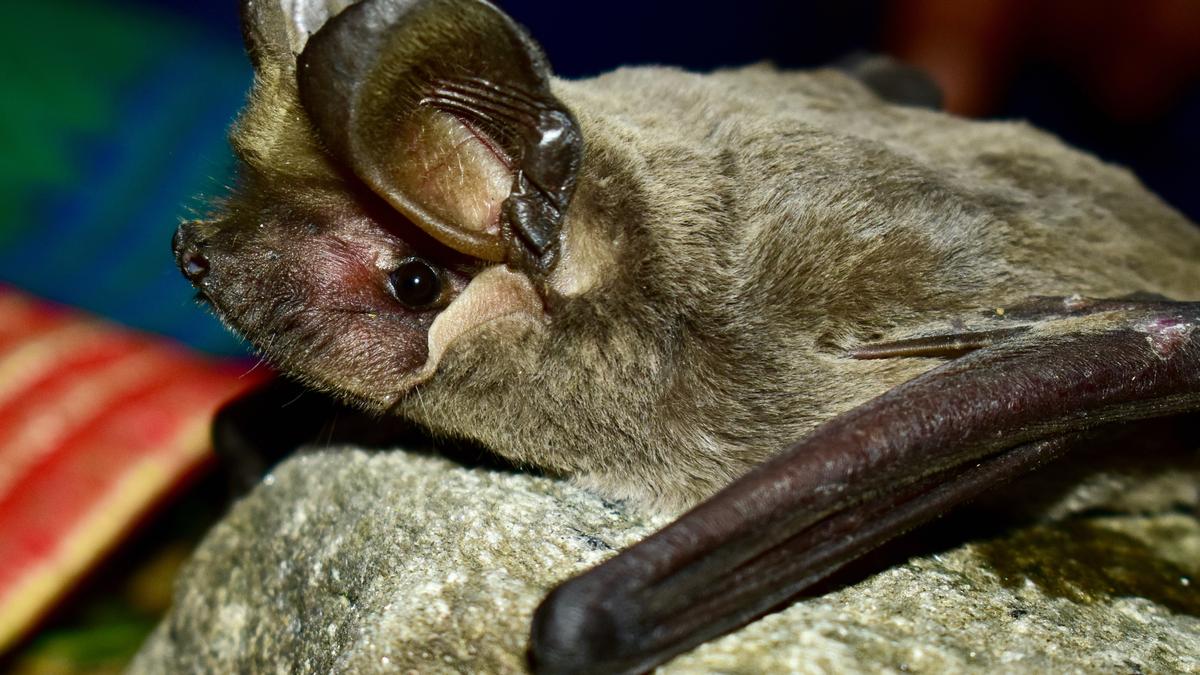
- 10 Jun 2025
In News:
A new bat species, the Himalayan Long-Tailed Myotis (Myotis himalaicus), has been described based on fieldwork in Uttarakhand and historical specimens from Pakistan. Published in Zootaxa journal by a team of Indian and international scientists.
Key Findings of the Study
- Study Area: Western Himalayas – Himachal Pradesh & Uttarakhand (2017–2021).
- Total Bat Species Documented: 29, including new records and confirmations.
- Raises India's bat species count to 135.
About Himalayan Long-Tailed Myotis (Myotis himalaicus)
Feature Description
Family/Genus Belongs to the Myotis frater complex
Habitat Deodar, pine, and cedar forests on southern Himalayan slopes
Distribution Found in Uttarakhand (India) and Khyber Pakhtunkhwa (Pakistan)
Size Medium-sized (~3.5 inches, <1 oz)
Morphology Delicate feet, long thumbs with short claws, short ears, fine teeth
Conservation Status Recently described; appears rare
Other Major Additions/Clarifications
- East Asian Free-Tailed Bat (Tadarida insignis):
- First confirmed record in India.
- Extends known range eastward by 2,500 km.
- Earlier misidentified as Tadarida teniotis.
- Babu’s Pipistrelle (Pipistrellus babu):
- Revalidated as a distinct species, not a synonym of Javan pipistrelle.
- Distribution: Pakistan, India, Nepal.
- First specimen-based confirmations in India for:
- Savi’s pipistrelle (Hypsugo savii)
- Japanese greater horseshoe bat (Rhinolophus nippon)
Ecological Importance of Bats
- Insect Control: Consume pests and mosquitoes.
- Pollination & Seed Dispersal: Important for forest regeneration.
- Fertilizer Contribution: Bat guano rich in Nitrogen & Phosphorous; boosts crop yield.
Stratospheric Aerosol Injection (SAI)
- 10 Jun 2025
In News:
A study recently published in the journal Earth’s Future offered an innovative approach to SAI technique that could reduce its costs but also bring it closer to fruition despite the opposition to it.
What is Stratospheric Aerosol Injection (SAI)?
- SAI is a proposed solar geoengineering technique to cool the Earth by injecting reflective aerosols (e.g. sulphur dioxide) into the stratosphere to reflect sunlight and reduce surface temperatures.
- Inspired by volcanic eruptions, like Mount Pinatubo (1991), which naturally cooled the Earth by emitting aerosols.
Recent Study Highlights (June 2025)
- Published in Earth’s Future journal.
- Led by Alistair Duffey, University College London.
- Used UK Earth System Model 1 (UKESM1) for climate simulations.
Key Findings
- Injecting 12 million tonnes of sulphur dioxide annually at 13 km altitude (spring/summer in each hemisphere) could cool the Earth by ~0.6°C.
- To cool by 1°C, ~21 million tonnes/year are needed at that altitude.
- Only 7.6 million tonnes/year are needed at higher altitudes (subtropics) for the same cooling.
Innovative Proposal
- Low-altitude SAI using modified existing aircraft (e.g. Boeing 777F) instead of specially designed high-altitude aircraft:
- Stratosphere is lower near poles (12–13 km), so current aircraft can reach it.
- Cost-effective and faster to deploy than high-altitude (~20 km) methods.
- Could begin within years, rather than a decade-long wait for new aircraft.
Risks and Concerns
- Tripling aerosol quantity (in low-altitude strategy) raises:
- Ozone depletion
- Acid rain
- Altered weather patterns
- Uneven global effects (benefits poles more, tropics less)
- Moral hazard: may reduce incentives to cut emissions.
- Governance challenge: One country’s action impacts all nations → risk of geopolitical conflict.
Why it matters
- Global GHG emissions are still rising.
- Climate mitigation through decarbonisation is slow and politically vulnerable.
- Technologies like SAI offer a stopgap, but not a substitute for emission cuts.
Tamhini Wildlife Sanctuary
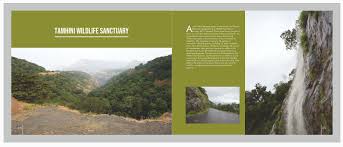
- 10 Jun 2025
In News:
The Maharashtra Forest Department partnered with Microsoft and Pune-based CYDA (Centre for Youth Development and Activities) to address the eco-restoration project in the Tamhini Wildlife Sanctuary.
Location & Geography:
- Situated in the Western Ghats, about 70 km from Pune, Maharashtra.
- Notified as a Wildlife Sanctuary in January 2013.
- Spread over 49.62 sq. km, comprising:
- 12 forest compartments from Paund and Sinhgad ranges (Pune forest division).
- 8 compartments from Mangaon range (Roha division, Thane).
Vegetation Types:
- Dominated by evergreen, semi-evergreen, and moist deciduous forests.
- Rich floral diversity including teak, bamboo, Ain, Shisham, mango, and jamun.
Biodiversity Highlights:
- Mammals (28 species):
- Includes the Indian Giant Squirrel (Shekaru) – state animal of Maharashtra.
- Also hosts Indian pangolin, barking deer, Indian civet, and wild boar.
- Home to the Kondana Soft-furred Rat (Millardia kondana) – an endangered species.
- Birds (150 species):
- Notable species: Malabar whistling thrush, golden oriole, crested serpent eagle, Indian pitta, grey junglefowl.
- Includes 12 species endemic to India.
- Insects & Others:
- 72 species of butterflies, 18 reptile species, and 33 invertebrate species.
Ecological Importance:
- Part of the Western Ghats, a globally recognized biodiversity hotspot.
- Habitat for rare, endemic, and threatened species.
- Supports vital ecosystem services, aiding in climate regulation, water conservation, and pollination.
Recent Conservation Initiative:
- A collaborative eco-restoration project was launched by the Maharashtra Forest Department, Microsoft, and CYDA (Centre for Youth Development and Activities), Pune.
- Aim: Address socio-ecological challenges, promote community engagement, and leverage technology in conservation.
Eco-tourism Potential:
- Features popular trekking and nature spots like Andharban forest, Plus Valley, and Devkund.
- Attracts high tourist footfall, especially during monsoon, including bird watchers and nature enthusiasts.
Ranthambore Tiger Reserve
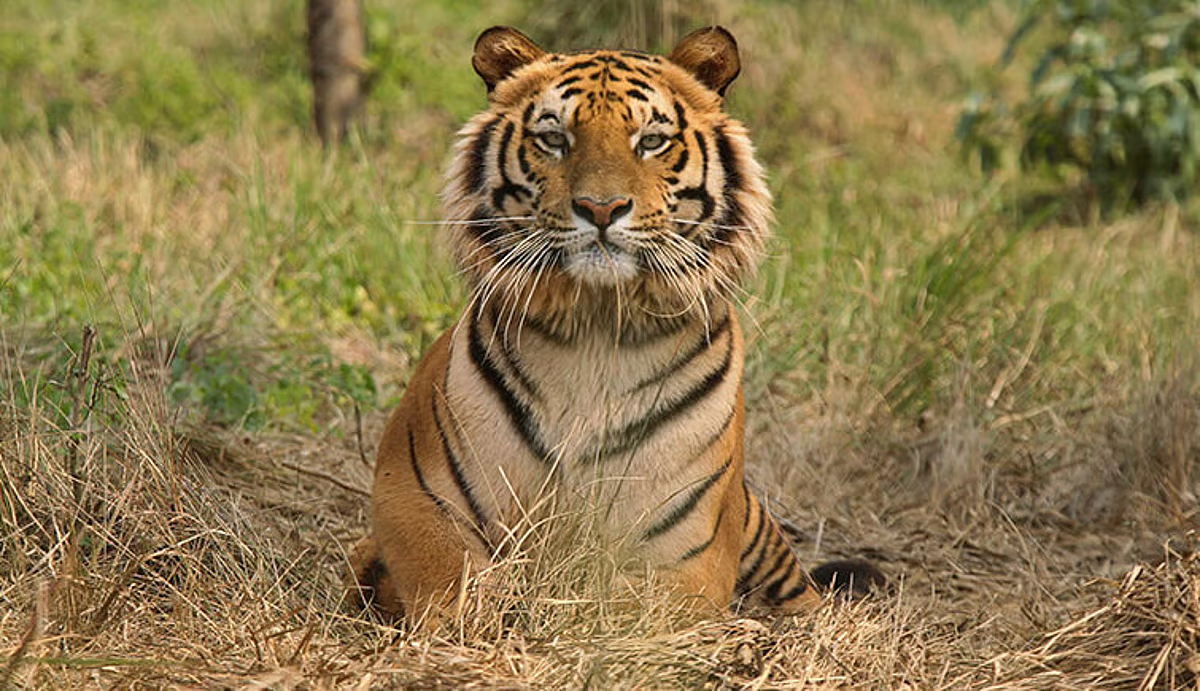
- 09 Jun 2025
In News:
The Supreme Court of India has recently ordered the Rajasthan government to impose an immediate ban on all mining activities within the core area of the Ranthambore Tiger Reserve, citing concerns over wildlife protection and habitat preservation.
About Ranthambore Tiger Reserve
- Location: Sawai Madhopur district, southeastern Rajasthan.
- Named After: Ranthambore Fort, a UNESCO World Heritage Site, located within the reserve.
- Geographical Boundaries:
- North: Bounded by the Banas River
- South: Bounded by the Chambal River
- Terrain: High rocky plateaus, valleys, rivers, lakes, and historic ruins including forts and mosques.
- Total Area: ~1,411 sq.km, making it one of the largest tiger reserves in northern India.
- Surrounding Ranges: Located at the confluence of the Aravalli and Vindhya hill ranges.
Ecology and Biodiversity
Vegetation: Dominated by dry deciduous forests and open grassy meadows.
- Flora:
- Predominantly Dhok tree (Anogeissus pendula).
- Other species: Acacia, Capparis, Zizyphus, Prosopis, etc.
Water Bodies:
- Important lakes include:
- Padam Talab
- Raj Bagh Talab
- Malik Talab
Fauna:
- Apex predator: Royal Bengal Tiger
- Other mammals:
- Leopard, Caracal, Jungle Cat
- Sambar, Chital, Chinkara, Wild Boar
Historical Significance: Previously served as the royal hunting grounds of the Maharajas of Jaipur.
Rediscovery of Losgna Genus in India
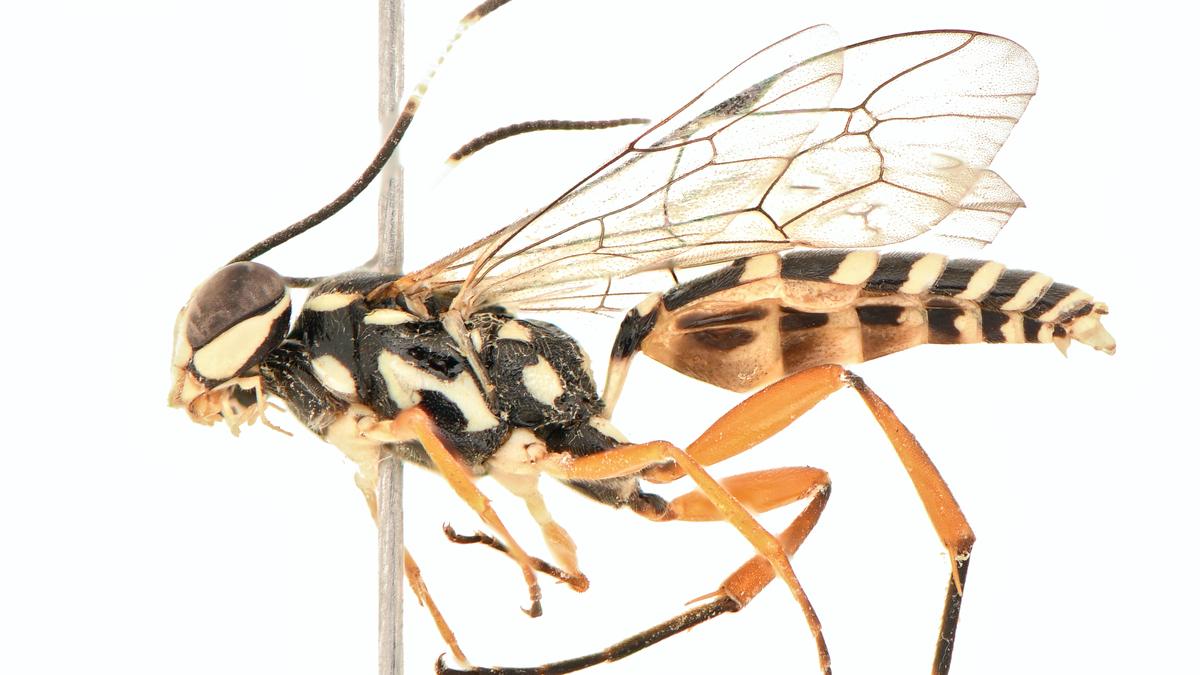
- 08 Jun 2025
In News:
At a time when habitat loss and climate change threaten countless species, the discovery of a new species of parasitic wasp - named ‘Losgna Occidentalis’ from Chandigarh has drawn attention to the unexplored richness of India’s biodiversity.
Location of Discovery
- Place: Chandigarh, Union Territory of India
- Habitat: Urban dry scrub forest
- Time: Winter of 2023–24
- Significance: First formal description of any insect species from Chandigarh
Species Description
- Name: Losgna occidentalis
- Genus: Losgna (Ichneumonidae family – Parasitic wasps)
- Group Role: Parasitic wasps known for laying eggs inside/on arthropod hosts
- Ecological Role: Pollinators and biological control agents (important in ecosystems)
Historical Context
- Losgna genus was last recorded in India in 1965, in Heinrich’s monograph
- No Indian records or specimens existed post-1965 in any institution
- Only known specimens (of other Losgna species) are preserved in:
- Natural History Museum, London
- The Hope Collection, Oxford University
- Zoologische Staatssammlung München, Germany
Naming Rationale
- "Occidentalis" (Latin for "Western")
- Signifies the westernmost known range of the genus
- Earlier Losgna records were only from:
- Northeast India
- Southeast Asia (tropical forests)
- Published in Zootaxa (peer-reviewed journal for animal taxonomy)
Importance & Implications
- Rediscovery highlights India’s hidden and threatened biodiversity
- Emphasizes the critical role of taxonomy in conservation
- Shows potential for citizen-led discoveries and backyard biodiversity
- Demonstrates the need for:
- Responsible specimen collection
- International scientific collaboration
- Support for underfunded taxonomy sectors
Indian Giant Flying Squirrel
- 13 Apr 2025
In News:
A rare sighting of the Indian Giant Flying Squirrel (Petauristaphilippensis) has been reported in Ranikhet, a hill station in Uttarakhand, highlighting the ecological richness of the region.
About Indian Giant Flying Squirrel
Feature Description
Scientific Name Petauristaphilippensis
Size Body length: 30–45 cm; Tail length: up to 60 cm
Appearance Rufous coat, grey underparts, large eyes, and a gliding membrane from wrist
to ankle
Locomotion Glides up to 60 meters between trees using patagium (gliding membrane)
Habitat and Distribution
- Found in tropical and subtropical forests across central and southern India
- Inhabits evergreen, semi-evergreen, and deciduous forests, especially near forest edges
- Recent sighting in Uttarakhand indicates possible range expansion or overlooked presence
Ecological Role
- Diet: Fruits, nuts, leaves, and bark
- Acts as a seed disperser, supporting forest regeneration
- Considered a keystone species due to its ecological significance
Behavioural Traits
- Nocturnal and arboreal
- Emits alarm calls upon detecting predators like owls
- Active at night, gliding from tree to tree in search of food
Conservation Status
Category Status
IUCN Red List (Global) Least Concern
IUCN Status (India) Near Threatened (due to habitat loss)
Wildlife Protection Act, 1972 Schedule II
Threats
- Habitat loss and fragmentation
- Deforestation and degradation of forest corridors
- Increasing human encroachment in forested landscapes
Kerala Researchers win International Grant for Hornbill Conservation
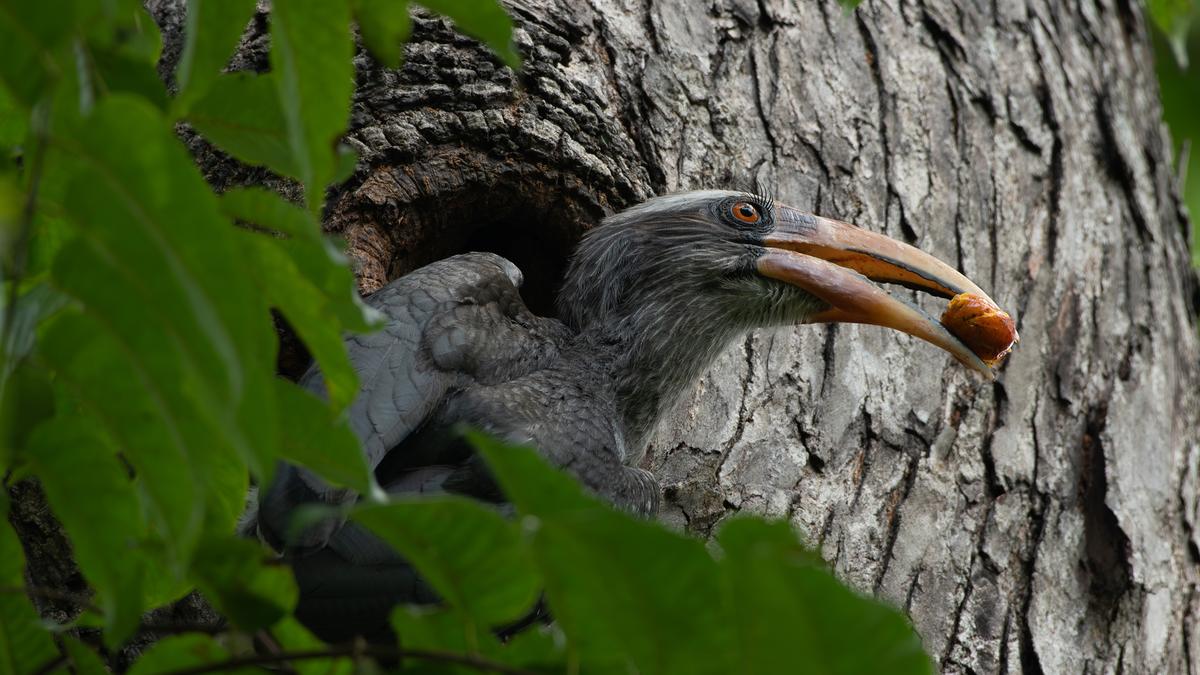
- 13 Apr 2025
In News:
A team of young researchers from Kerala has won the prestigious Future Conservationist Award by the Conservation Leadership Programme (CLP) for their community-driven project on conserving the Malabar Grey Hornbill in Wayanad.
About Malabar Grey Hornbill (Ocyceros griseus)
- Status: Vulnerable (IUCN Red List)
- Legal Protection: Schedule IV of the Wildlife Protection Act, 1972
- Endemic to: Western Ghatsand parts of the Nilgiris, Wayanad, and Anamalai Hills in Southern India.
- Habitat: Evergreen forests, plantations, and agricultural landscapes
- Ecological Importance: Cavity-nesting frugivore, plays a key role in seed dispersal
- Nesting Behavior:
- Nests in secondary cavities (e.g., old woodpecker hollows)
- Reuses the same nesting cavity for years
- Dependent on cavity-bearing trees, often outside protected areas
About the Future Conservationist Award (CLP)
- Awarded By:
- Fauna & Flora International
- BirdLife International
- Wildlife Conservation Society
- Purpose: Supports early-career conservationists with funding and mentorship
- Focus Areas: Field conservation, community engagement, biodiversity monitoring
Indian Star Tortoise
- 12 Apr 2025
In News:
In a significant conservation achievement under the Turtle Rehabilitation Project (TRP), 340 Indian Star Tortoises were successfully released into the wild at Jogapur Reserve Forest, located in Chandrapur district, Maharashtra.
Indian Star Tortoise (Geochelone elegans)
- IUCN Status:Vulnerable
- CITES Listing:Appendix I
- Protection under Indian Law:Schedule I, Wildlife (Protection) Act, 1972
Habitat & Range:
- Native to Northwest India, Southern India, and Sri Lanka
- Prefers arid and semi-arid ecosystems including scrublands, dry forests, grasslands, and semi-deserts
Key Characteristics:
- Recognizable by the radiating star-like patterns on its domed shell
- Faces high poaching pressure due to demand in the illegal exotic pet trade
- Exhibits crepuscular behavior (most active during dawn and dusk)
- Primarily herbivorous, consuming grasses, flowers, and leafy vegetation
Turtle Rehabilitation Project (TRP): A Conservation Initiative
- Launched: Late 2024; witnessed a major release event in April 2025
- Implemented By: Maharashtra Forest Department in collaboration with RESQ Charitable Trust
Objectives:
- Rescue and rehabilitate illegally trafficked tortoises and turtles
- Facilitate safe reintroduction into natural habitats through:
- Medical treatment
- Acclimatization to wild conditions
- Biometric tracking for post-release monitoring
- Raise public awareness via community engagement and school outreach
Blue Washing of Polluting Industries
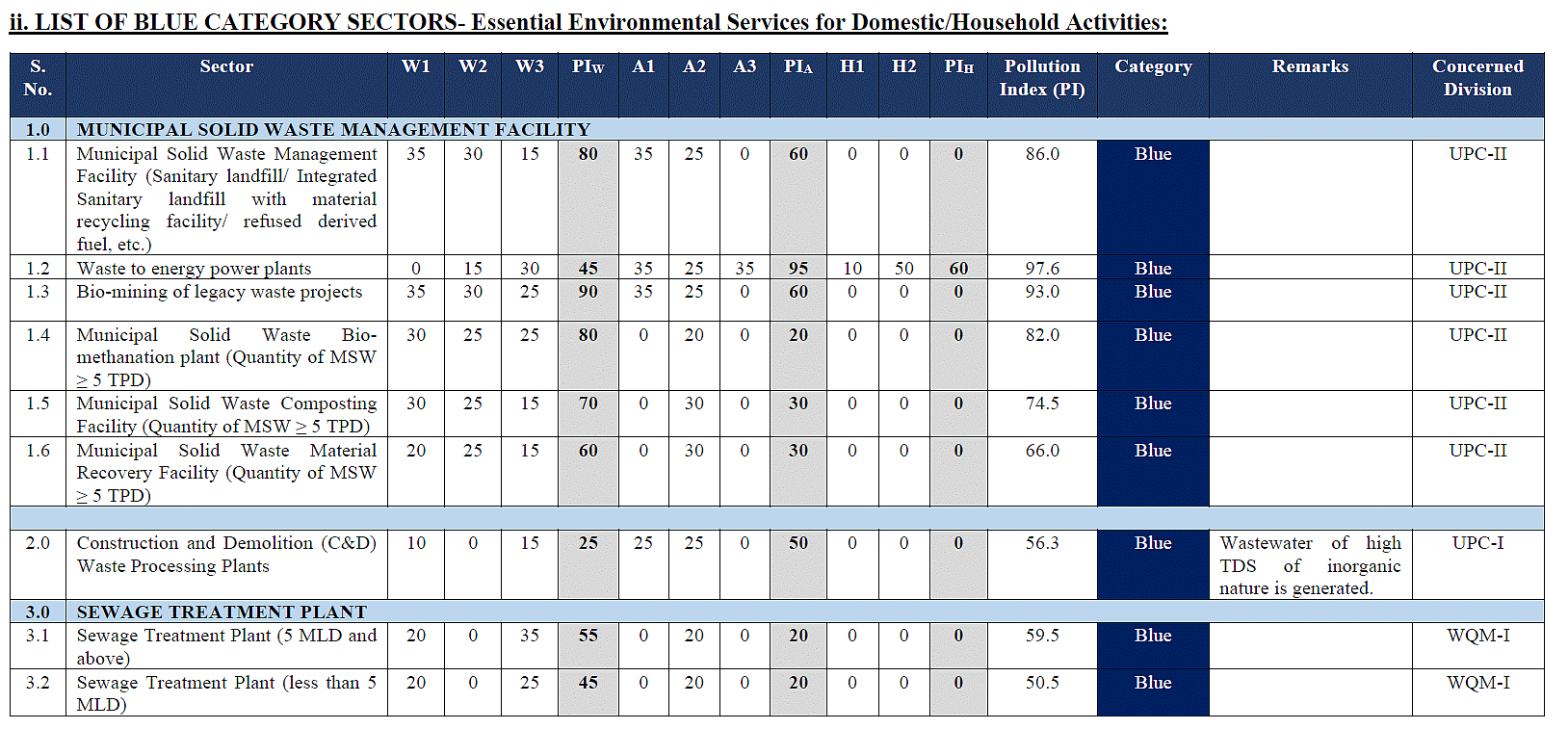
- 12 Apr 2025
In News:
- The Central Pollution Control Board (CPCB) has recently introduced a new ‘Blue Category’ for industries under its Essential Environmental Services (EES) framework.
- Notably, Waste-to-Energy (WTE) incineration plants, previously classified as highly polluting ‘Red Category’ industries, have now been controversially reclassified under this new category.
Background: Pollution Index (PI) and Industry Categorisation
- The Ministry of Environment, Forest and Climate Change (MoEFCC) classifies industries into categories — White, Green, Orange, and Red — based on a Pollution Index (PI) (0–100 scale).
- White (0–20): Least polluting
- Green (21–40)
- Orange (41–59)
- Red (60–100): Most polluting
- WTE plants, with a PI of 97.6, were originally in the Red Category.
What is the new Blue Category?
- Created under Essential Environmental Services (EES) classification.
- Grants 2 additional years of “Consent to Operate” (essentially, consent to pollute).
- Aims to support infrastructure like composting units, biogas plants, material recovery facilities, etc
Controversy: WTE Incineration in the Blue Category
- WTE plants burn unsegregated municipal solid waste (MSW) to generate electricity by producing steam to drive turbines.
- Unlike claimed benefits, WTE plants emit more CO? per unit of electricity than coal-fired plants, contributing to climate change.
- CPCB’s inspection reports found that Delhi’s WTE plants exceeded emission norms, releasing carcinogens and other pollutants such as:
- SOx, NOx, HCL, PM, Dioxins, and Furans
- In FY 2022–23, Delhi’s WTE plants incinerated ~735,840 tons of plastic, contributing significantly to Delhi’s poor air quality.
- These plants also generate hazardous ash, requiring secure landfill disposal.
Issues with Reclassification
- The CPCB’s own guidelines state that:
- Only projects that do not emit hazardous waste or
- Projects that promote the circular economy can be blue-listed.
- However, leading government institute CSIR-NEERI has observed that WTE plants violate the principles of the circular economy and contravene Solid Waste Management Rules, 2016.
- Reclassification undermines environmental safeguards, harms waste pickers’ livelihoods, and imposes financial burdens on Urban Local Bodies (ULBs).
Greater Flamingo Sanctuary
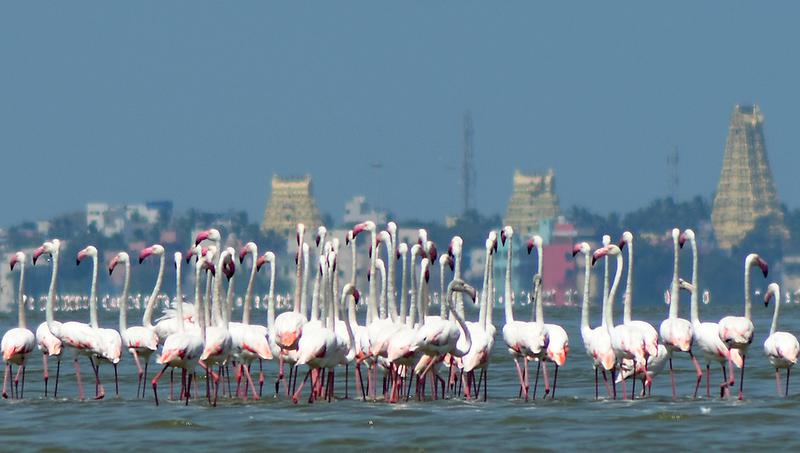
- 07 Jun 2025
In News:
On the occasion of World Environment Day 2025, the Tamil Nadu government officially declared the Greater Flamingo Sanctuary at Dhanushkodi, Ramanathapuram district, aiming to protect a vital stopover site for migratory birds along the Central Asian Flyway.
Key Highlights
What is it?
A newly notified wildlife sanctuary dedicated to safeguarding migratory wetland birds, especially the greater flamingo (Phoenicopterus roseus), in their natural resting and breeding habitat.
Location and Area:
- Located in Rameshwaram taluk, Ramanathapuram district, Tamil Nadu.
- Covers approximately 524.7 hectares of revenue and forest land.
- Lies within the Gulf of Mannar Biosphere Reserve, a globally recognized marine ecosystem.
Ecological Significance
- Functions as a critical site along the Central Asian Flyway, one of the key migratory bird routes.
- As per the 2023–24 Wetland Bird Survey, the region hosts 10,700+ wetland birds representing 128 species, including:
- Flamingos (greater and lesser)
- Herons, egrets, sandpipers, etc.
- The sanctuary harbours diverse ecosystems, such as:
- Mangroves (Avicennia, Rhizophora)
- Mudflats, marshes, sand dunes, and lagoons
- Nesting grounds for sea turtles and marine biodiversity
Conservation and Socioeconomic Benefits
- Strengthens coastal resilience by preventing erosion through natural mangrove buffers.
- Promotes responsible ecotourism, raising awareness of wetland and avian conservation.
- Supports local livelihoods via employment in conservation and tourism activities.
About the Greater Flamingo (Phoenicopterus roseus)
Attribute Details
Size 90–150 cm tall, long necks and legs
Coloration Pink hue from carotenoid-rich diet
Feeding Uses specialized downward-curved bill for filter feeding in shallow waters
Reproduction Builds cone-shaped mud nests, lays 1–2 eggs, both parents incubate
Chick Rearing Chicks are white and fed through regurgitation
Social Traits Highly gregarious, breeds in large colonies and flies in V-formations
Behavioral Note Often seen standing on one leg, possibly to conserve body heat
EnviStats India 2025
- 06 Jun 2025
In News:
India's annual mean temperature rise up from 25.05°C in 2001 to 25.74°C in 2024, Electricity generation from renewable sources increased more than three times in 10 years.
- Released by: Ministry of Statistics and Programme Implementation (MoSPI) on June 5, 2025, on the occasion of World Environment Day
- Framework Used: UN's Framework for the Development of Environment Statistics (FDES 2013)
Key Highlights:
Climate Trends
- Annual Mean Temperature rose from 25.05°C (2001) to 25.74°C (2024).
- 2024 recorded as India’s hottest year since 1901; also, globally the hottest year in 175 years.
- Annual Minimum and Maximum Temperatures (2021–24):
- Minimum: 19.32°C → 20.24°C
- Maximum: 30.78°C → 31.25°C
Rainfall Patterns
- Rainfall shows seasonal concentration between June–September, with signs of shifting patterns such as late onset or extended rains into October.
- No clear long-term trend, reflecting erratic monsoonal behaviour.
Energy Generation
Thermal & Renewable Power (2013–14 to 2023–24)
- Thermal: 7.92 lakh GWh → 13.26 lakh GWh
- Renewable: 65,520 GWh → 2.25 lakh GWh, over 3x increase in renewable energy output in a decade.
Biodiversity and Faunal Statistics
Faunal Diversity
- Global Faunal Species: 16,73,627
- India's Share: 1,04,561 species
- Habitat-specific Species in India:
- Soil Ecosystem: 22,404
- Freshwater Ecosystem: 9,436
- Mangrove System: 5,023
- Estuarine Ecosystem: 3,383
- Marine Fauna (India): 20,613 out of global 2,47,605
Fisheries Production
Inland vs. Marine Fish (2013–14 to 2023–24)
- Inland Fish Production: 61 lakh tonnes → 139 lakh tonnes
- Marine Fish Production: 34 lakh tonnes → 45 lakh tonnes
Public Expenditure (2021–22)
- Environment Sustainability Sector: ?2,433 crore (highest among sectors)
- Conservation of Natural Resources: Increasing trend
- Agro-Forestry: Lowest allocation
New Data indicators introduced
- Ramsar sites
- Access to sanitation
- Transport infrastructure
- Electricity access
Kichan and Menar Wetlands
- 05 Jun 2025
In News:
Recently, the Union Ministry of Environment announced that Kichan (Phalodi) and Menar (Udaipur) wetlands in Rajasthan have been recognized as Ramsar Sites, bringing India’s total to 91 Ramsar-designated wetlands—the highest in Asia.
About Menar Wetland:
- A freshwater monsoon wetland complex in Udaipur district, Rajasthan.
- Formed by three primary ponds: Braham Talab, Dhand Talab, and Kheroda Talab; the latter two are connected by flooded agricultural land during the monsoon.
- Habitat for endangered and migratory birds such as:
- Critically Endangered: White-rumped vulture (Gyps bengalensis), Long-billed vulture (Gyps indicus)
- Other species: Himalayan griffon, Egyptian vulture, Dalmatian pelican, Ferruginous pochard, Black-tailed godwit
- Home to over 70 plant species, including mango trees (Mangifera indica) that host colonies of Indian flying foxes (Pteropus giganteus).
- Community-led conservation: Menar village residents prevent poaching and fishing, earning it the title "Bird Village".
About Kichan Wetland:
- Located in Phalodi, Jodhpur, in the northern Thar Desert of Rajasthan.
- Comprises:
- Ratri Nadi (river)
- Vijaysagar Talab (pond)
- Riparian and scrub habitats
- Notable for supporting drought-resistant flora and over 150 bird species.
- Globally known for hosting over 22,000 migratory demoiselle cranes (Anthropoides virgo) each winter.
- A hub for birdwatchers, tourists, scientists, and students.
Ramsar Convention Overview:
- An intergovernmental treaty for the conservation of wetlands, signed in 1971 in Ramsar, Iran.
- Headquartered in Gland, Switzerland.
- Wetlands listed under the convention are known as Ramsar Sites—of international importance.
- Member countries (Contracting Parties) commit to identifying and protecting these wetlands.
World Environment Day 2025
- 05 Jun 2025
In News:
Every year on June 5, people across the globe unite to celebrate World Environment Day, an initiative led by the United Nations Environment Programme (UNEP).
Key Highlights:
- Observed on: June 5 annually
- Initiated by: United Nations Environment Programme (UNEP)
- First celebrated: 1973 (following the 1972 Stockholm Conference on the Human Environment)
- Objective: Promote global awareness and action for environmental protection
Theme for 2025: "Beat Plastic Pollution"
- Focuses on the escalating crisis of plastic pollution and its adverse impact on ecosystems, wildlife, and human health.
- Highlights the need to transition away from single-use plastics, promote sustainable consumption, and adopt eco-friendly alternatives.
Key Statistics:
- Plastic production: Increased from 2 million tonnes (1950) to 430 million tonnes (2025)
- Marine pollution:19–23 million tonnes of plastic enter aquatic ecosystems annually
- Microplastics detected in oceans, mountains, and the human body
Host Country for 2025: Republic of Korea
- Chosen for its leadership in green innovation and sustainable practices.
- Initiatives include:
- Advanced waste segregation and recycling systems
- Bans on single-use plastics in major outlets
- Promotion of tech-driven eco-solutions
By hosting, South Korea aims to showcase scalable models for combating plastic pollution globally.
Historical Background
- Stockholm Conference 1972 laid the foundation for modern environmental governance.
- UNEP assigns a theme and host country annually to align global action.
- Over 150 countries now participate through:
- Clean-up drives
- Tree plantation campaigns
- Policy forums
- Environmental education programs
Significance
World Environment Day plays a vital role in:
- Raising awareness on climate change, pollution, deforestation, and sustainability
- Encouraging individual and community-level action
- Facilitating policy dialogue and regulatory reform
- Mobilizing youth leadership in environmental movements
Caspian Gull (Laruscachinnans)

- 04 Jun 2025
In News:
In a significant ornithological development, the Caspian Gull, one of the rarest gull species to be recorded in India, was positively identified five years after being sighted at Kappad Beach, Kozhikode, Kerala. This marks the first confirmed sighting of the species in Kerala, and only the second in southern India.
Discovery and Identification:
- Ornithologist Abdulla Paleri first spotted the bird in February 2020 but took five years to confirm its identity due to its close resemblance to the more commonly seen Steppe Gull.
- The Caspian Gull differs subtly in features such as head and beak shape, posture, wing pattern, and leg morphology.
- Images were shared with international experts and on the eBird platform, where ornithologists Oscar Campbell and Hans Larsson confirmed the identification. The sighting has remained unchallenged since.
About Caspian Gull (Laruscachinnans):
- A monotypic, large, white-headed gull species, considered rare in India.
- Regularly breeds in Central Asia, particularly in steppe and semi-desert habitats with lakes, rivers, and reservoirs.
- Nesting usually occurs on flat, low-lying areas near water bodies, often surrounded by reedbeds.
- The species feeds on fish, insects, molluscs, and other invertebrates.
Migration Pattern:
- It migrates from the Black Sea and Caspian Sea region to southern and eastern Kazakhstan, western China, and parts of South Asia during winter.
- Traditionally winters in the eastern Mediterranean, Persian Gulf, and western India (like Gujarat).
- Increasingly, small populations are dispersing into Europe, including Sweden, Norway, and Denmark.
- The Kozhikode gull is believed to be a straggler—a bird that deviates from its usual migratory route.
Conservation Status:
- IUCN Red List:Least Concern, Despite its rarity in India, the species is not globally threatened.
Jharkhand’s First Tiger Safari
- 03 Jun 2025
In News:
The Jharkhand government has proposed setting up its first-ever tiger safari in the fringe area of the Palamau Tiger Reserve (PTR), located in Latehar district. This initiative aims to promote wildlife education, conservation awareness, and eco-tourism, while also creating employment opportunities.
What is a Tiger Safari?
A tiger safari refers to a tourism model where rescued, conflict-prone, or orphaned tigers are housed in naturalistic enclosures, ensuring sightings for visitors. It differs from traditional wild safaris, where sightings are not guaranteed. The concept was first proposed in the NTCA's 2012 tourism guidelines, refined in 2016, and later aligned with the Supreme Court’s 2024 directive, which mandates that such safaris be located outside core and buffer zones of tiger reserves.
Legal and Regulatory Framework
- Governed by:
- Wildlife (Protection) Act, 1972
- National Tiger Conservation Authority (NTCA) Guidelines (2012, 2016)
- Central Zoo Authority (CZA) for animal welfare, enclosure design, and project compliance
- Supreme Court Ruling (March 2024):
- Tiger safaris must not be located inside core or buffer zones.
- Intended to protect natural habitats and uphold conservation goals.
About Palamau Tiger Reserve (PTR)
- Established: 1974 under Project Tiger
- Location: Chhotanagpur Plateau, Jharkhand
- Rivers: North Koel, Burha (perennial), Auranga
- Vegetation: Northern Tropical Dry Deciduous forest (Sal-dominated)
- Key Fauna: Bengal Tiger, Asiatic Elephant, Sloth Bear, Leopard, Indian Pangolin, Otter
- Historical Note: Site of the world’s first pugmark-based tiger census (1932)
Project Details
- Location: Barwadih Western Forest Range (fringe of PTR, outside core/buffer zones)
- Size: Approx. 150 hectares
- Animals Housed: Only rescued, conflict-prone, or orphaned tigers from reserves/zoos (not wild or zoo-bred tigers unless approved)
- Objectives:
- Promote tourism and conservation education
- Create an experiential learning space for visitors
- Generate employment (~200 local jobs)
The Central Zoo Authority (CZA) will assess the site and species selection. Post Forest Department clearance, the Detailed Project Report (DPR) will be submitted to NTCA and CZA. Approvals may take 5–6 months, followed by a construction period of ~18 months.
Concerns and Challenges
- Tribal and Community Rights:Activists caution that such projects may marginalize forest-dwelling communities and restrict access to traditional forest-based livelihoods (grazing, NTFP collection).
- Consent of Local Communities:As per the Forest Rights Act, projects on forest land must involve Gram Sabha consultation. Activists argue this has yet to be fully addressed.
- State's Clarification:Officials maintain that the site lies on forest land under state management, with no expected displacement.
Sabine’s Gull Spotted at Nalsarovar
- 03 Jun 2025
In News:
In a remarkable ornithological event, the Sabine’s Gull — a rare Arctic seabird — has been observed at Nalsarovar Bird Sanctuary in Gujarat. This marks the species’ first recorded appearance in India since 2013, when it was last sighted in Kerala, underlining the dynamic migratory patterns affecting India’s wetland ecosystems.
About Nalsarovar Bird Sanctuary
- Located nearly 64 km west of Ahmedabad, Nalsarovar Bird Sanctuary is one of Gujarat’s most prominent wetland ecosystems. Encompassing an area of 120.82 sq km, it comprises a shallow, seasonal lake interspersed with around 360 islets, creating a rich mosaic of aquatic habitats.
- This natural lake traces its origin to the 15th century, following the construction of a check dam on the Sabarmati River. Initially designed to serve irrigation and drinking water needs of nearby villages, the lake gradually evolved into a crucial habitat for avifauna. Recognition of its ecological significance grew over time, prompting colonial authorities in the early 20th century to take protective measures.
- Eventually, in 1969, the Government of Gujarat declared Nalsarovar a bird sanctuary, and it was further accorded the status of a Ramsar wetland site in 2012, signifying its global importance under the Ramsar Convention.
- Flora: The sanctuary supports a wide variety of aquatic and wetland plant life, with 48 algae species and 72 flowering plant species recorded. Common plant species include Cyperus, Scirpus, Typha ungustata, Eleocharis palustris, Ruppia, Potamogeton, Vallisneria, Naias, and Chara.
- Fauna:Nalsarovar is home to nearly 250 bird species, making it a haven for bird watchers. Regular sightings include both greater and lesser flamingos, pelicans, ducks, geese, coots, rails, cranes, and a variety of wading and aquatic birds like herons, egrets, storks, spoonbills, and sarus cranes.
- Beyond birds, the sanctuary also supports mammalian fauna. On its southern and southwestern peripheries, species such as the Indian wild ass, mongoose, jungle cat, Indian fox, jackal, wolf, and striped hyena are found.
Sabine’s Gull: Profile
- The Sabine’s Gull (Xemasabini), also known as the fork-tailed gull or xeme, is a small gull species notable for its elegant flight and distinctive wing markings. Adults can be recognized by their pale grey backs, black wingtips, white secondary feathers, and forked white tails.
- This gull breeds in high Arctic and subarctic zones across North America, Russia, Greenland, and Svalbard, and is a rare migrant in South Asia.
- According to the IUCN Red List, it is currently categorized as a species of Least Concern, although sightings in India are extremely uncommon.
Kawal Tiger Reserve and KumramBheem Conservation Reserve
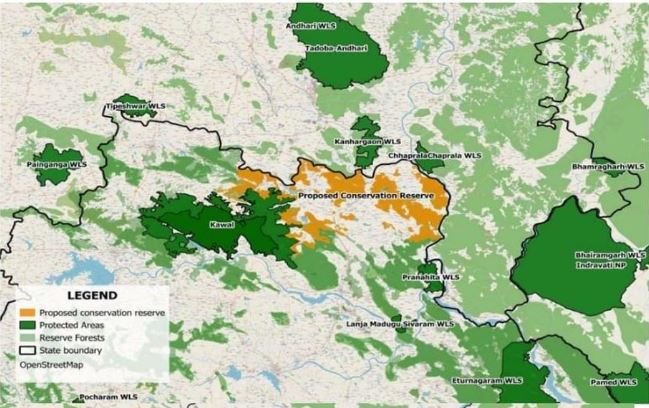
- 02 Jun 2025
In News:
In a recent development, the Telangana government has designated the tiger corridor connecting the Kawal Tiger Reserve (Telangana) with the Tadoba-Andhari Tiger Reserve (Maharashtra) as the KumramBheem Conservation Reserve, under Section 36(A) of the Wildlife Protection Act, 1972. This move is aimed at preserving critical wildlife corridors in the Central Indian Landscape.
Kawal Tiger Reserve:
- Location: Situated in Telangana, along the Godavari River, forming part of the Deccan Peninsula – Central Highlands.
- Biogeographic Zone: Lies at the southern tip of the Central Indian Tiger Landscape.
- Connectivity: Links with Tadoba-Andhari (Maharashtra), Indravati (Chhattisgarh), and other reserves like Tipeshwar, Chaprala, and Kanhargaon.
- Vegetation Type: Southern Tropical Dry Deciduous Forests.
- Flora: Dominated by teak, bamboo, and species like Anogeissuslatifolia, Terminalia arjuna, Boswellia serrata, etc.
- Fauna: Hosts tiger, leopard, nilgai, chinkara, sambar, blackbuck, wild dog, wolf, and jungle cat.
KumramBheem Conservation Reserve: Newly Notified Area
- Legal Basis: Declared under Section 36(A), Wildlife Protection Act, 1972, which allows states to notify government-owned land adjacent to or connecting protected areas as conservation reserves.
- Total Area: 1,492.88 sq km (149,288.48 hectares)
- District &Mandals Covered: Spread across KumramBheemAsifabad district, covering parts of Kerameri, Wankidi, Asifabad, Sirpur, Koutala, Bejjur, Kagaznagar, Rebbana, Dahegaon, and Tiryanimandals.
- Forest Blocks Included: 78 blocks including Garlapet, Ada, Manikgarh East & West, Danora, Gudem, Bejjur, Kadamba, and Girali.
Ecological Significance
- Tiger Movement: Over the last decade, more than 45 unique tigers (mostly transient) have been documented in this corridor through camera trapping and surveys.
- Breeding Evidence: Since 2015, 17 tiger cubs born from 3 tigresses have been recorded. The 2022 Tiger Census confirmed 4 adult tigers and 3 cubs in the area.
- Leopard Presence: 8 leopards were recorded during the All India Leopard Estimation, 2022.
- Other Carnivores: Includes sloth bear, hyena, wild dog, wolf, honey badger, and jungle cat.
- Herbivore Diversity: Rich prey base such as gaur, sambar, nilgai, chital, muntjac, four-horned antelope, and Indian gazelle.
- Avifauna: Home to 240+ bird species, including rare species like the Malabar Pied Hornbill and Long-billed Vulture, the latter using the reserve as a nesting site.
- Elephant Movement: Occasional elephant presence has also been reported.
Governance
A Conservation Reserve Management Committee has been established. Members include:
- District Forest Officer (DFO) of KumramBheemAsifabad (Convenor)
- Sarpanches of local panchayats (e.g., Karji, Motlaguda, Murliguda)
- Representatives from NGOs like Hyderabad Tiger Conservation Society, WWF-India, and Wildlife Conservation Trust
- Officials from Veterinary, Agriculture, and Forest Divisions
Perito Moreno Glacier

- 01 Jun 2025
In News:
- The Perito Moreno Glacier, often referred to as the ‘White Giant’, is Argentina’s most iconic glacier, located in the Los Glaciares National Park, a UNESCO World Heritage Site.
- Situated in the Andes Mountains, near El Calafate in Santa Cruz province, this glacier spans approximately 250 sq km—about the size of Patna, Bihar—and stretches 30 km in length, with ice walls rising 60 meters above water.
- Formed during the last Ice Age (~18,000 years ago), Perito Moreno has historically remained unusually stable, defying the global trend of rapid glacier retreat. However, this stability changed around 2020, raising alarms among scientists.
Recent Developments and Ice Calving Events
- Perito Moreno is globally renowned for its ice calving events, where massive blocks of ice break off into the lake with thunderous crashes. These events, though natural due to the glacier’s forward motion, have recently become more intense.
- On April 21, 2025, a colossal ice chunk the size of a 20-story building plunged 70 meters into the water—an increasingly frequent occurrence in the past 4–6 years.
- According to local experts and a 2024 government-backed report, the glacier has been retreating steadily since 2015, with an average mass loss of 0.85 meters annually—the fastest in nearly five decades.
- Between 2020 and 2023, the glacier lost over 700 meters of mass, equivalent to around seven large ice blocks.
Causes: Global Warming & Climate Impact
- The primary cause behind this dramatic retreat is climate change. Scientists from IANIGLA (Argentine Institute of Glaciology and Environmental Sciences) and CONICET state that the region has experienced an air temperature rise of 0.06°C per decade and reduced precipitation, leading to less snow accumulation and thinning of the glacier.
Global Perspective on Glacier Retreat
Perito Moreno is now part of a larger, alarming global trend.
- A 2024 study in Nature estimates that glaciers worldwide are losing 273 billion tonnes of ice annually, contributing to a 2 cm rise in global sea levels this century alone.
- A UNESCO report (March 2025) highlighted that glaciers (excluding Greenland and Antarctica) have shed over 9,000 billion tonnes of ice since 1975—comparable to an ice block the size of Germany with 25 meters thickness.
Environmental Significance
- Freshwater Source: Perito Moreno is a major reservoir of freshwater in Argentina.
- Tourism: The glacier attracts global tourists, boosting the local economy.
- Climate Indicator: Its recent retreat reflects the delayed but accelerating impact of global warming, making it a critical environmental bellwether.
Theobaldius konkanensis
- 09 Apr 2025
In News:
A new species of land snail, Theobaldius konkanensis, has been discovered by a collaborative team of Indian and UK researchers from the Konkan region of Maharashtra. This species adds to the growing biodiversity records of the northern Western Ghats, a globally recognized but under-explored biodiversity hotspot.
Key Facts at a Glance
- Scientific Name: Theobaldius konkanensis
- Discovered in: Ratnagiri and Raigad districts, Maharashtra (Dev Gireshwar Temple, Uttamrao Patil Biodiversity Garden, Kesharnath Vishnu Temple, and Phansad Sanctuary)
- Elevation: 80–240 metres above sea level
- Habitat: Tropical evergreen and semi-evergreen forests
- Active Months: June to September (monsoon); only shells visible in other months
- Habits: Active both day and night, often under forest canopy in shaded, moist leaf litter
Morphological Features
- Shell Characteristics:
- Slightly flattened with a raised centre and deep triangular notch near the aperture
- Operculum (protective cover) has raised whorl edges and short spines
- Corneous yellow with brown striations
- Thick, conoidally depressed, and widely umbilicated
- Body: Stout and rounded
Taxonomic Context
- Family: Cyclophoridae (Caenogastropoda)
- Genus: Theobaldius
- Now includes 20 species: 9 in India, 11 in Sri Lanka, and 1 in Sumatra (Indonesia)
- In India, 6 species are endemic to the Western Ghats
- Only T. annulatus is found in both Sri Lanka and the Western Ghats
Ecological and Conservation Significance
- Bioindicators: Land snails are sensitive to climatic changes and environmental disturbances
- Endemism: T. konkanensis is restricted to specific forest patches in the Konkan, highlighting the ecological uniqueness of the region
- Threats: Increasing anthropogenic pressures and habitat degradation threaten snail species with restricted distribution
Reproductive Biology (General Traits of Land Snails)
- Breeding mainly in monsoon
- Reproduce through both cross- and self-fertilisation
- Courtship includes dart-shooting behavior; mating may last hours
- Eggs laid in moist soil or leaf litter; hatch in 2–4 weeks
- Lifespan: 2 to 7 years
Woolly Flying Squirrel
- 08 Apr 2025
In News:
The Wildlife Wing of the Himachal Pradesh Forest Department (HPFD) has recently documented the first-ever photographic evidence of the Woolly Flying Squirrel in Miyar Valley, located in the Lahaul and Spiti district. This marks a significant discovery, as the species is extremely elusive and rarely sighted.
About Woolly Flying Squirrel
- Common Name: Woolly Flying Squirrel / Western Woolly Flying Squirrel
- Scientific Name: Eupetaurus cinereus
- Taxonomy: The only known species under the genus Eupetaurus
- Conservation Status: Listed as Endangered on the IUCN Red List
Habitat and Distribution
- Endemism: Confined to the northwestern Himalayas
- Countries Found: Northern Pakistan and northwestern India
- Habitat Type: Inhabits a narrow elevational range within dry coniferous forests, typically in fragmented habitats
- Historical Records:
- Rediscovered in 1994, nearly 70 years after it was presumed extinct
- Since then, reported from Sai Valley, Gorabad, and Balti Gali in northern Pakistan
Key Characteristics
- Equipped with patagium (elastic skin membrane) that connects the forelimbs and hind limbs, enabling gliding—typical of flying squirrels
- Fur: Dense, straight, and silky
- Dorsal side: Blue-gray
- Ventral side: Pale gray
- Throat and ears: Covered in creamy white hairs
- Feet soles: Dense black fur, except for bare pinkish-brown toe pads
Calotes zolaiking
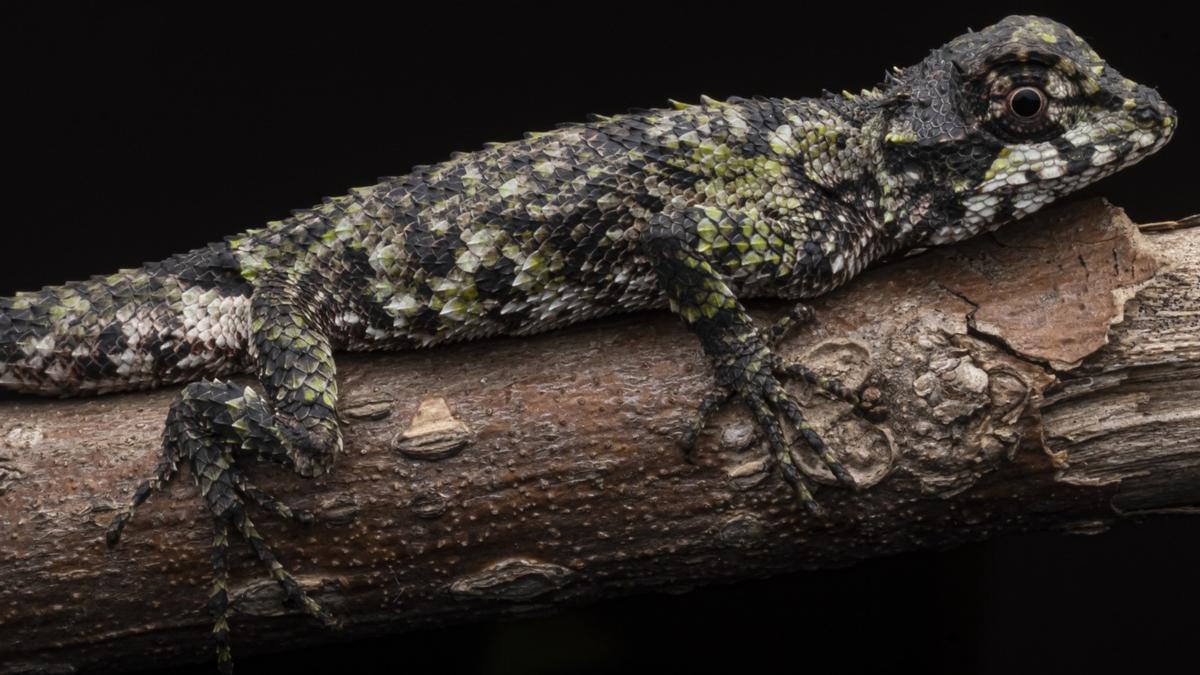
- 31 May 2025
In News:
The rare lizard species Calotes zolaiking has been recorded for the first time in Meghalaya, marking a significant extension of its known habitat and triggering grassroots conservation efforts.
About Calotes zolaiking
- Scientific Classification: Belongs to the Calotes genus under the Agamidae family.
- First Described: In 2019 from Aizawl district, Mizoram.
- Appearance: About 5 inches in length; green body with dark patches and strongly keeled scales (scales with a raised ridge).
- Behaviour: Arboreal (tree-dwelling), diurnal, fast runners, and capable swimmers.
- Diet: Insectivorous—feeds on insects and small invertebrates.
Distribution and Habitat
- New Sighting: Mawmluh village, East Khasi Hills, Meghalaya, April 2024.
- Range Extension: Approx. 172 km aerially from the original Mizoram locality.
- Genus Distribution: Found across India, Sri Lanka, Southeast Asia, and parts of Oceania.
- India's Richness: 14 known Calotes species in India; 9 recorded in the Northeast region.
Conservation Significance
- Community Role: Local residents Goldenstar Thongni and Banyllashisha Wankhar played a key role in identifying and collecting specimens.
- Catalyst for Conservation: The species' discovery has motivated the local community in Mawmluh and Sohra (Cherrapunji) to strengthen forest protection amidst threats from limestone mining and industrial activities.
- Sacred Groves: Traditional conservation spaces like sacred groves are being revitalized in light of the new biodiversity significance.
- Scientific Impact: The find was featured in Zootaxa, a peer-reviewed taxonomy journal, adding global recognition.
Broader Ecological Relevance
- Biodiversity Surveys: The discovery underscores the need for continuous herpetofaunal surveys in the Khasi Hills due to forest degradation.
- Historical Context: Cited alongside Stoliczkia khasiensis, a snake species last seen in 1870, highlighting the risk of species being lost without systematic documentation.
WMO Climate Forecast 2025–2029
- 30 May 2025
In News:
The World Meteorological Organization (WMO) has released its latest decadal climate forecast (2025–2029), warning of a continued trend of record-breaking global temperatures. This projection raises serious concerns about climate risks, sustainable development, and international climate commitments under the Paris Agreement.
Key Projections:
- Annual Global Temperature Rise: Each year from 2025–2029 is projected to be 1.2°C to 1.9°C above pre-industrial levels (1850–1900).
- Record Heat Likelihood:
- 80% chance that at least one year will surpass 2024, currently the warmest year on record.
- 86% probability that one year will exceed the 1.5°C threshold.
- Five-Year Mean Warming: 70% chance that the 2025–2029 average will be above 1.5°C, a sharp rise from 47% (2024–2028) and 32% (2023–2027).
Note: The Paris Agreement’s 1.5°C limit refers to long-term (20-year) averages, but short-term overshoots are now increasingly probable.
Regional and Thematic Insights:
1. Arctic Amplification: Arctic winters (Nov–Mar) are projected to be 2.4°C warmer than the 1991–2020 average—3.5× faster than the global rate.
2. Sea Ice Decline: Continued sea ice reduction is expected in the Barents Sea, Bering Sea, and Sea of Okhotsk, impacting marine biodiversity and indigenous livelihoods.
3. Precipitation Variability:
- Wetter-than-average conditions likely in:
- Sahel region
- Northern Europe
- Alaska and Northern Siberia
- Drier conditions expected over:
- Amazon Basin
- Parts of South Asia
South Asia may witness generally wet years, though seasonal variability will persist.
Impact and Implications:
- Extreme Weather Events: Increased warming will fuel more intense heatwaves, extreme rainfall, droughts, and floods, stressing both urban systems and agriculture.
- Cryosphere and Ocean Changes:
- Accelerated glacier and sea ice melt will raise sea levels.
- Ocean heating contributes to acidification and marine biodiversity loss.
- Threat to Sustainable Development: Progress on SDGs, particularly food security, water availability, and health, is at risk in vulnerable regions.
Way Forward:
- Revise NDCs at COP30: Strengthen and align Nationally Determined Contributions (NDCs) with the 1.5°C goal.
- Accelerate Clean Energy Transition: Promote renewables, energy efficiency, and net-zero strategies to reduce GHG emissions.
- Adaptation and Resilience: Invest in climate-resilient infrastructure and early warning systems.
- Climate Monitoring & Forecasting: Enhance WMO-led regional forecasts and risk assessment tools.
- Preserve Natural Carbon Sinks: Protect forests, wetlands, and oceans to mitigate atmospheric CO?.
Alicella gigantea
- 27 May 2025
In News:
Rare giant shrimp is more widespread than previously believed; new findings reveal.
About the Species:
- Alicella gigantea is a giant deep-sea amphipod crustacean, growing up to 34 cm in length, making it one of the largest known amphipods.
- Amphipods are shrimp-like organisms; over 10,000 species are known globally, inhabiting a wide range of aquatic environments.
Habitat and Depth Range:
- Inhabits the abyssal (3,000–6,000 m) and hadal zones (>6,000 m) of the ocean.
- Notable sightings include:
- A 28 cm specimen observed at 5,304 m in the North Pacific.
- Captures from 6,746 m depth in the Murray Fracture Zone (North Pacific).
Global Distribution:
- Contrary to earlier beliefs, A. gigantea is not rare but is among the most widely distributed deep-sea species.
- Recent analysis compiled 195 records from 75 locations across the Pacific, Atlantic, and Indian Oceans, covering 15 different seafloor features.
- Found in 59% of the world’s oceans.
- The Pacific Ocean is its most significant habitat, with 75% of the seafloor in its suitable depth range.
Genetic Insights:
- Genetic analyses (16S, COI, 28S genes) show low genetic divergence across populations.
- This suggests A. gigantea represents a single, globally distributed species with strong genetic conservation.
- A shared haplotype network across regions indicates minimal genetic differentiation, supporting global connectivity among populations.
Conservation and Research Significance:
- Despite its wide range, A. gigantea remains poorly understood, particularly in terms of population size, ecology, and evolutionary history.
- Only seven studies have sequenced its DNA to date.
- The findings are a significant step toward understanding deep-sea biodiversity, biogeography, and conservation priorities in abyssal ecosystems.
Sagarmatha Sambaad 2025

- 27 May 2025
In News:
Union Environment Minister Shri Bhupender Yadav represented India at the 1st Sagarmatha Sambaad in Kathmandu, Nepal, a high-level biennial global dialogue convened under the theme “Climate Change, Mountains, and the Future of Humanity.”
The forum, held during the International Year of Glaciers’ Preservation 2025, focused on mountain ecosystems, climate resilience, and transboundary conservation.
India’s Key Proposals and Commitments
Reaffirmed India’s climate leadership and proposed a five-point call for global action to protect mountain ecosystems:
- Enhanced Scientific Cooperation: Promote joint research on cryospheric changes, biodiversity, and hydrological cycles.
- Building Climate Resilience: Develop early warning systems for Glacial Lake Outburst Floods (GLOFs) and invest in climate-resilient infrastructure in mountainous areas.
- Empowering Mountain Communities: Center policies on local welfare, integrate traditional ecological knowledge, and promote green livelihoods such as eco-tourism.
- Providing Green Finance: Ensure adequate and predictable climate finance for adaptation and mitigation in mountain nations, in line with the Paris Agreement.
- Recognizing Mountain Perspectives: Integrate mountain-specific issues into global climate negotiations and sustainable development agendas.
India’s Initiatives and Regional Cooperation
India highlighted the ecological value of the Himalayas and called for enhanced transboundary conservation among Himalayan nations under the International Big Cats Alliance. This alliance promotes joint protection of species like snow leopards, tigers, and leopards.
- Under Project Snow Leopard, India conducted its first comprehensive snow leopard assessment (2019–2023), recording 718 snow leopards, comprising 10–15% of the global population.
Significance of the Himalayan Ecosystem
- Hydrological Role: The Himalayas are the "Water Towers of Asia", feeding rivers like the Ganga, Brahmaputra, and Indus, and supplying around 1.2 trillion cubic meters of freshwater annually.
- Ecological Richness: A biodiversity hotspot, home to over 10,000 vascular plant species, 979 bird species, and 300 mammals such as the red panda and Himalayan tahr.
- Cultural Importance: Sacred in Hinduism and Buddhism, the Himalayas house pilgrimage sites like Kedarnath, Badrinath, and Mount Kailash.
- Economic Value: Support tourism, agriculture, forestry, and renewable energy. States like Uttarakhand, Assam, and West Bengal derive over 10% of state GDP from tourism.
The Lohit Basin project in Arunachal Pradesh (13,000 MW) exemplifies hydropower potential. - Climate Regulation: The range blocks cold Central Asian winds and influences monsoon patterns, ensuring rainfall for agriculture. Himalayan forests are major carbon sinks, mitigating global warming.
Key Challenges in the Himalayan Region
- Climate Disasters: Rising temperatures and glacier melt cause avalanches, landslides, and cloudbursts. E.g., 2025 Uttarakhand avalanche; 2023 Sikkim GLOF.
- Unsustainable Development: Slope cutting, deforestation, and seismic vulnerability threaten settlements (e.g., Joshimath subsidence linked to infrastructure projects).
- Glacier Retreat:
- Gangotri glacier has retreated over 850 meters in 25 years.
- Hindu Kush glaciers may lose 75% of volume by 2100.
- Biodiversity Loss: Invasive species and habitat loss displace native flora and fauna; 90% of endemic species in Sikkim Himalayas displaced.
- Unregulated Tourism: Littering and plastic waste—92.7% of Himalayan waste is plastic, 72% non-recyclable (2022 audit).
Recommendations for Sustainable Development
- Eco-sensitive Infrastructure: Mandatory Environmental Impact Assessments (EIAs), bioengineering, and electric mobility in high-altitude towns.
- Regulated Tourism: Introduce carrying capacity limits, permit-based entry, and promote low-impact tourism models.
- Glacier Monitoring & Water Management: Use remote sensing and GIS for glacier health; adopt ice stupas, rainwater harvesting, and efficient irrigation.
- Afforestation & Forest Conservation: Launch community-driven forestry projects (e.g., Van Andolan in Uttarakhand) to restore degraded ecosystems.
- Climate Adaptation Strategies: Expand early warning systems for GLOFs; promote climate-resilient crops and agricultural practices.
- Sustainable Livelihoods: Encourage organic farming, herbal industries, and eco-handicrafts to diversify mountain economies.
Turtle Conservation in Assam’s Temple Ponds

- 26 May 2025
In News:
On World Turtle Day (May 23, 2025), Assam’s Nagshankar Temple was officially declared a model temple for turtle conservation, highlighting the ecological role of temple ponds in preserving India’s turtle biodiversity.
Key Highlights
Nagshankar Temple – A Model for Turtle Conservation
- Location: Sootea town, Biswanath district, ~70 km from Tezpur, Assam.
- Established: Believed to be built in the 4th century AD by King Nagashankar of the Nagakha dynasty.
- Religious Importance: Dedicated to Lord Shiva, but turtles are revered as incarnations of Lord Vishnu.
- Ecological Value: Functions as a micro-wildlife sanctuary — home to 250–300 turtles, along with peacocks, pythons, and deer.
Turtle Conservation Initiatives
Species Conserved:
- Black Softshell Turtle (Nilssonia nigricans) – Critically Endangered
- Indian Softshell Turtle (Nilssonia gangetica)
- Malayan Softshell Turtle
These species thrive in the temple pond, which is fed by the Brahmaputra River basin, offering a suitable natural habitat.
Community & Scientific Collaboration:
- Key Stakeholders:
- Nagshankar Temple Committee
- Turtle Survival Alliance (TSA) India
- Help Earth (NGO)
- Kaziranga National Park & Tiger Reserve
- Assam Forest Department
- Conservation Methods:
- Artificial egg incubation and wild release of hatchlings.
- Dried-fish diet introduced for temple turtles, replacing harmful offerings (e.g., biscuits, puffed rice).
- Capacity-building workshops for forest staff and students to aid in turtle surveys.
Result: 486 hatchlings of the black softshell turtle have been released into the wild from the Nagshankar Temple pond.
Statewide Turtle Conservation Model
- Assam houses ~25 temple ponds actively involved in turtle conservation.
- Notable site: Hayagriva Madhav Temple in Hajo (Kamrup district).
- State Zoo in Guwahati has a dedicated breeding facility (established 2010) for the Assam Roofed Turtle (Pangshura sylhetensis, "Asomi Dura").
Schistura densiclava
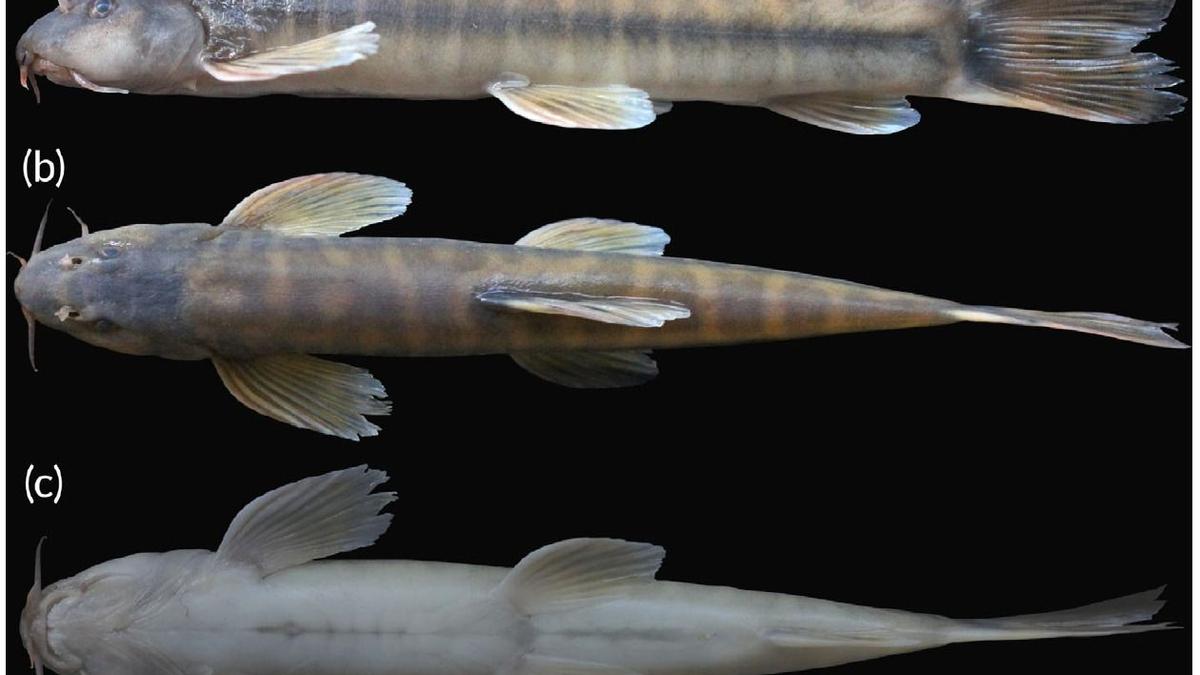
- 26 May 2025
In News:
A newly discovered species of cave-dwelling loach, Schistura densiclava, has been recorded from the Krem Mawjymbuin cave in the East Khasi Hills district of Meghalaya, India. This species becomes the sixth known cave-dwelling fish from the state, emphasizing Meghalaya’s rich subterranean biodiversity.
Taxonomy and Classification
- Family: Nemacheilidae (bottom-dwelling freshwater fishes)
- Type: Troglophile — adapted to live in caves but can survive and reproduce in surface (epigean) waters.
- Distinct Feature: Unlike typical cave fishes, S. densiclava retains pigmentation and functional eyes, indicating adaptability to both subterranean and overground aquatic environments.
Habitat and Environment
- Found 60 meters inside the Krem Mawjymbuin, a limestone cave with a surveyed length of 1.6 km and an altitude of 206 meters.
- The species inhabits a cool, fast-flowing stream with a temperature of 18°C and low oxygen levels.
- The cave is ecologically sensitive and was previously in the news due to a local ban on worship at a Shivalinga-like formation within it.
Morphological Characteristics
- Coloration: Pale yellow-green body with 14–20 greyish to faint black vertical bars.
- Named densiclava due to the thick dark stripe near the dorsal fin ("densiclava" = Latin for "thick stripe").
- Sexual Dimorphism:
- Males: Slimmer with irregular patterns and puffier cheeks.
- Females: Sturdier with more consistent markings.
Scientific Significance
- Genetic testing confirmed Schistura densiclava as a distinct and previously unrecorded species.
- Its endemic distribution, limited to a single cave system, marks it as a species of high conservation concern.
- The discovery was published in the Journal of Fish Biology by a team led by Kangkan Sarma from Gauhati University, along with other Indian ichthyologists.
Artificial Rain to combat Delhi’s Air Pollution
- 06 Apr 2025
In News:
With the national capital grappling with chronic air pollution every winter, the Delhi Government is exploring artificial rain (cloud seeding) as a potential mitigation strategy. In a recent high-level meeting chaired by Environment Minister Manjinder Singh Sirsa, experts and representatives from key institutions brainstormed the feasibility and logistics of implementing cloud seeding in Delhi's airspace.
What is Artificial Rain (Cloud Seeding)?
- Cloud seeding is a form of weather modification aimed at inducing rainfall.
- It involves spraying chemical agents such as silver iodide or salt particles into clouds to stimulate condensation and precipitation.
- Requires favourable meteorological conditions, especially adequate moisture and cloud density.
- Usually conducted using aircraft or ground-based dispersal systems.
Significance for Delhi:
- Rainfall helps settle airborne particulate matter (PM2.5 and PM10), thereby reducing pollution levels.
- Delhi’s air quality worsens in winter due to a combination of low wind speeds, crop residue burning, vehicular and industrial emissions, and construction dust.
- Artificial rain could serve as an emergency intervention to improve air quality during severe pollution episodes.
Key Highlights of the Meeting:
- Convened by Delhi Environment Department with participation from:
- CPCB, DPCC
- Ministry of Defence, MoEFCC
- IIT-Kanpur, India Meteorological Department (IMD)
- Directorate General of Civil Aviation (DGCA), AAI
- IIT-Kanpur scientists shared results from previous successful cloud seeding trials in Kanpur (2023), demonstrating its potential under ideal conditions.
- Past trials in 2018 also showed partial success, with rainfall occurring in 5 out of 6 attempts during pre-monsoon months.
Challenges Identified:
- Weather-dependence: Effectiveness relies heavily on cloud presence and moisture levels, which are limited in Delhi during winters.
- Airspace clearance and coordination among multiple agencies (civil aviation, defence).
- High costs and uncertain outcomes make it a supplementary, not primary, solution.
Complementary Measures Underway:
- Delhi’s 14-point action plan to curb dust pollution includes:
- Anti-smog guns, covering construction sites, cleaning of construction vehicles, andregulated debris disposal.
- Exploring static ionisation systems as an alternative to cloud seeding for artificial precipitation.
Euphaeawayanadensis
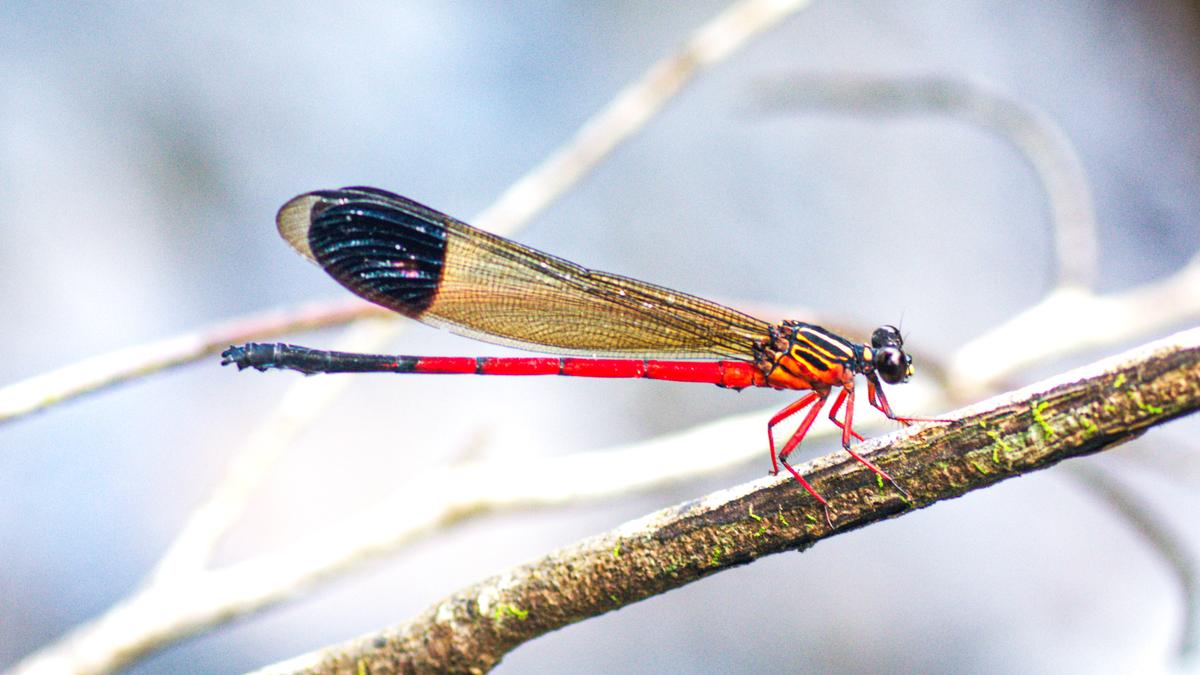
- 05 Apr 2025
In News:
A new species of damselfly, Euphaeawayanadensis, has been discovered in the Wayanad region of Kerala, marking a significant addition to India’s odonate diversity.
Key Details:
- Taxonomy:
- Belongs to the family Euphaeidae.
- Officially recognized as Kerala’s 191stodonate species (including damselflies and dragonflies).
- 223rd species recorded from the Western Ghats.
- Discovery and Research:
- First observed in 2013 at Kalindi River, Thirunelli, Wayanad.
- Confirmed after field studies conducted until 2023 across Wayanad, Aralam (Kannur), and western Coorg slopes (Karnataka).
- Discovery published in the peer-reviewed journal ENTOMON.
- Research Contributors:Collaborative effort involving scientists from Kerala Agricultural University, Alphonsa College, and conservation groups like Warblers and Waders, Travancore Nature History Society.
- Identification Process:
- Initially mistaken for Euphaeapseudodispar (from Maharashtra).
- Declared a distinct species based on morphological traits and genetic analysis.
Distinct Morphological Features
- Hind wing: Longer black patch compared to similar species.
- Stripes: Broader, uninterrupted humeral and antehumeral stripes in males.
- Male genital vesicle: Structurally unique from related species.
Habitat & Distribution
- Inhabits fast-flowing rocky streams with aquatic vegetation.
- Found in evergreen and semi-evergreen forests along stream banks.
- Active throughout the year except March–April (dry season).
- Shows restricted distribution, making it ecologically vulnerable.
Conservation Importance
- The discovery underlines the biodiversity richness of the Western Ghats.
- Highlights the need for targeted conservation of aquatic invertebrates in fragile ecosystems like Wayanad.
- Emphasised by experts from the IUCN Dragonfly Specialist Group.
State of the World’s Animal Health Report 2025
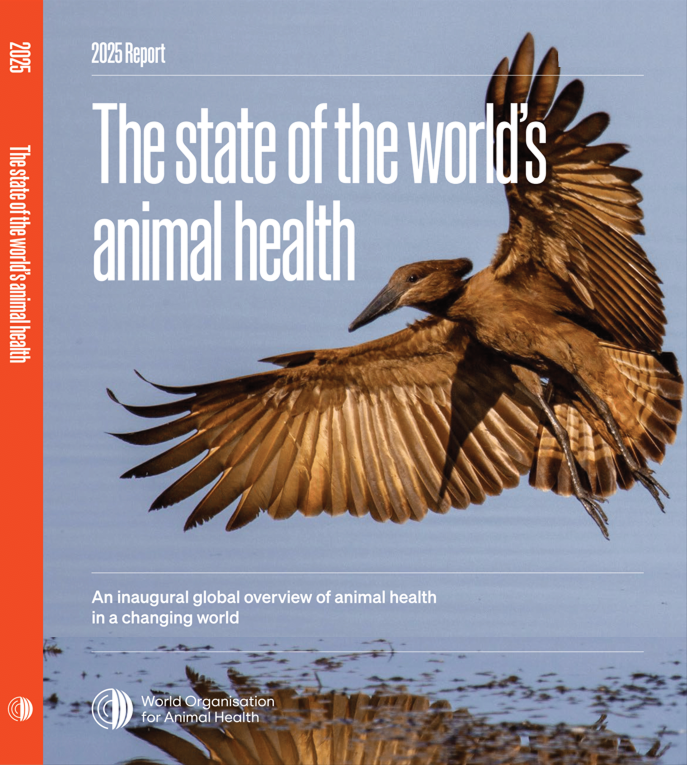
- 25 May 2025
In News:
Infectious animal diseases are spreading to previously unaffected regions and species, with nearly half (47 per cent) capable of zoonotic transmission or spreading between animals, according to the inaugural State of the World’s Animal Health report released by the World Organisation for Animal Health (WOAH).
Key Details:
Published by:
- World Organisation for Animal Health (WOAH), formerly OIE (Office International des Epizooties), founded in 1924, headquartered in Paris.
- Recognized by the WTO for setting global standards on animal health and zoonotic disease control.
Objective of the Report:
- To provide a comprehensive global assessment of animal health trends, risks, and disease outbreaks.
- To promote a One Health approach, linking animal health with human health and environmental sustainability.
Major Findings:
1. Rising Zoonotic Threats:
- 47% of animal diseases reported between 2005–2023 have zoonotic potential (can spread from animals to humans).
- These include avian influenza, African swine fever (ASF), foot-and-mouth disease (FMD), and Peste des Petits Ruminants (PPR).
2. Geographic Expansion of Diseases:
- Diseases are emerging in new regions and species due to climate change, global trade, and ecosystem disruptions.
- Example: ASF jumped over 1,800 km to reach Sri Lanka in 2024, marking the year's most significant disease leap.
- PPR re-emerged in Europe, traditionally limited to developing regions.
3. Avian Influenza Evolution:
- Over 630 million birds culled or lost in 20 years.
- In 2024, more outbreaks were reported in non-poultry species (55 countries) than poultry (42 countries).
- Mammal infections doubled, raising concerns of cross-species transmission.
4. Other Notable Disease Events:
- Germany faced its first FMD outbreak since 1988.
- New World Screwworm, a parasitic fly, re-emerged in Mexico and Nicaragua.
- Bluetongue virus reported in 23 countries with over 3,500 cases in 2024.
Antimicrobial Resistance (AMR): A Global Threat
Key Data:
- By 2050, AMR may cause:
- Loss of livestock threatening food security for 2 billion people.
- $100 trillion global economic loss.
Drivers:
- Indiscriminate use of antibiotics in livestock, aquaculture, and agriculture.
- Around 20% of countries still use antimicrobials as growth promoters, including high-priority drugs like colistin and enrofloxacin.
Trends:
- Global antibiotic use in animals fell by 5% (2020–2022).
- Europe: 23% decline.
- Africa: 20% decline.
Recommendations by WOAH:
- Enhance vaccine access and distribution, especially in low-income countries.
- Strengthen Veterinary Services, surveillance, and biosecurity.
- Improve hygiene and disease prevention to reduce antibiotic dependence.
- Promote international cooperation under the One Health framework.
- Ban or regulate the use of antibiotics as growth promoters.
About WOAH:
- Intergovernmental organization with 183 member countries, including India.
- Monitors, controls, and reports on animal diseases to ensure safe trade, public health, and food security.
- Partner in Global Action Plan on AMR with WHO and FAO.
Indian Initiatives on AMR & Animal Health:
- National Action Plan on AMR (2017–2021) – Focus on awareness, surveillance, infection control, and R&D.
- FSSAI guidelines to regulate antibiotic residues in food of animal origin.
- National Animal Disease Control Programme (NADCP) – Focus on vaccination against FMD and Brucellosis.
India’s Climate Physical Risk (CPR)

- 21 May 2025
In News:
Amid rising climate-induced disasters—floods, heatwaves, droughts—the Union Home Minister recently called for proactive climate risk assessments. India, however, lacks a comprehensive and standardised system to assess Climate Physical Risks (CPR), exposing critical gaps in preparedness.
What is Climate Physical Risk (CPR)?
Definition: CPR refers to the potential damage from:
- Acute events: Floods, cyclones, heatwaves.
- Chronic stresses: Changing monsoon patterns, droughts.
IPCC Formula:
CPR = Hazard × Exposure × Vulnerability
- Hazard: Climate threats like floods or wildfires.
- Exposure: Presence of people/assets in risk-prone areas.
- Vulnerability: System's capacity to withstand and recover.
Why CPR Assessment Matters for India
- High Risk: Over 80% of Indians reside in districts exposed to climate disasters (World Bank).
- Systemic Threat: Affects not just the environment, but public health, agriculture, economy, and national security.
- Future-proofing Development: Long-term planning must consider CPR for sustainable infrastructure and financial stability.
Challenges in India’s CPR Management
- Fragmented Efforts: Multiple agencies (IMD, IITs, NIDM) conduct isolated studies with no integration.
- Lack of Standardised Data: No central repository for CPR metrics at the district or panchayat level.
- Modelling Limitations: Global models like RCPs and SSPs fail to capture India's hyper-local climate variations.
- Private Sector Constraints: Businesses lack tools to evaluate climate risks across supply chains.
Global Best Practices
- Mandatory Climate Disclosures: Global frameworks like ISSB S2 and EU Taxonomy require companies to report CPRs.
- Adaptation as Priority: Nations, including the Global North, are investing in adaptation infrastructure, recognizing its economic returns.
- UNEP estimates: $1 in adaptation = $4 saved in disaster recovery.
Initiatives by India
- Adaptation Communication (2023): India’s first report to the UNFCCC under Article 7 of the Paris Agreement.
- National Adaptation Plan (NAP): In progress; covers 9 thematic sectors with district-level focus.
- RBI Framework: Climate risk integrated into financial supervision and regulatory assessments.
Supreme Court Strikes Down Retrospective Environmental Clearances
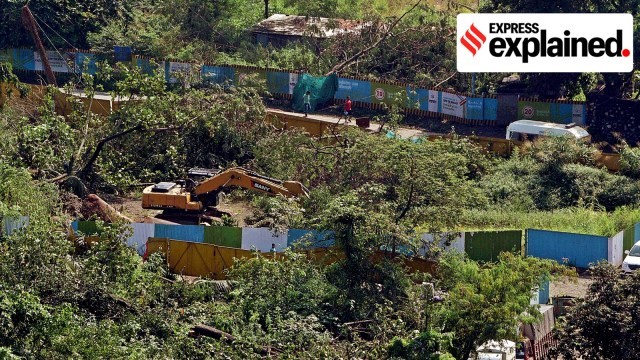
- 20 May 2025
In News:
In a significant verdict for environmental governance, the Supreme Court of India, in the case Vanashakti v. Union of India (May 2025), struck down the 2017 notification and 2021 Standard Operating Procedure (SOP) issued by the Ministry of Environment, Forest and Climate Change (MoEF&CC). These instruments allowed retrospective (ex-post facto) environmental clearances—i.e., granting environmental approval to industries after they had begun operations without prior clearance.
What are Retrospective Environmental Clearances?
- Definition: Ex-post facto clearances permit projects to start operations without prior Environmental Impact Assessment (EIA) approval and seek clearance later.
- Contradiction: These violate the EIA Notification, 2006, issued under the Environment (Protection) Act, 1986, which mandates prior approval before beginning any project impacting the environment.
Details of the 2017 Notification & 2021 SOP
- 2017 Notification:
- Provided a one-time 6-month window for industries that violated clearance norms to regularize operations.
- Central-level appraisal for all cases, regardless of project size or category.
- Violators remained subject to action by State Pollution Control Boards.
- Intended to bring violators under regulatory oversight and ensure remediation costs.
- 2021 SOP:
- Issued to standardize processing of violation cases following an NGT directive.
- Did not use the term “ex-post facto”, but allowed project appraisals after operations began—effectively regularising violations.
- Appraisal Committee: A committee led by NEERI’s former director S.R. Wate appraised such cases over 47 meetings between 2017–2021.
Supreme Court’s Rationale
- Violation of Fundamental Rights:
- Held the 2017 Notification and 2021 SOP unconstitutional as they violate:
- Article 21 – Right to a clean and pollution-free environment.
- Article 14 – Equality before law; violators were unjustly protected.
- Held the 2017 Notification and 2021 SOP unconstitutional as they violate:
- Against Environmental Jurisprudence:
- Reaffirmed past rulings:
- Common Cause v. Union of India (2017)
- Alembic Pharmaceuticals v. Rohit Prajapati (2020)
- These had declared ex-post facto clearances illegal and anathema to environmental law.
- Reaffirmed past rulings:
- On “One-Time” Justification:
- Rejected the Centre’s argument that the 2017 measure was a one-time exception.
- Even a one-time relaxation, the Court said, undermines environmental protections and encourages illegal practices.
- Criticized Centre's Intent:
- Noted that the SOP was a disguised attempt to bring back ex-post facto clearances.
- Warned against such “clever drafting” to bypass the law.
Implications of the Verdict
- Reinforces EIA Norms: Upholds the mandatory prior environmental clearance process under EIA 2006.
- Strengthens Environmental Rule of Law: Emphasizes precautionary principle and polluter pays principle.
- Curtails Regulatory Evasion: Sends a clear message that industries cannot bypass environmental safeguards.
- Protects Public Health: Highlights link between environmental damage and issues like pollution in Delhi.
- Judicial Oversight: Asserts constitutional checks on executive actions that dilute environmental protections.
Operation Olivia
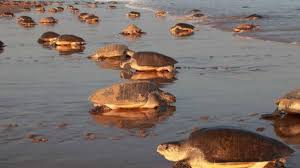
- 20 May 2025
In News:
Operation Olivia is an annual conservation initiative launched by the Indian Coast Guard (ICG) in collaboration with the Odisha Forest Department, aimed at protecting the nesting habitats of Olive Ridley turtles along the Odisha coastline. It is conducted from November to May, aligning with the turtles’ mass nesting (Arribada) season.
Key Features of Operation Olivia (as of 2025)
- In February 2025, a record 6.98 lakh Olive Ridley turtles nested at the Rushikulya river mouth.
- Since inception, the ICG has conducted:
- 5,387 surface patrol sorties
- 1,768 aerial surveillance missions
- 366 boats involved in illegal fishing were detained, ensuring effective protection of the turtles' breeding grounds.
- 225 ship days and 388 aircraft hours were dedicated to Operation Olivia during a recent season.
- Focus areas include Gahirmatha Beach, Rushikulya, and Dhamra river mouths in Odisha—home to over 8 lakh nesting turtles annually.
Conservation Measures
- Fishing ban within 20 km of nesting coasts (Devi, Dhamra, and Rushikulya rivers), enforced under:
- Orissa Marine Fishing Regulation Act, 1982
- Wildlife Protection Act, 1972
- Promotion of Turtle Excluder Devices (TEDs) to reduce accidental bycatch.
- Community awareness campaigns and MoUs with NGOs to ensure local participation and education on marine conservation.
About Olive Ridley Turtles
- Scientific Name:Lepidochelysolivacea
- IUCN Status: Vulnerable
- Legal Protection:
- Schedule I, Wildlife Protection Act, 1972
- Appendix I, CITES
- Habitat: Warm tropical waters of the Pacific, Atlantic, and Indian Oceans
- India’s Nesting Sites:
- Gahirmatha Marine Sanctuary – world’s largest rookery
- Rushikulya and Devi river mouths in Odisha
- Unique Feature: Mass nesting behavior known as Arribada, where thousands of females lay eggs on the same beach.
- Behavior: Omnivorous and solitary; migrate thousands of kilometers annually between feeding and breeding grounds.
Coral Reefs
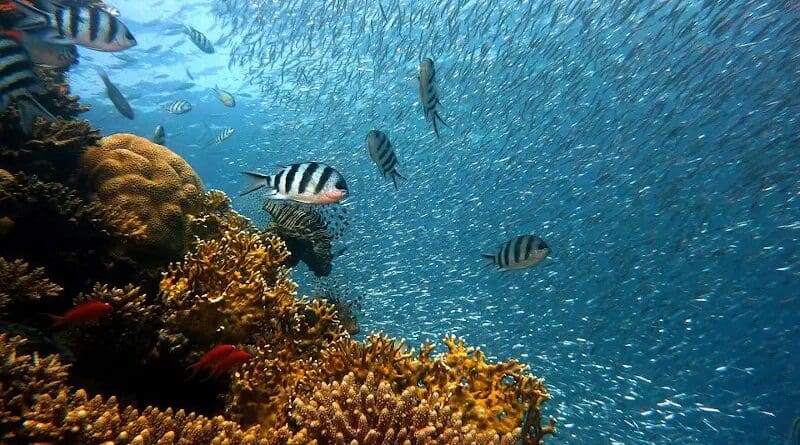
- 19 May 2025
In News:
In a paper published in the Cell Press journal Trends in Biotechnology, researchers demonstrate that the ink could boost coral settlement by more than 20 times, which they hope could contribute to rebuilding coral reefs around the world.
Recent Development in Coral Restoration
- Institution: University of California, San Diego
- Innovation: Development of SNAP-X, a specialized bio-ink.
- Significance: SNAP-X boosts coral larvae settlement by 20 times, marking a major advancement in coral reef restoration, especially vital in the context of climate change-induced reef degradation.
What are Coral Reefs?
- Coral reefs are diverse marine ecosystems formed by colonies of coral polyps, which secrete calcium carbonate to create hard exoskeletons.
- These ecosystems thrive in warm, shallow, and clear tropical waters and are among the most productive on Earth.
Examples of Coral Reefs
- Global: Great Barrier Reef (Australia)
- India: Gulf of Mannar, Lakshadweep Islands
Importance of Coral Reefs
- Biodiversity Hotspots: Support thousands of marine species.
- Coastal Protection: Act as natural barriers against storms and erosion.
- Livelihoods: Sustain tourism and fisheries industries.
- Food Security: Provide fish and other resources to coastal communities.
Types of Coral Reefs
- Fringing Reefs
- Found close to coastlines
- Separated from land by shallow lagoons
- Most widespread type
- Barrier Reefs
- Located farther from shore
- Separated by deeper, wider lagoons
- Example: Great Barrier Reef
- Atolls
- Ring-shaped reefs surrounding a central lagoon
- Often form around subsiding volcanic islands
- Found in the Indian and Pacific Oceans
Favorable Conditions for Coral Reef Growth
Factor Requirement
Water Temperature Around 20°C; typically in tropical zones (30°N to 30°S)
Sunlight Shallow depths (up to ~55 meters) allow photosynthesis
Water Clarity Low nutrient and sediment levels for light penetration
Salinity Stable marine salinity levels
Pollution Minimal; corals are sensitive to chemical/sediment pollutants
Food Supply Plankton-rich water sustains coral polyp
Mosurafentoni

- 19 May 2025
In News:
A new species named Mosurafentoni—a small, three-eyed sea predator—has been discovered in fossils dating back 506 million years. The findings were published in Royal Society Open Science.
Key Highlights:
- Time Period: Cambrian Period (approx. 506 million years ago)
- Classification: Belonged to Radiodonts, an extinct group related to modern-day arthropods like insects, spiders, and crustaceans.
- Unique Traits:
- Three eyes – with a large third eye on the head.
- Jointed claws – similar to crabs or insects, possibly used for capturing prey.
- Swimming style – moved like a stingray using multiple undulating flaps; referred to as “flying underwater”.
- Body structure – featured a trunk-like segment with 16 parts and gills, aiding respiration.
- Mouth – circular, resembling a pencil sharpener lined with serrated plates for slicing prey.
- Size – around the length of a human finger.
- Nickname: Dubbed the "Sea Moth" due to its flapping motion and size.
Ecological Role
- Likely fed on smaller marine organisms like worms and crustaceans.
- Possibly preyed upon by larger predators such as ancient jellyfish.
Evolutionary Significance
- Shows early arthropod diversity and evolutionary complexity.
- Body structure similarities with modern species like horseshoe crabs and woodlice suggest parallel evolutionary adaptations.
- Helps understand the transition from simple worm-like organisms to complex body plans in early marine ecosystems.
Tsarap Chu Conservation Reserve
- 17 May 2025
In News:
Recently, the Himachal Pradesh Government notified the Tsarap Chu Conservation Reserve, making it India’s largest conservation reserve, spanning 1,585 sq km. It is located in the Spiti Valley of Lahaul-Spiti district, a high-altitude, cold desert ecosystem.
Legal Status:
- Declared under Section 36A(1) of the Wildlife (Protection) Act, 1972
- It is Himachal Pradesh’s fifth conservation reserve after Darlaghat, Naina Devi, Potter Hill, and Shilli
Geographical Significance:
- Boundaries:
- North: Union Territory of Ladakh
- East: Kibber Wildlife Sanctuary (up to Malang Nala and LungarLungpa)
- South: KabjimaNala
- West: Chandratal Wildlife Sanctuary
- Encompasses the confluence of Unam River and CharapNala
- Serves as the catchment area of Charap Nallah and a critical wildlife corridor linking Kibber and Chandratal sanctuaries
Ecological Importance:
- Identified as a high-density snow leopard habitat
- Other key species:
- Tibetan wolf, bharal (blue sheep), Himalayan ibex
- Kiang (Tibetan wild ass), Tibetan argali
- Rich in avian biodiversity: Rose Finch, Tibetan Raven, Yellow-billed Chough
Management and Community Involvement:
- To be managed by a Conservation Reserve Management Committee including local Panchayat representatives
- Emphasizes community-based conservation, balancing ecological goals with local livelihoods
- Promotes eco-tourism, wildlife research, and nature-based livelihood opportunities
Indian Grey Wolf
- 15 May 2025
In News:
The Indian grey wolf, a keystone predator crucial to maintaining the ecological balance of India’s grasslands, is facing a sharp population decline. The primary threat stems from increasing encounters with feral (free-ranging) dogs, which pose risks of disease transmission, competition, and hybridization.
Profile:
- Scientific Classification:A subspecies of the grey wolf (Canis lupus), native to the Indian subcontinent and parts of Southwest Asia.
- Habitat:Inhabits scrublands, semi-arid grasslands, and pastoral agro-ecosystems, often overlapping with human-dominated landscapes.
- Physical Traits:Intermediate in size between the Tibetan and Arabian wolves, the Indian grey wolf is adapted to warmer climates and lacks the dense winter coat of its colder-climate relatives.
- Behavioral Characteristics:
- Primarily nocturnal
- Hunts in small packs
- Less vocal than other wolf subspecies
- Geographical Range:Extends from Israel in the west to the Indian subcontinent in the east.
Legal and Conservation Status
- IUCN Red List:Least Concern globally, but considered locally endangered in India due to habitat loss and increasing threats.
- CITES Listing:Appendix I – Species facing extinction, with trade subject to strict regulation.
- Wildlife (Protection) Act, 1972: Listed under Schedule I, ensuring maximum legal protection within India.
Conservation Dilemma: Feral Dogs
- The Maharashtra Forest Rules, 2014 permit the removal of non-wild species, like dogs, from protected forest areas if they pose a threat to native wildlife.
- Despite this provision, forest officials often refrain from culling dogs due to ethical and animal rights concerns.
- Vaccination programs are proposed as alternatives to mitigate disease risks like canine distemper virus (CDV), but implementation remains logistically challenging.
Key Threats
- Disease Transmission: Feral dogs carry zoonotic diseases such as CDV, which can infect and decimate wolf populations.
- Hybridization: Interbreeding with dogs leads to genetic dilution, threatening the purity and survival of the species.
- Competition: Feral dogs compete with wolves for food and territory.
Case Study: Kadbanwadi Grassland, Maharashtra
- Location: Situated in Indapur tehsil, Pune district, this grassland spans over 2,000 hectares.
- Biodiversity Hotspot: Home to species like the Bengal fox, striped hyena, Brahminy kite, and the Indian grey wolf.
- Cultural Coexistence: The local shepherd communities have shared a mutually respectful relationship with wolves over generations, reflecting a model of harmonious coexistence.
Geotubing

- 14 May 2025
In News:
A joint study conducted by the National Institute of Ocean Technology (NIOT) and the Kerala State Coastal Area Development Corporation (KSCADC) has confirmed the effectiveness of geotubing-based offshore breakwaters in managing coastal erosion at Poonthura, Kerala. The installation not only mitigated shoreline erosion but also contributed to sustainable beach formation—highlighting the method's potential for broader coastal protection strategies.
What is Geotubing?
Geotubing involves the use of large geotextile tubes, filled with sand or slurry, which are strategically placed underwater to reduce wave energy and prevent shoreline erosion. At Poonthura, three vertical layers of 15-meter circumference geotubes were installed perpendicular to the coast, forming submerged breakwaters that trap sediment and promote natural sand deposition.
Materials and Construction
- Geotubes Composition:Constructed from high-performance woven geotextiles, typically made of polypropylene (PP) or polyester (PET).
- Material Properties:These fabrics are designed to be permeable, durable, and resistant to UV radiation, chemical exposure, and microbial degradation, making them well-suited for long-term marine use.
Key Functional Features
- Wave Energy Dissipation:Submerged geotubes act as barriers that absorb and deflect wave energy before it reaches the shoreline.
- Beach Nourishment Support:By slowing wave action, the geotubes encourage natural sand accumulation, supporting beach regeneration.
Advantages of Geotubing
- High Durability:Withstands tensile stress and harsh environmental conditions, including chemical and biological exposure.
- Environmentally Friendly:Geotubing is non-toxic and contributes to coastal and wetland restoration without polluting ecosystems.
- Cost-Effective:More economical than traditional concrete or steel structures and easier to install, particularly in remote or variable terrains.
- Customizable Design:Geotubes can be tailored in size and configuration to suit specific project requirements and geographical conditions.
- Multi-Functional Utility:Beyond coastal defense, geotubes are effective in flood management, riverbank stabilization, sludge dewatering, and landfill containment.
Broader Applications of Geotubing
- Coastal Protection:Used in breakwaters, seawalls, and dune reinforcement projects.
- River and Lake Management:Effective for stabilizing riverbanks and controlling sedimentation.
- Wastewater Treatment:Applied in industrial and municipal dewatering processes.
- Infrastructure Support:Utilized in the construction of roads, railways, ports, and reservoirs.
- Environmental Remediation:Useful for site isolation, pollution control, and ecosystem restoration.
20th Session of the United Nations Forum on Forests (UNFF20)
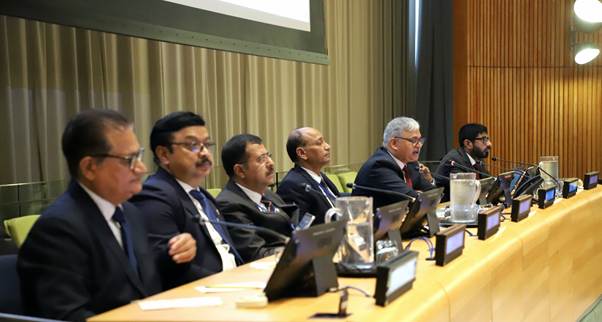
- 13 May 2025
In News:
India actively participated in the 20th session of the United Nations Forum on Forests (UNFF20) held from May 5 to 9, 2025, at the United Nations Headquarters, New York. UNFF, established in 2000 by the UN Economic and Social Council (ECOSOC), is the sole intergovernmental platform dedicated to global forest policy dialogue and coordination, aiming to promote sustainable forest management (SFM) and strengthen political commitment worldwide.
Key Objectives and Functions of UNFF
- Promotes conservation, management, and sustainable development of all forest types.
- Supports the implementation of Agenda 21, Rio Forest Principles, and the UN Strategic Plan for Forests 2017–2030.
- Oversees six voluntary Global Forest Goals (GFGs) and 26 targets, including reversing deforestation and enhancing forest governance.
- Facilitates cooperation through technical exchanges, policy development, financing mechanisms like the Global Forest Financing Facilitation Network, and advocacy linking forests with climate, biodiversity, and sustainable development.
India’s Highlights at UNFF20
India reaffirmed its commitment to the Voluntary National Contributions (VNCs) under the UN Strategic Plan for Forests 2017–2030, reporting progress in increasing its forest and tree cover, which now constitutes 25.17% of the country’s geographical area, as per the latest India State of Forest Report. Major achievements include:
- Restoration efforts under the Aravalli Green Wall project.
- A 7.86% increase in mangrove cover over the past decade.
- Afforestation of over 1.55 lakh hectares through the Green India Mission.
- Plantation of 1.4 billion seedlings under the “Ek Ped MaaKe Naam” (Plant4Mother) campaign.
Global Contributions and Initiatives
India extended an invitation to all UN member states to join the International Big Cat Alliance (IBCA)—a global platform launched by India to conserve seven big cat species through collaborative research, knowledge exchange, and capacity-building.
India also emphasized the importance of incorporating the outcomes of the Country-Led Initiative (CLI) on forest fire management and forest certification—hosted by India in Dehradun in October 2023—into formal global mechanisms. It acknowledged contributions from other countries such as the Republic of Congo, Democratic People’s Republic of Korea, and Austria in this initiative.
Policy and Technical Engagements
India hosted a side event titled “Restoring Degraded Forest Landscapes: India’s Approach to Sustainable Forest Management and Climate Resilience”, showcasing integrated forest restoration strategies combining policy innovation, resource convergence, community participation, and technology.
In a high-level panel on “Valuing Forest Ecosystems in National Policy and Strategy,” India shared pilot study findings from Uttarakhand, Rajasthan, and tiger reserves that quantified ecosystem services like carbon sequestration, water provisioning, and biodiversity conservation. India stressed the need to incorporate ecosystem valuation into national planning to enhance forest governance and ecological sustainability.
Significance of UNFF20
The session focused on advancing three Global Forest Goals:
- Reversing forest cover loss.
- Increasing protected and sustainably managed forests.
- Promoting forest governance and legal frameworks.
UNFF20 aimed to strengthen global dialogue following the 2024 midterm review of the international arrangement on forests and set the agenda for future policy deliberations in 2026. It underscored the critical role forests play in climate resilience, biodiversity, livelihoods, and sustainable development.
Carbon Border Adjustment Mechanism (CBAM)
- 11 May 2025
In News:
India has warned it will retaliate if the United Kingdom implements its proposed Carbon Border Adjustment Mechanism (CBAM) from January 1, 2027, calling it a violation of the Common But Differentiated Responsibilities (CBDR) principle of international climate agreements.
What is Carbon Border Adjustment Mechanism (CBAM)?
- It is a carbon tax on imports based on their carbon intensity of production.
- Aim: Prevent carbon leakage by aligning the cost of carbon between domestic and foreign producers.
- Sectors likely to be initially targeted include steel, cement, aluminium, and energy-intensive products.
- The UK is expected to implement its version of CBAM in 2027, following a similar approach by the European Union.
India’s Concerns
- Violation of CBDR Principle
- CBAM undermines the UNFCCC and Paris Agreement, which recognize that developing countries require flexibility and support for decarbonization.
- India’s per capita emissions are low, but its carbon intensity is higher due to developmental needs.
- Unfair Trade Practice
- CBAM could nullify tariff concessions negotiated under the India–UK Free Trade Agreement (FTA).
- Finance Minister Nirmala Sitharaman and Commerce Minister Piyush Goyal have labelled CBAM “unfair” and discriminatory.
- Double Taxation and Export Losses
- Indian exporters may face double taxation—domestic environmental levies and UK’s border tax.
- India proposed a ‘rebalancing mechanism’ and MSME carve-out, both of which the UK declined.
- Export-heavy sectors like textiles, leather, ceramics, engineering goods, and steel may be hit hard due to sustainability compliance burdens.
- MSME Vulnerability
- Labour-intensive MSMEs lack the capacity to meet expensive ESG norms and carbon tracking requirements.
- India's request for exemption or compensation for MSMEs was not accepted.
India’s Response Strategy
- India reserves the right to retaliate if CBAM is imposed.
- Potential responses include:
- Domestic carbon taxation to offset UK’s CBAM and use revenue for green transition.
- Invoking a rebalancing clause under the FTA’s “general exceptions” (similar to GATT), allowing trade countermeasures for environmental or public interest.
Strategic Implications for India
- Non-tariff barriers like CBAM can undermine market access gained through FTAs.
- India must stay alert to evolving trade conditions involving environment, labour, IPR, and gender standards, which often require policy adjustments.
- Calls for India to strengthen its carbon tracking, ESG frameworks, and climate-compliant production systems to remain globally competitive.
Saola Genome Mapping
- 11 May 2025
In News:
An international team of scientists has successfully mapped the genome of the saola (Pseudoryxnghetinhensis), the world’s rarest large land mammal, providing critical insights for conservation through genetic rescue and captive breeding.
About Saola
- Common Name: Asian Unicorn
- Scientific Name: Pseudoryxnghetinhensis
- First Described: 1993 (based on a skull found in Vietnam in 1992)
- Classification: Bovine species, closely related to cattle but resembling an antelope
- Habitat: Endemic to the Annamite Mountains along the Laos–Vietnam border; prefers humid evergreen forests
- IUCN Status: Critically Endangered
- Estimated Population (2015): 50–300 individuals
- Physical Traits:
- Height: ~33 inches at shoulder
- Both sexes possess straight, parallel horns (~20 inches)
- Distinct white facial markings and muzzle scent glands
Major Threats
- Habitat loss, primarily due to agricultural expansion and forest degradation
- Poaching and indiscriminate snaring, including by-catch in traps set for other animals
- Lack of successful captive care: Over 20 captured saolas died in the 1990s due to inadequate professional care
Genome Mapping and Key Findings
- Sample Base: Genomes of 26 individuals sequenced using remains sourced from hunter households
- Population Divergence: Two genetically distinct populations emerged 5,000–20,000 years ago, likely due to:
- Forest fragmentation during/after the Last Glacial Maximum
- Expansion of human activities such as agriculture, burning, and hunting around 4,000 years ago
- Genetic Complementarity: Each population retains different genetic variants, offering potential for enhanced genetic diversity if combined
- Scientific Importance:
- Confirms historical population isolation and genetic loss
- Provides a genetic foundation for targeted conservation efforts
Conservation Implications
- Captive Breeding Program: Plans underway in Vietnam to establish a well-equipped breeding center
- Goal: Capture at least a dozen individuals from both genetic lineages to create a genetically resilient population
- Long-term Vision: Reintroduction into protected forest areas with strict anti-poaching measures
India’s First Inter-State Cheetah Conservation Corridor
- 04 May 2025
In News:
Rajasthan has joined hands with Madhya Pradesh to develop India’s first inter-state cheetah conservation corridor, a landmark initiative under the Cheetah Reintroduction Project. The corridor will facilitate the safe movement of cheetahs across a 17,000 sq. km protected landscape, enhancing conservation and habitat connectivity.
Key Features of the Cheetah Conservation Corridor
Aspect Details
Total Area 17,000 sq. km (MP: 10,500 sq. km; Rajasthan: 6,500 sq. km)
States Involved Madhya Pradesh and Rajasthan
Supported by National Tiger Conservation Authority (NTCA), Wildlife Institute of India (WII)
MoU Status In progress between Chief Ministers of MP and Rajasthan
Geographical Scope and Key Sites
- PalpurKuno National Park (MP):Core site for cheetah reintroduction; located in Sheopur district.
- Gandhi Sagar Sanctuary (MP):Being developed as a second habitat for cheetahs; located in Mandsaur district along the Chambal River.
- Mukundara Hills Tiger Reserve (Rajasthan):Proposed extension site; comprises parts of Darrah, Jawahar Sagar, and Chambal sanctuaries in Kota division.
- Rajasthan Districts Involved:Kota, Bundi, Baran, Jhalawar, Sawai Madhopur, Karauli, Chittorgarh
- Proposed Future Expansion:Forest regions of Jhansi and Lalitpur in Uttar Pradesh
Objectives and Benefits
- Inter-State Wildlife Connectivity:India’s first corridor linking cheetah habitats across state borders.
- Seamless Migration:Enables cheetahs to roam freely between reserves, mimicking natural ecological patterns.
- Ecological Restoration:Aims to revive and conserve India’s arid grassland ecosystems, which are essential habitats for cheetahs.
- Federal Conservation Model:Demonstrates cooperative federalism in wildlife management and biodiversity conservation.
- Global Recognition:Touted as a unique conservation model in Asia, aligning with Convention on Biological Diversity (CBD) targets.
Global push for complete ban on Chlorpyrifos
- 04 May 2025
In News:
At the ongoing 2025 Conference of the Parties (COP) to the Basel, Rotterdam, and Stockholm (BRS) Conventions in Geneva, there has been a renewed global call to list chlorpyrifos under Annex A of the Stockholm Convention, which would mandate a complete global ban without exemptions.
About Chlorpyrifos
- Type: Organophosphate insecticide.
- Usage: Widely used in agriculture and public health to control pests like mosquitoes, termites, and roundworms.
- Mechanism: Inhibits the acetylcholinesterase enzyme, disrupting nerve functions in pests and non-target species including humans.
- Introduced in India: Registered under the Insecticides Act, 1968 since 1977.
- Consumption in India: Accounted for 9.4% of total insecticide use in 2016–17 (IPEN Report).
Health and Environmental Concerns
- Human Impact: Exposure via skin, inhalation, or ingestion can cause headache, nausea, dizziness, muscle cramps, and in severe cases, paralysis and respiratory distress. Forms a toxic byproduct (chlorpyrifos oxon) in the body.
- Environmental Impact:
- Persistence: Remains in soil for weeks to years; degrades slowly in acidic conditions.
- Water Contamination: Reaches water bodies through erosion.
- Toxicity: Highly toxic to birds, fish, bees, and earthworms.
- Bioaccumulation and Biomagnification: Accumulates in organisms and magnifies through the food chain.
- Detection in India: Residues found in agricultural produce, water, human blood, and breast milk.
- A 2003 Indian study recorded levels 41 times higher than WHO safety limits.
Stockholm Convention on POPs (2001; in force since 2004)
- Objective: Eliminate or restrict Persistent Organic Pollutants (POPs).
- Annex A: Complete elimination of listed chemicals (e.g., aldrin, chlordane).
- Annex B: Restricted use.
- Annex C: Minimize unintentional emissions.
- Financial Mechanism: Supported by Global Environment Facility (GEF).
- India’s Status: Ratified in 2006.
- Enacted "Regulation of POPs Rules, 2018" under the Environment (Protection) Act, 1986.
Persistent Organic Pollutants (POPs): Overview
- Definition: Toxic, long-lasting, bioaccumulative chemicals resistant to degradation.
- Health Effects: Cause cancer, endocrine disruption, immune suppression, neurotoxicity, and reproductive harm.
- Examples: DDT, Endosulfan, Aldrin, Dieldrin, PCBs.
Debate at Geneva Meeting (2025)
- Proposal: Listing chlorpyrifos in Annex A without exemptions.
- Supporting Arguments:
- Recommended by the POPs Review Committee (POPRC).
- Detected even in remote areas like the Arctic.
- Long-term harm to child brain development (as per PAN International).
- Disproportionate impact on vulnerable and developing nations.
- Safe alternatives (e.g., agroecological and organic practices) are available.
- India’s Opposition: Cited lack of viable alternatives and threat to food security.
AI-Based Real-Time Forest Alert System
- 04 May 2025
In News:
Madhya Pradesh has become the first state in India to implement an AI-based Real-Time Forest Alert System (RTFAS), marking a significant leap in leveraging technology for sustainable forest management.
Key Highlights
- The AI-based Real-Time Forest Alert System integrates satellite imagery, machine learning, and mobile app feedback for proactive forest monitoring.
- The system is currently being piloted in five forest divisions: Shivpuri, Guna, Vidisha, Burhanpur, and Khandwa—regions with high incidences of encroachment and deforestation.
- Developed using the Google Earth Engine, the system analyses multi-temporal satellite data to detect land use changes, such as:
- Encroachment
- Tree felling
- Construction
- Agricultural expansion
Features of the AI System (RTFAS)
- Custom AI Model: Detects forest degradation by comparing satellite images from three different dates.
- Real-Time Alerts: Sent to forest staff via a mobile application, enabling instant field verification with:
- GPS-tagged photographs
- Voice notes
- Geo-fencing tools
- Interactive Dashboard: Displays live alerts categorized by beat and region with filters for area, density, and time.
- Data Enrichment: Includes indices such as:
- NDVI (Normalized Difference Vegetation Index)
- SAVI (Soil Adjusted Vegetation Index)
- EVI (Enhanced Vegetation Index)
- SAR (Synthetic Aperture Radar)
Forest Status in Madhya Pradesh & India
- Madhya Pradesh:
- Has the largest forest cover in India: 85,724 sq. km (India State of Forest Report 2023)
- Also reported the highest deforestation: 612.41 sq. km lost in 2023
- India:
- Forest and tree cover: 25.17% of total geographical area
- Below the 33% target set by the National Forest Policy, 1988
Role of Technology in Forest Conservation
Application Technology Used
Forest Monitoring AI + Satellite imaging (e.g., RTFAS)
Forest Fires AI cameras, thermal sensors, satellite constellations (e.g., FireSat), drones
Encroachment Detection Satellite alerts with 2–3 day response time
Human-Wildlife Conflict AI camera traps, GPS tracking, RFID tags, geofencing
Afforestation Green bots for planting and monitoring tree growth
Biodiversity Monitoring Acoustic AI (e.g., Rainforest Connection), Environmental DNA (eDNA)
India’s Initiatives for Sustainable Forest Management
Government Initiatives:
- Green India Mission: Increased forest cover by 0.56% (2017–2021)
- National Agroforestry Policy (2014): Promotes tree farming on private lands
- CAMPA (Compensatory Afforestation Fund): Reforestation of diverted forest lands
- Trees Outside Forests in India (TOFI): Involves private stakeholders in increasing green cover
Community & Corporate Involvement:
- CSR-driven plantations by auto, cement, and energy sectors
- Agroforestry: Integrates timber, fruit, and medicinal plants with crops
- Carbon Credit-linked Afforestation
Red-Crowned Roofed Turtle

- 02 May 2025
In News:
After nearly 30 years of absence, the Red-Crowned Roofed Turtle (Batagurkachuga) has been rediscovered in the Ganga River — a significant success for conservation efforts aimed at reviving endangered freshwater species.
Overview
- Commonly known as the Bengal Roof Turtle, it is a rare species of freshwater turtle found only in South Asia.
- Scientific Name: Batagurkachuga
Geographical Distribution
- Native Range: India, Nepal, and Bangladesh.
- Historical Presence: Widely distributed across the Ganga River system in India and Bangladesh, with additional presence in the Brahmaputra River basin.
- Current Habitat in India: The most viable population is now confined to the National Chambal Sanctuary, a protected riverine stretch for species like gharials and turtles.
Distinctive Features
- Size: Medium-sized species, females can grow up to 56 cm in length and weigh up to 25 kg, while males are significantly smaller.
- Coloration: Notable for their reddish-orange head marked with a black crown, and a greenish-brown carapace patterned with yellow streaks.
- Plastron (under-shell): Yellow with distinctive black markings.
- Adaptations: Possess a broad head, strong jaws, and webbed feet, suited for an aquatic lifestyle.
- Diet: Omnivorous — consumes both plant material and small aquatic organisms.
Conservation Status
- IUCN Red List: Critically Endangered
- Wildlife (Protection) Act, 1972: Listed under Schedule I – providing the highest level of legal protection in India.
- CITES: Included in Appendix II, regulating international trade.
Urban Heat Island (UHI) Effect
- 01 May 2025
In News:
With accelerating urbanization and climate change, the Urban Heat Island (UHI) phenomenon has emerged as a significant public health and environmental concern. Recent studies, including one published in Nature Climate Change, highlight that while UHIs elevate heat-related mortality, they simultaneously reduce cold-related deaths, especially in colder regions. This dual impact has major implications for urban planning and climate adaptation strategies.
What is Urban Heat Island (UHI)?
- Definition: UHI refers to the phenomenon where urban areas experience higher temperatures than surrounding rural regions due to human activities and urban infrastructure.
- Cities Affected: Notable examples include New Delhi, Moscow, New York, Paris, and London, where dense infrastructure and limited vegetation intensify urban heat.
Key Causes of UHI
- Impervious Surfaces: Materials like asphalt and concrete absorb heat during the day and release it slowly at night due to low albedo.
- Lack of Vegetation: Reduced greenery limits evapotranspiration, curbing natural cooling.
- Anthropogenic Heat: Heat from vehicles, air conditioners, and industries raises ambient temperatures.
- Air Pollution: Black carbon and particulates absorb solar radiation, compounding heat effects.
- Urban Morphology: Dense construction and narrow streets create a canyon effect, trapping heat and reducing airflow.
Dual Impact on Mortality
A 2025 study led by Dr. Wenfeng Zhan analyzed temperature-related mortality across 3,000+ cities globally using remote sensing and socioeconomic data:
- Cold-related Deaths Reduced: In 2018, the decline in cold-related fatalities was 4.4 times higher than the rise in heat-related deaths due to UHI.
- High-Latitude Cities: In cities like Moscow, cold-related deaths decreased 11.5 times more than heat-related deaths increased.
- Key Insight: The UHI effect's net mortality impact can vary significantly by region and season.
Consequences of UHI
- Increased Energy Demand: Higher temperatures raise demand for air conditioning, increasing fossil fuel use and emissions.
- Health Risks: Elevated risks of heat stroke, dehydration, and cardiovascular stress, especially among the elderly and urban poor.
- Deterioration of Air Quality: Heat-induced formation of ground-level ozone exacerbates respiratory ailments.
- Water Stress: Faster evaporation and increased demand for cooling water pressure urban water resources.
- Biodiversity Decline: Excessive heat and lack of green spaces threaten urban flora and fauna.
Mitigation Strategies
- Cool Roofs (Los Angeles):Mandates reflective roofing in new buildings and renovations to reduce heat absorption.
- Smart Cooling Systems (Dubai):Centralized chilled water systems reduce cooling energy by 30–50% compared to individual AC units.
- Cool Streets Initiative (Paris):Converts streets to pedestrian zones, replaces asphalt with vegetation, and expands urban greenery.
Great White Sharks

- 30 Mar 2025
In News:
A 20-year study in South Africa reveals that the decline of Great White Sharks disrupted marine ecosystems, causing cascading food web imbalances.
Key Highlights:
- Scientific Name:Carcharodon carcharias
- IUCN Red List Status:Vulnerable
- Habitat and Distribution:
- Commonly found in temperate coastal waters, including regions off the USA, South Africa, Australia, and Japan.
- Highly migratory, often venturing into tropical waters but returning to temperate zones for feeding.
- Key Biological Features:
- Endothermic Adaptation: Capable of maintaining body temperature higher than surrounding waters (regional endothermy).
- Body Structure: Streamlined, torpedo-shaped body with serrated teeth for efficient hunting.
- Feeding Behavior: Ambush predator – uses a "bite-and-wait" strategy to hunt seals, dolphins, and large fish.
- Reproduction:
- Viviparous: Gives birth to live young.
- Gestation Period: Around 12 months.
- Maturity:
- Females: Mature at 15–16 feet, around 12–18 years of age.
- Males: Mature at 11–13 feet, around 10 years of age.
- Ecological Importance:
- Apex Predator: Plays a crucial role in maintaining the balance of marine ecosystems by regulating populations of prey such as seals and mid-level predators.
- Indicator Species: Their presence signals the health and stability of marine ecosystems.
- Ecological Disruption in South Africa – Key Findings:
- A 20-year study in False Bay, South Africa, revealed a significant decline in Great White Shark numbers.
- This led to:
- A surge in seal populations and sevengill sharks.
- A corresponding collapse in populations of smaller sharks and fish, showcasing a trophic cascade and food web imbalance.
Bhadra Wildlife Sanctuary
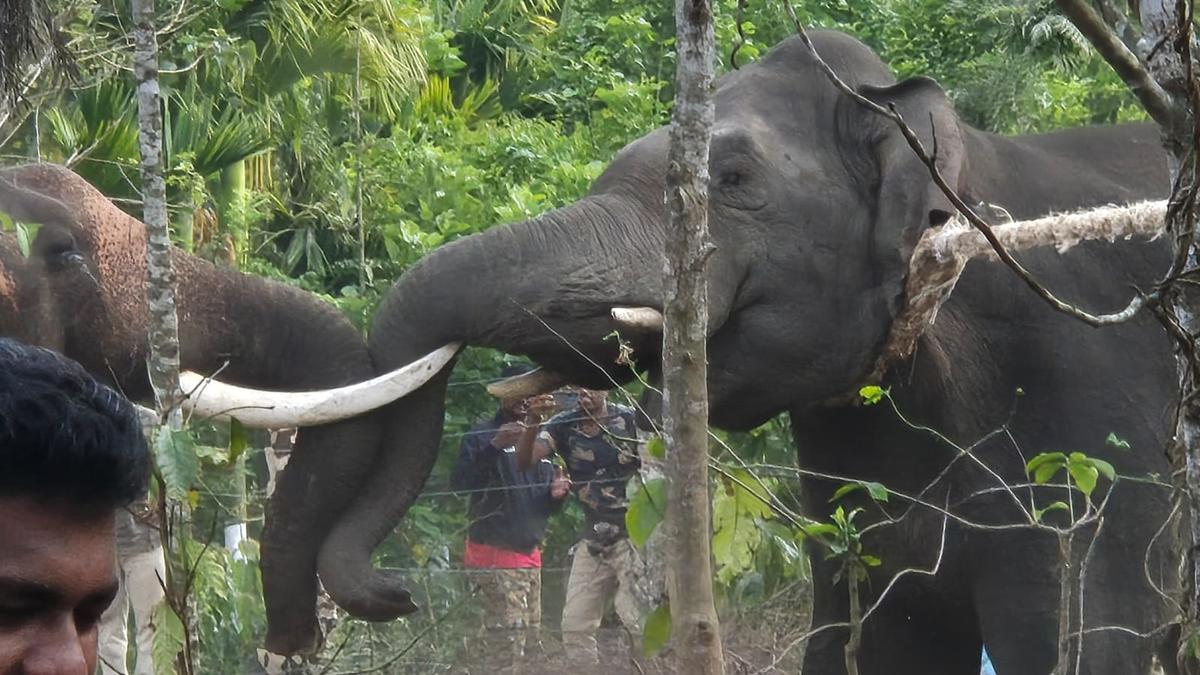
- 29 Mar 2025
In News:
Karnataka Forest Department has initiated a "soft release" strategy to address the escalating human-elephant conflict in the districts of Hassan, Chikkamagaluru, and Kodagu. The strategy involves the phased rehabilitation of captured elephants into the Bhadra Wildlife Sanctuary (BWS).
Soft Release Strategy – Key Highlights
- Objective: To rehabilitate conflict-prone wild elephants and reduce human-elephant encounters.
- Implementation Site:Bhadra Wildlife Sanctuary (BWS), Chikkamagaluru district.
- Initial Step: Captured elephants will be placed in a 20 sq. km enclosure within the sanctuary.
- Purpose of Enclosure:
- Acclimatisation to the wild.
- Health monitoring and behavioural assessment.
- Final Release: Once deemed fit, elephants will be released into one of four pre-identified zones in BWS, chosen based on:
- Availability of water and forage.
- Absence of human activity.
- Road connectivity.
Monitoring & Management
- The enclosure will be fenced using railway barricades.
- A dedicated team of veterinarians will supervise the elephants from a nearby veterinary centre.
- Minimal human interaction will be ensured during the acclimatisation period.
- Expert guidance is being provided by Prof. R. Sukumar (Indian Institute of Science) and senior forest officials.
About Bhadra Wildlife Sanctuary (BWS)
- Location: Western Ghats, Karnataka.
- Area: 492.30 sq. km.
- Also Known As:Muthodi Wildlife Sanctuary.
- Named After: Bhadra River.
- Status: A designated Project Tiger Reserve.
Ecological Significance
- Forest Types:
- Southern Moist Mixed Deciduous Forests.
- Dry Deciduous Forests.
- Shola Forests.
- Wildlife Diversity:
- Mammals: Tigers, leopards, elephants, gaurs, dholes, and deer.
- Birds: ~250 species, including endemic birds like Hornbills, Malabar Trogon, and Hill Myna.
Significance of the Initiative
- Biodiversity Conservation: Enhances protection of endangered species and habitats in the Western Ghats.
- Conflict Mitigation: Aims to provide a sustainable solution to frequent elephant incursions, crop damage, and human casualties.
- Model Strategy: Draws upon similar practices implemented in West Bengal and tailors them to Karnataka’s ecological conditions.
Accelerated Glacier Loss in Hindu Kush Himalayas
- 28 Mar 2025
In News:
On World Day for Glaciers (March 21, 2025), the United Nations World Water Development Report 2025 revealed that glaciers globally are retreating at an alarming rate, with the Hindu Kush Himalaya (HKH) region witnessing the most severe impact — glacier loss accelerated by 65% between 2011–2020 compared to the previous decade.
Key Facts about Hindu Kush Himalaya (HKH) Region
- Geographical Spread: Extends over 3,500 km across 8 countries — Afghanistan, Bangladesh, Bhutan, China, India, Myanmar, Nepal, and Pakistan.
- Population Impact:
- 240 million people live in the HKH region.
- An additional 1.65 billion people downstream depend on its waters for drinking, agriculture, hydropower, and sanitation.
- Glacial Reservoir: Known as the “Third Pole” or “Water Tower of Asia”, the HKH stores more ice than anywhere outside the Arctic and Antarctic.
- River Systems: Source of 10 major river basins, including the Ganges, Indus, Brahmaputra, and Mekong.
Projected Glacier Loss (HKH and Global)
Temperature Rise (°C) HKH Glacier Volume Loss by 2100
1.5°C to 2°C 30%–50%
Above 2°C ~45% (from 2020 baseline)
- Global Glacier Loss: Mountain glaciers may lose 26%–41% of total mass globally by 2100, affecting 1.1 billion people in mountain regions.
Disaster Risks from Glacier Melt
- Glacial Lake Outburst Floods (GLOFs):
- Trigger flash floods and landslides.
- Have caused over 12,000 deaths globally in the past 200 years.
- In the HKH region alone, GLOFs are linked to over 7,000 deaths in the last 190 years.
- Risk of GLOFs may triple by 2100.
- Glacial Lakes: Rapid warming is expanding the number and area of glacier-fed lakes, increasing hazard potential.
Cryosphere and Climate Change
- Hydrological Changes: Melting glaciers alter water runoff patterns, with varied impacts across river basins — increasing monsoon runoff in some while reducing dry-season flows in others.
- Hydropower Challenges:
- Glacial melt initially boosts hydropower potential but may be offset by increased evaporation and reduced glacier mass over time.
- Many hydropower and cryptocurrency mining projects are unregulated and stress fragile mountain ecosystems.
- Mountain-Based Industries: Lithium mining in the Andes, for instance, uses up to 2,000 m³ of water per tonne, intensifying water stress.
Governance and Cooperation Gaps
- Weak Water Governance: Mountain regions, including the HKH, lack effective transboundary cooperation due to mutual distrust and poor data sharing.
- Transboundary Action Plan (HKH):
- Enhance cooperation at all levels.
- Prioritize rights and knowledge of mountain people.
- Limit global warming to 1.5°C.
- Fast-track SDG implementation in mountain areas.
- Strengthen ecosystem resilience and biodiversity.
- Promote regional data sharing and scientific collaboration.
UN Actions and Global Recognition
- International Year of Glacier Preservation (IYGP): 2025
- Decade of Action on Cryospheric Science: 2025–2034 — to advance global efforts in glacier conservation, data collection, and sustainable development in cryosphere-dependent regions.
Rushikonda Beach Regains prestigious Blue Flag Certification

- 27 Mar 2025
In News:
Rushikonda Beach, located in Visakhapatnam, Andhra Pradesh, has successfully regained its Blue Flag certification after a temporary withdrawal due to non-compliance issues. It remains the only Blue Flag-certified beach in Andhra Pradesh and one of 13 such beaches in India.
What is the Blue Flag Certification?
- Administered by: Foundation for Environmental Education (FEE), Denmark.
- National Operator in India: Blue Flag India under the Society of Integrated Coastal Management (SICOM).
- Purpose: Recognizes beaches meeting strict standards of environmental management, safety, cleanliness, and facilities.
- Criteria: Beaches must comply with 33 environmental and safety criteria, including water quality, waste management, safety measures, and environmental education.
- Control Visits: National Operator conducts scheduled and surprise inspections.
Reasons for Temporary Withdrawal
- The Blue Flag tag was withdrawn after complaints of poor maintenance and non-compliance with amenities.
- Non-compliance types:
- Minor issues require rectification within 10 days.
- Multiple or major issues can lead to temporary or season-long withdrawal.
- Rushikonda Beach lost the tag for about two weeks before corrective measures were implemented.
Measures Taken for Regaining the Blue Flag
- Repair and upgrade of beach amenities.
- Plans to install bamboo fencing around the premises to protect the area.
- Public appeals to avoid littering and misuse.
- Education drives for local fisherfolk on beach cleanliness.
- Plans to promote tourism with new beach shacks and regulated alcohol sales, awaiting government approval.
- Identification of 10 other beaches in Andhra Pradesh for upgradation and Blue Flag certification.
Importance of the Blue Flag Tag for Rushikonda Beach
- Tourism Impact: The Blue Flag is internationally recognized by tourists as a mark of safety, cleanliness, and eco-friendliness.
- Environmental Awareness: Promotes responsible tourism and protects coastal ecosystems.
- Local Economy: Supports livelihoods of petty vendors and fisherfolk by attracting visitors.
Key Facts About Rushikonda Beach
- Location: Visakhapatnam, Andhra Pradesh.
- Awarded Blue Flag: First awarded in 2020.
- Features: Golden sands, clear waters, and well-maintained recreational amenities.
- Significance: The only Blue Flag beach in Andhra Pradesh and among 13 in India.
Permafrost Degradation in the Kashmir Himalayas
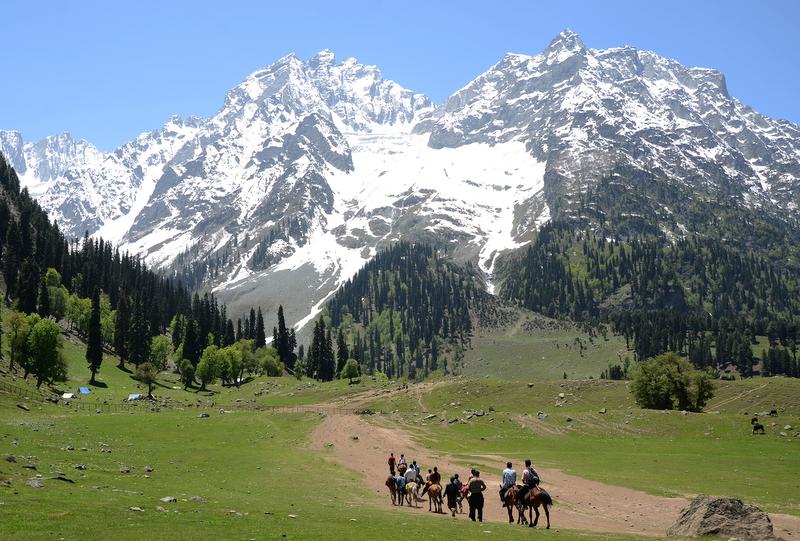
- 26 Mar 2025
In News:
Permafrost, the ground that remains frozen for at least two years, has long been a critical feature in high-altitude regions like the Kashmir Himalayas. Recent studies have highlighted that melting permafrost is emerging as a significant environmental threat, with the potential to disrupt both ecological systems and infrastructure in the region.
Key Findings of Recent Studies
- Extent of Permafrost: Permafrost covers 64.8% of Jammu & Kashmir (J&K) and Ladakh, with 26.7% being continuous, 23.8% discontinuous, and 14.3% sporadic.
- Regional Distribution: Ladakh has the highest concentration of permafrost (87%), while areas like the Shigar Valley and Siwaliks have no permafrost.
- Impact on Infrastructure: Permafrost degradation threatens key infrastructure, including roads, settlements, and hydropower projects. Approximately 193 km of roads, 2,415 households, and eight hydropower projects are at risk due to thawing permafrost.
- Glacial Lake Outburst Floods (GLOFs): Permafrost thaw increases the likelihood of GLOFs, as seen in recent events like the 2021 Chamoli disaster and the 2023 South Lhonak GLOF. These floods, triggered by the instability of glacial lakes formed by melting ice, can cause significant destruction.
Environmental Impacts of Permafrost Thawing
- Carbon Release: As permafrost melts, it releases stored organic carbon, including methane, a potent greenhouse gas that exacerbates climate change.
- Hydrological Changes: Thawing permafrost can alter river flow and groundwater availability, impacting water resources for local communities and ecosystems.
- Geological Instability: The breakdown of permafrost leads to landslides and slope instability, posing risks to both natural landscapes and human settlements.
Factors Contributing to Permafrost Degradation
- Global Warming: Rising surface temperatures are the primary driver of permafrost thaw.
- Human Activities: Construction activities, including road-building, dam construction, and real estate development, disturb the stability of permafrost. Additionally, deforestation and land-use changes increase the exposure of permafrost to solar radiation, accelerating its degradation.
- Natural Events: Earthquakes and natural processes, like rock-ice avalanches, also contribute to the destabilization of permafrost.
Risks to Local Communities and Infrastructure
- Vulnerable Regions: Thousands of households and critical infrastructure in permafrost-rich areas, such as Ladakh, are at risk due to permafrost thawing. Military and strategic infrastructure, including roads vital for connectivity, may face serious disruptions, compromising national security.
- Glacial Lake Outburst Floods (GLOFs): The melting of glaciers can lead to the formation of proglacial lakes, increasing the risk of GLOFs. In J&K, 332 such lakes have been identified, with 65 showing significant flood risks. GLOFs are a major threat to downstream communities and infrastructure.
Way Forward: Mitigating Risks
- Integrated Planning: Future infrastructure development, especially roads and hydropower projects, should incorporate data on permafrost zones. Risk-sensitive land-use planning and construction methods must be adopted to minimize environmental damage.
- Enhanced Monitoring: Remote sensing technologies, including satellite-based monitoring and ground-based LiDAR systems, should be employed to track permafrost degradation and associated environmental changes more effectively.
- Comprehensive Environmental Assessments: Environmental Impact Assessments (EIAs) must be strengthened to include the risks of permafrost thawing, particularly in relation to GLOFs, landslides, and groundwater depletion. This is crucial for ensuring that development projects in these regions do not exacerbate the environmental risks posed by permafrost degradation.
Targeted Species Conservation
- 26 Mar 2025
In News:
A major global study published in PLOS Biology (March 2025) has reaffirmed that targeted species-specific conservation measures are critical in reversing biodiversity loss and preventing extinctions. Despite the ongoing biodiversity crisis, where six times more species are declining than improving, the study found that where conservation efforts were applied, results were overwhelmingly positive.
Analyzing over 67,000 animal species from the IUCN Red List, researchers from institutions including the University of Cambridge, IUCN, and BirdLife International discovered that 99.3% of species that improved in threat status since 1980 had benefitted from conservation interventions, such as habitat protection, reintroduction, breeding programmes, and legal protections. Of the 969 species with globally increasing populations, 78.3% were under active conservation.
Notable global success stories include:
- Iberian Lynx: Rebounded from a few hundred to several thousand through breeding and habitat restoration.
- K?k?p? (New Zealand parrot): Revived via intensive monitoring and predator control.
- European Bison: Successfully reintroduced in Eastern Europe after extinction in the wild.
- Marine species such as humpback and blue whales also recovered after international moratoriums on whaling.
Island ecosystems like New Zealand, Mauritius, and the Seychelles showed the highest concentration of species recovery, while decline hotspots included the Tropical Andes, Sumatra, Malaysia, and Borneo.
Despite these successes, the study cautions that since 1980, 1,220 species of birds, mammals, and amphibians have deteriorated in Red List status compared to only 201 species that improved.
Causes include habitat loss, pollution, overexploitation, climate change, invasive species, and disease.The study called for landscape-scale conservation and ambitious implementation of Goal A of the Kunming-Montreal Global Biodiversity Framework to halt extinction risk and restore resilient populations.
India’s Species-Specific Conservation Efforts
India has adopted a multi-pronged species-specific conservation approach, primarily under the Integrated Development of Wildlife Habitats (IDWH), 2008, which continues under the 15th Finance Commission (2021–26). The scheme focuses on critically endangered species through captive breeding, habitat restoration, and community participation.
Key initiatives include:
- Species Recovery Programme: Prioritizes 22 species (16 terrestrial and 6 aquatic) for focused conservation.
- Project Tiger (1973) and Project Elephant (1992): Flagship conservation efforts for apex species.
- Project Crocodile: Initiated post-Wildlife (Protection) Act, 1972, supported by the UN. Saltwater crocodiles in Bhitarkanika increased from 95 (1975) to 1,811.
- Sea Turtle Conservation Project (1999): Focuses on Olive Ridley Turtles, listed as Vulnerable (IUCN), Schedule I (WLPA), and Appendix I (CITES).
- Vulture Action Plan 2020–25: Aims to eliminate diclofenac use and protect food sources for vultures. India's first Vulture Conservation and Breeding Centre (VCBC) was set up in Pinjore, Haryana.
- Indian Rhino Vision 2020: Increased the Greater One-Horned Rhinoceros population in Kaziranga National Park to over 2,600 (2022).
- Project Cheetah (2022): Reintroduces cheetahs extinct in India since 1952, with cheetahs from Namibia and South Africa released in Kuno National Park. India saw its first wild cheetah birth in 2023 after 75 years.
- Maharashtra’s Pangolin Action Plan: The first dedicated plan for pangolin conservation. Pangolins are listed under Schedule I of the WLPA, receiving the highest level of protection.
Global Environmental Data Strategy (GEDS)
- 25 Mar 2025
In News:
- The Global Environmental Data Strategy (GEDS), spearheaded by the United Nations Environment Programme (UNEP), is a comprehensive framework designed to address the triple planetary crises of climate change, pollution, and biodiversity loss.
- GEDS aims to leverage high-quality, accessible environmental data to support informed decision-making, foster innovative digital solutions, and promote sustainable development.
- The strategy is currently under development, with UNEP working to finalize it by December 2025. It emphasizes overcoming barriers such as data fragmentation, lack of interoperability, and limited access, which hinder the effective use of environmental data.
Key Focus Areas of GEDS
The GEDS framework is built around five key pillars that focus on overcoming challenges and unlocking the potential of environmental data:
- Data Quality and Provenance:
- Establishing standardized frameworks and mechanisms to classify and ensure the accuracy of environmental data.
- Focusing on data quality and developing systems to trace its origin (provenance).
- Data Governance:
- Promoting ethical and sustainable methodologies for managing environmental data.
- Developing governance models to ensure data is managed in a transparent and responsible way.
- Data Interoperability:
- Federating global and thematic data standards to allow seamless data sharing and integration.
- Ensuring that data across different platforms and systems can communicate with each other, facilitating better collaboration.
- Inclusive Data Access:
- Ensuring open, affordable, and machine-readable access to environmental data for all stakeholders.
- Addressing issues related to data discoverability and making data AI-ready to foster innovative solutions.
- Capacity-Building:
- Enhancing the skills and knowledge needed for effective data collection, governance, and use.
- Focusing on strengthening global initiatives, particularly in the Global South, to improve data management capabilities and foster inclusive participation.
Significance of GEDS
- Tackling Environmental Crises: GEDS provides a data-driven approach to addressing the challenges of climate change, pollution, and biodiversity loss, aligning with global efforts to achieve the UN Sustainable Development Goals (SDGs).
- Supporting Informed Decision-Making: By ensuring the availability of high-quality environmental data, GEDS helps governments, organizations, and communities make evidence-based decisions that are crucial for environmental sustainability.
- Fostering Innovation: The strategy facilitates the development of AI and data analytics tools to create innovative solutions for environmental management and protection.
- Global Collaboration: By promoting international cooperation and sharing of environmental data, GEDS aims to improve global collaboration to combat environmental challenges.
World Water Day 2025

- 25 Mar 2025
In News:
Marking World Water Day, the Ministry of Jal Shakti, in collaboration with the Ministry of Environment, Forest & Climate Change and the Government of Haryana, launched the much-anticipated sixth edition of Jal Shakti Abhiyan: Catch the Rain - 2025 in Panchkula, Haryana.
World Water Day 2025
- Observed On: 22nd March 2025
- 2025 Theme: ‘Glacier Preservation’
- Global Context: Declared by the United Nations General Assembly in 1993, conceptualized at the 1992 Rio Earth Summit.
- Linked SDG: Sustainable Development Goal 6 (SDG-6) – Clean Water and Sanitation for All by 2030.
- Purpose: To raise global awareness on water conservation and promote sustainable water use.
India's Observance: Launch of Jal Shakti Abhiyan – Catch the Rain 2025
- Launched by: Ministry of Jal Shakti, in collaboration with Ministry of Environment, Forest and Climate Change (MoEFCC) and Government of Haryana.
- Launch Venue: Panchkula, Haryana (first time outside Delhi).
- Theme: “????????????????: ??????????????” (People’s Action for Water Conservation – Towards Intensified Community Connect).
- Focus Areas:
- Rainwater harvesting
- Groundwater recharge
- Community-led water conservation
- Ecological restoration (forests, rivers, springs)
Key Campaigns & Initiatives
Jal Shakti Abhiyan: Catch the Rain 2025 (JSA:CTR)
- Targeted Districts: 148 water-stressed districts across India.
- Tagline: “Catch the Rain where it falls, when it falls.”
- Objective: Promote localized water conservation through people’s participation and decentralized planning.
“Jal-Jangal-Jan” Abhiyan
- Aim: Restore ecological connectivity between water, forests, and communities.
- Collaborators: MoEFCC and Jal Shakti Ministry.
- Tools Used: Awareness videos, AV content, best practice compilations.
State-Level Innovations: Haryana Model
- Launched:
- Mukhyamantri Jal Sanchay Yojana – Enhancing water harvesting through community participation.
- Water Resources Atlas – Scientific mapping of water availability.
- Online Canal Water Management System – Real-time irrigation data for efficiency.
- E-booklet on Integrated Water Resources Management.
- Infrastructure Projects under SBM-G & JSA:
- Community Sanitary Complexes
- Solid & Liquid Waste Management
- Gobardhan (Biogas) Projects
- Borewell Recharge Systems
- Micro-irrigation and Rainwater Harvesting Projects
Key Government Schemes Related to Water
- Jal Shakti Abhiyan (JSA) – Time-bound, mission-mode campaign for water conservation.
- Atal Bhujal Yojana – Participatory groundwater management in critical areas.
- AMRUT 2.0 – Urban water supply and sewerage services improvement.
Eurasian Goshawk sighting at Tansa Wildlife Sanctuary

- 24 Mar 2025
In News:
A significant wildlife discovery has been made at Tansa Wildlife Sanctuary, Maharashtra, where the Eurasian goshawk, a large bird of prey, was spotted for the first time. This marks the first documented instance of the Eurasian goshawk in the sanctuary, although the species has been previously recorded in Maharashtra three times.
About the Eurasian Goshawk
- Scientific Name: Accipiter gentilis
- Description: A powerful raptor known for its short, broad wings and long tail.
- Habitat: Dense forests, particularly coniferous and mixed woodlands across Europe, Asia, and parts of North America.
- Winter Visitor: The Eurasian goshawk is a winter visitor to India, making this sighting at Tansa particularly noteworthy.
Tansa Wildlife Sanctuary
- Located in the foothills of the Western Ghats in Thane District, Maharashtra, Tansa Wildlife Sanctuary covers 320 sq. km.
- Positioned approximately 90 km northeast of Mumbai, it serves as a vital catchment area for Tansa Lake and is bordered by the Tansa and Vaitarna rivers.
Flora and Fauna
The sanctuary boasts a rich diversity of flora and fauna, including:
- 200 bird species
- 54 animal species, including endangered animals like:
- Panther
- Hyena
- Barking Deer
- Notable species include:
- Critically Endangered vultures
- Vulnerable Pallas’s fish-eagle
Vegetation and Landscape
- Southern Tropical Moist Deciduous Forest with patches of Evergreen Forest.
- Flora includes trees like Kalamb, Bibla, Khair, Hed, Teak, and Bamboo.
Avian Discoveries
Tansa Wildlife Sanctuary is also renowned for its avian discoveries, such as the critically endangered Forest Owlet, which was first documented here in 2014. This discovery highlighted the sanctuary’s significance for bird conservation.
Conservation Efforts and Ecological Role
The sighting of the Eurasian goshawk further emphasizes the critical need for ongoing conservation efforts at Tansa Wildlife Sanctuary.
Role of the Eurasian Goshawk in Ecosystem
As a bird of prey, the Eurasian goshawk plays a vital role in maintaining ecological balance by controlling populations of smaller mammals and birds.
Though listed as "Least Concern" on the IUCN Red List, the Eurasian goshawk’s presence underscores the sanctuary’s importance in the region’s biodiversity.
2030 Global Forest Vision (GFV)
- 23 Mar 2025
In News:
The 2030 Global Forest Vision (GFV), released in March 2025 by the Forest Declaration Assessment (FDA), outlines priority actions for governments to reverse forest loss and align environmental and trade policies ahead of UNFCCC COP30 (November 2025).
Background:
- The Forest Declaration Assessment (FDA) was established in 2015 to monitor progress on the New York Declaration on Forests (NYDF), a voluntary pact launched in 2014.
- NYDF includes 10 goals aimed at halting deforestation by 2030 and is supported by governments, corporations, indigenous groups, and civil society.
- India is not a signatory to the NYDF as of 2025.
Current State of Forests (Key Data):
- Despite commitments from 140 countries, 6.37 million hectares of forests were lost in 2023.
- Major drivers of deforestation:
- Agricultural demand for palm oil, soy, beef, and timber.
- 80% of Amazon deforestation is due to cattle ranching.
- 800+ million trees lost between 2017–2022 to meet Brazilian beef exports.
- In Indonesia and Malaysia, palm oil expansion threatens orangutans and Sumatran tigers.
Eight Priority Actions for Governments (GFV 2025):
- Ambition:Integrate forest conservation into national climate and biodiversity plans and COP30 commitments.
- Trade:Ensure legal, deforestation-free, and degradation-free trade through international partnerships.
- Finance:Scale up results-based payments and forest carbon credit systems, as agreed in the 2024 Forest & Climate Leaders’ Statement.
- Rights:Secure land rights of Indigenous Peoples (IPs) and Local Communities (LCs) to protect traditional forest stewardship.
- Supervision:Mandate financial institutions to assess and manage forest-related risks.
- Subsidies:Repurpose harmful subsidies to support sustainable food systems, bioeconomy, and forest management.
- Governance:Align land-use sector governance with global forest and climate commitments.
- Debt Flexibility:Recognize forests as natural capital in debt management to enhance fiscal space for forest-rich countries.
Global and Regional Efforts:
- EU Deforestation Regulation (2026):Bans imports linked to deforestation; companies must ensure supply chain transparency.
- U.S. Initiatives:Stricter laws against illegal logging and deforestation-linked imports.
- Challenges:
- China and India have not implemented deforestation-free trade regulations.
- Smallholder farmers lack the resources to certify products as deforestation-free.
- Developing nations (Brazil, Indonesia, African countries) express concerns over economic impacts of stricter trade rules.
Recommendations by GFV 2025:
- Tighten Global Trade Policies:Prevent companies from rerouting products to markets with weak regulations.
- Adopt Deforestation-Free Trade Laws:India, China, and other major economies urged to enact such policies.
- Support Local Economies:Provide technical and financial support to farmers for sustainable practices.
- Enhance Global Monitoring:Improve tracking systems for forest-linked commodities and promote global cooperation.
WEF UpLink Annual Impact Report 2025

- 21 Mar 2025
In News:
The World Economic Forum’s (WEF) UpLink Annual Impact Report 2025 underscores the significant contributions of early-stage start-ups in tackling climate and sustainability challenges globally.
About UpLink:
- Launched: 2020 at Davos by WEF in collaboration with Deloitte and Salesforce.
- Objective: Open innovation platform to support the UN Sustainable Development Goals (SDGs) by connecting entrepreneurs with experts, investors, and stakeholders.
Key Environmental and Social Impacts (2023–2024):
Category Impact
Carbon Emissions 142,400 tonnes of CO? prevented (equal to emissions
of ~30,000 cars)
Ecosystem Protection 140 million hectares of land and water safeguarded
Water Management 2.5 billion litres of hazardous wastewater treated
Waste Management 28 million tonnes of waste tracked
Water, Sanitation & Hygiene (WASH) 2.7 million people gained improved access
Job Creation 30,000+ new jobs generated
Livelihood Support ~500,000 smallholder farmers and fishers experienced
income growth
Waste Collector Empowerment 18,000 collectors integrated into formal markets
Notable Indian Contributions:
- Indra Water: Processed 1.2 billion litres of wastewater in 2024 (243% rise from 2022).
- S4S Technologies: Reduced 60,000 tonnes of food waste — enough to feed 2.7 million people for a month.
Global Innovations Highlighted:
- EnviCore (Canada): Uses mining waste in construction to cut emissions.
- Umgrauemeio (Brazil): AI-based wildfire monitoring across 6.7 million hectares of forests.
- SHAYP: Saved 7 billion litres of water in 2024 using leakage detection; aims for 100 billion litres by 2027.
- GreenPlat (Brazil): Tracked 12.3 million tonnes more waste in 2024 than the previous year.
Investment and Innovation Trends:
- Total Funds Raised by UpLink Ventures in 2024: $633 million (up by $196 million from 2023).
- Customer Base Growth: Nearly 50% of ventures reported over 40% increase in customers.
- Circular Economy Focus: 13 ventures supported under the Traceability for Circularity Challenge to promote ethical and waste-reducing value chains.
Future Focus Areas (Planned by UpLink):
- Sustainable mining
- Carbon capture technologies
- AI-driven environmental monitoring
State of the Global Climate 2024 Report

- 21 Mar 2025
In News:
The World Meteorological Organization (WMO) released its State of the Global Climate 2024 Report at COP29 (Baku), warning that global warming is dangerously close to breaching the 1.5°C threshold set by the Paris Agreement.
About WMO
- Type: UN Specialized Agency
- Established: 1950
- Headquarters: Geneva, Switzerland
- Membership: 193 (187 Member States + 6 Territories)
- Mandate: Meteorology, operational hydrology, and geophysical sciences.
- Reports Released:
- State of the Global Climate Report
- Greenhouse Gas Bulletin
- Global Water Resources Report
- State of Climate Services Report
- United in Science Report
Key Findings – State of Global Climate 2024
Global Temperature Rise
- Current warming: 1.34°C–1.41°C above pre-industrial levels.
- 19 of the last 20 months crossed the 1.5°C threshold temporarily.
- 2024: Warmest year in the 175-year observational record.
- Projected crossing of the 1.5°C threshold: by September 2029.
Greenhouse Gases (2023)
- CO?: 420 ppm – 151% of pre-industrial levels (highest in 800,000 years)
- CH? (Methane): 1923 ppb – 266% of pre-industrial levels
- N?O (Nitrous Oxide): 335.8 ppb – 124% of pre-industrial levels
Ocean & Cryosphere
- Ocean Heat Content: Highest in 65 years – oceans absorb 90% of global heat
- Sea Level Rise:
- 1993–2002: 2.1 mm/year
- 2015–2024: 4.7 mm/year (rate doubled)
- Glacier Melt:
- 2022–2024: Largest 3-year negative mass balance on record
- Severe loss in Norway, Sweden, Svalbard, and Andes
- Arctic Sea Ice: Record lows for 18 consecutive years
- Antarctic Sea Ice: 2nd-lowest extent ever
- Ocean Acidification:
- Surface pH falling fastest in Indian Ocean, Southern Ocean, and Pacific
- Effects irreversible for centuries
Extreme Weather Events & Displacement
- 2024: Record-high displacements from climate disasters
- Cyclones, floods, and droughts worsened food and humanitarian crises
- Worst-hit regions: East Asia, Southeast Europe, West Asia, Mediterranean
Reasons Behind These Trends
- GHG Emissions: Fossil fuel combustion, industrial emissions, agriculture, and deforestation.
- El Niño Effect: Warm Pacific currents intensified 2024’s global heat.
- Urban Heat Islands: Dense cities retain heat, increasing local warming.
- Ocean Absorption: Excess atmospheric CO? and heat absorbed by oceans.
Global Climate Governance
- UNFCCC (1992): Multilateral treaty for climate action.
- Paris Agreement (2015):
- Goal: Limit warming to below 2°C, aim for 1.5°C.
- Nationally Determined Contributions (NDCs)
- $100 billion/year climate finance pledge
- Global Methane Pledge (2021): Cut methane emissions by 30% by 2030.
- Global Ocean Treaty (2023): Protect 30% of oceans by 2030.
- UN Decade on Ecosystem Restoration (2021–2030): Forest and marine recovery.
- IPCC: UN scientific body for climate assessments (doesn’t conduct research).
India’s Climate Initiatives
Targets & Strategies
- Net Zero by 2070 (COP26)
- LT-LEDS (2022): Long-term low emissions strategy
- Updated NDC (2022):
- Reduce GDP emissions intensity by 45% by 2030 (vs. 2005)
- 50% electricity capacity from non-fossil sources by 2030
Renewable Energy & Alliances
- International Solar Alliance (ISA):
- Launched with France in 2015 (COP21)
- Aim: Mobilize $1 trillion in solar investments by 2030
Afforestation & Ecosystem Protection
- Green Credit Program (2023) – incentivizes afforestation
- Ek Ped MaaKe Naam (2024) – tree plantation campaign
- NAP, CAMPA, Forest Act 1980 – promote forest restoration
- MISHTI (2023) – Mangrove restoration (?12.55 cr in 2024–25)
Behavioral Change
- LiFE (Lifestyle for Environment) – promotes sustainable consumption
Challenges to Climate Action
Sector Key Challenges
Energy High coal dependence (>50%), renewable intermittency, grid gaps, foreign tech reliance
Urbanization Rising energy/waste demand, land use conflicts
Industry Hard-to-abate emissions in cement, steel, transport
Agriculture Fossil fuel inputs, livestock methane, fertilizer N?O
Finance Climate finance disparities; India criticized COP29’s $300 bn/year goal as insufficient
Equity Developed nations emit more, but developing nations suffer more
Greenwashing Misleading climate claims by corporates/governments
National Wildlife Health Policy (NWHP)
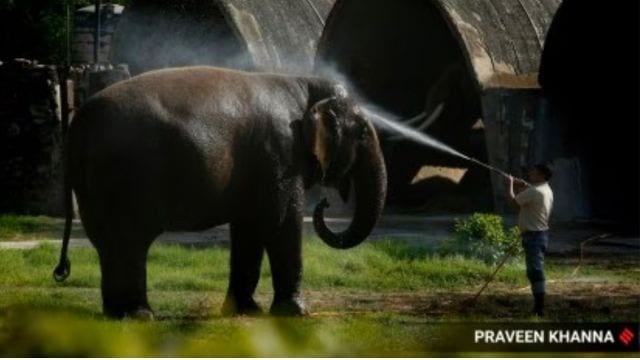
- 20 Mar 2025
In News:
In the aftermath of the COVID-19 pandemic, the Government of India is formulating the National Wildlife Health Policy (NWHP) to address the growing threat of zoonotic diseases through integrated wildlife health management. Over 60% of emerging infectious diseases in humans originate from animals, underscoring the importance of a "One Health" approach—integrating human, animal, and environmental health.
Key Objectives of NWHP
- Establish a comprehensive wildlife disease surveillance system.
- Strengthen diagnostic infrastructure and research capacity.
- Facilitate cross-sectoral collaboration among environment, agriculture, and animal husbandry ministries.
- Integrate existing animal and human health data systems with wildlife health information.
Institutional Framework & Implementation
- National Referral Centre for Wildlife (NRC-W):
- Inaugurated in Junagadh, Gujarat (March 2024).
- India’s first wildlife disease diagnostic and research centre.
- Will serve as a referral hub for investigating wildlife mortality and outbreak events.
- Wildlife Health Information System (WHIS):
- Proposed digital system for real-time disease data collection, reporting, and analysis.
- Will integrate with National Animal Disease Reporting System (NADRS) and National Animal Disease Referral Expert System (NADRES).
- Satellite Diagnostic Labs:To be established near important forest zones for timely wildlife disease detection and diagnosis.
- Community Engagement:Involves measures like cattle vaccination near national parks to reduce disease transmission risks.
Key Agencies Involved
- Central Zoo Authority (CZA): Nodal agency under the Wildlife Protection Act, 1972; responsible for policy coordination and implementation.
- Office of the Principal Scientific Adviser and IIT-Bombay: Supporting technical and policy formulation.
- Ernst & Young: Consultancy support.
- Ministry of Environment, Forest & Climate Change (MoEF&CC): Policy oversight.
Alignment with Existing Conservation Frameworks
- National Wildlife Action Plan (2017–31):
- Provides for 103 actions and 250 projects.
- Includes protocols for disease surveillance in protected areas and tiger reserves.
- Wildlife Protection Act, 1972: Provides legal basis for wildlife health regulation and zoonotic disease control.
Chhareda Panchayat Water Conservation Model
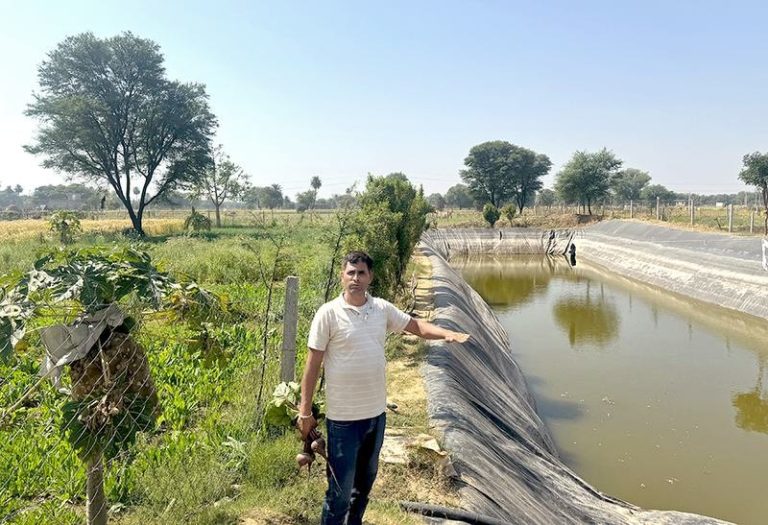
- 19 Mar 2025
In News:
Rajasthan’s Chhareda Panchayat in Dausa district has emerged as a leading example of effective water conservation, driven by a community-driven initiative that has significantly transformed agricultural practices and farmer livelihoods. The project, led by Vipra Goyal, an alumnus of IIT-Kharagpur, has revolutionized water usage in the region through the construction of 250 farm ponds.
Key Aspects:
- Objective:The model aims to address water scarcity and groundwater depletion through rainwater harvesting and the construction of farm ponds, reducing dependence on overexploited groundwater sources.
How Farm Ponds are Contributing to Water Conservation in Rajasthan
- Rainwater Harvesting:Farm ponds serve as storage systems for rainwater, minimizing reliance on deep, contaminated groundwater sources. This helps prevent the further depletion of underground water reserves.
- Year-Round Water Availability:The ponds provide consistent water supply for both kharif and rabi crops, ensuring that farmers can grow crops throughout the year without facing water shortages.
- Groundwater Conservation:By reducing the need to extract groundwater, this initiative has helped conserve approximately 30 crore litres of water annually, easing the pressure on local aquifers.
- Boosting Agricultural Productivity and Income:With reliable water sources, farmers have shifted from subsistence farming to growing cash crops, which has resulted in a collective increase of about ?5 crore in household incomes.
- Reduced Water Pollution:The initiative avoids the use of groundwater contaminated with harmful substances like arsenic and fluoride, which are prevalent in many areas of Rajasthan.
- Sustainability and Climate Resilience:The farm ponds offer a climate-resilient solution, ensuring that agriculture in water-scarce regions is sustainable even in the face of erratic rainfall patterns.
- Cost-Free Construction:The construction of the ponds has been facilitated through CSR funds and government schemes, making the project cost-free for farmers.
International Big Cat Alliance (IBCA)
- 19 Mar 2025
In News:
The International Big Cat Alliance (IBCA), a treaty-based intergovernmental organisation dedicated to the conservation of seven major big cat species, has officially signed an agreement with the Government of India, establishing India as the permanent host of its headquarters and secretariat.
Background and Launch
- Launched: April 2023 by Prime Minister Narendra Modi during the 50th anniversary celebrations of Project Tiger.
- Objective: To facilitate global cooperation for the conservation of seven big cats:Tiger, Lion, Leopard, Snow Leopard, Cheetah, Puma, andJaguar.
- The IBCA is implemented through the National Tiger Conservation Authority (NTCA) under the Ministry of Environment, Forest and Climate Change (MoEFCC).
International Status and Membership
- The IBCA became a treaty-based intergovernmental alliance after five countries ratified the framework agreement:India, Liberia, Eswatini, Somalia, andNicaragua.
- India formally joined the IBCA in September 2023.
- The alliance is open to all UN Member States, including:
- Range countries (where big cats are native), and
- Non-range countries that wish to support conservation efforts globally.
Headquarters and Agreement
- On March 28, 2024, the Union Cabinet approved the establishment of the IBCA headquarters in India.
- An agreement was signed in May 2024 between the IBCA and the Indian government, outlining:
- Privileges and immunities for IBCA personnel,
- Visa facilitation, and
- Operational and legal provisions for the headquarters.
Funding and Support
- India has committed a total of ?150 crore (2023–2028) for:
- Creating a corpus fund,
- Building infrastructure, and
- Meeting recurring expenditures over five years.
Colossal Squid

- 19 Mar 2025
In News:
In a landmark moment for marine biology, scientists have captured the first-ever footage of a colossal squid in its natural deep-sea habitat. The sighting was made by an international research team using a remotely operated submersible in the South Atlantic Ocean, near the South Sandwich Islands, and was announced by the Schmidt Ocean Institute in April 2025.
About the Colossal Squid
- Scientific Name:Mesonychoteuthishamiltoni
- Distribution: Found in the cold, deep waters of the Southern Ocean near Antarctica
- IUCN Status:Least Concern
The colossal squid is among the largest and most elusive invertebrates on Earth. The filmed specimen was a juvenile about 30 cm (1 foot) long, observed at a depth of 600 meters. However, fully grown adults can reach up to 7 meters (23 feet) in length and weigh around 500 kg.
Key Features
- Body: Tube-shaped and soft-bodied, similar to octopuses but far more massive
- Arms & Tentacles: Equipped with suckers and sharp, swivelling hooks — a feature unique to the species
- Eyes: Possess the largest eyes known in the animal kingdom, aiding visibility in the pitch-dark ocean depths
- Coloration:
- Juveniles are nearly transparent, giving them a glassy, ghost-like appearance
- Adults become opaque, with dark red or purple hues and muscular limbs
Scientific Importance & Recent Discovery
- This deep-sea sighting comes almost a century after the species was first identified, and confirms long-standing hypotheses based on carcasses found in the stomachs of whales and seabirds.
- The team is now testing improved camera systems to attempt capturing footage of an adult colossal squid in action.
India’s Carbon Credit Trading Scheme (CCTS)
- 16 Mar 2025
In News:
To meet its climate commitments under the Paris Agreement, India is moving towards a market-based mechanism for emissions reduction through the Carbon Credit Trading Scheme (CCTS), 2023. The scheme was made possible by amending the Energy Conservation Act, 2021 and replaces the Perform, Achieve, and Trade (PAT) scheme operational since 2012.
What is the Carbon Credit Trading Scheme (CCTS)?
- CCTS is India’s version of an emissions trading system (ETS) designed to reduce greenhouse gas (GHG) emissions intensity — emissions per unit of output — rather than absolute emissions.
- It introduces Carbon Credit Certificates (CCC), each representing one tonne of CO? equivalent (tCO?e) reduction.
- Managed by the Bureau of Energy Efficiency (BEE) and coordinated by a National Steering Committee, the scheme involves various regulatory bodies including electricity exchanges, MoEFCC, and the Central Electricity Regulatory Commission.
Key Features of the CCTS
Aspect Description
Transition from PAT - Shifts focus from energy efficiency (PAT) to emission intensity (CCTS).
Coverage - Initially targets energy-intensive sectors: Iron & Steel, Cement, Aluminium,
Fertilisers, Refineries, Pulp & Paper, and Textiles (~16% of national
GHG emissions). Power sector (~40%) may be included later.
Dual Mechanisms - 1. Compliance: Mandates targets for large emitters. 2. Offset:
Voluntary participants earn credits by reducing emissions.
Implementation Timeline - Expected to launch fully by mid-2026, in a phased manner.
Global Context of Carbon Pricing
- As of June 2024, 89 countries operate carbon pricing mechanisms, covering 12.8 Gt CO?e (25% of global emissions).
- Carbon pricing methods:
- ETS (Cap-and-Trade / Baseline-and-Credit): Companies trade allowances or credits based on performance.
- Carbon Tax: Fixed price on emissions; provides cost certainty but not emissions certainty.
- Crediting Mechanism: Projects generating verified emission reductions earn tradable carbon credits.
Challenges in Implementing CCTS
- Target Setting: Overly lenient targets may cause credit oversupply, reducing prices; overly strict ones risk high compliance costs.
- Compliance Gaps: Under PAT, over half the required energy certificates were never purchased, with no penalties imposed.
- Delays: Credit issuance under PAT (Phase IV onwards) has been delayed since 2021, affecting market confidence.
- Transparency: Lack of public access to data on actual performance undermines accountability.
- Monitoring and Verification (MRV): Requires robust systems to prevent double counting and ensure credible reporting.
Steps to Strengthen India’s Carbon Market
- Align with global practices: Learn from the EU ETS — implement strict monitoring, gradual tightening of caps, and price stability mechanisms.
- Robust MRV Framework: Ensure accuracy in emission data to boost trust.
- Digital Trading Platform: Track and authenticate credit transactions; avoid fraud.
- Industry Incentives: Encourage early compliance via tax benefits and access to green finance.
- Trade Compatibility: Prepare for global measures like the EU’s Carbon Border Adjustment Mechanism (CBAM) by ensuring transparency and comparability.
India’s CCTS represents a significant shift in climate governance by institutionalizing carbon pricing. While it brings India in line with evolving global practices, the success of the Indian carbon market will depend on credible enforcement, transparent functioning, and strong regulatory architecture. If implemented effectively, it can drive low-carbon growth and support India’s target of reducing emissions intensity by 45% by 2030.
Pobitora Wildlife Sanctuary
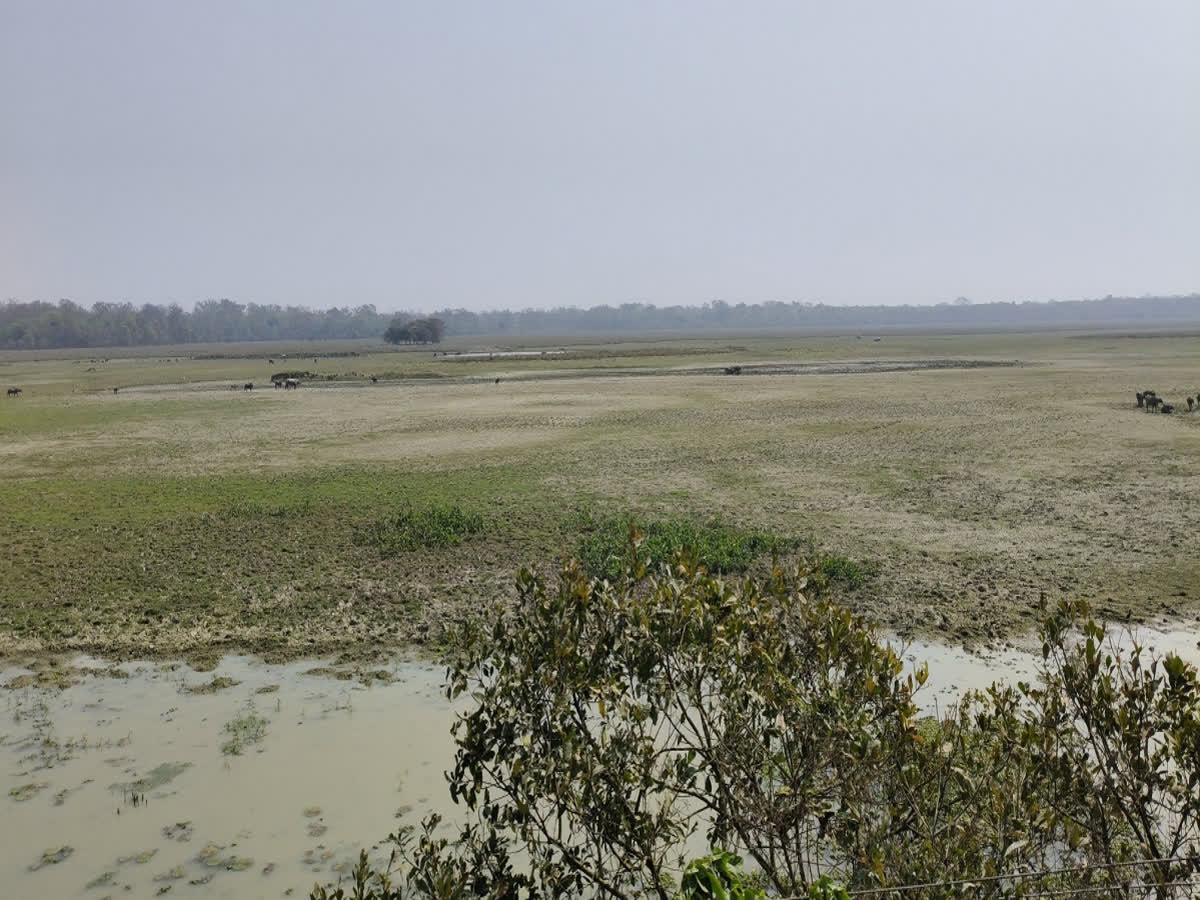
- 15 Mar 2025
In News:
Pobitora Wildlife Sanctuary, located in Assam, is renowned for its high density of the Great Indian One-Horned Rhinoceros and diverse biodiversity. The sanctuary, covering 38.85 km², is facing a growing concern as one of its major wetlands, TamulidobaBeel, is drying up. This situation underscores the urgent need for habitat management to protect the sanctuary's wildlife.
About Pobitora Wildlife Sanctuary:
- Location: Located within 30 km of Guwahati, Assam, it was established in 1998 and spans 48.81 km².
- Fauna: Famous for its rhino population, the sanctuary also houses leopards, wild boars, barking deer, wild buffaloes, and over 2,000 migratory birds.
- Flora: The sanctuary is dominated by wet savannah and marshland, though the invasive water hyacinth is a significant problem, especially for waterfowl.
TamulidobaBeel: A Crucial Wetland
- Role: A key water body within the sanctuary, TamulidobaBeel is vital for rhinos, water buffaloes, and migratory birds.
- Drying Concern: Experts and locals have observed the early drying up of the Beel, a trend that has worsened over the past few years. Migratory birds have already abandoned the wetland earlier than expected, signaling a broader ecological imbalance.
Factors Contributing to Drying of the Wetland:
- Siltation: The deposition of silt has significantly reduced water retention in the Beel.
- Climate Change: Predictions of a hotter weather season (March-May 2025) by the India Meteorological Department suggest further strain on the sanctuary's water resources, affecting biodiversity.
Ecological Implications:
- Rhino Habitat Impact: About 20-25 rhinos are regularly found near TamulidobaBeel. The drying of this wetland increases water scarcity in their core habitat, risking human-animal conflicts as rhinos may stray outside the sanctuary.
- Bird Migration: The Beel also serves as a migratory bird hub, particularly in winter. Early drying may disrupt migration patterns, affecting bird populations.
Government Response and Measures:
- Desilting Efforts: The Forest Department has taken proactive measures, including desilting the Beel to restore water levels and maintain its ecological functions.
- Expert Consultations: Collaborations with institutions like IIT Guwahati are underway to assess and manage the wetland restoration scientifically.
- Long-term Plans: Restoration efforts are focused on improving water retention and managing silt deposition, alongside broader habitat management initiatives.
Expert Recommendations:
- Experts emphasized the critical need for scientific habitat management and stressed the importance of restoring wetlands to ensure the sanctuary's long-term ecological balance.
- The government must focus on sustainable habitat conservation and water management strategies to protect species, especially the rhinos.
World Air Quality Report 2024
- 15 Mar 2025
In News:
India remains among the world’s most polluted countries despite slight improvements in air quality.
Published by: IQAir (Swiss Air Quality Technology Firm)
Key Findings:
- India’s Global Rank: 5th most polluted country in 2024 (improved from 3rd in 2023).
- Average PM2.5 Level (India): 50.6 µg/m³ in 2024 — 10 times higher than the WHO guideline of 5 µg/m³.
- Top Polluted Cities:
- Byrnihat (Assam-Meghalaya border) — most polluted city globally with PM2.5 at 128.2 µg/m³.
- Delhi — most polluted capital city globally with PM2.5 at 91.6 µg/m³.
- 13 of the world’s 20 most polluted cities are in India, including Mullanpur, Faridabad, Gurugram, Bhiwadi, Noida, and Ganganagar.
- Northern India: Faces severe pollution due to crop stubble burning (contributes ~60% of PM2.5 levels).
- Global Air Quality: 91% of countries exceeded WHO PM2.5 safe limits; only 12 countries met the recommended levels.
Major Sources of PM2.5 Pollution:
- Vehicular emissions
- Industrial discharges
- Biomass burning (e.g., firewood, crop residue)
Health & Environmental Impact:
- Health: Linked to respiratory and cardiovascular diseases, cancers; reduces life expectancy by ~5.2 years in India.
- Annual Death Toll: ~1.5 million deaths in India linked to PM2.5 exposure (2009–2019, Lancet Study).
- WHO: 99% of the world’s population breathes polluted air.
India’s Measures to Combat Air Pollution:
Initiative Description
NCAP (2019) - Aims to reduce PM levels by 20–30% in non-attainment cities by
2026. Focuses on monitoring, emissions control, public awareness.
BS-VI Emission Standards - Implemented in 2020 for vehicles to reduce vehicular pollution.
FAME Scheme - Promotes electric and hybrid vehicles to cut down transport-related emissions.
PM Ujjwala Yojana - Provides LPG connections to reduce indoor air pollution from biomass.
GRIHA - Encourages eco-friendly construction practices.
GRAP - Emergency action plan in Delhi-NCR during high pollution episodes.
Commission for Air Quality Management - Coordinates air quality actions across NCR and
nearby areas.
Public Transport & Regulation - Expanding metro/bus networks, penalising high-emission vehicles.
Way Forward:
- Strengthen enforcement of emission norms for vehicles and industries.
- Promote LPG usage over biomass for cooking, especially among rural poor.
- Increase public transport options and incentivise clean technologies.
- Raise awareness and improve inter-state coordination on stubble burning.
Uniyalakeralensis
- 15 Mar 2025
In News:
Researchers have confirmed the discovery of a new flowering plant species named Uniyalakeralensis (family: Asteraceae) in the Agasthyamala Biosphere Reserve (ABR), located in the southern Western Ghats of Kerala. Endemic to southwest India, the species is named in honour of the state of Kerala.
Key Features:
- Plant Type: Dense shrub with light purple flowers, growing 1–3 metres tall.
- Distinctive Traits: Larger leaves, longer petioles (leaf stalks), and fewer lateral veins compared to related species like U. comorinensis and U. salviifolia.
- Flowering & Fruiting Period: August to April.
- Habitat: Open areas on western mountain slopes of ABR, at elevations between 700–1,400 metres.
- Distribution: Around 5,000 individuals across four subpopulations, covering an estimated area of 250 km².
- IUCN Status (2024): Data Deficient (DD) due to limited information on long-term population trends.
The plant was first collected in 1998 and initially misidentified as Vernonia multibracteata. Later taxonomic revisions led to the recognition of Uniyala as a separate genus, named after botanist B.P. Uniyal, with this species formally described as new.
About Agasthyamala Biosphere Reserve (ABR):
- Location: Spans parts of Kerala and Tamil Nadu in the southern Western Ghats.
- UNESCO Status: Recognized under the Man and the Biosphere (MAB) Programme in 2016.
- Biodiversity Highlights: Home to over 2,254 higher plant species, including 405 endemics; key fauna includesNilgiriTahr, Lion-tailed Macaque, Bengal Tiger, and Indian Elephant.
- Indigenous Communities: Inhabited by the Kani tribes in both states.
Madhav National Park
- 13 Mar 2025
In News:
Madhav National Park in Madhya Pradesh has been declared India’s 58th Tiger Reserve and the 9th in Madhya Pradesh, strengthening the state's status as a leader in tiger conservation.
About Madhav National Park
- Location: Shivpuri district, Madhya Pradesh; part of the Chambal region and the Upper Vindhyan Hills on the northern fringe of the Central Highlands.
- Established: As Madhya Bharat National Park in 1955; renamed Madhav National Park in 1959.
- National Park Status: Since 1958.
- Area: Approx. 354 sq km (expanded from 165 sq km).
- Historical Significance: Former hunting ground of Mughal emperors and Maharaja of Gwalior; named after Maharaja Madhav Rao Scindia.
Ecological Profile
- Vegetation:
- Northern Tropical Dry Deciduous Forests
- Dry Thorn Forests typical of North-Western Madhya Pradesh
- Fauna:
- Large Mammals: Tigers, leopards, wolves, jackals, foxes, wild dogs
- Antelopes: Nilgai, Chinkara, Chowsinga
- Deer Species: Chital, Sambar, Barking Deer
- Others: Crocodiles, porcupines, wild pigs, pythons
- Aquatic Ecosystems:
- Two major lakes: Sakhya Sagar and Madhav Sagar support aquatic biodiversity
Tiger Conservation Highlights
- Declared a Tiger Reserve: In 2024, becoming India’s 58th and Madhya Pradesh’s 9th.
- Tiger Reintroduction: Began in 2023; currently home to five tigers, including two cubs.
- Core and Buffer Zones:
- Core Zone: Strictly protected, no human activity
- Buffer Zone: Allows limited, regulated human use to support coexistence
Governance and Protection Framework
- Tiger Reserve Status:
- Notified under Section 38V of the Wildlife Protection Act, 1972
- Falls under Project Tiger (1973), monitored by the National Tiger Conservation Authority (NTCA)
- Approval Process:
- State Government Proposal
- NTCA Evaluation
- MoEFCC Final Notification
- Monitoring System: M-STrIPES (Monitoring System for Tigers – Intensive Protection and Ecological Status) used for surveillance and conservation.
Japan’s Largest Wildfire in Decades
- 11 Mar 2025
In News:
Japan is currently battling its most extensive wildfire in over three decades, with flames spreading across approximately 1,200 hectares of forest in Ofunato, a coastal city in Iwate Prefecture, located in northern Honshu Island. This is Japan's largest wildfire since the 1992 Kushiro fire in Hokkaido, which burned 1,030 hectares.
The cause remains unknown, and the situation is worsened by record-low rainfall (2.5 mm in February) and the hottest year on record in 2023, highlighting the growing impact of climate change. The region is also vulnerable due to its dense forests, dry winter winds, and limited precipitation during February–April, a peak season for wildfires in Japan.
About Ofunato and Iwate Prefecture
- Location: Ofunato is in Iwate Prefecture, northern Japan, along the Pacific coast.
- Ecological Importance: It features mountainous terrain, coastal forests, and is known for fisheries, tourism, and biodiversity.
Japan – Geographical Context
- Location: East Asia, surrounded by the Pacific Ocean.
- Capital: Tokyo.
- Neighbouring Countries (via maritime boundaries): China, South Korea, North Korea, Russia, Taiwan.
- Geological Features:
- Over 80% mountainous terrain; part of the Pacific Ring of Fire (earthquake and volcanic activity-prone).
- Major Islands: Honshu (location of Ofunato), Hokkaido, Kyushu, Shikoku.
- Climate: Ranges from humid subtropical (south) to cold continental (north).
- Major Rivers: Shinano, Tone, Kiso.
Rare Civet Cat
- 10 Mar 2025
In News:
Recently, a rare civet cat, typically native to the Seshachalam forests near Tirumala, was unexpectedly sighted near Tadepalli in Guntur district, Andhra Pradesh. The animal entered a residential area, startling locals, and was later safely rescued and examined by forest officials.
About Civet Cats
- Taxonomy:Civets belong to the Viverridae family, which includes civets, genets, oyans, and linsangs. There are 15–20 species across 10–12 genera.
- Distribution:Found in Africa, southern Europe, and Asia, including eight wild species in India.
- Common Palm Civet and Small Indian Civet are widely distributed.
- The Malabar Large-spotted Civet (Viverracivettina) is critically endangered and endemic to the Western Ghats.
- Conservation Status:The Malabar Civet is listed as Critically Endangered under the IUCN Red List.
Physical Characteristics:
- Appearance: Cat-like, with thickly furred tail, pointed snout, and small ears.
- Size: Body length: 40–85 cm; Tail: 13–66 cm; Weight: 1.5–11 kg.
- Coloration: Usually buff or grayish, with black spots, stripes, or both.
Behavior and Habitat:
- Nocturnal and Solitary: Typically dwell in tree hollows, rocks, or similar secluded areas.
- Diet: Primarily frugivorous and insectivorous, occasionally feeding on small animals.
- Habitat Range: Though mostly forest-dwelling, rare sightings in urban zones have occurred, as seen in the Tadepalli incident.
Significance of Recent Sighting:
- The civet descended from Tadepalli hills and entered a home, prompting forest department intervention.
- Identified as a rare species similar to African civets.
- Medically examined, found healthy, and is to be rehabilitated into the wild.
- The incident highlights growing human-wildlife interactions and the need for urban wildlife awareness.
Lake Tanganyika

- 09 Mar 2025
In News:
- The countries bordering Lake Tanganyika—Burundi, Democratic Republic of Congo (DRC), Tanzania, and Zambia—have launched a five-year biodiversity conservation project.
- The initiative, led by the United Nations Environment Programme (UNEP) and funded by the Global Environment Facility (GEF), aims to tackle transboundary threats to the lake’s biodiversity.
About Lake Tanganyika:
Feature Details
Location East Africa
Bordering Countries Burundi, DRC, Tanzania, Zambia
Length Over 400 miles (Longest freshwater lake in the world by length)
Depth One of the world’s deepest lakes
Geological Setting Located in the Western Rift Valley
Major Inflows Malagarasi, Ruzizi, Kalambo Rivers
Outflow Lukuga River (into the Lualaba River)
Flora Located at the floral transition zone of eastern and western Africa; oil palms found along shores
Livelihood Agriculture (rice, subsistence crops) and fishing are common
Key Features of the Conservation Project:
- Project Title:Biodiversity Conservation, Sustainable Land Management and Enhanced Water Security in Lake Tanganyika Basin
- Budget: USD 14.5 million
- Implementing Agency: UNOPS
- Strategic Partner: Lake Tanganyika Authority
- Framework Basis: Convention on the Sustainable Management of Lake Tanganyika (2003)
Project Objectives:
- Transboundary Cooperation: Foster collaboration among the four bordering nations
- Sustainable Fisheries: Establish fishing standards, including gear type, mesh sizes, and quotas
- Critical Habitat Protection: Secure core conservation zones in three protected areas and ensure sustainable use in buffer zones
- Community Involvement: Promote local participation in fisheries management and livelihood alternatives
- Land Restoration: Rehabilitate degraded landscapes and reduce environmental stressors
- Biodiversity Protection: Align with the Kunming-Montreal Global Biodiversity Framework goals
Why It Matters:
- Biodiversity Hotspot: The basin supports over 10 million people and is home to rich and unique freshwater biodiversity
- Threats: Habitat destruction, overfishing, pollution, invasive species, climate change, and uncoordinated lake management
- Alarming Trend: Global freshwater biodiversity has declined by 84% in the last century, faster than terrestrial or marine biomes
- Economic Risk: The global value of lake ecosystem services (~USD 3 trillion) could drop by 20% by 2050 if degradation continues
Marbled Cat
- 09 Mar 2025
In News:
- Rare marbled cats (Pardofelis marmorata) were recently captured on camera traps in DehingPatkai National Park, located in Assam's Tinsukia district.
- This was part of a two-month biodiversity monitoring initiative launched in November 2024 by the Assam Forest Department in collaboration with the Wildlife Institute of India (WII).
Significance of the Sighting:
- 2–3 individuals were recorded, marking a significant discovery for biodiversity documentation in Northeast India.
- Assam's Forest Minister and conservationists hailed the event as a testament to successful conservation efforts and the rich biodiversity of DehingPatkai.
About the Marbled Cat:
- Scientific Name: Pardofelis marmorata
- IUCN Status: Near Threatened (NT)
- Habitat: Dense tropical and subtropical forests; found at elevations up to 2,500 metres
- Distribution:
- Countries: India, Nepal, Bhutan, Bangladesh, Myanmar, Thailand, Laos
- In India: Found primarily in Arunachal Pradesh, Assam, Meghalaya, and Nagaland
Physical Features:
- Small wild cat with distinctive marbled-patterned fur (brown/grey with black stripes and spots)
- Excellent arboreal climber, capable of leaping between trees
- Males weigh 4.5–9 kg; females weigh 2.5–5 kg
- Solitary and territorial; marks territory with scent
Conservation Implications:
- The sighting underscores the ecological value of DehingPatkai, a critical habitat for many rare and threatened species.
- Experts stress the need for continued research, habitat preservation, and protection of Eastern Himalayan forests to ensure the survival of elusive species like the marbled cat.
Colossal A23a Iceberg
- 08 Mar 2025
In News:
The colossal iceberg A23a -- which is more than twice the size of Greater London and weighs nearly one trillion tonnes -- has been drifting north from Antarctica towards South Georgia island since 2020.
What is A23a?
A23a is currently the world’s largest iceberg, covering an area of approximately 3,672 sq. km—more than twice the size of Greater London—and weighing nearly one trillion tonnes. It calved from the Filchner Ice Shelf (Antarctica) in 1986 and remained grounded in the Weddell Sea for over 30 years before breaking free in 2020 and drifting northward.
Current Status:
As of March 2025, A23a appears to have run aground about 70–73 km from South Georgia Island in the South Atlantic Ocean. This grounding may spare the island’s rich wildlife, particularly penguins and seals, from disruption in feeding routes and breeding patterns.
Ecological Implications:
- If it had drifted closer, it could have blocked access to feeding grounds, leading to increased mortality of chicks and pups.
- In its current position, nutrients released by its melting and grounding may enhance marine food availability, supporting the local ecosystem.
- This comes as a relief after a difficult season caused by an avian flu outbreak among local wildlife.
Geopolitical Context:
- South Georgia Island is a British Overseas Territory administered by the UK but also claimed by Argentina.
- There is no permanent human population on the island, minimizing direct human impact.
Iceberg Dynamics & Climate Change Link:
- Icebergs such as A23a are natural parts of the Antarctic ice sheet lifecycle, calving from glaciers or ice shelves.
- They are made of freshwater ice, with around 90% submerged below the surface.
- While large icebergs are not new, the rate of calving and ice loss has accelerated, with Antarctic ice shelves losing ~6,000 billion tonnes of mass since 2000.
- Scientists warn that a global temperature rise of 1.5–2°C above pre-industrial levels may trigger irreversible melting, potentially causing sea-level rise of several metres.
Navigation and Fishing Impact:
- The iceberg currently poses no danger to shipping due to its visibility and size.
- However, as it breaks into smaller fragments (bergy bits), it may pose navigation hazards and force commercial fishing vessels to avoid the area.
Colossal A23a Iceberg
- 08 Mar 2025
In News:
The colossal iceberg A23a -- which is more than twice the size of Greater London and weighs nearly one trillion tonnes -- has been drifting north from Antarctica towards South Georgia island since 2020.
What is A23a?
A23a is currently the world’s largest iceberg, covering an area of approximately 3,672 sq. km—more than twice the size of Greater London—and weighing nearly one trillion tonnes. It calved from the Filchner Ice Shelf (Antarctica) in 1986 and remained grounded in the Weddell Sea for over 30 years before breaking free in 2020 and drifting northward.
Current Status:
As of March 2025, A23a appears to have run aground about 70–73 km from South Georgia Island in the South Atlantic Ocean. This grounding may spare the island’s rich wildlife, particularly penguins and seals, from disruption in feeding routes and breeding patterns.
Ecological Implications:
- If it had drifted closer, it could have blocked access to feeding grounds, leading to increased mortality of chicks and pups.
- In its current position, nutrients released by its melting and grounding may enhance marine food availability, supporting the local ecosystem.
- This comes as a relief after a difficult season caused by an avian flu outbreak among local wildlife.
Geopolitical Context:
- South Georgia Island is a British Overseas Territory administered by the UK but also claimed by Argentina.
- There is no permanent human population on the island, minimizing direct human impact.
Iceberg Dynamics & Climate Change Link:
- Icebergs such as A23a are natural parts of the Antarctic ice sheet lifecycle, calving from glaciers or ice shelves.
- They are made of freshwater ice, with around 90% submerged below the surface.
- While large icebergs are not new, the rate of calving and ice loss has accelerated, with Antarctic ice shelves losing ~6,000 billion tonnes of mass since 2000.
- Scientists warn that a global temperature rise of 1.5–2°C above pre-industrial levels may trigger irreversible melting, potentially causing sea-level rise of several metres.
Navigation and Fishing Impact:
- The iceberg currently poses no danger to shipping due to its visibility and size.
- However, as it breaks into smaller fragments (bergy bits), it may pose navigation hazards and force commercial fishing vessels to avoid the area.
Carbon Intensity

- 08 Mar 2025
What is Carbon Intensity?
Carbon intensity refers to the amount of carbon dioxide (CO?) emitted per unit of output in a particular sector or economy. It integrates environmental accountability into performance metrics across industries and nations.
- Sectoral Carbon Intensity: For example, in the steel sector, it is measured as tonnes of steel produced per tonne of CO? emitted.
- National Carbon Intensity: At the country level, it is calculated by dividing GDP per capita by CO? emissions, offering insights into how efficiently a nation grows economically while managing emissions.
Why is Carbon Intensity Important?
- It allows for the tracking of emissions relative to economic or production output, highlighting whether growth is becoming cleaner over time.
- It enables comparison across sectors and geographies by normalizing emissions data.
Relevance for India and Global Commitments:
- Under the Paris Agreement (2015), India has committed to reducing the emissions intensity of its GDP by 45% by 2030 from 2005 levels.
- Monitoring carbon intensity helps India evaluate progress toward this Nationally Determined Contribution (NDC) goal while ensuring sustainable development.
Global Context:
- China recently reported a 3.4% reduction in carbon intensity in 2024, although it fell short of its 3.9% target.
- Such data underscores the challenge of balancing economic growth with climate responsibility, especially for large emitters.
New Species of Jumping Spiders Discovered in Western Ghats
- 08 Mar 2025
In News:
Two new species of jumping spiders belonging to the genus Epidelaxia have been discovered from the Shendurney Wildlife Sanctuary in Kollam, Kerala, marking the first recorded presence of this genus in India. Previously, Epidelaxia was considered endemic to Sri Lanka.
Details of the Discovery
- Species: Epidelaxiafalciformis sp. nov. and Epidelaxiapalustris sp. nov.
- Discovered during field studies in December 2022 and April 2023.
- Conducted by researchers from:
- University of Kerala
- Saveetha Medical College, Chennai
- Bharata Mata College, Kochi
- Published in Zootaxa (Feb 2025), a peer-reviewed journal.
Physical Features
- Females: Yellow triangular mark on the prosoma (front body) and white orbital setae around the eyes.
- Males of E. falciformis: Brown carapace with a yellow-brown stripe.
- Males of E. palustris: Pale brown band along the side of the body.
- Size:
- E. falciformis: 4.39 mm
- E. palustris: 4.57 mm (males), 3.69 mm (females)
Ecological Context
- These species are highly adapted to dense foliage in the Western Ghats, a recognized global biodiversity hotspot.
- The discovery extends the known geographical range of the genus and highlights the rich, yet underexplored, arachnid diversity of the Western Ghats.
World Wildlife Day 2025
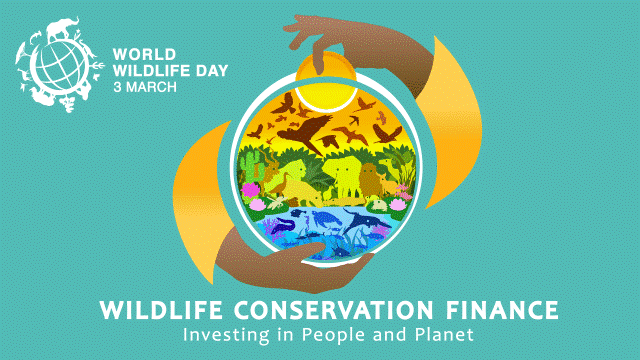
- 05 Mar 2025
In News:
World Wildlife Day is observed on March 3 every year, and in 2025, it will be observed under the theme of “Wildlife Conservation Finance: Investing in People and Planet.”
Key Details:
- Declared by: United Nations General Assembly (UNGA)
- First Observed: 2014
- Occasion: Commemorates the signing of CITES (Convention on International Trade in Endangered Species of Wild Fauna and Flora) in 1973.
- Theme 2025:“Wildlife Conservation Finance: Investing in People and Planet”
Purpose and Significance
World Wildlife Day is an annual UN-recognized global event aimed at:
- Raising awareness about wild fauna and flora.
- Highlighting threats such as climate change, poaching, habitat destruction, and illegal wildlife trade.
- Encouraging global cooperation for wildlife protection.
- Promoting innovative financing models to bridge the estimated $824 billion global biodiversity funding gap.
2025 Theme Focus: Conservation Finance
The 2025 theme calls for sustainable financial strategies, emphasizing:
- Wildlife Conservation Bonds
- Debt-for-Nature Swaps
- Green Bonds and Carbon Credits
- Payments for Ecosystem Services (PES)
- Public-Private Partnerships
These mechanisms aim to support conservation while fostering economic opportunities for local communities.
Timeline of Key Events
- 1973: CITES adopted.
- 2013: UNGA designates March 3 as World Wildlife Day.
- 2014: First official celebration.
- 2021: Theme – Forests and Livelihoods.
- 2025: Theme – Finance for Conservation.
Wildlife Status in India
- Protected Areas: 1,014 total (as of 2024), including:
- 106 National Parks
- 573 Wildlife Sanctuaries
- 115 Conservation Reserves
- 220 Community Reserves
(Covers ~5.32% of India’s total area)
- Tiger Population (2022): 3,682 – ~75% of global wild tigers
- Asiatic Lion Population (2020): ~674 (only in Gujarat's Gir Forest)
- India's Biodiversity Share:
- 7.6% of global mammal species
- 14.7% of amphibians
- 6% of birds and reptiles
- 6% of flowering plants
Major Causes of Wildlife Decline
- Habitat loss & fragmentation
- Illegal wildlife trade and poaching
- Climate change and pollution
- Invasive species
- Industrialization & urban expansion
Conservation Measures in India
- Project Tiger (1973): Boosted tiger numbers significantly.
- Project Elephant (1992): Focuses on elephant corridors and human-wildlife conflict mitigation.
- Wildlife Protection Act (1972): Key legal framework to safeguard endangered species.
- Eco-Sensitive Zones (ESZs): Buffer areas around protected habitats.
- Community Initiatives: Ecotourism, local participation in conservation.
MISHTI Scheme
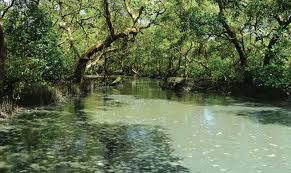
- 03 Mar 2025
In News:
Gujarat has emerged as the national leader in mangrove afforestation, covering 19,020 hectares in just two years under the Centre’s ‘MISHTI’ scheme.
Key Highlights:
- The Mangrove Initiative for Shoreline Habitats and Tangible Incomes (MISHTI) scheme was launched in 2023 under the Union Budget for 2023-24.
- The scheme aims to restore degraded mangrove ecosystems and increase India’s mangrove cover, enhancing coastal resilience while fostering sustainable livelihoods for coastal communities.
- Implemented from 2023 to 2028, the scheme is funded through various channels, including the CAMPA Fund (Compensatory Afforestation Fund Management and Planning Authority), MGNREGS (Mahatma Gandhi National Rural Employment Guarantee Scheme), and other governmental and private funding sources.
- The initiative also supports India’s participation in the global Mangrove Alliance for Climate (MAC) launched at COP27.
Key Objectives of MISHTI
- Ecological Restoration: To restore degraded mangrove ecosystems and expand mangrove cover across coastal areas.
- Coastal Resilience: To strengthen coastal resilience against climate change, such as coastal erosion and rising sea levels.
- Livelihood Generation: To promote ecotourism, sustainable livelihoods, and fishing opportunities for coastal communities.
- Climate Change Mitigation: The scheme plays a crucial role in protecting shorelines from storms, supporting India's commitments under the Paris Agreement and the UN Sustainable Development Goals (SDGs).
Gujarat’s Role in MISHTI Scheme
- Gujarat has emerged as the national leader in mangrove afforestation under the MISHTI scheme, planting over 19,000 hectares of mangroves in just two years.
- The state is spearheading the mangrove expansion efforts, with its coastline covering diverse ecosystems such as mangroves, coral reefs, and seagrasses.
- Gujarat has surpassed the Central Government’s target of planting 540 sq. km of mangroves in five years, completing plantation across 190 sq. km in the initial two years of the scheme.
Mangrove Distribution in Gujarat
- Gujarat's mangrove cover is distributed strategically across different coastal regions:
- Kutch: 799 sq. km, including the Gulf of Kutch, home to the Marine National Park and Wildlife Sanctuary.
- Other Coastal Districts: Jamnagar, Rajkot (Morbi), Porbandar, DevbhoomiDwarka (236 sq. km).
- Central and Southern Belt: Includes Bhavnagar, Ahmedabad, Anand, Bharuch, Surat, Navsari, and Valsad, covering 134 sq. km, with important areas like the Gulf of Khambhat and Dumas-Ubhrat.
- Saurashtra Region: Amreli, Junagadh, and Gir-Somnath maintain 6 sq. km of mangrove cover.
Significance of Mangroves
- Erosion Prevention: Mangroves act as a natural barrier, protecting coastal regions from erosion caused by waves and storms.
- Biodiversity Support: They provide vital breeding grounds for fish and other marine species, supporting coastal livelihoods.
- Climate Resilience: Mangroves help mitigate the effects of climate change by shielding vulnerable coastal communities from cyclones, reducing salinity, and preserving agricultural lands.
Global and National Mangrove Status
- Global Mangrove Distribution: Mangroves are found in tropical and subtropical regions worldwide, providing critical ecosystem services.
- India’s Mangrove Cover: According to the India State of Forest Report 2023, India has a total mangrove cover of 4,991.68 km², which accounts for 15% of the country’s total geographical area. The MISHTI scheme plays a pivotal role in further expanding this cover.
Cali Fund
- 01 Mar 2025
In News:
‘Cali Fund’ launched at CBD COP16 in Rome to boost biodiversity finance.
Key Details:
- Launched at: COP16 to the UN Convention on Biological Diversity (CBD), held in Rome in 2025.
- Purpose: The Cali Fund aims to promote the fair and equitable sharing of benefits arising from the use of Digital Sequence Information (DSI) on genetic resources, marking a major step towards fulfilling Goal C and Target 13 of the Kunming-Montreal Global Biodiversity Framework (KMGBF)—which targets halting and reversing biodiversity loss by 2030.
Key Features of the Cali Fund:
- Origin: It builds on the multilateral mechanism adopted during COP15 (2022) and was operationalised at COP16 (2025).
- Objective:Mobilise financial contributions from the private sector to support biodiversity conservation and implementation of National Biodiversity Strategies and Action Plans (NBSAPs).
- Hosted By: Multi-Partner Trust Fund Office (MPTFO).
- Managed By: United Nations Development Programme (UNDP) and United Nations Environment Programme (UNEP).
- Secretariat: Hosted by the Convention on Biological Diversity (CBD).
Funding Mechanism:
- Source of Contributions: Companies commercially utilisingDSI—genetic data from plants, animals, and microorganisms—especially in sectors like:
- Pharmaceuticals
- Cosmetics
- Agriculture and biotechnology
- Industrial biotech and AI-assisted research
- Exemptions: Academic institutions, public research bodies, and entities not reliant on DSI are exempt.
- Allocation:
- 50% of resources are earmarked for indigenous peoples and local communities, especially women and youth, recognising their key role in biodiversity protection.
Significance:
- Global First: First UN biodiversity fund to receive direct contributions from private companies.
- Support for Biodiversity Action Plans: Assists developing countries in implementing their KMGBF targets and NBSAPs.
- Boosts Scientific Research: Enhances capabilities for storing, using, and analysing DSI.
- Promotes Collective Action: Encourages industries benefiting from biodiversity to reinvest in its protection—ushering in a new era of biodiversity finance.
About Digital Sequence Information (DSI):
- Definition: Digitally stored genetic data from DNA, RNA, and proteins.
- Use Cases: Vital for research in health, food security, climate change, conservation, and bioeconomy.
- Governance: Discussed under CBD, WHO PIP Framework, UN Law of the Sea, and others.
PRAKRITI 2025

- 28 Feb 2025
In News:
- The International Conference on Carbon Markets – PRAKRITI 2025 was inaugurated by the Minister of Power and Housing and Urban Affairs.
- Organized by the Bureau of Energy Efficiency (BEE) under the Ministry of Power, the event served as a major platform for global dialogue on carbon markets, climate finance, and sustainability strategies.
Key Highlights:
PRAKRITI 2025 (Promoting Resilience, Awareness, Knowledge, and Resources for Integrating Transformational Initiatives) aimed to:
- Understand the functioning of Indian and global carbon markets.
- Discuss challenges, dynamics, and opportunities in carbon trading.
- Strengthen carbon credits, offset mechanisms, and compliance systems.
- Promote renewable energy, green innovations, and ecosystem-based interventions.
- Foster collaboration between governments, industries, and citizens.
Insights from PRAKRITI 2025
- Global Linkages:India’s carbon market will increasingly be influenced by global policies such as the European Union’s Carbon Border Adjustment Mechanism (CBAM), which imposes carbon pricing on imports like steel and aluminium. Indian industries must prepare to maintain competitiveness.
- Carbon Market Mechanisms:
- Under Article 6 of the Paris Agreement, carbon trading allows entities to buy carbon credits to offset emissions.
- Carbon credit = reduction of 1 metric ton of CO? or equivalent GHGs.
- India’s Progress:
- India ranks second globally in Clean Development Mechanism (CDM) project registrations.
- The Perform, Achieve and Trade (PAT) scheme, regulated by BEE, has saved over 106 million tonnes of CO? since 2015.
- Development of a domestic carbon market is a priority to align with global standards and leverage international finance.
- Challenges Highlighted:
- Need for robust Monitoring, Reporting, and Verification (MRV) frameworks.
- Ensuring fair benefit distribution among stakeholders.
- Developing policies tailored to India’s economic and social realities.
- Increasing private sector engagement and incentivizing renewable energy developers.
Bureau of Energy Efficiency (BEE)
- Established: 1 March 2002 under the Energy Conservation Act, 2001.
- Mandate: Develop policies and programmes to promote energy efficiency, coordinate with stakeholders, and promote self-regulation within market principles to reduce India's energy intensity.
- Role in Carbon Market: BEE is the nodal agency regulating India’s carbon trading schemes and energy conservation initiatives.
Northern Pintail Duck

- 26 Feb 2025
In News:
A flock of Northern Pintail ducks was recently sighted at an unprecedented altitude of 13,500 feet in Tawang, Arunachal Pradesh—far above their typical wintering habitats. This rare event has sparked interest in their migration behavior and adaptability to high altitudes.
About Northern Pintail Duck
- Scientific Name:Anas acuta
- Type: Migratory waterfowl known for elegance and long-range migration
- Common Nickname: Northern nomads
Distribution & Migration
- Found across every continent except Antarctica
- Breed in northern regions of Europe, Asia, and North America
- Migrate southward in winter to regions including the Indian subcontinent
- Typically observed in low-lying wetlands; rarely at high altitudes
- Do not breed or reside south of the equator
- Seen in the high-altitude region of Arunachal Pradesh during winter, raising questions about changing migration patterns and climate adaptability
Key Features
- Size: Around 60 cm in length, over 1 kg in weight
- Wingspan: Up to 91 cm
- Speed: Capable of flying at 48 miles per hour due to aerodynamic build
- Male Appearance: Buff-gray body, chocolate-brown head, broad white stripe on chest, black back patterns
- Female Appearance: Mottled brown body, lighter chest and neck
Conservation Status
- Listed as “Least Concern” under the IUCN Red List
- Despite being widespread, their migratory nature warrants regular monitoring to track habitat changes and population health
Soliga Tribe and Tiger Conservation

- 26 Feb 2025
In News:
In the 119th edition of Mann Ki Baat, Prime Minister Narendra Modi lauded the Soliga tribe of the BiligiriRanganathaswamy Temple (BRT) Tiger Reserve in Karnataka for their significant role in tiger conservation and sustainable forest practices.
Who are the Soligas?
- Location: Indigenous, forest-dwelling tribe residing primarily in Chamarajanagar district, Karnataka, and parts of Tamil Nadu, especially around Biligiri Rangana Hills and Male Mahadeshwara Hills.
- Meaning of the Name: "Soliga" translates to “children of bamboo”, symbolizing their deep ecological ties.
- Language: They speak Sholaga (a Dravidian language), along with Kannada and Tamil.
- Lifestyle:Soligas live in bamboo-and-mud huts, practice shifting cultivation, and depend on non-timber forest produce (NTFP) for sustenance.
- Diet & Livelihood:Honey is a staple in their diet; they extensively forage and harvest forest produce like amla, gooseberries, and medicinal herbs, leaving a portion for wildlife—a reflection of their conservation ethos.
Religious and Cultural Practices:
- Soligasworship wildlife, especially the tiger, locally called “DoddaNayi” (Great Dog). They have even built temples dedicated to tigers.
- Their belief system includes Hindu customs, animism, and naturism, highlighting their spiritual connection with nature.
- They produce eco-friendly artifacts like ‘jottai’ (leaf cups), showcasing sustainable craftsmanship.
Recognition of Forest Rights:
- In 2011, Soligas became the first tribal community in India to receive legal recognition of their forest rights within a tiger reserve, under the Forest Rights Act (FRA).
- This ruling allowed them to reside within the BRT Tiger Reserve and sustainably collect forest produce without displacing wildlife.
Role in Tiger Conservation:
- Soligas’ traditional knowledge of forest ecology helps them coexist peacefully with wildlife, minimizing human-animal conflict.
- They assist the Forest Department in fire prevention, wildlife tracking, and ecological management.
- Their cultural practices ensure minimal disturbance to wildlife. For instance, during harvest, they intentionally leave 25–33% of the produce in the forest for animals.
BiligiriRanganathaswamy Temple (BRT) Tiger Reserve:
- Location: Chamarajanagar district, Karnataka; lies at the confluence of the Western and Eastern Ghats, forming a critical wildlife corridor.
- Ecosystem: Rich in biodiversity with forest types including:
- Southern Tropical Evergreen
- Semi-Evergreen
- Moist Deciduous
- Flora:Axlewood, Rosewood, Terminalia spp., Indian Gooseberry, Ceylon Oak, Golden Shower Tree.
- Fauna: Tigers, Wild Dogs, Sloth Bears, Sambars, Bison, and endangered species like the Icthyophisghytinosus (Caecilian).
- Cultural Site: Named after Lord Rangaswamy, the reserve houses the Biligiri Temple atop mist-covered hills.
Northern White Rhino
- 25 Feb 2025
In News:
The Northern White Rhino (NWR) is on the brink of extinction, with only two females—Najin and Fatu—remaining at the Ol Pejeta Conservancy in Kenya. However, a breakthrough in In-Vitro Fertilization (IVF) has rekindled hope for reviving this subspecies, with 36 lab-created embryos ready for implantation. This effort is part of an international project named BioRescue.
About the White Rhino
- Scientific Name: Ceratotherium simum
- Common Name: Square-lipped rhinoceros (due to broad upper lip)
- Subspecies:
- Northern White Rhino (Ceratotherium simum cottoni)
- Southern White Rhino (Ceratotherium simum simum)
- Habitat:
- Southern White Rhino: South Africa, Namibia, Zimbabwe, Kenya
- Northern White Rhino: Historically central and eastern Africa; now only in captivity
- IUCN Status:
- White Rhino (overall): Near Threatened
- Northern White Rhino: Critically Endangered
- Southern White Rhino: Near Threatened
Biological Features
- Second-largest land mammal after elephants
- Square upper lip adapted for grazing on short grasses
- Two horns, with the front horn being larger
- No actual color difference between black and white rhinos
Social & Dietary Behavior
- Diet: Pure herbivores; feed almost exclusively on short grasses
- Behavior:
- Semi-social and territorial
- Males mark territories with dung
- SWRs form larger social herds; NWRs were found in smaller groups
Threats to Survival
- Poaching for horns
- Habitat loss due to human encroachment
- Civil unrest, particularly in their native range
- Low genetic diversity, especially critical in the NWR
- Climate change, affecting habitat and water sources
Conservation Through Reproductive Technology
BioRescue Initiative
- An international scientific effort launched in 2015 to save the NWR using advanced reproductive technologies.
- Uses frozen sperm from deceased males and eggs from Najin and Fatu to create embryos in the lab.
- 36 embryos have been successfully created and are stored for future implantation.
IVF and Surrogacy
- First-ever rhino pregnancy via lab-made embryo announced recently.
- Southern white rhinos are used as surrogate mothers due to genetic similarity and higher population.
- IVF and embryo transfers are the only options since the last male NWR, Sudan, died in 2018, and both remaining females are non-reproductive due to age and health.
Challenges & Concerns
- Limited gene pool restricts genetic variability.
- Loss of unique traits if crossbred with southern white rhinos.
- Behavioral imprinting: IVF calves must learn from remaining NWR females before they pass away.
- Ethical and ecological concerns: Critics argue conservation must also address root causes like poaching, habitat destruction, and lack of genetic diversity, not just focus on “test-tube” solutions.
Indian Rhinoceros
- Scientific Name: Rhinoceros unicornis (Greater One-Horned Rhino)
- IUCN Status: Vulnerable
- Habitat: Indian subcontinent (Assam, West Bengal, UP, Nepal)
- It is distinct from African rhinos, both genetically and ecologically.
Dr. Purnima Devi Barman

- 24 Feb 2025
In News:
Indian wildlife biologist Dr. Purnima Devi Barman has been named among TIME Magazine’s Women of the Year 2025, recognizing her as one of 13 global leaders working toward a more equitable and sustainable world. She is the only Indian woman on the list.
Key Contributions:
- Known for her pioneering conservation work with the greater adjutant stork (locally called Hargila), once critically endangered and culturally stigmatized in Assam.
- Founded the Hargila Army, a women-led grassroots movement focused on protecting the stork’s habitat and changing negative local perceptions.
- Her model uniquely blends wildlife conservation with women’s empowerment, engaging thousands of rural women in ecological and livelihood activities.
Impact:
- Due to her efforts, the greater adjutant stork’s population in Assam has significantly recovered, leading to its status being upgraded from “endangered” to “near threatened” by IUCN.
- The Hargila Army, with over 10,000 members, participates in bird rescue, awareness campaigns, tree planting, and embroidery-based income generation.
- Her approach has become a global model for community-based conservation.
Background:
- Hails from the Kamrup region of Assam.
- Holds a Master’s degree in Zoology from Gauhati University.
- Inspired by her early life near the Brahmaputra and her grandmother’s teachings on biodiversity.
Awards & Recognition:
- Nari Shakti Puraskar (2017) – India’s highest civilian award for women.
- UN Champions of the Earth Award (2022) – For entrepreneurial vision in conservation.
- Whitley Gold Award (2017, 2024) – Often called the "Green Oscar".
Other Roles:
- Director of Women in Nature Network (YNN) – India chapter.
- Member of IUCN’s Stork, Ibis, and Spoonbill Specialist Group.
About TIME Magazine:
- Founded in 1923, USA.
- Known for its global recognitions like Person of the Year and Women of the Year.
- Now operates as a multimedia platform covering politics, science, and culture.
Mass Stranding of False Killer Whales in Tasmania
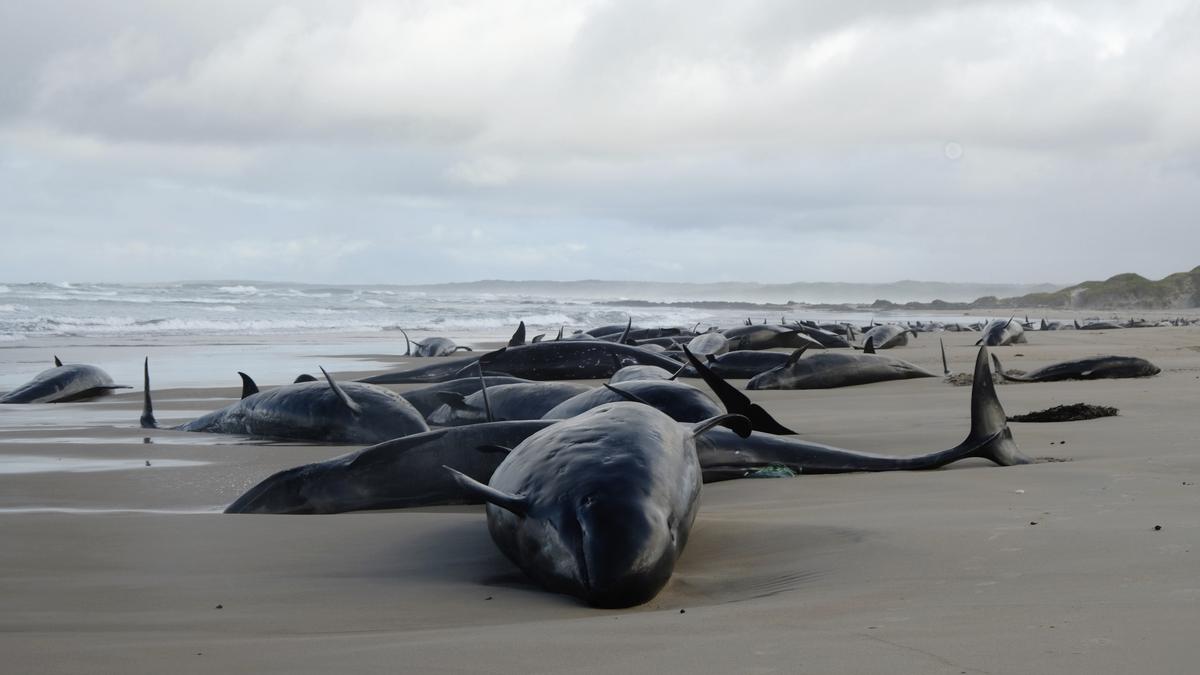
- 23 Feb 2025
In News:
Recently, over 150 false killer whales were found stranded on a remote beach near Arthur River on the northwest coast of Tasmania, Australia. The incident is one of several mass strandings reported in the region in recent years.
The event echoes earlier mass strandings:
- In 2022, 230 pilot whales stranded at Macquarie Harbor.
- In 2020, 470 long-finned pilot whales were stranded at the same site—the largest mass stranding in Australian history.
Possible Causes of Whale Strandings
Although the precise cause remains uncertain, potential factors include:
- Disorientation from loud underwater noises (e.g., naval exercises, seismic surveys)
- Illness, old age, injury
- Fleeing predators
- Severe weather events
- Geomagnetic anomalies
About False Killer Whales
- False killer whales (Pseudorca crassidens) are not true killer whales but belong to the Delphinidae family, which also includes dolphins and pilot whales.
- They are large, social cetaceans, often found in warm, deep oceanic waters.
- These whales are highly vocal and social, forming strong social bonds within pods.
- Like other cetaceans, they rely on echolocation (underwater sound) for communication, hunting, and navigation.
About Killer Whales (Orcas)
- Although not involved in the stranding, killer whales (Orcinus orca) are relevant as close relatives within the same family (Delphinidae).
- Known for their distinct black and white markings, orcas are the largest members of the dolphin family.
- They are globally distributed in both open oceans and coastal waters.
- Killer whales live in stable matrilineal pods and use complex vocalizations.
Conservation Status
- The IUCN Red List classifies false killer whales and killer whales as Data Deficient, indicating that there is insufficient information to assess their risk of extinction.
AI-Powered Surveillance in Similipal Tiger Reserve

- 21 Feb 2025
In News:
The Similipal Tiger Reserve in Odisha has seen a significant drop in poaching activities following the deployment of TrailGuard AI-enabled surveillance cameras. These advanced systems are helping protect both forest personnel and wildlife by providing real-time alerts and enhancing enforcement actions.
About TrailGuard AI System
- Developed by: Nightjar Technologies, Gurgaon.
- Design:
- Two-part system: a pen-sized camera unit and a notepad-sized battery/communication unit connected via a 2-metre cable.
- Camouflaged and compact, reducing chances of being detected or stolen.
- Operation:
- Operates in low-power mode by default, switches to high-power mode upon sensing movement.
- Uses on-device AI inference to identify object classes (e.g., humans, animals, vehicles).
- Sends alerts via cellular network within 30–40 seconds to a central control room.
- Battery life: 6 months to 1 year.
- Cost: ?50,000–53,000 per unit.
Impact and Achievements
- Installed: 100–150 AI-enabled cameras in Similipal.
- In 10 months, led to:
- 96 poachers arrested
- 86+ country-made guns seized
- 40+ arrests in December 2024 alone
- Enabled quick house raids and identifications using photographic evidence.
- Enabled one conviction within six months, with more expected.
Integrated Enforcement System
- Real-time alerts displayed on a central control room screen.
- Information shared swiftly via WhatsApp groups and VHF radio.
- Ground teams rely on human intelligence sources (including undercover staff) to identify suspects.
- Raids and arrests are executed only after 100% identity confirmation, ensuring due process.
Advantages of the System
- Enhances forest ranger safety.
- Enables targeted and proactive patrolling.
- Effective in challenging terrains with minimal maintenance.
- Also used to monitor wildlife, including profiling of tuskers.
- Functions as an anti-poaching as well as human-wildlife conflict mitigation tool.
Wider Adoption and Future Plans
- Apart from Similipal, TrailGuard AI has been deployed at:
- Kanha Tiger Reserve, Madhya Pradesh (20 cameras)
- Dudhwa National Park, Uttar Pradesh (10 cameras)
- Total: Active in 14+ sites across five states
- Planned expansion to other protected areas in Odisha.
Community Sensitivity and Tribal Engagement
- Similipal is surrounded by tribal communities, where hunting has traditional roots.
- Increased surveillance has caused concerns over restricted forest access for collecting firewood and non-timber forest products.
- The forest department is:
- Holding awareness meetings in local languages.
- Exploring safe and non-intrusive access solutions for villagers.
- Ensuring that enforcement doesn’t indiscriminately impact local livelihoods.
Conservation Significance
- Demonstrates the fusion of technology with conservation.
- Aligns with India’s broader environmental goals under:
- Project Tiger
- National Wildlife Action Plan
- Digital India initiatives in conservation.
Climate Risk Index 2025
- 19 Feb 2025
In News:
- The Climate Risk Index (CRI) 2025, published by the international environmental think tank Germanwatch, ranks countries based on their vulnerability to extreme weather events, assessing both human and economic losses due to climate-induced disasters.
- The index, which has been released annually since 2006, covers a 30-year period, evaluating the impact of extreme weather events in terms of economic losses, fatalities, and the number of affected people.
Key Findings:
- Global Impact: From 1993 to 2022, more than 9,400 extreme weather events occurred globally, resulting in 765,000 fatalities and USD 4.2 trillion in economic losses. Heatwaves, droughts, and floods were the leading causes of fatalities and displacement, with heatwaves alone claiming 61,778 lives (83% of fatalities) in 2022. Droughts affected the largest number of people, with 59% of the global population impacted during the past three decades.
- India's Position: India ranks as the 6th most affected country in the world by climate change between 1993 and 2022, suffering significant losses. During this period, the country experienced over 400 extreme weather events, including floods, heatwaves, cyclones, and droughts, causing a loss of USD 180 billion in economic damages and leading to at least 80,000 fatalities (10% of global deaths).
Some notable extreme weather events include:
-
- Cyclones: Gujarat (1998), Odisha (1999), Hudhud (2014), and Amphan (2020).
- Floods: Uttarakhand (2013), Jammu and Kashmir (2014), and Kerala (2018).
- Heatwaves: Intense temperatures exceeding 50°C in 1998, 2002, 2003, and 2015.
Methodology of the Climate Risk Index
The CRI assesses the impact of extreme weather events across three hazard categories:
- Hydrological (floods, landslides),
- Meteorological (storms, cyclones),
- Climatological (heatwaves, droughts).
The six key indicators used for the ranking are:
- Economic loss
- Fatalities
- Affecting population, assessed in both absolute and relative terms.
Climate Risk and Its Implications for India
India’s vulnerability to climate change is highlighted by frequent and intense extreme weather events. The country faces risks from:
- Floods: Regular heavy monsoons lead to significant displacement and damage to infrastructure and agriculture.
- Cyclones: Rising sea levels and warming oceans increase the frequency and intensity of cyclones.
- Heatwaves: India experiences rising temperatures, with heatwaves becoming more intense, contributing to health crises.
- Droughts: A growing concern, affecting agriculture and water resources.
Additionally, the Asia-Pacific Climate Report 2024 projects that India may face a 24.7% GDP loss by 2070 due to climate change impacts, driven by rising sea levels and decreasing labor productivity.
Global Challenges in Climate Change Mitigation
- Historical Responsibility vs. Future Emissions: Developed nations, despite having contributed more to global emissions historically, are pressuring emerging economies like India to take greater responsibility for climate action. This has led to tensions over burden-sharing and the need for climate finance.
- Global Temperature Breach: In 2024, the world breached the 1.5°C threshold for a full year, highlighting the inadequacy of current mitigation efforts. Projections indicate a global temperature increase of 2.6-3.1°C by 2100 if current trends continue.
- Weak Commitments and Insufficient Finance: Many countries have not updated their Nationally Determined Contributions (NDCs), and the USD 300 billion annual funding promised for developing nations is insufficient to meet climate adaptation and mitigation needs.
India's Climate Adaptation Challenges and Suggestions
India faces several climate adaptation challenges, including inadequate infrastructure, insufficient funding, and a lack of robust policy frameworks for disaster risk management. To enhance adaptation efforts, the following measures are suggested:
- Enhanced Climate Finance: Developing countries need greater financial and technical support to manage and adapt to climate-induced losses.
- Strengthening Mitigation Efforts: Nations, including India, must scale up their NDCs to restrict global warming to 1.5°C or lower.
- Accountability of High-Income Countries: Developed nations must expedite mitigation actions and increase financial contributions to support climate-vulnerable countries like India.
Gulf of Eilat

- 19 Feb 2025
In News:
A new study has revealed that the coral reefs in the Gulf of Eilat (also known as the Gulf of Aqaba) faced a 3,000-year growth shutdown due to global cooling. However, these reefs later recovered naturally from deeper waters, demonstrating resilience in the face of environmental changes.
About the Gulf of Eilat (Gulf of Aqaba)
- Location: The Gulf of Eilat is a northern extension of the Red Sea, positioned east of the Sinai Peninsula and west of the Arabian Peninsula. It is strategically significant and is also known as the Gulf of Aqaba.
- Neighbouring Nations: The Gulf shares its coastline with four countries: Egypt, Israel, Jordan, and Saudi Arabia.
- Geographical Features:
- The Gulf includes important cities like Taba (Egypt), Eilat (Israel), and Aqaba (Jordan), all located at the Gulf’s northernmost point.
- It has a maximum depth of 1,850 meters, making it much deeper than the adjacent Gulf of Suez.
- The Gulf forms the southern end of the Dead Sea Transform, a significant tectonic fault zone, contributing to its unique geological and environmental features.
- Coral Ecosystem: The Gulf of Eilat is home to the world’s northernmost coral reefs. Despite facing various environmental challenges, these reefs have shown remarkable resilience over the years, highlighting their ability to adapt to changing conditions.
Environmental Challenges and Recovery
- The 3,000-year growth shutdown of the coral reefs in the Gulf of Eilat was primarily driven by global cooling. This climatic phenomenon significantly impacted the growth of the reefs, causing a temporary halt in their development. However, the coral ecosystems in the Gulf have since recovered naturally, drawing from deeper waters to rebuild and thrive once again.
- This recovery underscores the resilience of coral ecosystems despite adverse environmental conditions. It also provides valuable insights into how these ecosystems can recover when given the opportunity, even after significant disruptions caused by global climate changes.
Implications for Coral Reef Conservation
- The study's findings emphasize the importance of understanding the adaptive capacity of coral reefs, which are among the most vulnerable ecosystems to climate change.
- The ability of coral reefs in the Gulf of Eilat to recover after a prolonged period of cooling demonstrates that marine ecosystems can endure long-term environmental stress if they are allowed to regenerate naturally.
- This has significant implications for global coral conservation efforts, which must focus on creating conditions that allow reefs to adapt and recover from environmental stresses, including global warming, ocean acidification, and pollution.
- The Gulf of Eilat’s coral reefs provide an important case study for understanding ecological resilience and the potential for natural recovery in marine ecosystems.
Crocodile Catfish
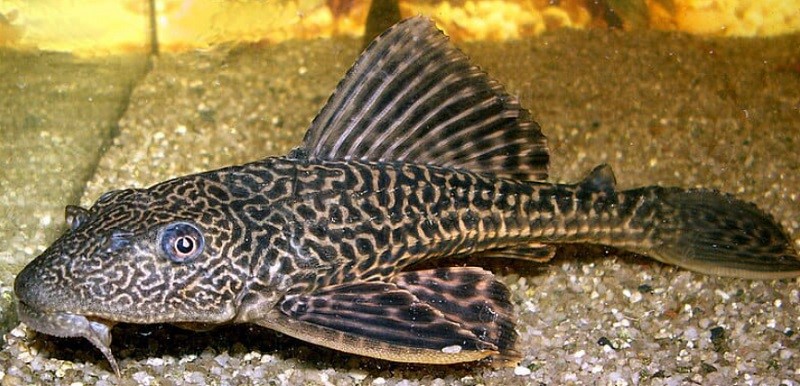
- 17 Feb 2025
In News:
The recent discovery of the Crocodile Catfish (Bagariussuchus) in the Bahini River near Basistha, Guwahati, Assam, has garnered attention from conservationists and ecologists alike. As one of the largest freshwater catfish species in Asia, its presence in Indian waters raises both scientific interest and ecological concerns.
Taxonomy and Distribution
- Scientific Name: Bagariussuchus
- Family: Sisoridae – the largest family of Asian catfishes, widely distributed across South and Southeast Asia.
- Common Names: Asian Giant River Catfish, Crocodile Goonch Catfish, Giant Devil Catfish
- Geographical Range: Native to countries including India, Nepal, Bangladesh, Myanmar, and Thailand.
Habitat and Morphological Features
- Natural Habitat: Prefers fast-flowing rivers, deep pools, turbulent rapids, and areas with rocky or gravelly substrates.
- Often found among boulders, submerged roots, and debris, thriving in cool, oxygen-rich waters.
- Physical Description:
- Long, cylindrical body with a broad head and wide mouth.
- Typicallydark brown to black, with irregular patches or spots for camouflage.
- Dorsal fin is elongated, stretching along most of the back.
- Size: Can grow up to 1.5 meters in length and weigh over 50 kilograms, though smaller specimens (~70 cm) are also observed.
Behaviour and Ecology
- Feeding Habits: A carnivorous predator, feeding on smaller fish, crustaceans, and aquatic invertebrates.
- Known for its voracious appetite, capable of consuming prey nearly its own size.
- Most active during evening or nighttime, making it a nocturnal feeder.
- Sexual Dimorphism: Males are generally slimmer and may exhibit slightly brighter coloration than females.
Ecological Concerns
- The discovery of the Crocodile Catfish in a non-native region like the Bahini River raises concerns about its invasive potential.
- It can threaten native aquatic biodiversity by preying on indigenous species and disturbing the ecological balance.
- Overfeeding and rapid proliferation can degrade water quality and disrupt food chains.
Conservation Status
- IUCN Red List: Near Threatened (NT): This status reflects concerns about habitat degradation, overfishing, and ecological displacement, which may impact population stability across its range.
Rising Heatwaves in India
- 16 Feb 2025
In News:
India is increasingly facing more frequent, intense, and prolonged heatwaves, posing a significant threat to public health, economic productivity, agricultural stability, andenvironmental sustainability. This trend underscores the broader implications of climate change, particularly for developing economies with large vulnerable populations.
Understanding Heatwaves
A heatwave is defined as a prolonged period of abnormally high temperatures, often accompanied by high humidity. As per the India Meteorological Department (IMD):
- A heatwave is declared when the maximum temperature reaches at least 40°C in plains and 30°C in hilly regions.
- The severity is determined by how much the temperature exceeds the normal.
Impacts of Heatwaves
- Public Health:
- Prolonged heat exposure increases the risk of heatstroke, dehydration, and worsens cardiovascular and respiratory illnesses.
- Vulnerable groups include the elderly, outdoor workers, and those without access to cooling.
- Livelihoods and Employment:
- According to the World Bank, India could lose 34 million jobs by 2030 due to heat-stress-related productivity declines.
- The informal sector and outdoor labourers are especially at risk.
- Agriculture and Food Security:
- Heat stress leads to reduced crop yields, livestock deaths, and increased irrigation demand.
- It threatens the food supply chain and rural incomes.
- Water Scarcity:
- 54% of India’s land is under high to extremely high water stress, as per the World Resources Institute (WRI).
- Heatwaves exacerbate droughts and deplete groundwater sources.
- Environmental Degradation:
- Higher temperatures increase the risk of wildfires, especially in forested and arid zones.
- Ecosystem services and biodiversity are under stress.
- Infrastructure and Energy:
- Rising temperatures lead to increased energy demand for cooling, straining power grids.
- Urban infrastructure suffers due to heat-induced wear and tear.
Gangasagar Mela

- 16 Feb 2025
In News:
Recently, several Ministers of the West Bengal government gathered at a conference room on Sagar Island, situated at the mouth of the Bay of Bengal — the southernmost tip of the State — to brief mediapersons on the arrangements for the Gangasagar Mela 2025.
Gangasagar Mela: Overview
- Second-largest human congregation in the world, after the Kumbh Mela.
- Held annually on Makar Sankranti (January 14) at the confluence of River Ganga and Bay of Bengal.
- Pilgrims take a holy dip at the confluence; site houses the Kapil Muni Temple.
- In 2025, the West Bengal government claimed over 1.10 crore pilgrims visited.
Location & Geography
- Sagar Island (Sagardwip/Ganga Sagar):
- Located ~120 km from Kolkata.
- Largest island in the Sundarbans archipelago.
- Population: ~2 lakh (2011 Census).
- Classified under the sand group category.
- Accessed by crossing the Muriganga River via ferry.
Climate Change Impact
- Rising sea levels and erosion are threatening Sagar Island:
- Sea has advanced from 1,500 m to 470 m from the Kapil Muni Temple in ~10 years.
- Tidal surge rises from 4.6 m to 7.6 m during high tides.
- Erosion worsened by:
- Mangrove destruction for construction during mela.
- Flattening of sand dunes and vegetation, removing natural barriers.
Environmental Challenges
- Constructions often violate Coastal Regulation Zone (CRZ) norms (no construction within 500 m of high tide line).
- Beaches have turned muddy, unfit for bathing; pilgrims walk through marshes.
- Concrete embankments, built after removing mangroves, washed away during cyclones.
- Geotextiles used for erosion control are ineffective near the temple due to strong wave action.
Cyclones & Vulnerability
- Recent major cyclones: Yaas (2021), Remal (May 2024), Dana (Oct 2024).
- Local communities frequently displaced; loss of livestock and property reported.
- Rising salinity impacting fish farming and livelihoods.
Socio-Economic Impact
- Youth migration due to lack of job opportunities.
- Local economy disrupted by environmental stress.
- Many locals say the mela offers little direct benefit to them.
Governance and Policy Issues
- West Bengal government spent ~?250 crore in 2024 for mela arrangements.
- Proposed ?4,100 crore World Bank-funded embankment project:
- World Bank: 70% cost; State: 30%.
- Aimed at protecting 52 inhabited islands in Sundarbans.
- Centre-State conflict:
- WB government alleges non-cooperation from the Centre.
- No Central funds provided for the mela, unlike the Kumbh Mela.
- Demand for national mela status for Gangasagar.
Cultural and Political Dimensions
- Religious significance emphasized by Shankaracharya of Puri.
- Soft Hindutva strategy attributed to West Bengal’s ruling party (TMC).
- Political undertones visible in temple construction and event promotion.
S?janam

- 14 Feb 2025
In News:
In a significant stride toward sustainable healthcare and waste management, India launched its first indigenous Automated Biomedical Waste Treatment Plant, named S?janam, on April 13, 2025, at AIIMS, New Delhi.
Developed by the CSIR-National Institute for Interdisciplinary Science and Technology (CSIR-NIIST), Thiruvananthapuram, under the Ministry of Science & Technology, this innovative rig marks a paradigm shift in handling biomedical waste, moving away from conventional, polluting incineration techniques.
Why this matter?
India generates approximately 743 tonnes of biomedical waste daily (CPCB, 2023). Safe disposal has been a persistent challenge due to limited infrastructure, high costs, and environmental concerns. The launch of S?janam aligns with the government’s push for “Waste to Wealth” and environmentally responsible healthcare infrastructure, as part of the Atmanirbhar Bharat and Swachh Bharat initiatives.
What is S?janam?
- An automated, eco-friendly biomedical waste treatment rig.
- Designed to disinfect pathogenic waste like blood, urine, sputum, and lab disposables.
- Does not use incinerators, which release toxic emissions such as dioxins and furans.
Key Features & Capacity
Feature Details
Disinfection Process Non-incineration, antimicrobial treatment
Daily Treatment Capacity 400 kg of total biomedical waste
Organic Waste Handling Initially handles 10 kg/day of degradable medical waste
Environmental Safety Neutralizes foul odor; releases pleasant fragrance
Health Safety Minimizes human exposure and risk of contamination
Validation Third-party tested; treated material safer than organic vermicompost
Significance for Public Health and Environment
- Reduces dependency on expensive, energy-intensive incinerators.
- Eco-friendly solution that prevents toxic emissions and groundwater contamination.
- Aligns with Bio-Medical Waste Management Rules, 2016, which mandate safe segregation, treatment, and disposal.
- Enhances India’s capability to respond to health crises (e.g., pandemics), where waste generation spikes.
Strategic Implications
- Promotes indigenous technological innovation under “Make in India.”
- Offers a scalable solution for both urban and rural healthcare setups.
- Contributes to India’s climate commitments by cutting healthcare-related emissions.
Pong Dam Lake Wildlife Sanctuary
- 11 Feb 2025
In News:
Pong Dam Lake Wildlife Sanctuary, located in the Kangra district of Himachal Pradesh, has witnessed a record-breaking influx of migratory birds in 2025, according to the latest annual bird census conducted on February 1, 2025.
The sanctuary, a designated Ramsar Site (since 2002) and a Wetland of National Importance (1994), recorded a total of 1,53,719 birds across 97 species, indicating a sharp rise in avifaunal population and reaffirming its ecological significance.
Key Highlights from the 2025 Census
- Migratory birds recorded: 1,44,371 individuals from 55 species.
- Total bird count: 1,53,719 birds from 97 species.
- Increase from 2024: 83,555 more birds.
- Bar-headed Goose population: 90,959 (up from 37,501 in 2024) — highest ever recorded since the census began in 2004.
Other dominant waterfowl included:
- Eurasian Coots – 10,785
- Common Pochards – 9,692
- Common Teals – 8,497
- Northern Pintails – 8,053
Lesser-spotted species included the Greater and Lesser White-fronted Goose, Red Crested Pochard, and Northern Lapwing.
Reasons Behind the Surge
- Experts attribute the significant increase in bird numbers to a decline in the water level of Pong Dam Lake, which exposed additional lakebed areas, creating new feeding grounds. This has made the sanctuary increasingly attractive to birds migrating from Tibet, Central Asia, Russia, Siberia, and the Trans-Himalayan region.
Survey and Conservation Collaboration
- The census was conducted by over 100 participants, including officials from the Himachal Pradesh Forest Department, experts from the Bombay Natural History Society, Wildlife Institute of India, and local birdwatchers. The sanctuary was divided into 25 zones for comprehensive coverage.
- To further conservation efforts, a new Interpretation Centre was inaugurated on January 18, 2025, aimed at promoting awareness about the wetland's role in sustaining biodiversity and supporting migratory birds.
Ecological and Geographical Profile
Pong Dam Lake (Maharana Pratap Sagar)
- Type: Manmade reservoir formed by construction of Pong Dam on the Beas River.
- Location: Wetland zone of the Shivalik hills, Kangra district, Himachal Pradesh.
- Area: Approx. 307 sq. km — among the largest man-made wetlands in northern India.
- Importance: Key stopover on the Trans-Himalayan flyway for migratory birds.
Flora
- Vegetation types: Submerged aquatic vegetation, grasslands, forests.
- Dominant species:Eucalyptus, Acacia, Shisham.
Fauna
- Avifauna: Over 220 bird species recorded; 54 waterfowl species.
- Notable birds: Bar-headed Geese, Pintails, Pochards, Coots, Grebes, Cormorants, Herons, Storks, Grey Partridge, Peafowl.
- Mammals: Sambar, Barking Deer, Nilgai, Wild Boar, Clawless Otter, Leopard.
Rhododendron wattii

- 10 Feb 2025
In News:
A recent study has highlighted the alarming decline of the rare Rhododendron wattii, a species endemic to Nagaland and Manipur, especially in the Dzukou Valley, Nagaland. The species is now on the brink of extinction due to severe threats to its survival, raising serious conservation concerns.
Botanical Profile
- Taxonomy and Discovery:
- First collected by Sir George Watt during his 1882–85 survey in the Japfu Hill range, Nagaland.
- Belongs to the Rhododendron genus, which has over 1,000 species worldwide.
- India hosts 132 taxa, of which 129 are found in the northeastern region.
- Growth and Habitat:
- Grows as a small tree or shrub in the temperate biome.
- Attains a maximum height of 25 feet.
- Endemic to Manipur and Nagaland, predominantly in the Dzukou Valley at ~2,600 metres altitude.
- Phenological Features:
- Evergreen plant with year-round leaf renewal.
- Flowering: Late February to April.
- Fruiting:April to December.
- Produces trusses of 18–25 pink flowers with dark flecks and purplish basal blotches.
- Pollinated by the Fire-tailed Sunbird (Aethopygaignicauda) and bumble bees.
Conservation Concerns:
- Conservation Status:
- Listed as Vulnerable by the IUCN Red List due to:
- Severe population fragmentation.
- Area of occupancy less than 500 sq. km.
- Botanists at the Botanical Survey of India consider it Critically Endangered in its natural habitat.
- Listed as Vulnerable by the IUCN Red List due to:
- Threats to Survival:
- Poor seedling survivability despite abundant seed production.
- Anthropogenic pressures such as:
- Deforestation
- Habitat destruction
- Use of trees for firewood by local communities.
- Wildfires: A major fire incident in 2020–21 severely impacted the Dzukou Valley.
- The lone surviving Rhododendron wattii tree was recorded far from human trails during a recent field study.
Recent Study Highlights:
- Conducted by Imtilila Jing and S.K. Chaturvedi of Nagaland University.
- Published in the Journal of Threatened Taxa.
- Found only one living tree in the surveyed area of 27 sq. km of Dzukou Valley.
- The last previously reported tree in Nagaland (2012–13) was cut down.
Additional Botanical Development in the Region:
While the situation of Rhododendron wattii is grim, the region also witnessed a positive botanical development:
- Discovery of Phalaenopsis wilsonii, a new orchid species in Manipur’s Senapati district.
- Identified by researchers from the Institute of Bioresources and Sustainable Development (IBSD), Imphal.
- It is the ninth species of the Phalaenopsis genus recorded in Manipur.
Bryospilus Bharaticus
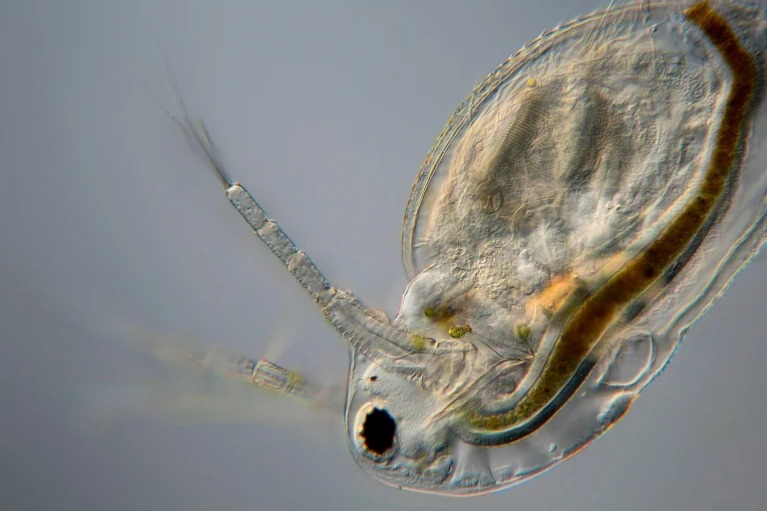
- 08 Feb 2025
In News:
A new species of water flea, Bryospilus (Indobryospilus) bharaticus n. sp., was recently discovered from moss growth on the walls of the Korigad Fort near Pune, Maharashtra.
This marks the first recorded discovery of the genus Bryospilus in Tropical Asia, underscoring the ecological uniqueness of the Western Ghats, a UNESCO World Heritage biodiversity hotspot.
Taxonomic and Morphological Highlights
- It belongs to the genus Bryospilus, a group of tiny crustaceans known as water fleas, which typically inhabit rivers, ponds, and pools.
- The species displays adaptations for semi-terrestrial life, notably using its antennae with large spines for crawling through thick, debris-laden water films on moss surfaces.
- It lacks a main eye—an evolutionary adaptation to low-light habitats where color vision is unnecessary for foraging.
Ecological and Evolutionary Significance
- The genus Bryospilus includes species found in semi-terrestrial habitats in rainforests of West Africa, South and Central America, and New Zealand, making this Indian discovery a significant biogeographical addition.
- The organism’s relatives are typically found in littoral (vegetated) zones of water bodies, whereas some occur in open waters.
- The researchers suggest that ancestors of this species existed on the Indian subcontinent prior to the breakup of Gondwanaland, around 200 million years ago, hinting at Bryospilus bharaticus as a potential Gondwanan relict species.
- Each known Bryospilus species has been isolated to a specific former Gondwanan continent, reinforcing the evolutionary legacy of this find.
Research and Conservation Implications
- The discovery was part of an ongoing survey of underexplored crustacean taxa in the Western Ghats, led by Sameer Padhye and Kan Van Damme, and published in the Journal of Crustacean Biology (Oxford Academic, Sept 2024).
- The species was found in pristine, undisturbed moss habitats on Deccan Plateau hill forts, highlighting the importance of conserving such microhabitats.
- Zooplankton like water fleas are highly sensitive to environmental changes and serve as bioindicators of ecological health. The presence of B. bharaticus indicates low human disturbance in its habitat.
- The authors warn that air pollution and habitat disturbance could threaten these fragile ecosystems and stress the urgency of habitat protection, especially for organisms invisible to the naked eye.
Kolleru Lake
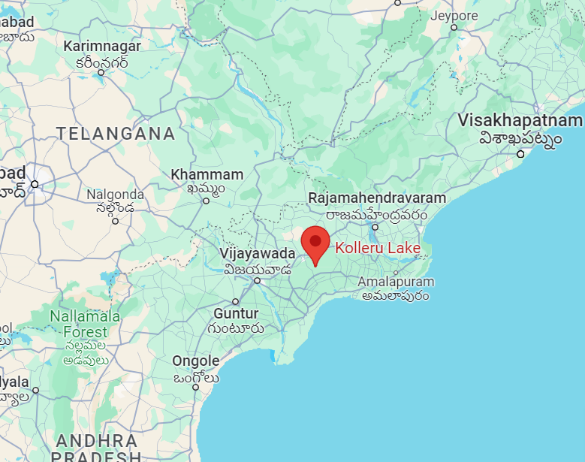
- 06 Feb 2025
In News:
The Southern Zonal Bench of the National Green Tribunal (NGT) has recently restrained the Andhra Pradesh government from proceeding with six proposed infrastructure projects in the Kolleru wetland area, citing violations of environmental protocols and lack of statutory clearances.
About Kolleru Lake
- Location: Northeastern Andhra Pradesh, between the Krishna and Godavari river deltas, near Eluru city.
- Type: One of Asia’s largest shallow freshwater lakes, covering an area of 308 sq. km.
- Hydrology:
- Fed by Budameru and Tammileru rivers.
- Drains into the Bay of Bengal via Upputeru river (a tidal water channel).
- Acts as a natural flood-balancing reservoir for the Krishna and Godavari river systems.
- Ecological Importance:
- Declared a Wildlife Sanctuary in 1999 and a Ramsar Site in 2002.
- Designated as an Important Bird Area (IBA) due to the presence of over 50,000 waterfowl annually.
- Lies on the Central Asian Flyway (CAF), a major migratory bird route.
- Key Avian Species:
- Grey Pelican (indicator species), Siberian Cranes, Glossy Ibis, Open-billed Stork, Purple Moorhen, Painted Storks.
Kolleru Bird Sanctuary
- A protected wetland marsh habitat within the Kolleru Lake region.
- Supports diverse aquatic flora and fauna, serving as a crucial ecosystem for migratory and resident bird species.
Infrastructure Projects and Legal Challenges
- The projects were proposed under the entity "A.P. Krishna – Kolleru Salinity Mitigation Projects Corporation Limited" with a total capital outlay of approximately ?2,952 crore.
- The plans included construction of three regulators-cum-roads across the Upputeru river and other barrages, regulators, and sluices, falling within the Coastal Regulation Zone (CRZ).
- The Andhra Pradesh Water Resources Department (WRD) issued G.O. Ms. No. 63 (dated 2nd December 2020) authorizing the project.
Grounds for NGT Intervention
- Key objections included:
- Absence of scientific or ecological studies.
- Lack of consultations with wetland experts, wildlife conservationists, and hydrologists.
- No clearances obtained from:
- Ministry of Environment, Forest and Climate Change (MoEF&CC)
- A.P. Coastal Zone Management Authority (CZMA)
- A.P. Pollution Control Board (PCB)
- National Board for Wildlife (NBWL)
NGT Observations and Ruling
- The tribunal emphasized the need for comprehensive evaluation of ecological and hydrological impacts before proceeding.
- It cited potential threats to the lake’s ecosystem, including:
- Disruption to natural hydrology.
- Loss of biodiversity and eco-sensitive habitats.
- The NGT ruled that the projects should not proceed unless fully compliant with environmental laws and backed by appropriate expert assessments.
- The ruling reinforced India's obligations under the Ramsar Convention and domestic environmental legislation, stressing the urgent need to protect the integrity of the Kolleru ecosystem.
Golden-headed Cisticola

- 05 Feb 2025
In News:
In a remarkable ornithological development, the Golden-headed Cisticola (Cisticola exilis) has been sighted in the Mathikettan Shola National Park, Idukki district, Kerala, marking its first recorded presence in the southern Western Ghats after a significant gap.
The finding underscores the ecological richness of the region and highlights the need for intensified avian research in the Western Ghats.
About Golden-headed Cisticola (Cisticola exilis)
- Also known as the bright-capped cisticola, it is a small warbler belonging to the family Cisticolidae.
- It is an omnivorous bird, feeding primarily on invertebrates such as insects and small slugs, along with grass seeds.
- The species is typically found in grassland habitats within mountain ranges, and has been previously recorded in parts of Karnataka, Tamil Nadu, and northern Kerala, notably in Banasura Hills, Wayanad. However, this is the first confirmed sighting in the southern part of the Palakkad Gap.
Physical features of breeding males include:
- Golden-orange plumage on the head, neck, and chest
- Pinkish beaks
- Black streaks on the back
- A distinctive call that aids identification
Habitat and Distribution
- It is widely distributed across Australia and several Asian countries.
- In India, its presence had been limited to select regions of the Western Ghats, making its recent sighting in Mathikettan Shola both rare and ecologically significant.
Conservation Status
- According to the IUCN Red List, the Golden-headed Cisticola is classified as Least Concern. Despite this, the new finding calls for further research into its habitat preferences and conservation needs within India.
About Mathikettan Shola National Park
Located in the southern part of the Palakkad Gap in the Western Ghats of Kerala, Mathikettan Shola is a vital biodiversity hotspot.
- It comprises evergreen forests, moist deciduous forests, shola grasslands, and semi-evergreen vegetation.
- The park hosts three major streams: Uchillkuthi Puzha, Mathikettan Puzha, and Njandar, which are tributaries of the Panniyar River.
- Its highest point is Kattumala, located at the eastern border adjoining Tamil Nadu.
- The Muthavan tribal community resides near the park’s northeastern boundary, reflecting the intricate human-nature interface in the region.
Scientific and Conservation Importance
The rediscovery has been documented in the journal Malabar Trogon by the Malabar Natural History Society, bringing attention to the importance of long-term monitoring and baseline studies in underexplored ecosystems.
It emphasizes:
- The ecological richness of the Western Ghats, a UNESCO World Heritage site.
- The importance of citizen science, as local birdwatchers played a key role in the finding.
- The need for enhanced habitat protection and ornithological research in grassland ecosystems of high-altitude regions.
World Wetlands Day 2025

- 04 Feb 2025
In News:
World Wetlands Day is observed every year on 2nd February to commemorate the adoption of the Ramsar Convention on Wetlands in 1971 in Ramsar, Iran.
India has been a signatory to the Convention since 1982 and has actively worked towards the conservation and sustainable management of wetlands—critical ecosystems that serve as biodiversity hotspots, natural flood buffers, and carbon sinks.
Theme 2025: "Protecting Wetlands for Our Common Future"
The 2025 theme emphasizes collaborative efforts to protect wetlands to ensure ecological sustainability, biodiversity preservation, and long-term human well-being. It highlights the need for integrated management and foresight in conservation strategies.
Key Event: Parvati Arga Ramsar Site, Gonda, Uttar Pradesh
The Union Ministry of Environment, Forest and Climate Change (MoEFCC) organized the national-level celebrations of World Wetlands Day 2025 at the Parvati Arga Ramsar Site in Gonda district, Uttar Pradesh.
Significance of the Site
- Comprises two rain-fed oxbow lakes—Parvati and Arga—located in the terai region of the Gangetic plains.
- Supports endangered and critically endangered species like the white-rumped vulture, Indian vulture, and Egyptian vulture.
- Attracts migratory birds such as Eurasian coots, greylag geese, northern pintails, and red-crested pochards.
- Threatened by invasive species, notably the common water hyacinth.
- The nearby Tikri Forest is being developed as an eco-tourism site, and a nature-culture tourism corridor is planned between Ayodhya and Devi Patan.
Cultural and Economic Value
- The area includes heritage sites such as the birthplaces of Maharishi Patanjali and Goswami Tulsidas, enhancing its potential as a religious and cultural tourism hub.
- A MoU between Amazon and ARGA (UP Government initiative) aims to empower women entrepreneurs through digital training and market access under Amazon’s Saheli programme.
India's Wetland Landscape and New Ramsar Sites (2025 Update)
India’s tally of Ramsar Sites has risen to 89, with four new additions:
- Udhwa Lake – Jharkhand (first Ramsar site for the state)
- Theerthangal – Tamil Nadu
- Sakkarakottai – Tamil Nadu
- Khecheopalri – Sikkim (first Ramsar site for the state)
- Tamil Nadu leads with 20 Ramsar Sites, followed by Uttar Pradesh with 10 sites.
- Total area under Ramsar protection in India is now approximately 1.358 million hectares.
Amrit Dharohar Initiative
Launched in June 2023, the Amrit Dharohar initiative promotes conservation and sustainable use of Ramsar Sites over three years. It aligns with Budget 2023–24 announcements and focuses on:
- Species and Habitat Conservation
- Nature Tourism
- Wetlands-based Livelihoods
- Wetlands and Carbon Mitigation
The initiative encourages convergence among central ministries, state authorities, and community stakeholders.
Workshops and Public Engagement
A regional workshop for Northern States was organized on 1st February 2025, with participants from nine states and UTs, highlighting collaborative models in wetland management. The main event also included:
- Exhibitions on eco-friendly products, wetland conservation, and green skills.
- Launch of publications like the Integrated Management Plan for Parvati Arga, Factbook of India’s 85 Ramsar Sites, and Development of Van Taungya Villages.
- Felicitation of painting, quiz, and Nukkad Natak competition winners, promoting grassroots awareness.
Significance of Wetlands in India
Wetlands are water-covered ecosystems, either permanently or seasonally flooded. They:
- Support rich biodiversity, including migratory birds and aquatic species.
- Recharge groundwater and regulate floods.
- Provide livelihoods through fisheries and tourism.
- Act as natural carbon sinks, aiding in climate change mitigation.
Major Threats
- Pollution from industrial and domestic effluents
- Encroachment and urbanization
- Invasive species
Guneri Inland Mangrove
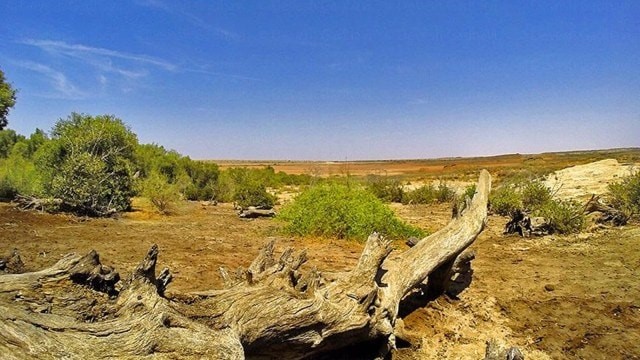
- 03 Feb 2025
In News:
In 2024, the Gujarat government declared the Inland Mangrove of Guneri, located in Kutch district, as the first Biodiversity Heritage Site (BHS) of the state under the Biological Diversity Act, 2002. The declaration followed a recommendation by the Gujarat Biodiversity Board.
Key Features of Guneri Inland Mangroves:
- Location: Guneri village, Lakhtar tehsil, Kutch district, Gujarat.
- Area: 32.78 hectares.
- Distance from Sea: ~45 km from the Arabian Sea; ~4 km from Kori Creek.
- Nature: Inland (non-coastal) mangrove ecosystem — one of only eight such sites globally and the last remaining in India.
- Terrain: Flat land resembling a forest; no tidal influence or sludge typically seen in coastal mangroves.
- Water Source: Sustained by groundwater retained in limestone deposits; no direct contact with seawater.
Ecological and Geological Significance:
- Possibly originated from:
- Miocene marine transgression, or
- Along the ancient Saraswati River, believed to have flowed in the Great Rann of Kutch around 3000–4000 BCE.
- Limestone formations in western Kutch provide continuous subsurface water flow, enabling survival of this unique mangrove system.
Biodiversity:
- Habitat to:
- 20 migratory bird species
- 25 resident migratory avifaunal species
- Acts as a vital ecosystem for local and seasonal wildlife.
Mangroves in India – 2024 Snapshot:
- As per the “Red List of Mangrove Ecosystems” (May 22, 2024):
- India has 3% of South Asia’s mangrove cover.
- Total mangrove area: 4,975 sq km (0.15% of India's land area).
- Increase: 54 sq km (1.10%) since last assessment.
- State-wise share:
- West Bengal: 42.45% (notably South 24 Parganas & Sundarbans)
- Gujarat: 23.66% (with highest increase: 37 sq km)
- Andaman & Nicobar Islands: 12.39%
Legal Framework:
- Declared under the Biological Diversity Act, 2002, which empowers state governments to notify BHS after consulting local self-government bodies.
- A local Biodiversity Management Committee (BMC), including representatives from self-governance institutions, will oversee protection and conservation.
- This provides a formal structure for site management, previously absent.
Conservation Measures:
- Training programs for local and tribal communities along with forest officials.
- A management plan will be implemented to preserve the unique flora and fauna.
Microplastics detected in Delhi’s Groundwater

- 02 Feb 2025
In News:
A first-of-its-kind study, commissioned by the Delhi government and conducted by The Energy and Resources Institute (TERI), has revealed the presence of microplastics in groundwater across all 11 districts of Delhi. The interim findings, submitted in November 2024, also reported microplastics in Yamuna River water and soil samples along its banks.
Key Findings:
- Widespread Contamination: Microplastics were found in groundwater samples across Delhi, indicating potential contamination due to leaching from the Yamuna River.
- Additional Contamination: Microplastics were also detected in the Yamuna's water and riverbank soil, suggesting environmental pervasiveness.
- Water Usage Impact: Since Delhi relies on borewells and treated groundwater for drinking and domestic purposes, this contamination raises serious public health concerns.
- No Objection by Authorities: The Delhi government has not disputed the study’s interim findings; further post-monsoon analysis is underway, and a final report is expected later in 2025.
What Are Microplastics?
According to the UN Environment Programme (UNEP):
- Definition: Plastic particles less than 5 mm in size
- Types:
- Primary Microplastics: Manufactured for use in cosmetics (e.g., microbeads) and textiles (e.g., microfibers from clothing, nets)
- Secondary Microplastics: Result from breakdown of larger plastics (e.g., bottles) due to sunlight, abrasion, and ocean waves
Environmental & Health Impacts:
- Persistence: Microplastics are non-biodegradable, mobile, and difficult to eliminate from natural ecosystems.
- Toxicity:
- Can adsorb harmful chemicals, making them more toxic
- Known to bioaccumulate in aquatic food chains
- Human Exposure: Microplastics can enter the human body via:
- Inhalation (air)
- Ingestion (water and seafood)
- Dermal absorption (through skin)
- Health Risks (UNEP Report – From Pollution to Solution, 2021):
- Potential effects on genetics, brain development, respiration, and placental health in newborns
- No global standard exists for safe microplastic limits in drinking water
Saffron Reedtail Damselfly
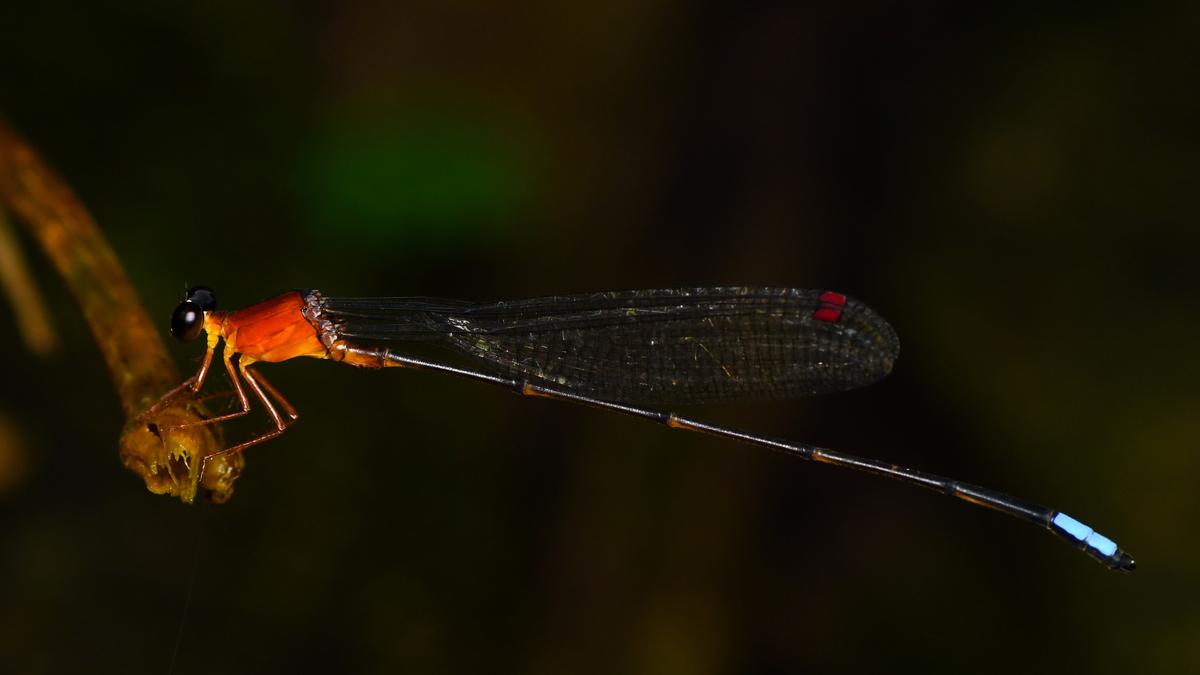
- 02 Feb 2025
In News:
For the first time, the Saffron Reedtail Damselfly, a rare and endemic species of the Western Ghats, has been recorded in Karnataka.
This significant discovery was made in Madhugundi village, Chikkamagaluru district, along the Nethravati River. The findings were published in the journal Entomon.
Key Facts:
- Scientific Name: Indosticta deccanensis
- Common Name: Saffron Reedtail
- Family: Platystictidae (commonly known as shadow damselflies)
- Appearance: Slender, delicate body with a characteristic saffron coloration
- Habitat: Prefers slow-moving forest streams surrounded by thick vegetation; requires pristine water quality
Ecological Significance:
- Indicator Species: Highly sensitive to environmental changes and pollution, indicating a healthy, undisturbed ecosystem.
- Biodiversity Implication:
- Previously recorded only in Tamil Nadu and Kerala.
- The first sighting in Karnataka (northern Western Ghats) extends the known range of the species, suggesting it may be more widely distributed than earlier believed.
Conservation Relevance:
- The discovery underscores the ecological richness of the Madhugundi forests, which were severely affected by floods and landslides in 2019.
- Highlights the urgency to protect fragile ecosystems from deforestation, water pollution, and climate change, especially in biodiversity hotspots like the Western Ghats.
About Damselflies (Order: Odonata):
- General Features:
- Predatory, aerial insects
- Slender bodies with net-veined wings
- Fly weakly compared to dragonflies
- Mostly inhabit freshwater habitats
Rusty-Spotted Cat

- 01 Feb 2025
In News:
For the first time, the Rusty-Spotted Cat (Prionailurus rubiginosus) has been spotted in the forests of Purulia district, West Bengal, captured on a camera trap set up by the NGO HEAL during pangolin poaching surveillance. This marks a significant range extension and has excited conservationists and forest officials.
Key Features
- World’s smallest and lightest wild cat: Weighs between 900 grams to 1.5 kg
- Length: Approx. 1.5 feet, with a 1-foot-long tail
- Appearance:
- Fawn-grey coat with rusty red spots on back and flanks
- Short, rounded head with two white facial streaks
- Large eyes with greyish-brown to amber irises – an adaptation to nocturnal behavior
- Short legs, black-soled feet, and an unmarked rusty tail
- Behavior:
- Nocturnal and elusive
- Uses scent marking to establish territory
- Gestation period: 66–70 days
Habitat and Distribution
- Found in dry deciduous and semi-deciduous forests, including:
- Northern & Central India, Western Ghats, Rajasthan, Kachchh, and Peninsular India
- Also present in Sri Lanka and Nepal
- India hosts 80% of the global population
Conservation Status
- IUCN Red List: Near Threatened, due to habitat loss, fragmentation, and human-wildlife conflict
- Wildlife Protection Act, 1972: Schedule I species (highest protection)
Significance of Purulia Sighting
- Located on the eastern edge of the Chota Nagpur Plateau
- Forests are interconnected with neighboring regions like Jharkhand and Odisha
- Notified as reserved forests, not protected forests
- Threats: Hunting by local communities, habitat degradation
Impact of Conservation Efforts
- Post-COVID, the forest ecosystem in Purulia has improved due to reduced human disturbance
- Past sightings of leopards, bears, jackals, and foxes indicate a thriving ecosystem
- HEAL and the Forest Department have launched livestock compensation programs to reduce retaliatory killings of carnivores
India adds 4 new Ramsar Sites
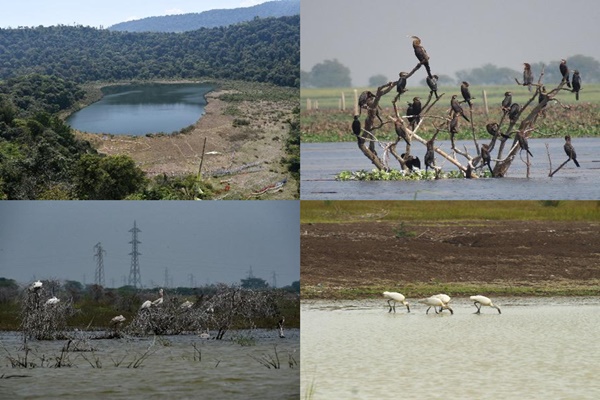
- 01 Feb 2025
In News:
The Government of India has added four new Ramsar sites, increasing the total to 89, the highest in Asia and third globally. The newly designated wetlands include:
- Sakkarakottai Bird Sanctuary (Tamil Nadu)
- Therthangal Bird Sanctuary (Tamil Nadu)
- Khecheopalri Wetland (Sikkim)
- Udhwa Lake (Jharkhand)
This marks a significant milestone as Sikkim and Jharkhand have received their first Ramsar recognitions, while Tamil Nadu strengthens its lead with 20 Ramsar sites, the most among Indian states.
About the Ramsar Convention
- Adopted: 1971 in Ramsar, Iran
- Objective: Conservation and wise use of wetlands through local, national, and international cooperation.
- World Wetlands Day: Celebrated on 2nd February to promote awareness.
Key Highlights:
Therthangal Bird Sanctuary – Tamil Nadu
- Notified in 2010; covers 29.29 ha.
- Crucial breeding and foraging site for waterbirds like Spot-billed Pelican, Black-headed Ibis, and Oriental Darter.
- Aids groundwater recharge and climate regulation.
- Part of the Central Asian Flyway.
Sakkarakottai Bird Sanctuary – Tamil Nadu
- Notified in 2012; spans 230.49 ha.
- Located near Gulf of Mannar; significant stopover for migratory birds.
- Hosts endemic species and near-threatened fauna like Lion-tailed Macaque and Giant Squirrel.
Khecheopalri Wetland – Sikkim
- Sacred lake revered by Buddhists and Hindus; called Sho Dzo Sho locally.
- Known as a wish-fulfilling lake.
- Birds prevent leaves from settling on the surface.
- Rich in avifauna: fishing eagles, Brahminy kites.
- Integral to ecotourism and biodiversity conservation.
Udhwa Lake – Jharkhand
- Comprises Pataura Jheel (155 ha) and Brahma Jamalpur Jheel (410 ha).
- First Ramsar site of Jharkhand; near Ganga River.
- Declared a bird sanctuary in 1991; attracts migratory birds from September onwards.
Falls under the Gangetic Plains biogeographic zone.
Environment Protection (End-of-Life Vehicles) Rules, 2025
- 31 Jan 2025
In News:
MoEFCC Notifies Rules for End-of-Life Vehicles to Minimize Waste and Pollution.
Key Highlights:
Notified by: Ministry of Environment, Forest and Climate Change (MoEF&CC)
Effective from: April 1, 2025
Legal Basis: Environment Protection Act, 1986
Objective: To promote environmentally sound management of end-of-life vehicles (ELVs), enable recycling and reuse of vehicle components, and reduce resource extraction, pollution, and waste generation.
Key Features of the ELV Rules, 2025
1. Scope and Coverage
- Applicable to all vehicle categories including electric vehicles (EVs), e-rickshaws, and e-carts.
- Exempted vehicles: Agricultural tractors, trailers, combine harvesters, and power tillers.
- Exempted waste types: Batteries, plastics, tyres, used oil, and e-waste (governed under separate waste management rules).
2. Extended Producer Responsibility (EPR)
- Vehicle producers are mandated to meet annual scrapping targets based on the age of vehicles:
- Transport vehicles: 15 years
- Non-transport vehicles: 20 years
- Producers must fulfill their EPR obligations for all vehicles introduced into the domestic market, including those used internally.
- Annual EPR declarations must be submitted to the Central Pollution Control Board (CPCB) by April 30 each year.
- Producers must promote ELV deposition at designated collection centres or Registered Vehicle Scrapping Facilities (RVSFs).
3. Responsibilities of Stakeholders
- Registered Owners & Bulk Consumers: Required to deposit ELVs at designated centres or RVSFs within 180 days of becoming unfit.
- Collection Centres:
- Handle ELVs in an environmentally responsible manner.
- Maintain records and ensure safe storage and transfer to RVSFs.
- Registered Vehicle Scrapping Facilities (RVSFs):
- Undertake depollution, dismantling, segregation, and recycling.
- Ensure environmentally sound disposal of non-recyclables via authorized TSDFs.
- Issue EPR certificates based on the volume of steel processed; valid for 5 years.
4. Monitoring, Compliance, and Penalties
- CPCB and State Pollution Control Boards (SPCBs) are responsible for:
- Registration, inspection, and audit of producers, RVSFs, and bulk consumers.
- Taking action against non-compliance, including suspension or cancellation of registration.
- Levying environmental compensation for violations that cause harm to public health or the environment.
5. Registration & Certification
- Producers register with CPCB; RVSFs and bulk consumers with respective SPCBs.
- Registration certificates are issued within 15 days of application via a centralized online portal.
- EPR certificates are non-transferable and allow adjustment of both current and backlog obligations.
Related Policy and Incentives by MoRTH
The Ministry of Road Transport and Highways (MoRTH) supports the ELV Rules through:
- Vehicle Scrapping Policy: Targets voluntary phasing out of unfit and polluting vehicles.
- Motor Vehicles (Registration and Functions of Vehicle Scrapping Facility) Rules, 2021: Provides operational criteria for RVSFs.
- Central Motor Vehicles (Amendment) Rules, 2021:
- Waiver of registration fee for buyers submitting ELV Certificates of Deposit.
- Concession in motor vehicle tax: 25% for non-transport, 15% for transport vehicles.
Electric Mobility Push
- MoRTH has issued several notifications promoting EVs, including:
- Permit exemptions for battery-operated and ethanol/methanol-fueled vehicles.
- Fee exemptions for registration and renewals.
- Tourist permit benefits for EVs and distinct registration marks for visibility.
PM E-DRIVE Scheme
- Launched by Ministry of Heavy Industries on 29th September 2024 with a ?10,900 crore outlay.
- Aims to support electric 2-wheelers, 3-wheelers, ambulances, trucks, and buses with ?3,679 crore in demand incentives.
- Targets subsidization of over 28 lakh EVs.
Olive Ridley Turtles
- 30 Jan 2025
In News:
The Rushikulya river mouth in Odisha is witnessing the anticipated mass nesting of Olive Ridley turtles — a critical event for the survival of this vulnerable marine species. This phenomenon, known as arribada, highlights the ecological significance of India’s coastal biodiversity and the urgent need for marine conservation.
About Olive Ridley Turtles (Lepidochelys olivacea)
- Taxonomy:
- Scientific Name: Lepidochelys olivacea
- Class: Reptilia
- Family: Cheloniidae
- Physical Features: These turtles are the smallest and most abundant of all sea turtle species. They are recognized by their olive or grayish-green heart-shaped carapace. Males and females are similar in size, though females have slightly rounder shells.
- Habitat and Distribution: Olive Ridleys are found in warm, tropical waters of the Pacific, Atlantic, and Indian Oceans, inhabiting both open ocean (pelagic) and coastal waters.
Mass Nesting: The Arribada Phenomenon
- Arribada (Spanish for "arrival") refers to the synchronized mass nesting behavior where thousands of females gather on a single beach to lay eggs.
- Nesting occurs annually between December and March, after long migrations of up to 9,000 km. Each female may lay 90–120 eggs, 1 to 3 times per season.
- Temperature-dependent sex determination influences hatchling sex ratios.
- After nesting, females return to the sea, leaving eggs buried in sand.
Major Nesting Sites in India
- Odisha Coast is the most significant nesting ground in India and globally:
- Gahirmatha Marine Sanctuary: World’s largest mass nesting site.
- Rushikulya River Mouth: Second-largest nesting beach in India.
- Devi River Mouth: Another key nesting site in Odisha.
- Andaman and Nicobar Islands have recently emerged as a new mass nesting area, with over 5,000 nests reported in one season.
Ecological Role and Behavior
- Diet: Omnivorous — they feed on jellyfish, crabs, snails, prawns, molluscs, algae, and small fish.
- Behavior: These turtles undertake long migrations annually between feeding and breeding grounds, spending most of their lives at sea.
Protection Status
- IUCN Red List: Vulnerable
- CITES: Appendix I
- Wildlife (Protection) Act, 1972 (India): Schedule I (highest protection)
Threats to Survival
- Bycatch in Fishing Gear: Accidental entanglement in trawls, gillnets, and longlines.
- Habitat Loss: Coastal development for ports, tourism, and industry disrupts nesting beaches.
- Poaching: Turtles and their eggs are harvested for meat, shell, and leather.
- Pollution: Plastic ingestion and marine debris pose severe health risks.
- Climate Change: Rising sea levels and increased sand temperatures impact nesting and hatchling sex ratios.
Conservation Initiatives
- Operation Olivia: Initiated by the Indian Coast Guard in the 1980s to protect turtles during nesting and prevent illegal fishing.
- Turtle Excluder Devices (TEDs): Mandated by the Odisha government in trawl nets; allow turtles to escape while retaining fish catch.
- Tagging Programs: Use of non-corrosive metal tags to study migration patterns and inform conservation strategies.
Asian Waterbird Census 2025
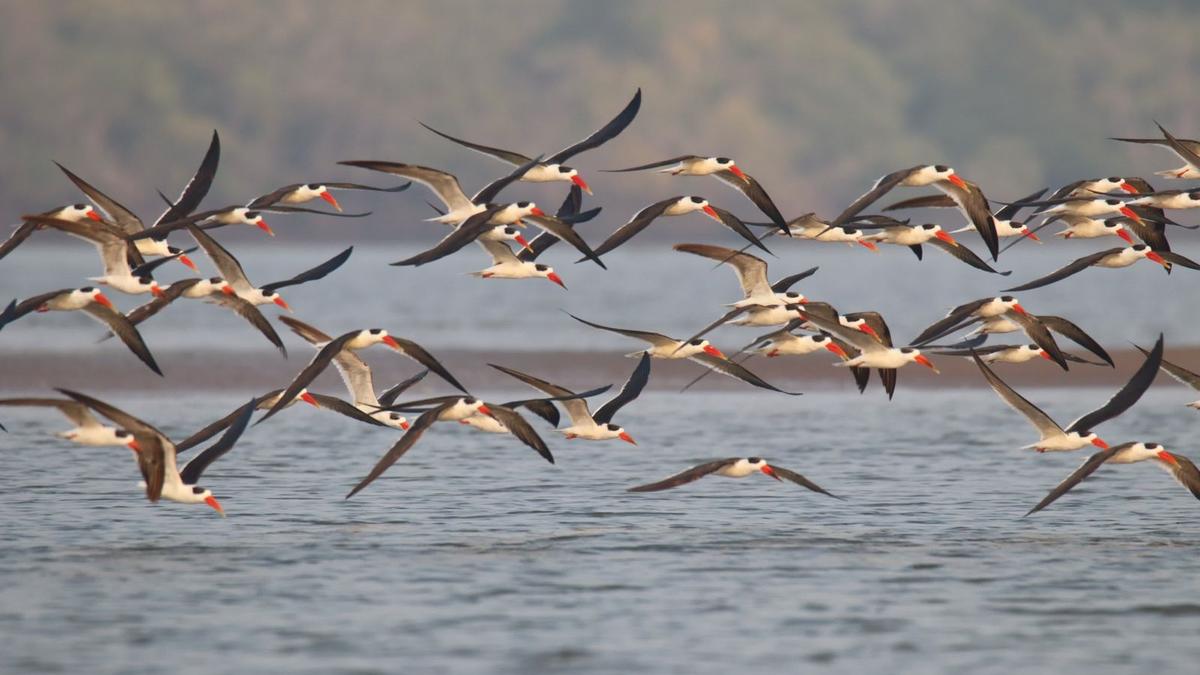
- 29 Jan 2025
In News:
As per the Asian Waterbird Census-2025, a record number of 39,725 birds belonging to 106 species have been sighted in the Coringa Wildlife Sanctuary and adjoining wetlands.
Asian Waterbird Census (AWC): An Overview
- AWC is an annual citizen-science programme that supports the conservation of wetlands and waterbirds across Asia.
- Initiated in 1987 in the Indian subcontinent, it now covers extensive regions of East and Southeast Asia, Japan, Australasia, and parts of the Central Asian and East Asian–Australasian Flyways.
- AWC is the Asian chapter of the global International Waterbird Census (IWC).
- In India, it is coordinated by the Bombay Natural History Society (BNHS) and the Wildlife Institute of India (WII) every January.
About BNHS (Bombay Natural History Society)
- An Indian NGO engaged in biodiversity research and conservation.
- Recognized as a Scientific and Industrial Research Organisation (SIRO) by the Department of Science and Technology.
- Official partner of BirdLife International in India.
Coringa Wildlife Sanctuary (Andhra Pradesh): Census Findings 2025
- The Asian Waterbird Census 2025 recorded a record 39,725 birds representing 106 species in the Coringa Wildlife Sanctuary (CWS) and adjoining Godavari estuary wetlands.
- Of these, nearly 70 species are migratory, using the site as a key winter feeding ground.
Species of Conservation Concern
- Endangered species sighted:
- Indian Skimmer (Rynchops albicollis) – ~450 individuals sighted
- Black-bellied Tern (Sterna acuticauda)
- Great Knot (Calidris tenuirostris)
- Vulnerable species: Common Pochard (Aythya ferina)
- Near Threatened species: 11 species identified
Migratory Pathways and Monitoring
- Migrants such as the Great Knot travel from Russia, Siberia, China, and Mongolia to the Godavari estuary.
- A tagged Great Knot, tracked from Russia, was recorded after a 7,500 km journey, seen in Bhairavapalem mudflat and Etimoga wetland in successive winters (2024 and 2025).
- Data sharing with global avian research groups aids in tracking migratory patterns and supports conservation of endangered species.
Ecological and Ramsar Significance
- The Godavari estuary supports feeding grounds for nearly 90,000 birds, as observed by CWS authorities.
- Avian diversity is a key criterion for Ramsar Site designation, and experts advocate for Coringa Wildlife Sanctuary and its surroundings to be recognized as a wetland of international importance under the Ramsar Convention.
Indian Squid

- 29 Jan 2025
In News:
Researchers at the Central Marine Fisheries Research Institute (CMFRI), Kochi, have successfully decoded the gene expression pattern of the Indian squid (Uroteuthis duvaucelii), marking a major scientific advancement with wide-ranging implications for neuroscience, environmental studies, and sustainable marine resource management.
About Indian Squid
- Common Name: Indian Calamari
- Scientific Classification: Cephalopod
- Size: Typically 20–30 cm; can grow up to 50 cm
- Appearance: Light pinkish-grey body with two large fins, eight arms, and two longer tentacles used for capturing prey
- Key Abilities:
- Camouflage
- Jet propulsion for rapid movement
- Advanced nervous system
- Problem-solving skills and behavioral intelligence
Habitat & Distribution
- Preferred Habitat: Coastal and open sea regions of the Indian Ocean
- Found at depths ranging from 100 to 500 meters, some even up to 1,500 meters
- Requires high dissolved oxygen levels for respiration
- Geographic Distribution:
- Widely distributed in the Indo-West Pacific
- Found in Indian Ocean, Red Sea, Arabian Sea, from Mozambique to the South China Sea, Philippine Sea, and northward to Taiwan
- Conservation Status: IUCN Red List: Least Concern
Scientific Significance of Genetic Research
- Key Findings:
- Revealed genetic similarities with higher vertebrates like fish and humans, suggesting deep evolutionary links
- Indicates that Indian squid could serve as a model organism to study brain evolution, intelligence, and neurobiological functions
- Potential to inform research in neural circuits, memory, learning, and even neurological diseases
- Findings may also explain squid's adaptive success, such as evading predators and fishing pressures due to high cognitive ability
Institutional Background: CMFRI
- Established: 1947
- Affiliation: Part of the Indian Council of Agricultural Research (ICAR) since 1967
- Headquarters: Kochi, Kerala
- Mandate: Research on sustainable marine fisheries and ecosystem conservation
CMFRI’s Broader Recommendations for Sustainable Marine Management
- Enactment of Sea Fishing Act to regulate fishing beyond territorial waters
- Institutionalization of ecological stock assessments for sustainable exploitation
- Simplification and promotion of open mariculture with focus on environmental sustainability
- Use of AI-based systems to estimate landings and monitor fishing vessels
- Deep-sea resource exploration and alternative fishing methods
- Institutional mechanism for supervising deep-sea fishing
- Strengthening insurance coverage for marine fishers
Chinar Trees

- 22 Jan 2025
In News:
The J&K Forest Department, in collaboration with the J&K Forest Research Institute (JKFRI), has launched a pioneering conservation initiative to digitally preserve the iconic Chinar trees (Platanus orientalis)—a vital part of Kashmir’s ecological and cultural heritage.
Significance of Chinar Trees:
- Locally known as Boonyi or Boueen, Chinar trees are deeply embedded in Kashmir’s cultural identity.
- These deciduous trees can grow up to 30 meters tall with a girth of 10–15 meters, and can live for over 600 years.
- They are known for their seasonal leaf color transformation—from green in summer to red, amber, and yellow in autumn.
- Notable specimens include Asia’s largest Chinar in Ganderbal and the oldest known Chinar (647 years) in Chattergam, Budgam.
Challenges to Chinar Survival:
- Urban expansion and habitat encroachment.
- Climate change, altering precipitation and temperature patterns.
- Illegal felling and timber exploitation.
- Increased susceptibility to pests and diseases.
Tree Aadhaar & Geo-Tagging Initiative:
- Over 28,500 Chinar trees have been geo-tagged and assigned unique Tree Aadhaar numbers from 2021 to 2023.
- Each tree is fitted with a QR-coded digital plate, enabling real-time access to:
- Tree location, height, girth, canopy dimensions
- Health status, ecological threats, and pest presence
- These plates are spring-mounted metal tags to prevent damage to the trees.
Conservation Goals & Future Plans:
- Digital Protection: Enables proactive monitoring and protection through a centralized database.
- Chinar Atlas: A comprehensive mapping of all Chinar trees in the region.
- Public Access Website: A dedicated digital portal is planned for broader access to Chinar data.
- Risk Assessment: Use of USG-based, non-invasive surveys to identify trees at risk without human interference.
- Emphasis on covering remote and restricted areas in future phases to ensure inclusivity in conservation.
Konkan Region’s Sada and Biodiversity
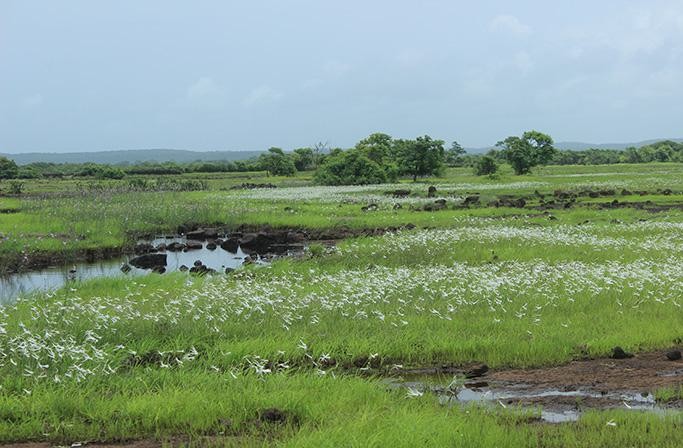
- 14 Jan 2025
In News:
A Konkan secret, the flat-top sada is a freshwater paradise.
Key Highlights:
Geography of Sada:
- The Konkan region lies between the Arabian Sea and the Western Ghats.
- Sada refers to flat-topped hills, formed by centuries of erosion, and is a prominent feature in the Ratnagiri district.
- These areas are typically barren except during the monsoon season when they come alive with flora and fauna.
Biodiversity and Ecosystem Services:
- A biodiversity survey between 2022-2024 recorded 459 plant species, with 105 being endemic to the Konkan region.
- The survey also identified 31 species of reptiles, 13 species of amphibians, 169 species of birds, and 41 species of mammals.
- These ecosystems play a vital role in water conservation. The lateritic soil layer atop the Sada acts as a catchment for rainwater, recharging the groundwater and providing freshwater to local communities year-round.
Traditional Land Use and Agriculture:
- Local Farming: During monsoons, the Sada is used by locals for growing traditional crops like rice and millets (e.g., nanchani), using sustainable farming practices without pesticides or chemical fertilizers.
- Water Management: The locals rely on open wells, springs, and perennial streams for freshwater, which are carefully maintained through cultural rituals and community hygiene practices.
Conservation and Cultural Importance:
- The region is home to geoglyphs, ancient artworks estimated to be 10,000 years old, adding to its cultural and historical significance.
- Waterbodies on the Sada serve as habitats for species like the Indian flapshell turtle (Lissemys punctata) and provide water for other wildlife, including leopards, jackals, hyenas, barking deer, and migratory birds.
Environmental Threats:
- Land-use Change: Increasing conversion of open land and croplands into orchards and residential areas, along with various developmental projects, threatens the region's biodiversity.
- Mining: Extraction of laterite stones for construction purposes is another environmental risk.
- Wasteland Classification: The region is often classified as a ‘wasteland’ in the Wasteland Atlas, further complicating conservation efforts.
World’s First Cryo-Born Baby Corals
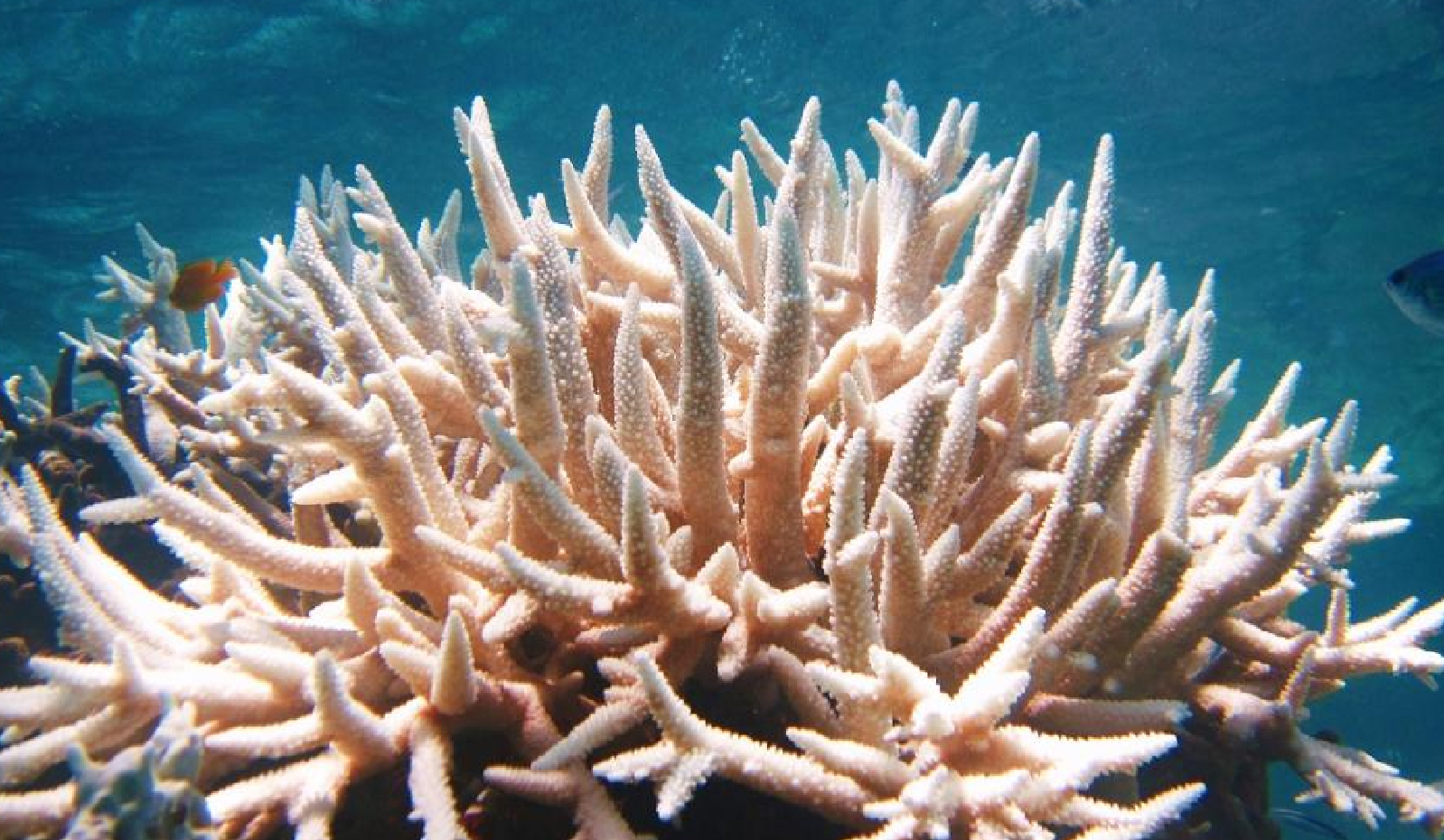
- 13 Jan 2025
In News:
World’s First Cryo-Born Baby Corals Successfully Settled on the Great Barrier Reef.
Introduction to Cryo-Born Corals
- Cryo-born corals are created using cryopreservation techniques, which involve freezing coral cells and tissues at very low temperatures.
- The process preserves coral cells by preventing the formation of ice crystals that would otherwise damage them.
- Cryopreservation involves adding cryoprotectants to remove water from cells, enabling their survival during freezing and thawing.
Significance of the Breakthrough
- Climate Change Resilience: The initiative aims to create heat-tolerant corals, which are crucial in combating the impact of rising ocean temperatures due to climate change.
- Selective Breeding Advantage: Cryopreservation allows for controlled breeding and bypasses the limitations of natural coral spawning, which occurs only once a year. This enables multiple reproduction cycles without disturbing wild populations.
The Process of Cryo-Born Coral Production
- Sperm Collection: During coral spawning events, sperm from various coral species is collected and frozen at -196°C using liquid nitrogen, halting metabolic processes.
- Coral Egg Fertilization: Cryopreserved sperm is used to fertilize fresh coral eggs, which are grown in a specialized research facility called the National Sea Simulator.
- Coral Cradles: After growth, the cryo-born corals are carefully transported and settled into specially designed "coral cradles" placed in the Great Barrier Reef, where their growth is monitored during their critical first year.
Importance of Cryo-Born Corals in Reef Restoration
- The primary aim is to introduce millions of heat-tolerant corals annually to restore reefs affected by climate change.
- The Taronga CryoDiversity Bank houses the world’s largest frozen coral sperm collection from 32 coral species, collected annually since 2011, providing a resource for future restoration efforts.
Coral Reefs: An Overview
- Corals are marine invertebrates from the class Anthozoa, phylum Cnidaria.
- Reefs are built by colonies of coral polyps that secrete limestone skeletons and rely on symbiotic algae (zooxanthellae) for nutrition.
- Coral reefs are typically found in shallow, sunlit waters with a temperature range of 16-32°C and depths less than 50 meters.
Global and Indian Coral Conservation Efforts
- India:
- The National Committee on Wetlands, Mangroves, and Coral Reefs (1986) advises on conservation measures.
- The Environment (Protection) Act (1986) prohibits the use of coral and sand in construction.
- Zoological Survey of India (ZSI) uses Biorock technology for coral restoration.
- Global Efforts:
- CITES lists coral species in Appendix II, regulating coral trade.
- The World Heritage Convention designates coral reefs as protected sites.
Global Impact and Future Directions
- The innovative work by Australian scientists opens the door for large-scale restoration efforts by allowing more controlled breeding and genetic diversity, making corals more resilient to climate change.
- This breakthrough could revolutionize coral restoration, scaling up efforts to introduce millions of resilient corals to reefs worldwide, building long-term resilience against climate change.
Miyawaki Technique
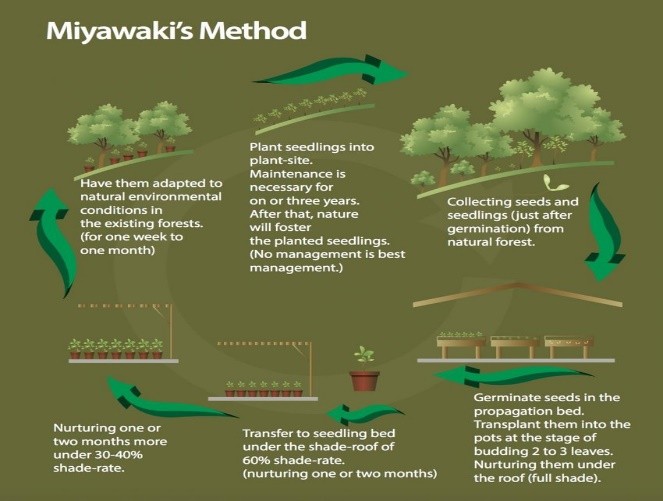
- 09 Jan 2025
In News:
- Prayagraj Municipal Corporation has successfully transformed over 56,000 square meters of garbage dumps and barren lands into lush green forests using the Miyawaki Technique over the past two years, as part of environmental conservation efforts in preparation for Mahakumbh 2025.
About Miyawaki Technique:
- Origin: Developed by Akira Miyawaki, a Japanese botanist, in the 1970s to create dense and fast-growing forests.
- Key Features:
- Dense Planting: Trees and shrubs are planted close together, often using native species.
- Accelerated Growth: Trees grow 10 times faster than in traditional forests.
- Soil Restoration: Improves soil fertility and promotes natural regeneration.
- Biodiversity Boost: Supports a variety of flora and fauna by mimicking natural ecosystems.
- Significance:
- Urban Reforestation: Converts barren or polluted lands into green spaces.
- Environmental Benefits:
- Reduces air and water pollution.
- Absorbs carbon and helps combat climate change.
- Lowers temperatures by 4-7°C.
- Sustainability: Prevents soil erosion and promotes long-term ecological balance.
Miyawaki Forests in Prayagraj:
- Achievements:
- Over 56,000 square meters of land converted into dense forests using the Miyawaki technique over the last two years.
- The project aims to create oxygen banks in preparation for the Mahakumbh 2025 and enhance air quality for millions of expected visitors.
- Plantations:
- 55,800 square meters of area developed across 10+ locations in Prayagraj.
- Largest plantation: 1.2 lakh trees in Naini industrial area.
- 27,000 trees planted in Baswar after cleaning the city's largest garbage dump.
- Environmental Impact:
- The plantations are helping to reduce dust, dirt, and foul odors, thus improving air quality.
- Temperature regulation: The dense forests can lower temperatures by 4 to 7 degrees Celsius.
- Biodiversity and Soil Fertility: Accelerated growth of trees boosts biodiversity and improves soil fertility.
- Tree Species Planted:
- Mango, Mahua, Neem, Peepal, Tamarind, Arjuna, Teak, Amla.
- Ornamental and medicinal plants like Hibiscus, Kadamba, Gulmohar, etc.
- Other species include Sheesham, Bamboo, Lemon, Drumstick (Sahjan), and Tecoma.
Benefits of Miyawaki Forests:
- Air and Water Pollution Reduction: Trees absorb carbon, purify air, and improve water quality.
- Temperature Control: The forests help in reducing urban heat islands, lowering the temperature during hot months.
- Soil Conservation: The dense forests prevent soil erosion and promote the regeneration of the natural ecosystem.
- Enhanced Biodiversity: The technique supports a rich variety of species, improving ecological balance.
Translocation of Tigers from Madhya Pradesh
- 05 Jan 2025
In News:
Madhya Pradesh to translocate 15 Tigers to Rajasthan, Odisha and Chhattisgarh.
Key Highlights of the Translocation:
- Scale of Translocation: Largest relocation of big cats from a single state in India.
- Approval: NTCA has approved the translocation of 15 tigers from Madhya Pradesh to Rajasthan, Chhattisgarh, and Odisha.
- Source Reserves:
- Bandhavgarh, Panna, Kanha, and Pench Tiger Reserves in Madhya Pradesh.
- Distribution Plan:
- Rajasthan: 4 tigresses.
- Chhattisgarh: 2 male tigers and 6 tigresses.
- Odisha: 1 male tiger and 2 tigresses.
- Funding: States receiving tigers will bear all expenses related to translocation.
Objectives of the Translocation:
- Enhance Tiger Conservation: Reintroduce and bolster tiger populations in recipient states.
- Population Management: Relocate tigers to areas with suitable habitats to alleviate territorial disputes in overpopulated reserves.
- Genetic Diversity: Introduce new individuals to isolated tiger groups to prevent inbreeding and support long-term species survival.
About Kanha, Bandhavgarh, and Pench Tiger Reserves:
- Kanha Tiger Reserve:
- Location: Maikal range of the Satpura Mountains.
- Significance: Largest national park in Madhya Pradesh.
- Distinct Feature: First tiger reserve in India with an official mascot, ‘Bhoorsingh the Barasingha’.
- Flora and Fauna: Rich biodiversity with Royal Bengal Tigers, leopards, and the IUCN Vulnerable species, Barasingha.
- Bandhavgarh Tiger Reserve:
- Location: Between Vindhyan and Satpura ranges in Umaria district, Madhya Pradesh.
- Significance: Known for one of the highest densities of Royal Bengal Tigers in India.
- Historical Link: The ancient Bandhavgarh Fort, linked to the legend of Lord Rama and Lakshmana.
- Pench Tiger Reserve:
- Location: Spans Seoni and Chhindwara districts in Madhya Pradesh, extends into Maharashtra.
- Significance: Inspiration for Rudyard Kipling’s The Jungle Book.
- Flora and Fauna: Includes teak, saag, mahua forests; tigers, leopards, wild dogs, and gaur are key species.
Tiger Translocation Project Overview:
- First Project:
- Initiated in 2018, two tigers relocated from Kanha and Bandhavgarh to Satkosia Tiger Reserve in Odisha.
- Main Objectives:
- Reintroduce Tigers: In areas where they have been extirpated or extinct.
- Alleviate Territorial Disputes: Overpopulated reserves need additional tigers to reduce human-animal conflict.
Benefits of Translocation:
- Ecological Balance: Restores predator-prey dynamics in underpopulated reserves.
- Human-Animal Conflict Mitigation: Reduces conflict in overcrowded reserves.
- Rewilding Landscapes: Revives areas where tigers were locally extinct.
Concerns Associated with Translocation:
- Local Community Protests: Villagers fear tigers will pose a threat to their safety.
- Territorial Disputes: New tigers may face conflict with resident tigers.
- Poor Forest Management: Inadequate prey augmentation and habitat management may hinder success.
Madhya Pradesh’s Role in Tiger Conservation:
- Largest Tiger Population: Madhya Pradesh hosts the largest number of tigers in India, with 785 tigers as per NTCA’s 2022 report.
- Tiger Reserves: The state is home to nine tiger reserves, including the newly notified Madhav Tiger Reserve in Shivpuri.
- Translocation Strategy: Madhya Pradesh’s involvement helps reduce local tiger population pressure and contributes to broader conservation efforts across India.
Inter-State Tiger Translocation Goals:
- Reinforcement and Reintroduction: Introduce tigers into areas historically part of their range but from which they have been extirpated or extinct.
- Genetic Diversity: Introduce new tigers to isolated populations to maintain long-term population health.
CGWB Report on Groundwater Contamination

- 03 Jan 2025
In News:
The Central Ground Water Board (CGWB) report on groundwater quality reveals alarming levels of contamination in India's groundwater, with a focus on nitrate, fluoride, arsenic, and uranium. The report highlights the impact of agricultural practices, poor waste management, and urbanisation on water quality.
Key Highlights:
Nitrate Contamination:
- 440 districts in India report excessive nitrate levels in groundwater, with 20% of samples exceeding the permissible nitrate limit of 45 mg/L (WHO and BIS standards).
- High-risk regions: Rajasthan (49%), Karnataka (48%), and Tamil Nadu (37%) are the top states with high nitrate levels. Other affected states include Maharashtra, Telangana, Andhra Pradesh, and Madhya Pradesh.
- Causes: Nitrate contamination is mainly due to excessive use of nitrogen-based fertilizers, over-irrigation, and poor management of animal waste. Urbanisation and improper sewage systems exacerbate the problem.
Other Groundwater Contaminants:
- Fluoride contamination: A significant concern in Rajasthan, Haryana, Karnataka, Andhra Pradesh, and Telangana.
- Arsenic contamination: Elevated arsenic levels found in several states, especially in floodplains of the Ganga and Brahmaputra rivers (West Bengal, Jharkhand, Bihar, Uttar Pradesh, Assam, and Manipur).
- Uranium contamination: 42% of uranium-contaminated samples are from Rajasthan, and 30% from Punjab. Chronic exposure to uranium leads to kidney damage.
Groundwater Extraction and Availability:
- 60.4% of groundwater is being extracted across India.
- 73% of groundwater blocks are classified as in the ‘safe’ zone, an improvement from 67.4% in 2022.
Monsoon Impact:
- Nitrate contamination increases post-monsoon, with 32.66% of samples exceeding safe limits during the rainy season.
Health Implications:
- High nitrate levels, particularly dangerous for infants, can cause blue baby syndrome (methemoglobinemia).
- Long-term exposure to contaminants like fluoride and arsenic can lead to fluorosis and increase the risk of cancers and skin lesions.
Sources of Contamination:
- Agricultural practices: Excessive use of fertilizers, pesticides, and improper irrigation.
- Waste disposal: Leaking septic systems, sewage, and hazardous waste sites contribute to contamination.
- Urbanisation: Increased wastewater and sewage, along with poor waste management, worsen the issue.
Measures to Address Contamination:
- Jal Shakti Abhiyan (JSA) and Atal Bhujal Yojana (ABHY) aim to conserve and manage groundwater resources.
- National Aquifer Mapping and Management Program (NAQUIM) to assess and map aquifer systems.
- Pollution control programs: Under the Water (Prevention & Control) Act, 1974, and initiatives like sewage treatment plants and effluent treatment plants to manage wastewater.
- Public awareness: Campaigns like Swachh Bharat Mission and Catch the Rain educate communities on the importance of groundwater conservation.
Key Statistics:
- 56% of districts in India report groundwater nitrate levels exceeding the safe limit of 45 mg/L.
- Monsoon effects: Post-monsoon data shows a significant increase in contamination levels (32.66% vs. 30.77% pre-monsoon).
Stellaria bengalensis

- 02 Jan 2025
In News:
After a plant species of the genus Stellaria (family Caryophyllaceae) was reported from Kerala earlier this year, researchers have identified another member of the same genus at Kalimpong district in West Bengal.
Key Highlights:
Discovery and Identification:
- Published: The discovery was published in Phytotaxa.
- Location: Found in Kalimpong district, West Bengal, at altitudes of 2,245-2,450 metres in the Sangser forest.
- Named: The species is named Stellaria bengalensis after the state of West Bengal.
Taxonomy and Characteristics:
- Family: Caryophyllaceae.
- Type: Annual herb.
- Size: Grows to a height of 8 to 10.5 cm.
- Flowers: White in color, with shorter petals, often included within the sepal, and absence of bracts.
- Seeds: Sharp and pointed.
- Flowering and Fruiting: Occurs from May to September.
Distribution:
- Region: Primarily found in the Himalayan region.
- Similar Species: Stellaria mcclintockiae, identified earlier in Kerala (Nelliyampathy Hills).
- Both species grow in muddy soil slopes and are annuals.
Conservation Status:
- Under IUCN (International Union for Conservation of Nature) criteria, the species is assessed as "data deficient", pending further studies.
- Potential Habitat: There is a possibility of finding more populations in the western Himalayas.
Significance:
- Stellaria bengalensis is the second Stellaria species reported in India in 2025.
- India is home to about 22 Stellaria species, predominantly found in the Himalayan region.
- The discovery adds to biodiversity knowledge in India and underscores the importance of studying plant species in the region.
Sambar Deer

- 29 Dec 2024
In News:
Three poachers were arrested for killing a sambar deer in the Daying Ering Memorial Wildlife Sanctuary (DEMWS), East Siang district, Arunachal Pradesh.
Action Taken:
- Poachers Arrested: The poachers were booked under the Wildlife Protection Act 1972 and Arms Act 1959. The seized articles were handed over to the police, and a FIR was registered.
- Sanctuary Protection Efforts: The Divisional Forest Officer (DFO) emphasized the need for intensified surveillance to prevent further hunting incidents. Public cooperation was urged to report such incidents for prompt action.
About Sambar Deer:
- Scientific Name: Rusa unicolor.
- Native Regions: Found across the Indian subcontinent and Southeast Asia.
- Other Names: Known as Jarao in Nepal and Four-eyed deer in China.
- IUCN Red List: Listed as Vulnerable.
Key Features:
- Size: Stands between 1.2–1.4 meters at the shoulder.
- Weight: Can reach up to 550 kg, making it the largest oriental deer.
- Coat: Dark brown with a ruff around the neck, and unspotted.
- Antlers: Male sambar bears long, rugged antlers with three points (tines).
- Behavior: Elusive, most active at dusk and night.
Habitat:
- Water Dependency: Always found near water sources.
- Habitat Range: Dry deciduous forests, rainforests, and mixed forests.
- Social Structure: Often found alone or in small groups.
About Daying Ering Memorial Wildlife Sanctuary (DEMWS):
- Location: Situated in East Siang district, Arunachal Pradesh.
- Established: Originally established as Lali Wildlife Sanctuary in 1976, renamed Daying Ering Memorial in 1986.
- Climate: Tropical, receiving both north-east and south-west monsoons.
- Waterways: Home to the Siang River, one of Arunachal's major rivers.
Flora:
- Vegetation: Composed mainly of riverine plains with a variety of thatch and grasses.
- Trees: Includes scattered patches of trees such as Termenelia myriocarpa, Dillenia indica, Albizia spp., and Bombax ceiba.
Fauna:
- Mammals: Includes Hog Deer, Wild Pig, Tiger, and Elephant.
- Birds: Over 150 species of birds, including endangered species like the White-Winged Wood Duck and Bengal Florican.
Cephalopods

- 26 Dec 2024
In News:
Octopuses and their relatives are a new animal welfare frontier
- Cephalopods are highly intelligent, marine invertebrates that include species such as octopuses, squids, and cuttlefish.
- They are members of the class Cephalopoda in the phylum Mollusca, which is known for its diversity and complex morphology.
- Cephalopods are often considered one of the most behaviorally and morphologically complex classes within this phylum.
Key Features and Anatomy
Cephalopods exhibit several distinctive features:
- Body Structure: They have a head-foot structure, where the head is merged with the foot, and arms/tentacles surround the head. The arms and tentacles are derivatives of the foot, with some species possessing additional appendages for grasping or movement.
- Tentacles and Beak: Cephalopods possess tentacles, often with suction cups or hooks for capturing prey. They also have beak-like jaws, which are used to break down food.
- Eyes and Vision: Their unique W-shaped pupils enhance their vision. Most cephalopods are believed to be colorblind, but they exhibit remarkable visual camouflage through chromatophores (pigment cells) and reflectors beneath their skin, which can produce a wide range of colors and patterns.
- Movement: Cephalopods use jet propulsion to move. By expelling water from their mantle cavity, they can quickly travel through the water. Some species, like octopuses, also "walk" using their arms, while squids and cuttlefish employ fins for propulsion.
- Circulatory System: They have three hearts. Two hearts pump deoxygenated blood, while the third pumps oxygenated blood. Their blood is blue due to the presence of copper-based hemocyanin, which is effective in cold, low-oxygen environments.
- Neural Systems: Cephalopods are known for their advanced nervous systems. A significant portion of the neurons, especially in octopuses, are not located in the central brain but are distributed across the arms in “mini-brains” or ganglia, which helps coordinate movement and sensory functions independently.
Cognitive Abilities
Cephalopods have garnered significant attention due to their impressive cognitive abilities. Their intelligence is demonstrated in several areas:
- Problem-Solving: They are capable of using tools and strategies to solve complex tasks, such as escaping enclosures or catching prey.
- Learning and Memory: Cephalopods exhibit sophisticated learning behaviors, including associative learning and memory. Some species are known to delay gratification, choosing more preferred food items over immediate but less desirable ones. They also show evidence of "reversal learning," where they can adjust their behavior in response to changing environmental cues.
- Camouflage and Communication: Cephalopods can manipulate their skin's color and texture for camouflage, aiding in hunting and predator avoidance. For example, the Australian giant cuttlefish uses its chromatophores to communicate with potential mates or warn off competitors.
Species Diversity
Cephalopods are classified into three primary superorders:
- Octopodiforms: Includes octopuses (e.g., Octopus vulgaris), which are known for their intelligence and ability to solve problems.
- Decapodiforms: Includes squids and cuttlefish (e.g., Sepia officinalis, Architeuthis dux), which possess unique locomotion and hunting strategies.
- Nautiloids: Includes the chambered nautilus, the only cephalopod with an external shell, which is considered more primitive compared to other cephalopods.
Ethical and Conservation Concerns
Due to their intelligence and advanced nervous systems, cephalopods are becoming a focus of ethical debates regarding their treatment. Recently, California and Washington have enacted bans on octopus farming, and Hawaii is considering similar measures. These decisions are driven by the growing understanding of cephalopods' cognitive abilities and their capacity for suffering. As a result, there are increasing calls for humane treatment regulations similar to those for vertebrates.
Environmental and Ecological Role
Cephalopods play crucial roles in marine ecosystems. As carnivorous predators, they help maintain the balance of marine food chains by hunting smaller prey. Some species, such as the cuttlefish, also play important roles in communicating and signaling within their species through visual displays.
IPBES Nexus Report
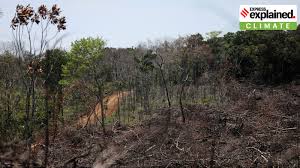
- 22 Dec 2024
In News:
The IPBES Nexus Report, formally titled The Assessment Report on the Interlinkages Among Biodiversity, Water, Food, and Health, was released to address the interconnected global challenges of climate change, biodiversity loss, food insecurity, water scarcity, and health risks. The report stresses that these challenges are deeply intertwined and cannot be solved separately; doing so would lead to ineffective or even counterproductive results.
Key Highlights of the Nexus Report
- Interconnections Between Global Challenges: The report emphasizes the strong interlinkages between the five major global challenges:
- Biodiversity Loss
- Water Scarcity
- Food Insecurity
- Health Risks
- Climate Change
It argues that efforts to address these challenges independently are ineffective and often exacerbate the problems. For example, scaling up food production to combat hunger can put more pressure on land, water, and biodiversity.
- Economic Cost of Biodiversity Loss:
- Global GDP Dependency: Over half of the global GDP (approximately $58 trillion annually) depends on nature. Biodiversity degradation significantly undermines productivity and economic output.
- Unaccounted Costs: The neglect of biodiversity in economic activities contributes to a loss of $10-25 trillion annually.
- Delayed Action: Delaying action on biodiversity conservation could double the costs within the next decade, potentially incurring $500 billion per year in additional costs.
- Synergistic Approach: The report identifies over 70 response options that promote synergistic outcomes across the five challenges. These include:
- Restoring Carbon-Rich Ecosystems: Such as forests, soils, and mangroves to address climate change and biodiversity loss.
- Managing Biodiversity to Prevent Disease Transmission: Effective biodiversity management reduces risks of diseases passing from animals to humans (zoonotic diseases).
- Sustainable Diets: Promoting diets that are both healthy and environmentally sustainable.
- Nature-Based Solutions: Implementing solutions that rely on natural processes to mitigate challenges like water scarcity and climate change.
- Inequality and Vulnerability: The report highlights how inequality exacerbates the challenges. Vulnerable populations, especially those living in areas where biodiversity has sharply declined, face increased health risks, malnutrition, and economic instability. 41% of people live in regions where biodiversity loss has been particularly severe, and 9% face high health burdens due to these declines.
- Principles for Transformative Change: The report outlines principles for achieving transformative change:
- Equity and Justice: Ensuring fair distribution of resources and opportunities for all.
- Pluralism and Inclusion: Embracing diverse perspectives and voices in policy-making.
- Respectful Human-Nature Relationships: Recognizing and nurturing reciprocal relationships between humans and nature.
- Adaptive Learning and Action: Continuously evolving policies and strategies based on feedback and new evidence.
- Urgency for Immediate Action: The report stresses that immediate action is critical. If the world continues to neglect biodiversity, it will face not only environmental collapse but also a missed opportunity for economic growth. Immediate implementation of nature-positive strategies could unlock $10 trillion in business opportunities and create 400 million jobs by 2030.
The IPBES Transformative Change Assessment Report
- This report builds upon the 2019 IPBES Global Assessment Report and advocates for transformative change to halt biodiversity loss and achieve global development goals. It defines transformative change as a system-wide shift in:
- Views: Changing how we think about nature and its value.
- Structures: Reforming systems of governance and organization.
- Practices: Changing behaviors and practices that harm nature.
Key Challenges to Transformative Change:
- Disconnection from Nature: Human societies' disconnection from nature, often rooted in historical domination, is a major cause of biodiversity loss.
- Economic Inequality: The concentration of power and wealth exacerbates environmental degradation.
- Unsustainable Consumption: Unsustainable patterns of consumption and production are significant drivers of environmental harm.
Synergistic Strategies for Transformation:
- Conserve and Regenerate: Restore ecosystems that have both ecological and cultural value.
- Mainstream Biodiversity: Integrate biodiversity considerations into sectors like agriculture, forestry, and infrastructure development.
- Transform Economic Systems: Adopt policies such as true cost accounting and sustainability-based tax principles to internalize the environmental costs of economic activities.
- Inclusive Governance: Promote governance systems that involve all stakeholders, especially local communities, in decision-making.
India State of Forest Report 2023
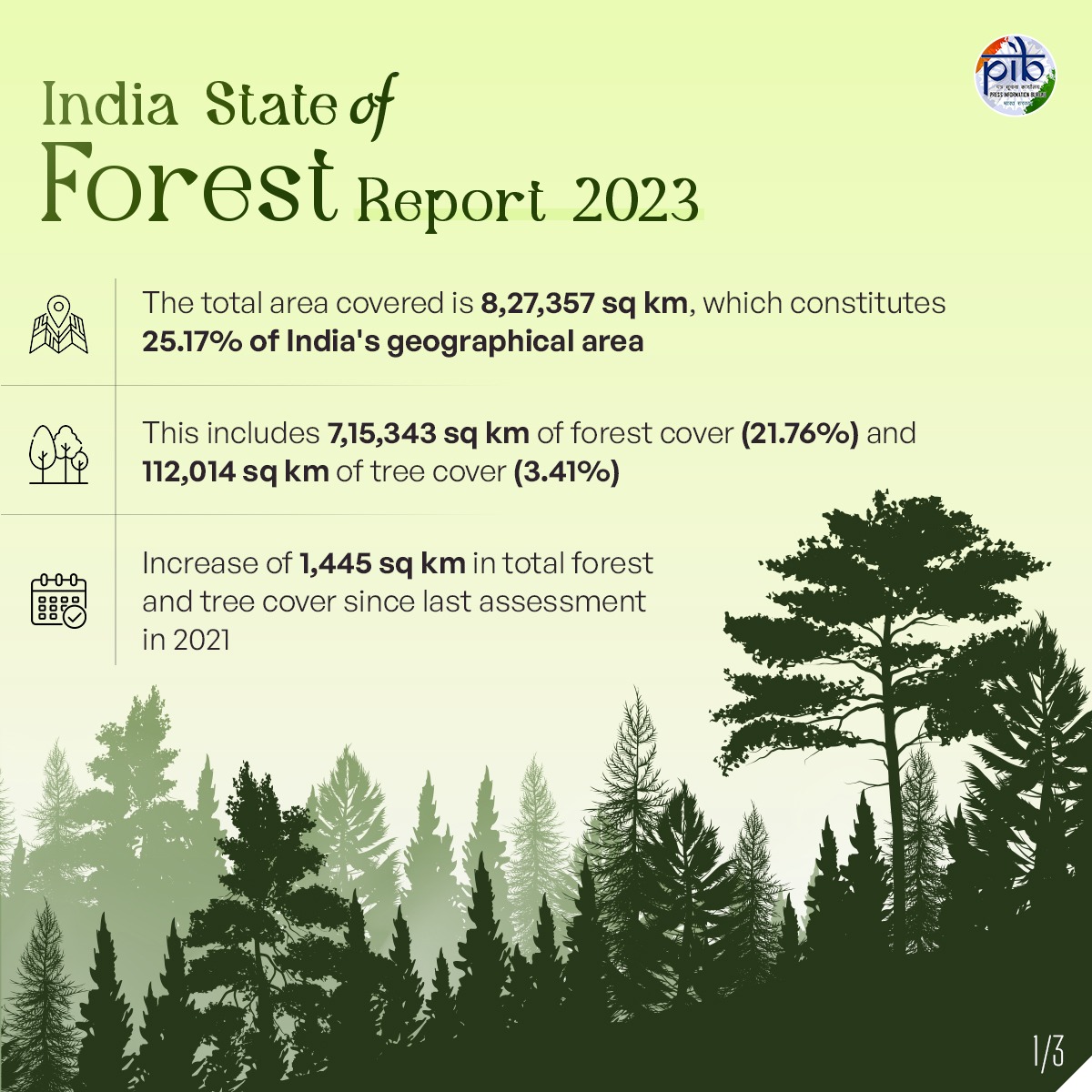
- 22 Dec 2024
In News:
The India State of Forest Report 2023 (ISFR 2023) was released by the Union Minister for Environment, Forest, and Climate Change at the Forest Research Institute in Dehradun. This biennial report, published by the Forest Survey of India (FSI), assesses the forest and tree resources of the country based on satellite data and field-based inventories. The ISFR 2023 is the 18th edition of this report, with the first published in 1987.
Key Findings
- Total Forest and Tree Cover:
- Area: 827,357 sq km (25.17% of India's geographical area)
- Breakdown:
- Forest cover: 715,343 sq km (21.76%)
- Tree cover: 112,014 sq km (3.41%)
- Increase from 2021: An increase of 1,445 sq km, including:
- Forest cover: +156 sq km
- Tree cover: +1,289 sq km
- State-wise Forest and Tree Cover:
- Top 3 States by Total Forest and Tree Cover Area:
- Madhya Pradesh (85,724 sq km)
- Arunachal Pradesh (67,083 sq km)
- Maharashtra (65,383 sq km)
- Top 3 States by Forest Cover:
- Madhya Pradesh (77,073 sq km)
- Arunachal Pradesh (65,882 sq km)
- Chhattisgarh (55,812 sq km)
- States with Maximum Increase in Forest and Tree Cover:
- Chhattisgarh, Uttar Pradesh, Odisha, and Rajasthan
- Mizoram, Gujarat, and Odisha showed the most significant increase in forest cover.
- Top 3 States by Total Forest and Tree Cover Area:
- Forest Cover Percentage (as a proportion of total geographical area):
- Lakshadweep: 91.33% (Highest)
- Mizoram: 85.34%
- Andaman & Nicobar Islands: 81.62%
- 19 States/UTs have over 33% forest cover, with 8 states having more than 75%.
- Mangrove Cover:
- Total Mangrove Cover: 4,992 sq km (a decrease of 7.43 sq km from 2021).
- Notable Changes: Gujarat saw the largest loss of mangroves, whereas Andhra Pradesh and Maharashtra reported increases.
- Carbon Stock and Climate Targets:
- Total Carbon Stock: 7,285.5 million tonnes (an increase of 81.5 million tonnes from the previous assessment).
- Nationally Determined Contributions (NDC):
- India’s carbon stock has reached 30.43 billion tonnes of CO2 equivalent.
- Achieved an additional 2.29 billion tonnes of carbon sink compared to the 2005 baseline, towards the 2030 target of 2.5-3.0 billion tonnes.
- Bamboo and Timber Production:
- Bamboo Bearing Area: Estimated at 154,670 sq km, an increase of 5,227 sq km since 2021.
- Timber Potential: Estimated annual potential production of 91.51 million cubic meters from trees outside forests.
Achievements:
- There has been a notable increase in the forest and tree cover, particularly in states like Chhattisgarh, Uttar Pradesh, Odisha, and Rajasthan.
- The carbon stock in forests has increased, helping India make significant progress in its climate change mitigation goals.
- The bamboo bearing area has also expanded, promoting biodiversity and economic benefits through bamboo cultivation.
Concerns:
- Mangrove Loss: Gujarat experienced a notable decrease in mangrove area, highlighting the need for focused conservation efforts in coastal regions.
Forest Survey of India (FSI) Overview
- Established: 1981, under the Ministry of Environment, Forest and Climate Change (MoEFCC).
- Mission: To assess, monitor, and research forest resources across India, providing data for sustainable management, national planning, and conservation.
- Headquarters: Dehradun, Uttarakhand.
72% Decline in Bird Species at Bordoibam-Bilmukh Bird Sanctuary, Assam
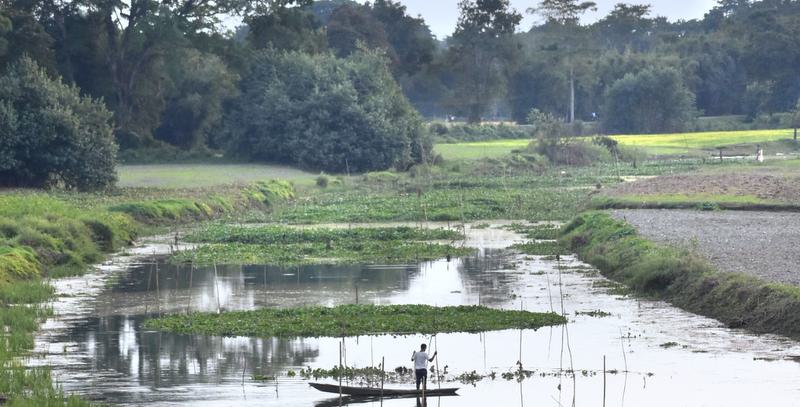
- 21 Dec 2024
In News:
A recent study has revealed a dramatic decline in the number of bird species at Assam's Bordoibam-Bilmukh Bird Sanctuary (BBBS). The sanctuary, once home to a rich diversity of avian species, has experienced a 72% decline in bird species over the past 27 years. The study, published in the Journal of Threatened Taxa, highlights the severe biodiversity crisis facing the sanctuary.
Key Findings:
- Bird Species Count Decline:
- In 1997, the sanctuary recorded 167 bird species.
- Recent surveys (2022-2024) have only recorded 47 species, marking a 71.85% decline in species count.
- Surveys:
- 2011 Survey: Recorded 133 species (86 resident, 23 migratory, 24 local migrants).
- 2017-2018 Survey: Found 120 species, along with a variety of other biodiversity, including macrophytes, fish, and aquatic ferns.
- Impact on Migratory Birds:
- Migratory species like Brown Shrike, Citrine Wagtail, and White Wagtail (winter migrants), and the Lesser Kestrel (summer migrant) were recorded recently.
- Main Causes of Decline:
- Anthropogenic Activities: Overfishing, poaching, excessive harvesting of aquatic plants, and egg collection.
- Land Use Changes: Habitat degradation due to agriculture, machinery noise, and land being used as pasture areas.
- Disruption of Food Chain: Habitat loss and changes in foraging and breeding grounds for both migratory and resident birds.
- Species of Concern:
- Poached Birds: Lesser whistling duck, Fulvous whistling duck, White-breasted waterhen, Indian pond heron, Eastern spotted dove, and Yellow-footed green pigeon.
- Threatened Species: The sanctuary is home to globally threatened species like the Spot-billed Pelican and Lesser Adjutant.
About Bordoibam-Bilmukh Bird Sanctuary:
- Location: Situated between Dhemaji and Lakhimpur districts in Assam, the sanctuary spans 11.25 sq. km at an altitude of 90-95 meters above sea level.
- History: Declared a wildlife sanctuary in 1996, it was originally part of the Subansiri River which has now shifted 7 km from the wetland.
- Climate & Vegetation:
- Moist tropical climate with an average annual rainfall of around 2,000 mm.
- The vegetation includes flooded valley grasslands and wetland plants, providing crucial habitat for migratory birds.
- Significance for Avian Species:
- Hosts a variety of migratory waterfowl, especially during the winter.
- Home to globally threatened bird species like the Spot-billed Pelican and Lesser Adjutant, along with resident birds such as the Indian Pond Heron and Fulvous Whistling Duck.
Conservation Efforts:
- The decline in bird species at the sanctuary has raised alarm about the degradation of wetland habitats.
- The study emphasizes that habitat loss can disrupt the food chain, water table, and nutrient cycle, which in turn harms both the ecosystem and human communities.
- The authors of the study advocate for intense conservation efforts to restore and protect the sanctuary’s biodiversity.
Assam's Biodiversity:
- Assam is one of India's most biodiverse states, with around 950 bird species, including 17 endemic species.
- The state also hosts 55 Important Bird and Biodiversity Areas (IBA), which are vital hotspots for avian species.
India's First-Ever Ganges River Dolphin Tagging in Assam
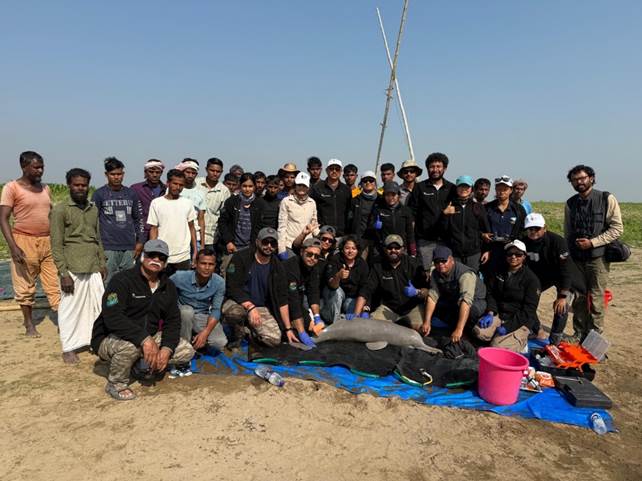
- 19 Dec 2024
In News:
India conducts the first-ever satellite tagging of the Ganges River Dolphin (Platanista gangetica) in Assam, a key step in wildlife conservation.
Key Highlights:
Objective of Tagging: The tagging aims to understand:
- Migratory patterns
- Range and distribution
- Habitat utilization, especially in fragmented river systems.
Key Participants:
- Ministry of Environment, Forest and Climate Change (MoEFCC)
- Wildlife Institute of India (WII)
- Assam Forest Department
- Aaranyak (NGO)
- Funded by the National CAMPA Authority.
Significance of the Tagging:
- Technology Used: Lightweight satellite tags compatible with Argos systems were employed, minimizing interference with the dolphin’s movement despite its limited surfacing time (5-30 seconds).
- Insight into Dolphin Ecology: Helps fill knowledge gaps regarding habitat needs and seasonal migration, especially in disturbed river ecosystems.
Ganges River Dolphin – India's National Aquatic Animal:
- Endemic to India with around 90% of the population in India.
- Known for being nearly blind and using echolocation for navigation and hunting.
- Plays a crucial role as an apex predator and indicator species for river ecosystem health.
Project Dolphin:
- Launched by PM Narendra Modi in 2020, modeled after Project Tiger.
- Focuses on conservation of riverine and marine dolphins.
- A 10-year initiative funded by MoEFCC to safeguard dolphin populations and address ecosystem challenges.
Conservation Status:
- IUCN: Endangered.
- Protection: Included in Schedule I of the Wildlife Protection Act (1972) and CITES Appendix I.
- Major Threats: Habitat degradation, pollution, bycatch, and water abstraction, compounded by damming and sand mining.
Broader Impact:
- The tagging initiative contributes to evidence-based conservation strategies for Ganges River Dolphins.
- Will aid in the development of a comprehensive conservation action plan for the species.
- Expands the understanding of critical habitats within river ecosystems, benefiting both biodiversity and the communities dependent on these resources.
National Wildlife Health Policy (NWHP)

- 19 Dec 2024
In News:
The Central Zoo Authority, under the aegis of the Ministry of Environment Forest and Climate Change (MoEF&CC) has taken up the development of the ‘National Wildlife Health Policy in consultative workshop held in Indira Prayavaran Bhawan, New Delhi.
Key Highlights:
- Organized by: Central Zoo Authority (CZA), under the Ministry of Environment, Forest and Climate Change (MoEF&CC).
- Event: Consultative workshop held at Indira Prayavaran Bhawan, New Delhi, on the development of the National Wildlife Health Policy (NWHP).
- Purpose: To address health threats to wildlife and integrate wildlife health management with public and animal health.
Goals of the National Wildlife Health Policy (NWHP):
- One Health Approach: Integrates human, animal, and environmental health, recognizing their interdependence.
- Focus Areas:
- Prevent and control zoonotic diseases.
- Improve disease surveillance and early detection, especially in protected areas.
- Promote biosecurity measures and epidemic preparedness.
- Enhance research and development in wildlife health management.
- Advocate for community awareness on wildlife health and conservation.
Key Features of the Policy:
- Wildlife Health Management Unit (WHMU): Proposed unit to oversee the policy's implementation.
- Collaboration: Involves coordination with various stakeholders including government ministries, NGOs, academic institutions, and veterinary universities.
- Disease Surveillance: Establish protocols for monitoring and controlling wildlife diseases, especially in protected areas.
- Capacity Building: Training programs for professionals involved in wildlife conservation and health management.
- Biosecurity Protocols: Strengthen measures to reduce disease transmission risks.
Supporting Institutions:
- GISE Hub, IIT Bombay and Office of the Principal Scientific Adviser to the Government of India are providing support in policy development.
Challenges Addressed:
- Wildlife in India faces various health challenges including:
- Infectious diseases (e.g., Canine Distemper Virus).
- Habitat loss and climate change impacts.
- Illegal wildlife trade and other anthropogenic pressures.
- India has over 91,000 wildlife species and more than 1,000 protected areas, making comprehensive health management crucial.
Expected Outcomes:
- Comprehensive Framework: A science-based framework for wildlife health, integrating ecological, human, and animal health.
- Disease Outbreak Response: Structured mechanisms for disease management, surveillance, and legal frameworks.
- Public Health Integration: Safeguard wildlife health, which directly impacts balanced ecosystems and biodiversity.
Policy’s Strategic Alignment:
- National Wildlife Action Plan (2017-31): The policy complements the action plan’s 103 conservation actions and 250 projects, including disease surveillance protocols in tiger reserves and other protected areas.
- Research & Development: Encourages the development of strategies to manage wildlife health and prevent disease outbreaks.
Wroughton’s Free-Tailed Bat
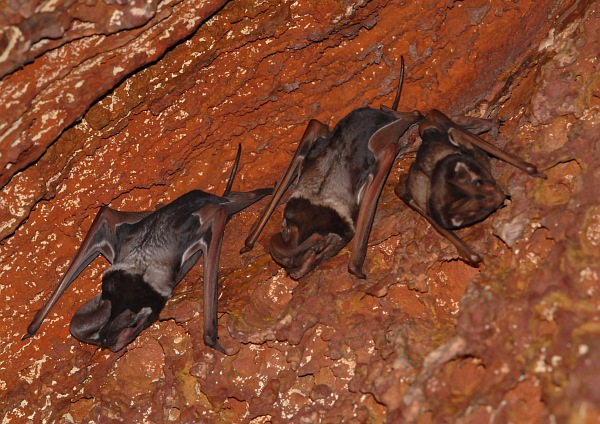
- 19 Dec 2024
In News:
Wroughton’s free-tailed bat, a highly rare species of molossus bat, has been spotted at the Delhi Development Authority (DDA)’s Yamuna Biodiversity Park, marking a unique sighting.
Key Highlights:
- Species Overview: Wroughton’s free-tailed bat (Otomops wroughtoni) is a rare species of molossus bat, notable for its powerful flight and ecological importance in controlling insect populations and assisting in pollination.
- Conservation Status:
- IUCN: Listed as "Data Deficient".
- Protection: Listed under Schedule I of the Wildlife (Protection) Act, 1972.
- Geographical Distribution:
- Primarily found in the Western Ghats, with a single known breeding colony.
- Small colonies in Jaintia Hills, Meghalaya, and a solitary individual sighted in Cambodia.
- Physical Characteristics:
- Large in size, with huge ears extending beyond the muzzle.
- Bicoloured velvet fur.
- Noted for powerful flying capabilities, enabling long-distance foraging.
- Ecological Role:
- Regulates insect populations.
- Known for assisting in pollination.
- Habitat:
- Roosts in caves, or dark, damp, and slightly warm places, typically in moderate-sized colonies.
- Significance of the Delhi Sighting:
- The sighting at Yamuna Biodiversity Park is significant for Delhi, marking a rare occurrence in the region.
- Delhi's bat species: The city is home to about 14 bat species, with four species, including the Indian false vampire and Egyptian free-tailed bat, considered locally extinct.
- Conservation Efforts:
- Two decades of ecological restoration have created specialized niches in the area, aiding species rewilding and ecological balance.
- The Aravalli Biodiversity Park in Gurugram now serves as the only known roosting site for the Blyth’s horseshoe bat in Delhi NCR.
- Additional Notes:
- Wroughton’s free-tailed bat was considered critically endangered until 2000 due to its limited known population. However, the discovery of populations in other regions has led to a reclassification to "Data Deficient".
- Despite being discovered over a century ago, much about the bat's feeding ecology remains unknown.
Little Bunting
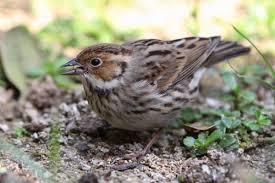
- 16 Dec 2024
In News:
Little Bunting recently spotted in Mount Abu, Rajasthan, a sighting previously unseen in the region.
About the Little Bunting:
- Scientific Name: Emberiza pusilla
- Family: Bunting family (Emberizidae)
- IUCN Red List Status: Least Concern
Distribution:
- Breeding Range: Far northeast Europe and northern Eurosiberia to the Russian Far East (taiga region).
- Migratory Pattern: Migrates to the subtropics during winter, with sightings in northern India, southern China, and northern Southeast Asia.
Physical Features:
- Size: Small bird, measuring 12–14 cm (4.7–5.5 inches).
- Coloration:
- White underparts with dark streaking on the breast and sides.
- Chestnut face with a white malar stripe, black crown stripes, and a white eye-ring.
- Fine dark border behind chestnut cheeks.
- Similarity: Resembles a small female reed bunting but with distinct black crown stripes.
Call and Song:
- Call: Distinctive "zik".
- Song: A rolling "siroo-sir-sir-siroo".
Habitat and Behavior:
- Typically found in agricultural areas, feeding on grains.
- Migration: Avoids extreme cold conditions, possibly due to climate change influencing its movement into Rajasthan.
Recent Sightings in India: Spotted in Gurugram, Chandigarh, northern Punjab, and now Rajasthan.
Conservation Significance: The sighting underscores the need to preserve forest areas and wetlands for migratory species like the Little Bunting.
Santa Ana Winds
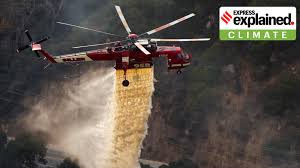
- 15 Dec 2024
In News:
The ongoing Franklin Fire in Malibu, California, has burned over 4,000 acres and affected around 22,000 people. Although the exact cause of the fire is still under investigation, experts point to two key factors contributing to the intensity of the blaze: Santa Ana winds and climate change.
Santa Ana Winds
- Santa Ana winds are powerful, dry winds that typically occur in Southern California from October to January.
- They are caused when high-pressure systems over the Great Basin (the area between the Rocky Mountains and Sierra Nevada) push air toward low-pressure areas over California’s coast.
- As the air moves downhill through mountain passes, it compresses and heats up, which significantly lowers the humidity—sometimes to levels below 10%—creating dry conditions. This extremely low moisture content dehydrates vegetation, making it highly susceptible to combustion.
- These winds have been a natural feature of California's weather, contributing to wildfires for years. However, when combined with other factors like climate change, their impact has become more severe.
The Role of Climate Change
While Santa Ana winds have long played a role in California's wildfires, climate change has exacerbated the situation in recent years. The state's wildfire season has lengthened due to rising global temperatures, which have led to:
- Warmer springs and summers.
- Earlier snowmelt in spring, which leaves vegetation drier for longer periods.
- Longer and more intense dry seasons, which cause increased moisture stress on vegetation.
As a result, forests and brushlands are now more vulnerable to fires. Climate change has also contributed to more extreme weather events, including heatwaves, which further dry out vegetation and create favorable conditions for wildfires.
Intensification of Wildfire Seasons
Recent studies have shown that California's wildfire season has grown longer over the past two decades. For example, a 2021 study in Nature Scientific Reports found that the state's annual burn season has shifted, with the peak fire season now occurring earlier in the year, from August to July. Additionally, research published in PNAS (Proceedings of the National Academy of Sciences) in 2023 indicated that the largest wildfires in California history have occurred in the past 20 years, with five of the top 10 largest fires taking place in 2020 alone.
Looking Ahead
The situation is expected to worsen as climate change continues. If global temperatures rise by more than 3°C by the end of the century, as predicted by the United Nations, California’s wildfire risk will likely intensify. The combination of Santa Ana winds and increasingly dry conditions will continue to make areas like Malibu, and much of California, more prone to destructive wildfires.
In conclusion, while Santa Ana winds remain a natural contributor to California's wildfires, the influence of climate change has significantly lengthened the wildfire season, making wildfires more frequent, intense, and harder to control. The continued rise in global temperatures only accelerates these trends, posing a growing challenge for fire management and public safety in California.
International Mountain Day 2024
- 13 Dec 2024
In News:
On 11th December 2024, the Ministry of Environment, Forest and Climate Change, in collaboration with the International Union for Conservation of Nature (IUCN) and G.B. Pant National Institute of Himalayan Environment (NIHE), hosted an event titled ‘Youth for the Himalaya: Innovate, Inspire, Impact’ to mark International Mountain Day.
Event Overview:
- The event was themed “Mountain Solutions for a Sustainable Future – Innovation, Adaptation, and Youth.”
- It emphasized the critical role of young people in addressing the environmental challenges faced by the Indian Himalayan Region (IHR).
- The aim was to showcase youth-driven innovations contributing to the region's sustainability, catalyzing active youth participation in environmental actions. This initiative aligns with the Mission LiFE (Lifestyle for Environment), launched by Prime Minister Narendra Modi, which encourages sustainable practices and collective environmental responsibility.
Key Highlights:
- Young changemakers, innovators, and stakeholders from across the country participated, including students, youth representatives, and members of the private sector, civil society, and government.
- The event highlighted discussions on sustainable solutions for the Himalayan region, integrating traditional knowledge with modern technological advancements in areas like eco-tourism, biodiversity conservation, and climate resilience.
- Short films and videos produced by NIHE and IUCN, such as "Promoting Conservation of Threatened Plant Species in the Western Himalayas" and "Himalayan Futures: Voices from the Ground," were also showcased.
International Mountain Day
- International Mountain Day, observed every year on December 11th since 2003, was established by the United Nations to raise awareness about the sustainable development of mountain regions.
- Mountains cover about one-fifth of the Earth's surface and provide essential freshwater to half of humanity, supporting agriculture, clean energy, and health.
Indian Himalayan Region (IHR)
- The IHR spans 13 Indian states and union territories, stretching approximately 2,500 kilometers from west to east. It is a biodiversity hotspot with significant ecological and cultural value. However, it faces challenges such as unsustainable development, climate change impacts, cultural erosion, and rising tourism.
Key Concerns for IHR:
- Unsustainable Development: Infrastructure projects and deforestation disrupt ecosystems.
- Climate Change: Glacial melting and rising temperatures affect water resources and increase flood risks.
- Cultural Erosion: Modernization threatens traditional practices of indigenous communities.
- Tourism Pressure: Waste generation due to growing tourism puts immense pressure on the region's fragile ecology.
Measures for Protection:
- Sustainable Tourism: Promoting eco-tourism and enforcing capacity limits to minimize environmental impact.
- Water Management: Capturing glacial meltwater for agriculture and ecosystem support.
- Disaster Preparedness: Developing disaster management strategies and early warning systems for events like landslides and floods.
- Bio-Cultural Conservation: Protecting both natural biodiversity and indigenous cultural practices through designated zones.
- Integrated Development: Establishing a "Himalayan Authority" for coordinated development in line with Sustainable Development Goals.
Champions of the Earth Award

- 11 Dec 2024
In News:
- Madhav Gadgil, an Indian ecologist, received the UN Environment Programme (UNEP)'s Champions of the Earth Award in 2024.
- The Champions of the Earth Award is UNEP’s highest environmental honor, recognizing individuals, organizations, and governments for significant contributions to environmental protection and sustainable development.
Contributions of Madhav Gadgil:
- Work in Western Ghats:
- Gadgil is recognized for his seminal work in the Western Ghats, an ecologically sensitive region in India, which is a global biodiversity hotspot.
- He chaired the Western Ghats Ecology Expert Panel (WGEEP), formed by the Indian government to assess the impacts of population pressure, climate change, and development on the region.
- Recommendations by WGEEP:
- Ecologically Sensitive Area (ESA): Recommended declaring the entire Western Ghats range as an ESA.
- The WGEEP suggested dividing the Western Ghats into three Ecologically Sensitive Zones (ESZ) based on environmental sensitivity.
- Development Restrictions: Proposed a ban on activities like mining, quarrying, thermal power plants, and large-scale hydropower projects in the most sensitive zones (ESZ-1).
- Governance Recommendations: Suggested a bottom-to-top governance approach, beginning with Gram Sabhas, and the creation of a Western Ghats Ecology Authority (WGEA) for effective management.
- Impact of Gadgil’s Work:
- His research and recommendations have played a crucial role in shaping environmental policy and public opinion in India.
- The UNESCO World Heritage status for the Western Ghats in 2012 was a significant step in global recognition of the region’s ecological importance.
About the Champions of the Earth Award:
- History & Significance:
- Established in 2005, the award recognizes trailblazers working towards addressing the triple planetary crisis: climate change, biodiversity loss, and pollution.
- Since its inception, it has honored 122 laureates who have shown outstanding leadership in environmental conservation.
- 2024 Awardees:
- Madhav Gadgil (India) – for his work on the Western Ghats.
- Sonia Guajajara (Brazil) – for advocacy for Indigenous rights and environmental protection.
- Amy Bowers Cordalis (USA) – for her work in Indigenous rights and ecosystem restoration.
- Gabriel Paun (Romania) – for defending Europe’s old growth forests from illegal logging.
- Lu Qi (China) – for contributions to afforestation and combating desertification.
- SEKEM (Egypt) – for advancing sustainable agriculture.
Key Facts about UNEP:
- UN Environment Programme (UNEP):
- Established in 1972, UNEP is a leading global authority on environmental issues.
- UNEP aims to address climate change, nature and biodiversity loss, and pollution through scientific research, policy support, and public advocacy.
- UNEP is headquartered in Nairobi, Kenya and works closely with 193 Member States to tackle the planet’s most pressing environmental challenges.
Markhor Spotted in North Kashmir's Baramulla
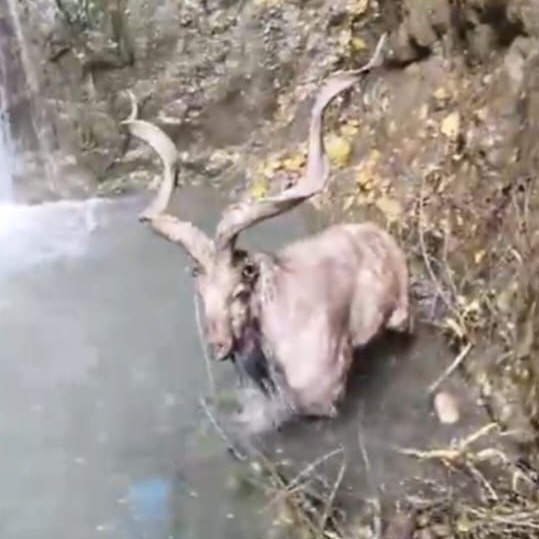
- 08 Dec 2024
In News:
Recently, a Markhor, a rare wild goat with spiral-shaped horns, was spotted in Noorkha village of Boniyar in Baramulla district, North Kashmir.The animal was seen near a waterfall in Noorkha, prompting locals to alert the authorities.
Key Highlights:
- The Markhor (Capra falconeri) is a large, wild goat species native to mountainous regions in Central and South Asia, including countries such as Pakistan, Afghanistan, India, and others.
- The species is considered endangered and is listed under Schedule I of the Wildlife Protection Act, 1972.
- The Markhor population in India is concentrated in areas like Shopian, Banihal Pass, Shamsbari, and Kazinag in Jammu and Kashmir.An estimated 300 Markhors live in Kashmir's dense pine and birch forests.
- Threats and Conservation Status:
- The Markhor faces threats due to human activities and natural factors, leading to a decline in its population.
- It is classified as 'Near Threatened' on the IUCN Red List and protected under the Indian Wildlife Protection Act and the Jammu and Kashmir Wildlife Protection Act.
- Significance of the Sighting:The sighting of the Markhor has excited both villagers and wildlife enthusiasts, as these animals are not typically found outside their natural habitats, particularly near human settlements.
Community and Individual Forest Rights in Anamalai Tiger Reserve (ATR)
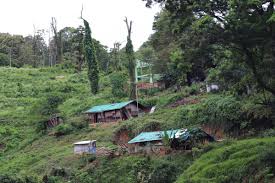
- 08 Dec 2024
In News:
- The Coimbatore District Collector, granted community and individual forest rights under the Forest Rights Act, 2006, to tribal settlements in the Anamalai Tiger Reserve (ATR) on December 6, 2024.These rights were handed over to three tribal settlements and 14 families at a function in Coimbatore.
Key Highlights:
- Community Forest Rights:
- Three tribal settlements in ATR—Nagaroothu I, Nagaroothu II, and Chinnarpathi—were granted community rights.
- These rights allow the settlements to collect forest produce excluding timber, such as mango, amla, honey, tamarind, and grass for making brooms.
- Individual Forest Rights:
- Individual rights were granted to 14 families from the Old Sarkarpathy tribal settlement.
- The families had requested these rights for traditional cultivation practices passed down by their ancestors.
- The individual rights were approved after the recommendation of a sub-divisional committee and scrutiny by a district-level committee.
- About the Forest Rights Act (FRA), 2006:
- Purpose: The FRA was enacted to address historical injustices faced by forest-dwelling communities and ensure their livelihood and food security.
- Key Provisions:
- Individual Rights: Self-cultivation, habitation, and in-situ rehabilitation.
- Community Rights: Access to grazing, fishing, water bodies in forests, and protection of traditional knowledge and customary rights.
- Eligibility: Rights can be claimed by any community or individual who has lived in the forest for at least three generations (75 years) before December 13, 2005.
- Critical Wildlife Habitats: The Act mandates that critical wildlife habitats in national parks and sanctuaries remain inviolate for wildlife conservation.
- Authorities Involved in Vesting Forest Rights:
- Gram Sabha: Initiates the process for determining the nature and extent of rights.
- Sub-Divisional Level Committee: Examines resolutions passed by the Gram Sabha.
- District Level Committee: Grants final approval for forest rights.
- Challenges with Forest Rights Implementation:
- The Xaxa Committee pointed out several challenges in the implementation of the FRA, such as:
- Arbitrary rejection of claims.
- Lack of deadlines for claims processing.
- Unaddressed rights of communities displaced by development projects.
- The Xaxa Committee pointed out several challenges in the implementation of the FRA, such as:
- About Anamalai Tiger Reserve:
- Located in the Anamalai Hills of Pollachi and Coimbatore District, Tamil Nadu, at an altitude of 1,400 meters.
- Established as a tiger reserve in 2007, it is surrounded by multiple protected areas like the Parambikulam Tiger Reserve, Chinnar Wildlife Sanctuary, and Eravikulam National Park.
- Biodiversity in Anamalai Tiger Reserve:
- Habitats: The reserve contains wet evergreen forests, semi-evergreen forests, moist deciduous forests, dry deciduous forests, and unique habitats like montane grasslands and marshy grasslands.
- Flora: The reserve is home to around 2,500 species of angiosperms, including species like balsam, orchids, and wild relatives of cultivated crops such as mango, jackfruit, cardamom, and pepper.
- Fauna: It supports various wildlife species, including tigers, Asiatic elephants, sambars, spotted deer, leopards, jackals, and jungle cats.
Sacred Groves

- 08 Dec 2024
In News:
Preserving India’s sacred groves can help country achieve its conservation & climate goals.
Sacred Groves in India:
- Sacred groves are forest patches that are culturally and spiritually important for various communities.
- They are known by different names across India: sarnas in Jharkhand, devgudis in Chhattisgarh, and orans in Rajasthan.
- Groves vary in size from small clusters of trees to expansive forests covering several acres.
Threats to Sacred Groves:
- Sacred groves are increasingly under threat due to deforestation, mining, and development activities.
- Many sacred groves are being displaced or degraded, putting biodiversity and cultural practices at risk.
Ecological and Cultural Importance:
- Sacred groves are rich in biodiversity and serve as important carbon sinks, contributing to climate change mitigation.
- They have been maintained by indigenous communities for centuries, creating a deep connection between people and nature.
- Sacred groves also play a crucial role in preserving indigenous spiritual practices and cultural heritage.
Contribution to Climate and Conservation Goals:
- India’s climate commitment of achieving net-zero emissions by 2070 requires the protection of forests, including sacred groves.
- Sacred groves, when properly managed, can help in carbon sequestration and climate change mitigation.
- Preserving these groves can support forest conservation and foster coexistence with wildlife, ensuring a balance between development and environmental preservation.
Role of Indigenous Communities:
- Indigenous communities have long used sacred groves to regulate the use of forest resources and ensure environmental sustainability.
- Before modern ecological concepts, sacred groves were seen as natural conservation practices guided by spiritual beliefs.
- This traditional wisdom can be leveraged to enhance conservation efforts in India.
Examples of Successful Sacred Grove Conservation:
- Waghoba Grove in Maharashtra:
- Located in Chinchwadi village, the Taata chi Vanrai grove is dedicated to Waghoba, the tiger deity, and covers eight acres.
- Local communities, including the Thakars, have successfully resisted illegal timber extraction and helped conserve the grove, witnessing the return of wildlife like leopards.
- Worship of Waghoba has played a significant role in preserving forest patches and fostering human-animal coexistence.
- Tadoba-Andhari Tiger Reserve:
- Sacred groves around the Tadoba Reserve, dedicated to Waghoba, are important in reducing human-wildlife conflicts by promoting spiritual ties with the forest.
Government and Community Efforts:
- The Jharkhand government introduced the concept of gherabandi (boundary walls) in 2019 to conserve sacred groves.
- In Chhattisgarh, the renovation of sacred groves has been undertaken to protect and restore these areas.
- Despite these efforts, challenges remain in involving local communities and integrating sacred groves into broader conservation policies.
The Role of OECMs in Sacred Grove Conservation:
- Sacred groves are considered part of Other Effective Area-Based Conservation Measures (OECMs), which are areas conserved for biodiversity outside protected regions.
- OECMs recognize the cultural, spiritual, and socio-economic value of these areas and promote sustainable conservation practices that benefit both biodiversity and local communities.
- Sacred groves play an essential role in achieving long-term biodiversity conservation and ecosystem services.
World’s Oldest Wild Bird Lays Egg at 74 in Hawaii
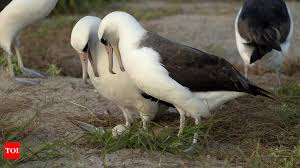
- 08 Dec 2024
In News:
Wisdom, the world’s oldest known wild bird, a Laysan albatross, has laid her estimated 60th egg at the age of 74. This remarkable event occurred at the Midway Atoll National Wildlife Refuge in the Pacific Ocean, part of the Hawaiian Archipelago.
Background on Wisdom and Laysan Albatrosses
Wisdom, first banded as an adult in 1956, has been a part of the albatross population in the Pacific for decades. Laysan albatrosses are known for their strong migratory habits and lifelong pair bonding.
The Life Cycle of the Laysan Albatross
The egg incubation process for Laysan albatrosses is shared between both parents and lasts around seven months. Once the chick hatches, it takes five to six months to develop before it is ready to take its first flight over the ocean. These seabirds, which predominantly feed on squid and fish eggs, spend the majority of their lives soaring across the open seas.
Wisdom’s longevity and success in raising up to 30 chicks over her lifetime have been notable achievements. While Laysan albatrosses typically live up to 68 years, Wisdom’s age surpasses this average by several years.
About the Laysan Albatross
The Laysan albatross (Phoebastriaimmutabilis) is a large seabird found across the North Pacific. The Northwestern Hawaiian Islands host nearly the entire population of Laysan albatrosses, with most breeding pairs found on islands like Laysan and Midway Atoll. These birds are known for their long-distance soaring capabilities, with some covering hundreds of miles a day without flapping their wings.
Laysan albatrosses have blackish-brown upper wings and backs, with flashes of white in their primary feathers. They are monogamous, forming lifelong bonds with a single mate. Despite their impressive flying ability and vast range, their population is currently listed as "Near Threatened" by the International Union for Conservation of Nature (IUCN).
Overview of Global Plastic Treaty Negotiations

- 05 Dec 2024
In News:
The recent negotiations for a global treaty aimed at curbing plastic pollution, held in Busan, South Korea, concluded without reaching a legally binding agreement. This marked the fifth round of discussions since the United Nations Environment Assembly (UNEA) initiated the process in March 2022, with the goal of finalizing a treaty by the end of 2024. The failure to adopt a treaty was primarily due to disagreements over production cap goals and the elimination of specific plastic chemicals and products.
Key Points of Dispute
- Production Cap Goals: A coalition of over 100 countries, including many from Africa, Latin America, and the European Union, pushed for clear production cap goals in the treaty. They argued that such measures are essential for effective regulation of plastic pollution.
- Opposition from Oil-Producing Nations: Conversely, a group of “like-minded countries” such as Saudi Arabia, Kuwait, Russia, and Iran opposed these provisions. They contended that regulating production cuts exceeded the original mandate set by UNEA and could lead to trade restrictions disguised as environmental measures. India and China aligned with this coalition, emphasizing their concerns regarding economic impacts.
Draft Treaty Highlights
Despite the failure to finalize an agreement, discussions produced a draft text that included both consensus points and contentious issues:
- Consensus Points:
- Proposals for banning open dumping and burning of plastics.
- Definitions for various plastic types were suggested but lacked clarity on contentious terms like microplastics.
- Contentious Issues:
-
- The draft did not adequately address definitions for microplastics or recycling standards.
- References to single-use plastics were included but faced pushback from certain nations.
India’s Position
India articulated its stance focusing on several key areas:
- Development Rights: Emphasized the need for recognizing varying responsibilities among countries in managing plastic pollution while considering their developmental rights.
- Technical and Financial Support: Advocated for provisions ensuring technical assistance and financial support for developing nations to manage plastic waste effectively.
- Opposition to Production Caps: India opposed any articles that would impose caps on polymer production, arguing that such measures were not directly linked to reducing plastic pollution.
Future Steps
The negotiations will continue with plans to reconvene in 2025. In the meantime, global plastic production is projected to rise significantly, potentially tripling by 2050 if no urgent action is taken. The ongoing dialogue will need to address both environmental concerns and developmental needs to create a balanced approach toward managing plastic pollution globally.
Global Context and Initiatives
The need for a global treaty is underscored by alarming statistics:
- Over 462 million tons of plastic are produced annually, with a significant portion contributing to pollution.
- Microplastics have infiltrated ecosystems worldwide, affecting biodiversity and human health.
Countries like Rwanda and Austria have implemented successful measures to reduce plastic waste, serving as models for global efforts. Initiatives such as the UNDP Plastic Waste Management Program in India aim to enhance waste management practices while addressing environmental impacts.
ICJ Hearing on Landmark Climate Change Case

- 04 Dec 2024
In News:
- The International Court of Justice (ICJ) has begun hearings on a landmark climate change case, seeking an advisory opinion on the obligations of countries under international law regarding climate change.
- The case stems from a UN General Assembly (UNGA) resolution initiated by Vanuatu in March 2023, co-sponsored by 132 countries.
Background:
- Vanuatu, a small island nation, faces existential threats from rising sea levels.
- The resolution was passed to clarify climate obligations in light of international laws, including the UNFCCC, Paris Agreement, and other legal instruments like the UN Convention on the Law of the Seas, and the Universal Declaration on Human Rights.
Global Impact of the Case:
- The outcome of the case could influence global climate governance, particularly in the context of climate negotiations.
- It may broaden the legal basis for climate obligations and underscore the legal consequences for non-compliance.
India’s Position:
- India has voiced concerns about the judicial process being the best approach to tackle climate issues, advocating for diplomatic efforts.
- India is scheduled to make its submission on December 5, highlighting its preference for a collaborative, non-top-down approach in climate discussions.
Implications for Developed and Developing Countries:
- The case highlights the historical responsibility of developed countries for climate change due to their higher emissions.
- The ICJ's advisory opinion could reinforce the argument that developed countries' obligations extend beyond the UNFCCC and Paris Agreement, incorporating broader international legal frameworks.
Climate Litigation and Precedent:
- The ICJ ruling could set a precedent for climate litigation, potentially influencing over 2,600 ongoing climate lawsuits globally.
- Notable rulings include the European Court of Human Rights, which held Switzerland accountable for failing to meet emissions targets, and India's Supreme Court recognizing the right to be free from adverse climate impacts in 2023.
Record Participation and Importance of the Case:
- The ICJ has received over 90 written submissions, with 97 countries and 12 international organizations participating in the hearings.
- The case is significant for the growing number of climate-related lawsuits and the evolving nature of international climate law.
Future Prospects:
- The ICJ’s advisory opinion, though non-binding, could significantly impact future climate negotiations, particularly in terms of responsibility sharing and climate finance.
- The outcome could also influence calls for compensation for climate damages, especially from vulnerable states like small island nations.
Madhya Pradesh’s 8th Tiger Reserve: Ratapani
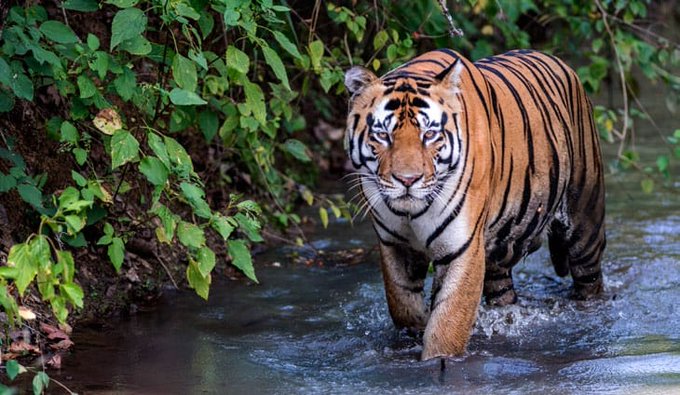
- 03 Dec 2024
In News:
Recently, the Ratapani Wildlife Sanctuary in Madhya Pradesh was officially declared a Tiger Reserve, making it the 8th such reserve in the state. This declaration follows approval from the Ministry of Environment, Forest and Climate Change through the National Tiger Conservation Authority (NTCA).
Key Details:
- Core Area: 763.8 sq. km
- Buffer Area: 507.6 sq. km
- Total Area: 1,271.4 sq. km
- Ratapani Tiger Reserve is located in the Raisen and Sehore districts, within the Vindhya hills, and is home to approximately 90 tigers.
- It also forms a crucial part of Madhya Pradesh’s tiger habitat and serves as a migration corridor from the Satpura ranges.
Economic and Ecotourism Benefits:
- The designation will boost ecotourism, generating employment and improving livelihoods for local communities.
- Eco-development programs will support residents, providing new opportunities and addressing the balance between conservation and human interests.
Wildlife Conservation and Management:
- The reserve will focus on habitat management, wildlife protection, and community engagement.
- The core area has been recognized as a critical tiger habitat under the Wildlife Protection Act, 1972.
- Efforts will include strengthening anti-poaching measures, improving surveillance, and enhancing prey base restoration.
Significance for Madhya Pradesh:
- This move places Madhya Pradesh as the "Tiger State of India", with significant conservation focus on the Ratapani and Madhav National Park (also in the process of becoming a tiger reserve).
- Madhya Pradesh now hosts 8 tiger reserves, contributing significantly to the country's overall tiger conservation efforts.
Global Matchmaking Platform (GMP)
- 28 Nov 2024
In News:
- GMP was launched at COP29, on Energy Day, by the United Nations Industrial Development Organization (UNIDO) and the Climate Club.
- Aimed at accelerating industrial decarbonisation in heavy-emitting industries of emerging and developing economies (EMDEs).
- The platform addresses the annual funding gap of US$125 billion required to achieve net-zero emissions goals.
Key Highlights:
Support Mechanism:
- GMP operates as a support mechanism for the Climate Club, with the secretariat hosted by UNIDO.
- Activities are supported by the interim secretariat of the OECD and the International Energy Agency (IEA).
Key Objectives:
- Match country-specific decarbonisation needs with global technical and financial resources.
- Facilitate the decarbonisation of energy and emissions-intensive industrial sectors, such as steel, cement, chemicals, and aluminium.
- Offer assistance in policy development, technology transfer, and investment facilitation to promote low-carbon industrial practices.
Global Participation:
- Countries like Germany, Chile, Uruguay, Turkey, Bangladesh, and Indonesia are actively involved.
- Non-state actors include UNIDO, World Bank, Climate Investment Funds (CIF), and GIZ, supporting the platform’s initiatives.
Funding Gap:
- Industrial decarbonisation requires an increase in investments from US$15 billion (current) to US$70 billion by 2030, and US$125 billion by 2050, especially for sectors like steel and cement.
Climate Club Work Programme (2025-26):
- The GMP is part of the Climate Club's new work programme for 2025-26, focusing on:
- Advancing ambitious climate change mitigation policies.
- Transforming industries through decarbonisation.
- Boosting international climate cooperation.
Industrial Decarbonisation:
- Decarbonisation refers to reducing carbon dioxide (CO2) and greenhouse gas (GHG) emissions from industrial activities.
- Key sectors for decarbonisation include petroleum refining, chemical manufacturing, iron and steel, cement production, and the food and beverage sector.
Support for EMDEs:
- The platform focuses on helping emerging and developing economies overcome challenges such as lack of resources, technology, and capacity to adopt cleaner industrial methods.
- Climate finance is crucial to pilot and scale low-carbon technologies in these regions.
Future Role of GMP:
- The GMP will play a critical role in incorporating industrial decarbonisation into countries’ Nationally Determined Contributions (NDCs) for COP30.
- The platform aims to accelerate progress by connecting developing countries with finance, technology, and expertise to transition to low-emission industries.
Palparescontrarius
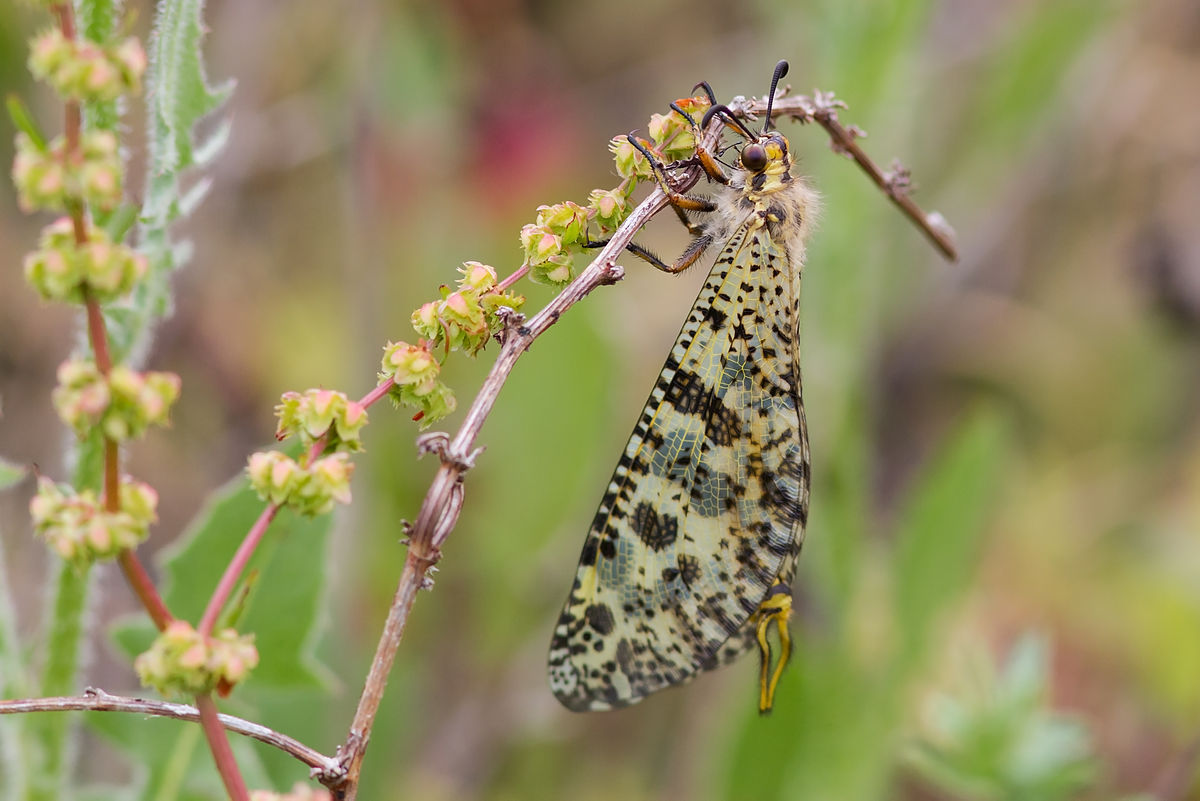
- 25 Nov 2024
In News:
Palparescontrarius is a species of antlion that was recently spotted for the first time in Tamil Nadu, on the Madras Christian College (MCC) campus. It is notable for being a large-sized adult antlion that resembles a dragonfly but has distinct characteristics that separate it from dragonflies, such as its clubbed antennae and fluttering flight.
Key Features of Palparescontrarius:
- Appearance:
- The adult Palparescontrarius is large and resembles a dragonfly in its general body structure.
- It has lacy wings, long clubbed antennae, and a slender, grayish body.
- Its wings are typically clear, although some species of antlions have spots on their wings.
- Flight and Behavior:
- Unlike dragonflies, Palparescontrarius has a distinct fluttering flight.
- It is a weak flier and can often be spotted at night near illuminated spots.
- Habitat and Lifestyle:
- Like other antlions, Palparescontrarius is found in dry, sandy regions and is mostly active at night.
- The larvae of this species are particularly known for their predatory behavior, as they trap ants and other small insects in cone-shaped pits they dig into the sand.
- Ecological Importance:
- Antlions, including Palparescontrarius, are harmless to humans and beneficial to the environment because they feed on ants and other insects, thus helping to control pest populations.
Imperial Eagle(Aquila heliaca)
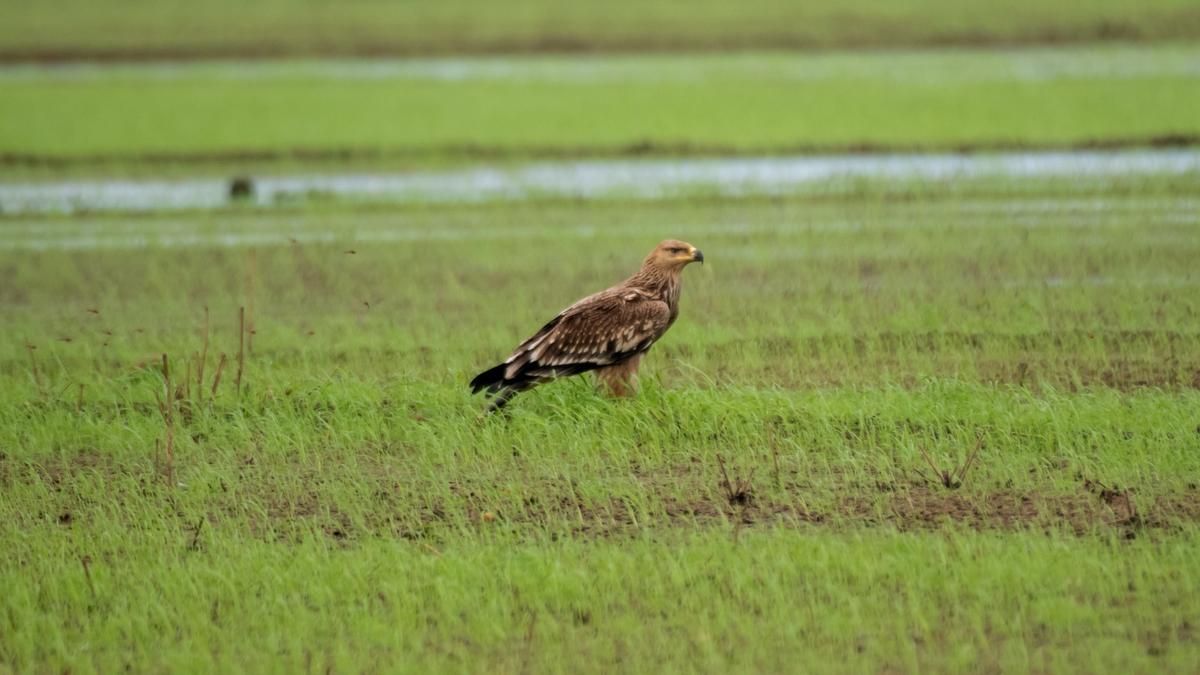
- 24 Nov 2024
In News:
- A rare Imperial Eagle (Aquila heliaca) was spotted in the PulluzhiKole wetlands. This marks a significant event as the species was last reported in Kannur in 2003.
Key Highlights:
- Habitat and Migration:
- The Imperial Eagle primarily breeds in southeastern Europe, west, and central Asia.
- During the winter months, it migrates to regions including northeastern Africa, West Asia, and parts of Southeast Asia.
- Conservation Status:The IUCN Red List lists the Imperial Eagle as a vulnerable species, indicating its potential risk of extinction, underscoring the need for its conservation efforts.
- Importance of Conservation:
- The Kole fields are a Ramsar-protected area, emphasizing their critical role in preserving migratory bird habitats.
- Ongoing conservation and observation efforts in these wetlands are essential for protecting the diverse bird species that use the area.
Features of the Imperial Eagle:
- Scientific Name: Aquila heliaca
- Physical Characteristics:
- Size: Length ranges from 68 to 90 cm, with a wingspan between 1.76 to 2.2 meters.
- Color: It has a pale golden crown and nape, with a grey base extending to the tail. Its wings feature prominent white "braces" on the scapulars.
- Sexual Dimorphism: Males are typically smaller than females.
- Habitat: Prefers old forests, mountainous regions, and riverside forests.
- Feeding: It has strong legs and curved talons for capturing and killing prey, and exceptional eyesight to spot prey from high altitudes.
- Conservation Efforts: Continued monitoring and protection of the Kole wetlands and other vital habitats are crucial for the survival of this vulnerable species and other at-risk birds.
Minke Whale
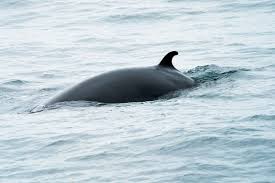
- 24 Nov 2024
In News:
Scientists have directly measured the hearing range of minke whales for the first time, finding that they can detect high-frequency sounds up to 90 kHz.
Key Highlights:
- Implication for Ocean Noise: The study suggests that baleen whales, including minke whales, may be more affected by anthropogenic ocean noise (e.g., naval sonar) than previously recognized, as their hearing range had been underestimated.
- Research Method: A novel catch-and-release technique was used to temporarily hold adolescent minke whales in Norway for auditory evoked potential (AEP) tests to measure their hearing sensitivity.
- Findings: Contrary to the belief that baleen whales are low-frequency specialists, minke whales can detect frequencies between 45 kHz to 90 kHz.
- Impact of Findings: The results could affect future regulations on ocean noise and its impact on marine mammals, as better hearing data is now available for baleen whales.
Minke Whale Overview:
- Family: Minke whales are members of the baleen or "great" whale family and are the smallest of the rorquals.
- Species: There are two recognized species:
- Common minke whale (Balaenoptera acutorostrata), found in various ocean basins.
- Antarctic minke whale (B. bonaerensis), found in the Southern Hemisphere.
- Subspecies:
- Dwarf minke whale: An unnamed subspecies of the common minke whale, mostly in the Southern Hemisphere.
- North Atlantic (B. a. acutorostrata) and North Pacific (B. a. scammoni) subspecies of common minke whales.
- Distribution: Minke whales are widely spread across tropical, temperate, and polar regions (65°S to 80°N), with common minke whales in all ocean basins and dwarf minke whales mostly in the Southern Hemisphere.
- Feeding Areas: They feed in cooler waters at higher latitudes and can be found both inshore and offshore.
- Conservation Status (IUCN):
- Common minke whale: Least Concern.
- Antarctic minke whale: Data Deficient.
Cicada
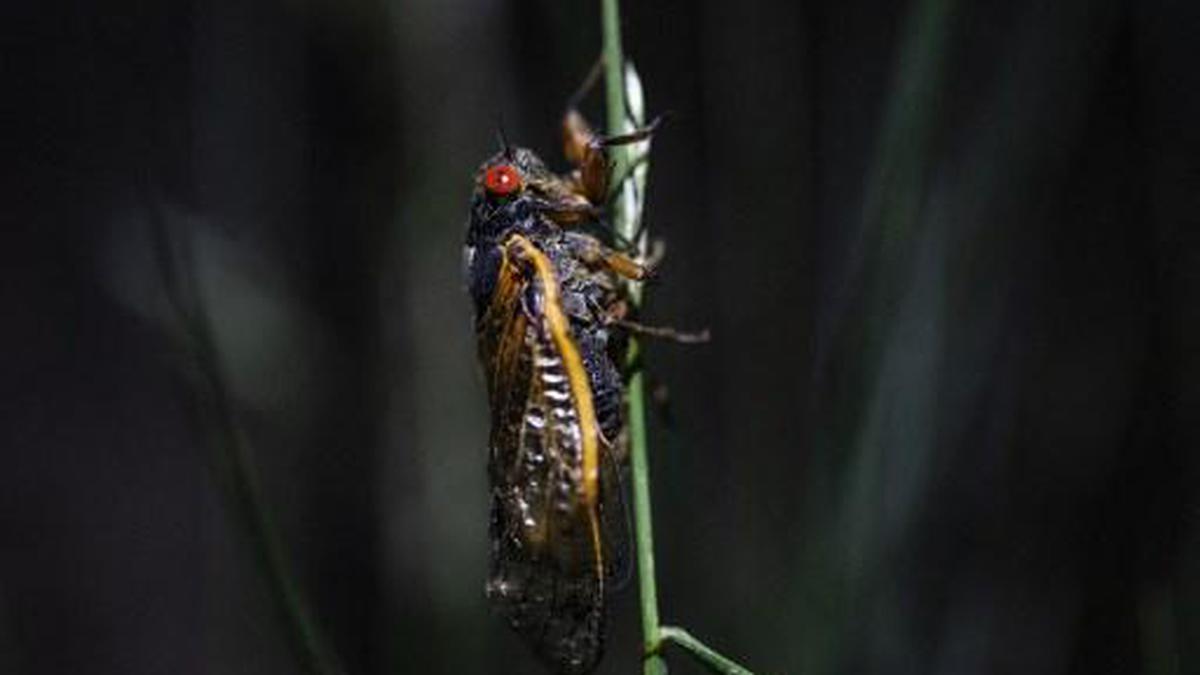
- 23 Nov 2024
In News:
North American cicadas have life cycles that last for prime numbers of years, putting pressure on the idea that humans created mathematics.
What are Cicadas?
- Classification: Cicadas are insects that belong to the order Hemiptera and the superfamily Cicadoidea.
- Physical Features: Hemipteran insects (also known as true bugs) have piercing-sucking mouthparts and two pairs of wings.
- Life Span: Cicadas spend the majority of their life underground, feeding on plant sap. Once they emerge from the soil, they have a short adult life span of about 2 to 4 weeks.
Habitat:
- Preferred Environment: Cicadas are typically found in natural forests with large trees and are considered canopy dwellers.
- Global Distribution: Cicadas are found on every continent except Antarctica. The highest genetic diversity of cicadas is found in India and Bangladesh, followed by China.
Cicada Emergence and Life Cycle:
- Life Cycle: Cicadas have a complex life cycle, involving long periods of underground development followed by brief adult emergence.
- Periodical Cicadas: There are species of cicadas that emerge in 13-year and 17-year cycles.
- Broods: Initially, 30 broods were categorized based on geography and emergence times, but currently, only about 15 broods remain active due to some broods becoming extinct.
- Unique Phenomenon: In April 2024, a rare event is expected where a trillion cicadas from two different broods will emerge simultaneously in the Midwest and Southeast regions of the United States.
Cicada's underground Development:
- Feeding on Sap: During their underground phase, cicadas feed on the sap of plants.
- Purpose of Long Development: Researchers believe the long development period helps cicadas evade above-ground predators by keeping them hidden in the soil.
Vulnerability after Emergence:
- Emergence Behavior: Once cicadas emerge, they construct a "cicada hut" to shed their nymphal skins, then climb onto nearby trees or vegetation.
- Predator Vulnerability: Adult cicadas are vulnerable to predators such as turtles and other forest creatures because they are clumsy and defenseless, making them easy prey for predators.
Significance of the 2024 Emergence:
- The coinciding emergence of cicadas from different broods (13-year and 17-year cycles) is a rare event that highlights the complexity and mathematical precision behind the cicada life cycle.
Rare Leucistic Peacock
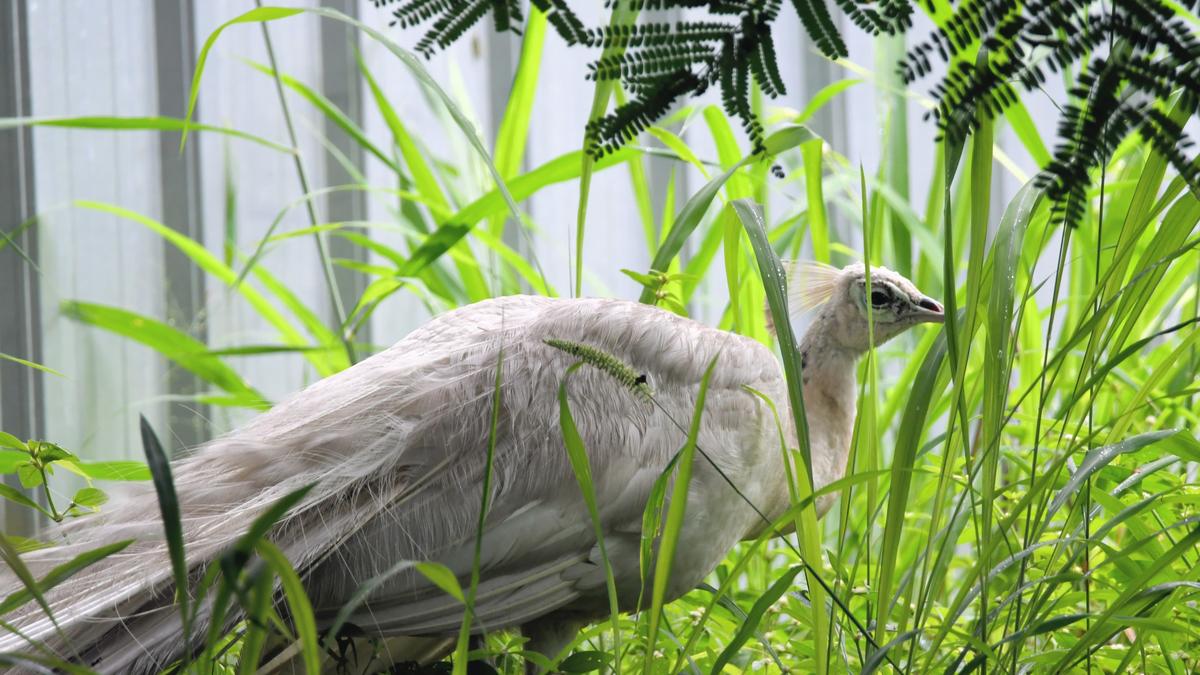
- 22 Nov 2024
In News:
Tamil Nadu Forest Department staff and members of a non-governmental organisation rescued a rare peacock with white feathers, caused by a genetic condition called leucism, in Coimbatore.
Key Highlights:
Incident Details:
- Species: Indian peacock (Pavocristatus), known for its beautiful plumage.
- Condition: The peacock was rescued due to a leg injury and its rare white plumage.
- Cause of White Plumage: The bird's white feathers are caused by leucism, a genetic condition that reduces pigmentation in feathers while leaving eye color unaffected.
Expert Insights:
- Leucism: It causes partial loss of pigmentation in animals. A leucistic animal retains normal eye color but has pale or white coloration.
- Distinction from Albinism: Unlike albinism, which results in a complete lack of melanin and often causes red or pink eyes, leucistic animals retain normal eye pigmentation.
- Identification of Leucism in Peacock: The bird’s dark eyes and pink bill and feet confirmed it as fully leucistic.
Peacock Species:
- Indian Peacock (Pavocristatus): The National Bird of India, native to India and Sri Lanka. It belongs to the Phasianidae family, which also includes pheasants, quails, and jungle fowl.
- Green Peacock (Pavomuticus): Found from Myanmar to Java.
Conservation Status:
- IUCN Status: Listed as Least Concern.
- Wildlife Protection Act, 1972: The Indian peacock is listed under Schedule I, offering it the highest level of legal protection in India.
Climate Change Performance (CCPI 2025)
- 22 Nov 2024
In News:
Recently, the Climate Change Performance Index (CCPI 2025) report was released at the annual UN climate conference in Baku.
Key Highlights:
- It is published by think tanks German watch, New Climate Institute, and Climate Action Network International.It was first published in 2005.
- It tracks the progress of the world’s largest emitters in terms of emissions, renewables, and climate policy.
India's Ranking in Climate Change Performance (CCPI 2025)
- India's Rank: 10th (Dropped two places from the previous year).
- Key Factors for India's High Rank:
- Low per capita emissions: 2.9 tons of CO2 equivalent (global average: 6.6 tons).
- Rapid deployment of renewables: India is a leader in solar energy projects, including large-scale solar and rooftop solar schemes.
- Renewable energy targets: Aims for 500 GW of renewable energy capacity by 2030.
- Energy efficiency standards: Introduced, but coverage remains inadequate.
- Electric vehicle (EV) deployment: Significant progress, especially in two-wheelers.
- Challenges for India:
- Heavy reliance on coal: India remains one of the top 10 countries with the largest developed coal reserves.
- Growth-oriented approach: Economic growth and energy demand continue to drive climate action, with limited change in climate policy expected.
- Future Pledges:
- Net-zero emissions by 2070.
- Global leadership in green energy.
CCPI 2025 Rankings Overview
Rank
Country
Key Points
1-3
Empty
No country performed well enough to achieve a "very high" rating.
4
Denmark
Leading climate actions but ranks 4th technically.
5
Netherlands
Strong climate performance, follows Denmark.
6
U.K.
Notable improvement due to coal phase-out and halting new fossil fuel licenses.
10
India
High performer, despite challenges like reliance on coal.
55
China
Largest emitter, heavily reliant on coal, ranks 55th despite promising plans.
57
U.S.
Second-largest emitter, ranks 57th with insufficient climate targets.
59
Argentina
Major climate policy setbacks, including potential exit from Paris Agreement.
64-67
Iran, Saudi Arabia, UAE, Russia
Lowest-ranked, major oil and gas producers with weak climate policies.
General Findings of the Report
- CCPI Methodology: Assesses 63 countries (plus the EU) responsible for 90% of global emissions based on their emissions, renewable energy efforts, and climate policies.
- Global Trends:
- No country has been able to secure a "very high" rating across all categories.
- Denmark and Netherlands are among the top performers.
- The U.K. shows significant progress with its coal phase-out and fossil fuel policies.
Graded Response Action Plan (GRAP-IV)
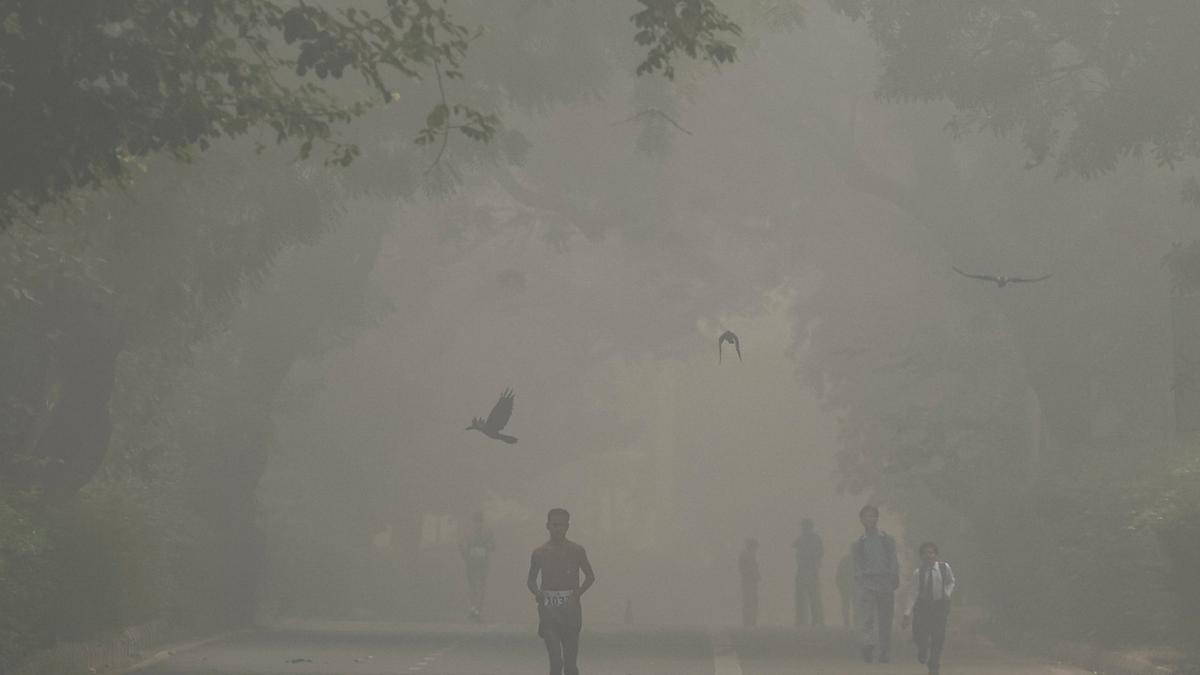
- 19 Nov 2024
In News:
As Delhi’s AQI worsened, the Commission for Air Quality Management issued the order to activate Stage-IV of the Graded Response Action Plan.
Restrictions Under GRAP-IV in Delhi-NCR
- Truck Movement:
- Banned except for essential goods and trucks using clean fuels (LNG, CNG, BS-VI diesel, or electric).
- Non-essential light commercial vehicles registered outside Delhi are also banned unless they are CNG or BS-VI diesel or electric vehicles (EVs).
- Delhi-registered BS-IV or older diesel vehicles (medium and heavy goods vehicles) are banned, except for those in essential services.
- Construction Activities:Suspension of all construction work, including public projects like highways, roads, flyovers, power lines, pipelines, etc.
- Schools and Work:
- Online classes for students of Classes 6 to 9 and Class 11.
- Work from home (WFH) recommendations for 50% office capacity in NCR.
- Central government employees may also be asked to work from home.
- Offline classes for Classes 10 and 12 continue, but schools for other classes must shift to online mode.
- Other Measures:
- State governments may impose additional measures such as:
- Closure of colleges.
- Odd-even vehicle scheme.
- Restrictions on non-essential commercial activities.
- State governments may impose additional measures such as:
About GRAP (Graded Response Action Plan)
- Purpose: A plan to reduce air pollution in the Delhi-NCR region based on AQI levels.
- Approved By: Supreme Court in 2016 (M.C. Mehta v. Union of India).
- Notified by MoEFCC: 2017.
- Implementation Authority: CAQM (Commission for Air Quality Management).
Stages of GRAP
GRAP is an incremental system, with measures activated as air quality deteriorates:
- Stage 1: Poor AQI (201-300) – Basic pollution control measures.
- Stage 2: Very Poor AQI (301-400) – Enhanced measures.
- Stage 3: Severe AQI (401-450) – Stricter actions like shutting down industries.
- Stage 4: Severe Plus AQI (Above 450) – Most stringent restrictions, as activated on November 18, 2024.
Air Quality Index (AQI)
- Introduced: 2014, by Central Pollution Control Board (CPCB).
- Categories:
- Good: 0-50
- Satisfactory: 51-100
- Moderately Polluted: 101-200
- Poor: 201-300
- Very Poor: 301-400
- Severe: 401-450
- Severe Plus: 451 and above (current status in Delhi).
- Pollutants Considered: PM10, PM2.5, NO?, SO?, CO, O?, NH?, and Pb.
- Measurement: 24-hour average values for PMs, and 8-hour averages for CO and O?.
Commission for Air Quality Management (CAQM)
- Established: Under the Commission for Air Quality Management in National Capital Region (NCR) Act, 2021.
- Mandate: To coordinate, research, and manage air quality issues in the NCR and adjoining areas.
- Composition: Includes government officials, technical experts, and NGO representatives.
- Jurisdiction: Covers Delhi and parts of Haryana, Uttar Pradesh, and Rajasthan.
Guru Ghasidas-TamorPingla Tiger Reserve

- 19 Nov 2024
In News:
The Guru Ghasidas-TamorPingla Tiger Reserve in Chhattisgarh has been officially notified as India's 56th tiger reserve, marking a significant milestone in the country's conservation efforts. Here's an overview of this new reserve:
Key Details:
- Location: The tiger reserve is located across the Manendragarh-Chirmiri-Bharatpur, Korea, Surajpur, and Balrampur districts of Chhattisgarh.
- Area: The reserve spans 2,829.38 square kilometers and includes both core and buffer zones.
- Core/critical habitat: 2,049.2 sq. km (includes the Guru Ghasidas National Park and TamorPingla Wildlife Sanctuary).
- Buffer zone: 780.15 sq. km.
- Rank: It is the third largest tiger reserve in India, after the Nagarjunasagar-Srisailam Tiger Reserve (Andhra Pradesh) and Manas Tiger Reserve (Assam).
Connectivity:
The reserve forms part of a landscape complex that extends over nearly 4,500 sq. km and is interconnected with other major tiger reserves:
- Sanjay Dubri Tiger Reserve (Madhya Pradesh) to the north.
- Bandhavgarh Tiger Reserve (Madhya Pradesh) to the west.
- Palamau Tiger Reserve (Jharkhand) to the east.
This connectivity supports greater wildlife movement, reducing the risk of inbreeding and strengthening the overall conservation efforts for the tiger population.
Biodiversity:
The Guru Ghasidas-TamorPingla Tiger Reserve is ecologically rich, harboring a wide array of species:
- 753 species have been documented, including:
- 230 bird species.
- 55 mammal species, including several threatened species such as tigers, leopards, sloth bears, and wolves.
- A variety of invertebrates, especially insects.
- The reserve's terrain includes dense forests, streams, rivers, and varied elevations, making it an ideal habitat for tigers and other wildlife.
Ecological Importance:
- Situated in the Chota Nagpur and Baghelkhand plateaus, the reserve has varied landscapes that contribute to its ecological diversity. The region's tropical climate and dense forests make it a critical habitat for tigers and other wildlife.
- The reserve's core area forms an important critical tiger habitat, providing a sanctuary for tigers to thrive with minimal human disturbance.
Conservation Impact:
With the addition of this tiger reserve, Chhattisgarh now boasts four tiger reserves, complementing the existing Udanti-Sitanadi, Achanakmar, and Indravati reserves. This bolsters the state's and the country's ongoing efforts to protect and conserve tigers, which are a keystone species in maintaining ecological balance.
Procedural Steps for Notification:
- Identification: The state government identifies a significant ecological area with potential for tiger conservation.
- NTCA Approval: After a thorough assessment, the National Tiger Conservation Authority (NTCA) evaluates and approves the proposal.
- State Notification: The state government officially notifies the area as a tiger reserve under the Wildlife Protection Act of 1972.
- Implementation: The state, with NTCA support, begins implementing conservation and management strategies.
Mystery mollusk
- 18 Nov 2024
In News:
- In a groundbreaking discovery, researchers have identified a new species of sea slug deep within the ocean’s midnight zone—a place that lies between 3,300 to 13,100 feet (1,000 to 4,000 meters) below the ocean's surface.
- The species, named Bathydeviuscaudactylus, is a glowing, swimming sea slug that exhibits several unique adaptations to survive in the extreme conditions of the deep ocean.
Key Features of BathydeviusCaudactylus
- Glowing Bioluminescence: One of the most striking features of this newly discovered mollusk is its ability to glow with bioluminescence. Bathydevius emits a soft, starry glow, an adaptation seen in only a few deep-sea species. The glowing feature plays a role in distracting predators and even includes the ability to detach glowing projections from its tail as a decoy.
- Unique Body Structure: Unlike most sea slugs that typically live on the seafloor, Bathydevius has evolved to thrive in the open water. It has a gelatinous, paddle-like tail and a large, bowl-shaped hood that covers its internal organs, making it appear somewhat like a “megaphone with a feathered tail.” This structure helps it capture prey, such as mysid shrimp, which it traps using its hood.
- Adaptations for Deep Sea Life: Bathydevius' transparent body, along with its ability to drift with ocean currents and flex its body to move vertically in the water column, allow it to navigate the depths of the midnight zone. Its hermaphroditic nature means it carries both male and female reproductive organs, allowing it to reproduce by attaching to the seafloor and laying eggs when needed.
Discovery and Exploration
- The unusual species was first encountered by researchers from the Monterey Bay Aquarium Research Institute (MBARI) during a deep-sea dive in February 2000 using a remotely operated vehicle (ROV) called Tiburon. Since then, more than 150 sightings have been made of the creature in the waters off the Pacific Coast of North America, ranging from Oregon to Southern California.
- Interestingly, similar creatures have been observed by the National Oceanic and Atmospheric Administration (NOAA) in the Mariana Trench, suggesting that Bathydevius may have a wider range than initially thought. A specimen was eventually collected for further study, revealing its identity as a nudibranch, a type of soft-bodied marine mollusk.
Survival Tactics and Behavior
- Prey Capture: Unlike typical sea slugs that scrape food from the seafloor, Bathydevius uses its large hood to trap crustaceans like mysid shrimp. This allows it to thrive in the open ocean where food can be harder to obtain.
- Defensive Mechanisms: When threatened, Bathydevius can glow with bioluminescence to distract predators. This glow, which creates a starry appearance across its back, has been seen in other deep-sea species but is rare in nudibranchs. Additionally, it can detach part of its tail (a glowing projection) to confuse attackers, similar to how lizards shed their tails as a defense mechanism.
- Reproduction and Movement: As a hermaphrodite, Bathydevius has the ability to self-fertilize or mate with other individuals. During reproduction, it descends to the seafloor and uses its foot to temporarily attach, releasing eggs before returning to its swimming lifestyle. It also relies on its flexible, transparent body to blend in with the surroundings and evade predators.
Red-Headed Vulture
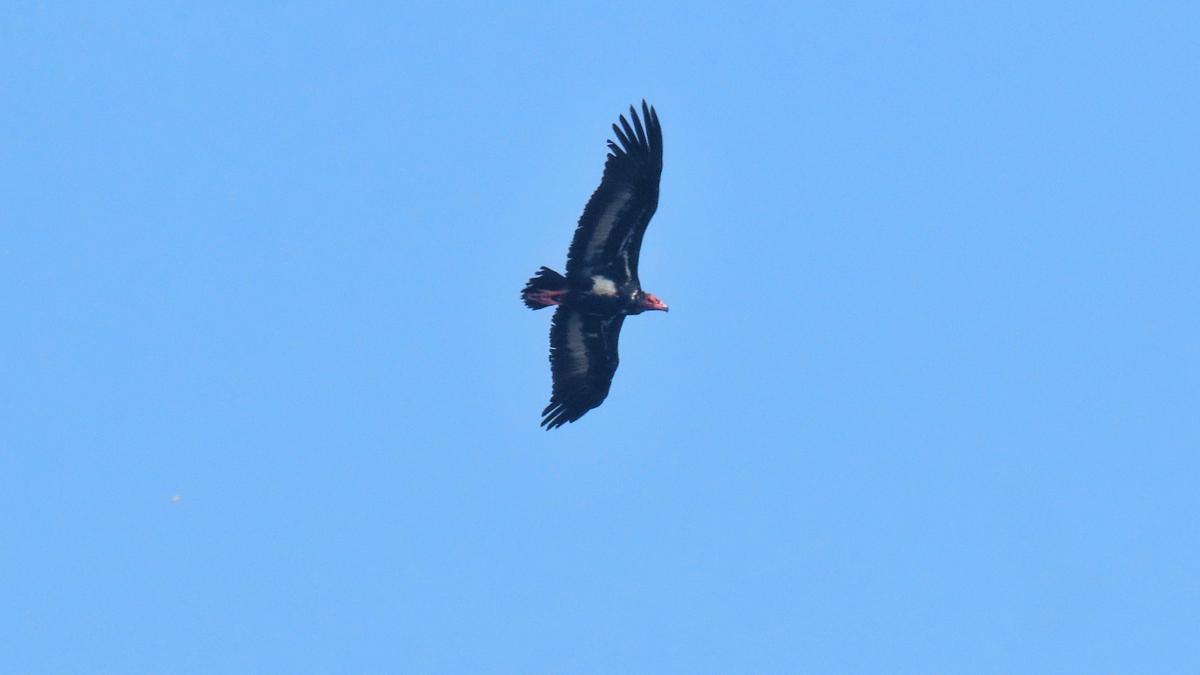
- 17 Nov 2024
In News:
- The Red-Headed Vulture, a critically endangered species, has been sighted for the first time in Kasaragod, Kerala, marking an important addition to the region’s avian biodiversity. This rare sighting occurred at Manhampothikunnu near Mavungal. Prior to this, the species was predominantly seen in the Wayanad region of Kerala.
- This discovery brings the total number of bird species recorded in Kasaragod to 407, showcasing the district's growing avian diversity.
About the Red-Headed Vulture:
- The Red-Headed Vulture (also known as the Asian King Vulture or Pondicherry Vulture) is one of the rarest and most critically endangered species of vultures in India. It is known for its distinctive scarlet red head and black body with a white patch on the abdomen.
- Physical Features: The bird is medium-sized, weighing around 5 kg, with a wingspan of up to 2.5 meters and a length of 80 cm. It is typically solitary, often found alone or with a mate.
- Distribution: Historically found in Central India, Nepal, Myanmar, Thailand, Vietnam, and parts of Kerala, Karnataka, and Tamil Nadu, the Red-Headed Vulture’s numbers have drastically declined in recent decades.
Conservation Status:
- IUCN Red List: The Red-Headed Vulture is classified as Critically Endangered.
- Wildlife Protection Act, 1972: It is listed under Schedule 1, offering it the highest level of legal protection.
- CITES: The species is also listed in Appendix II, indicating that it requires international conservation efforts to prevent it from becoming endangered.
Threats to Vultures:
- Diclofenac Poisoning: The significant decline in vulture populations in India, including the Red-Headed Vulture, is primarily due to the widespread use of diclofenac (a veterinary drug) to treat livestock. When vultures consume the carcasses of treated animals, they ingest the toxic drug, leading to kidney failure and death.
- Other threats include pesticide contamination, lead poisoning, habitat loss, and collisions with man-made structures like power lines and wind turbines.
Conservation Efforts in India:
- India has undertaken various efforts to protect vultures, including banning diclofenac in 2006 and expanding the ban to other harmful drugs like ketoprofen and aceclofenac in 2023.
- Vulture Conservation Breeding Centres (VCBCs): These centers are focused on captive breeding and reintroduction programs for vultures, helping to increase their populations. The Jatayu Conservation and Breeding Centre in Uttar Pradesh is one of the latest initiatives, set up to protect and rehabilitate vultures.
- Vulture Safe Zones have been created across India, providing safe habitats for vulture species to recover.
- Vulture Restaurant Initiative: In some regions, safe feeding centers (such as in Jharkhand) have been established, where vultures are provided uncontaminated carcasses, reducing their exposure to toxic substances.
- Legal Protection: Several species of vultures, including the Red-Headed Vulture, are protected under Schedule I of the Wildlife Protection Act, 1972, ensuring stringent legal measures against poaching and habitat destruction.
Global Conservation Efforts:
- India’s vulture conservation initiatives are part of a broader international effort under the SAVE (Saving Asia’s Vultures from Extinction) programme, which involves multiple regional and global organizations working to protect vulture species in South Asia.
Decline in African Elephant Population
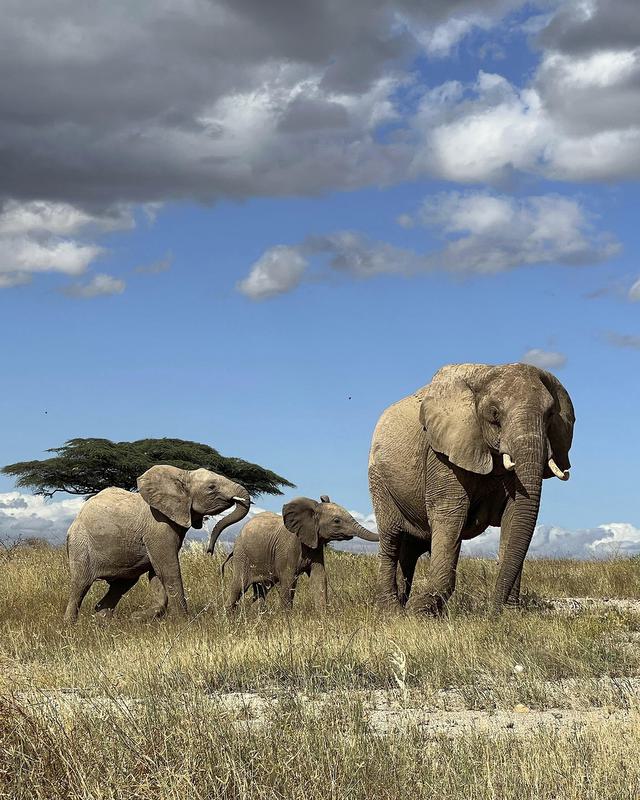
- 14 Nov 2024
In News:
- The population of African elephants has been declining rapidly, with data showing alarming drops across the African continent.
- Survey Period: The study covers population data from 475 sites in 37 countries over 52 years (1964-2016).
- Population Decrease:
- Savannah Elephants: A 70% decline on average across surveyed sites.
- Forest Elephants: A 90% decline on average across surveyed sites.
- Overall Impact: The study indicates a 77% average decline in elephant populations across both species.
Main Drivers of Decline
- Poaching: Illegal hunting for ivory and other body parts remains a major threat.
- Habitat Loss: Urbanization, agricultural expansion, and climate change are encroaching on the elephant’s natural habitats.
- Human-Elephant Conflict: Increased human settlements near elephant habitats lead to conflicts, further endangering elephant populations.
Species Overview
- Two Subspecies:
- Savannah Elephant (Loxodonta africana): Larger and more common, found in open savannas.
- Forest Elephant (Loxodonta cyclotis): Smaller and more elusive, found in dense rainforests.
- Conservation Status:
- Savannah Elephant: Endangered (IUCN).
- Forest Elephant: Critically Endangered (IUCN).
- CITES Listing: Both species are listed under CITES Appendix I, which bans international trade in endangered species.
Regional Impact
- Northern and Eastern Africa: These regions have seen drastic declines, particularly in the Sahel (Mali, Chad, Nigeria), where elephants have been extirpated (locally extinct) due to poaching and insufficient protection.
- Southern Africa: Positive Growth in some areas, particularly in Botswana, Zimbabwe, and Namibia, where elephant populations are growing due to strong conservation efforts.
Conservation Success
- Southern Africa: 42% of the surveyed sites showed increasing elephant populations, a testament to successful conservation strategies.
- Government and NGO Efforts: Successful population growth is often attributed to active management, including anti-poaching laws, protected areas, and conservation funding.
Elephant Behavior and Reproduction
- Social Structure: Elephants live in family units led by mature females, with strong social bonds.
- Low Sleep Time: Elephants sleep only 2 hours per day on average.
- Reproduction: They have a long gestation period of up to 2 years, and calves are cared for by mothers and allomothers (non-mother females).
Conservation Challenges
- Sustainability: Continued poaching and habitat destruction threaten to undo gains made in conservation.
- Fragmentation of Populations: With many elephants in isolated pockets, genetic diversity is declining, which could lead to long-term problems for species survival.
Global Nature Conservation Index (NCI) 2024
- 13 Nov 2024
In News:
India with an abysmal score of 45.5 (out of 100) has been ranked 176th in the Global Nature Conservation Index, 2024.
Key Highlights:
- India's Ranking:
- Ranked 176th out of 180 countries in the 2024 Global Nature Conservation Index (NCI).
- India is listed among the five worst performers, along with Kiribati (180), Turkey (179), Iraq (178), and Micronesia (177).
- Score: 45.5 out of 100, indicating significant conservation challenges.
- Key Factors Contributing to Low Rank:
- Inefficient land management practices.
- Rising threats to biodiversity, exacerbated by unsustainable development and climate change.
- Four Key Markers Assessed by the NCI:
- Land Management: Ineffective management leading to significant land conversion.
- Threats to Biodiversity: Habitat loss, fragmentation, and deforestation.
- Capacity and Governance: Need for stronger political will and better enforcement of conservation laws.
- Future Trends: Growing pressure from population density, climate change, and illegal wildlife trade.
- Sustainable Land Use Concerns:
- 53% of land has been converted for urban, industrial, and agricultural purposes.
- High use of pesticides and concerns over soil pollution.
- Sustainable nitrogen index of 0.77 indicates significant risks to soil health.
- Marine Conservation Issues:
- Only 0.2% of India’s national waterways are under protected areas, with no protected areas within its Exclusive Economic Zone (EEZ).
- Significant improvements needed in marine conservation despite 7.5% of terrestrial areas being protected.
- Deforestation and Habitat Loss:
- 23,300 sq. km of tree cover lost between 2001-2019 due to deforestation.
- Habitat fragmentation from agriculture, urbanization, and infrastructure development.
- Impact of climate change on sensitive ecosystems like alpine regions and coral reefs.
- Biodiversity Decline:
- Despite 40% of marine species and 65% of terrestrial species being within Protected Areas (PAs), many species continue to face population decline.
- 67.5% of marine species and 46.9% of terrestrial species are still experiencing population declines.
- Illegal Wildlife Trade:
- India is the fourth-largest illegal wildlife trading nation globally, with an estimated annual trade value of £15 billion.
- The NCI emphasizes the need for stronger enforcement and international cooperation to combat wildlife trafficking.
- Ecological Wealth Under Threat:
- India’s high population density (with a population that has doubled since the late 1970s) continues to put pressure on its ecological wealth.
- The country faces significant biodiversity challenges due to overpopulation and unsustainable development.
- Recommendations and Optimism:
- The NCI stresses the need for strong political will and commitment to sustainable development.
- India can improve its rank by strengthening conservation laws, improving governance, and securing funding for environmental initiatives.
- The NCI remains optimistic about India’s potential to address its conservation challenges and achieve more sustainable outcomes in the future.
- About the Nature Conservation Index (NCI):
- Developed by: Goldman Sonnenfeldt School of Sustainability and Climate Change (Ben-Gurion University) and BioDB.com (a biodiversity database).
- Purpose: Evaluates the conservation efforts of countries, using a data-driven approach to balance conservation and development.
- Key Focus Areas: Land management, biodiversity threats, governance, and future sustainability trends.
Diclipterapolymorpha
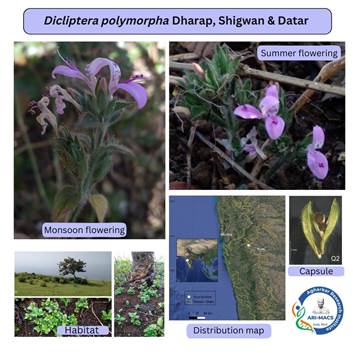
- 12 Nov 2024
In News:
A new species of Dicliptera, named Diclipterapolymorpha, has been discovered in the Northern Western Ghats of India.
Habitat and Location:
- Diclipterapolymorpha was found in the grasslands of Talegaon-Dabhade, a region known for its grasslands and fodder markets.
- The species thrives in the harsh climatic conditions of the Northern Western Ghats, an area vulnerable to summer droughts and frequent human-induced fires.
Unique Characteristics:
- The species is fire-resilient (pyrophytic), exhibiting a rare dual-blooming pattern:
- First Blooming: Occurs post-monsoon, typically from November to March/April.
- Second Blooming: Triggered by grassland fires in May and June, during which the plant produces dwarf flowering shoots.
- The inflorescence structure is unique in India, with its cymules developing into spicate inflorescences, a feature more commonly found in African species.
Taxonomy:
- The species is named Diclipterapolymorpha to reflect its diverse morphological traits.
- It is taxonomically distinct within the Dicliptera genus, with no known Indian species exhibiting similar characteristics.
Conservation Implications:
- The discovery highlights the need to carefully manage grassland ecosystems, as the species is adapted to fire but still vulnerable to habitat degradation.
- Human-induced fires are essential for the species' blooming cycle but must be managed to avoid overuse and degradation of habitat.
- The species' limited habitat range underscores the need for conservation efforts to protect the delicate ecosystems of the Western Ghats.
Publication:
- A research paper detailing the discovery of Diclipterapolymorpha has been published in the prestigious Kew Bulletin.
Arpactophiluspulawskii
- 11 Nov 2024
In News:
- Arpactophiluspulawskii, a new species of aphid wasp, was discovered in Nagaland (Khuzama district), marking the first record of the genus Arpactophilus outside Australasia.
- This significant discovery highlights the biodiversity of Northeastern India, a region known for its rich and unexplored fauna.
Importance of Discovery:
- The Zoological Survey of India (ZSI) researchers cataloged the species, marking a major range expansion for the genus Arpactophilus, previously only found in Australasia, including regions like New Caledonia.
- The discovery expands the genus’s known distribution by thousands of kilometers, suggesting ecological connections between Nagaland and the Australasian region.
Species Characteristics:
- Arpactophiluspulawskii is distinguished by its square-shaped head, an inverted V-shaped uplifted clypeus, and rust-colored body markings.
- It features a uniquely textured thorax, setting it apart from other species in the genus.
- The wasp was collected from an altitude of over 1,800 meters, indicating Nagaland’s ecological diversity at high altitudes.
Ecological Significance:
- The Arpactophilus genus is known for its unique nesting behavior: females use silk from their abdomen to create protective cells in old termite galleries or mud nests.
- The discovery suggests that Nagaland’s ecological conditions (e.g., high altitude, diverse habitat) support the presence of such specialized fauna, making the region an important site for entomological research.
Taxonomic Contribution:
- The species is named Arpactophiluspulawskii in honor of Dr. Wojciech J. Pulawski, a distinguished expert in wasp taxonomy.
Scientific and Research Implications:
- The discovery is expected to stimulate further entomological research in Northeastern India, especially in areas like Nagaland, which are often overlooked in global biodiversity studies.
- Researchers believe that this discovery could lead to the identification of other unknown species in the region, expanding our understanding of species distribution and the ecological connectivity between regions.
Adaptation Gap Report 2024
- 08 Nov 2024
In News:
The Adaptation Gap Report 2024, published by the United Nations Environment Programme (UNEP), underscores the urgent need for enhanced climate adaptation efforts, particularly through increased financial support for developing countries. The report, titled Come Hell and High Water, provides an annual assessment of global adaptation progress in planning, implementation, and financing.
Key Findings
- Adaptation Gap:
- The adaptation finance gap is estimated at $187–359 billion per year.
- Current adaptation finance falls short, with only $28 billion provided in 2022, meeting just 5% of projected needs.
- Adaptation Progress:
- International public adaptation finance to developing countries rose to $27.5 billion in 2022, up from $19 billion in 2019, reflecting progress toward the Glasgow Climate Pact's goal of doubling finance by 2025.
- Significance of Adaptation:
- Ambitious adaptation measures could reduce global climate risk by 50%.
- For instance, $16 billion annually in agriculture could prevent climate-induced hunger for 78 million people.
- Impact of Global Warming:
- According to UNEP's Emissions Gap Report 2024, global temperatures may increase by 2.6°C–3.1°C above pre-industrial levels by 2100.
- Developing countries face severe vulnerabilities, evidenced by recent floods in Nepal, Nigeria, and Chad.
- National Adaptation Plans (NAPs):
- While 171 countries have at least one adaptation policy, progress in implementation remains slow.
- 10 countries have shown no interest in developing adaptation policies.
Challenges in Adaptation Financing
- Financial Burden: Adaptation projects such as seawalls and resilient infrastructure are costly for developing nations.
- Funding Shortfalls:
- Developed nations have failed to meet financial commitments like the $100 billion goal set for 2020.
- The adaptation finance gap remains significant in non-private sector-funded areas, such as ecosystem preservation.
- High-Interest Loans: Much current funding relies on high-interest loans, increasing the debt burden for recipient countries.
Recommendations
- Adopt New Financing Goals: Establish an ambitious New Collective Quantified Goal for climate finance at COP29.
- Strategic Adaptation Financing:
- Shift from project-based to anticipatory and transformational financing.
- Invest in harder-to-finance areas like ecosystem preservation and cultural heritage.
- Alternative Financing Models: Encourage risk finance, resilience bonds, debt-for-adaptation swaps, and payments for ecosystem services.
Global and Indian Initiatives
Global Initiatives:
- Paris Agreement: Sets a global adaptation goal to enhance resilience.
- UAE Framework for Global Climate Resilience: Introduced at COP28, focusing on agriculture, water, and health adaptation targets.
- Adaptation Fund: Provides project funding for developing nations under the Kyoto Protocol.
Indian Initiatives:
- National Action Plan on Climate Change (NAPCC): Includes eight missions, such as the National Adaptation Fund for Climate Change (NAFCC).
- Sectoral Schemes:
- MISHTI: Mangrove initiative for shoreline protection.
- Amrit Dharohar: Enhances wetland ecosystems.
- India's adaptation spending accounted for 5.6% of GDP in 2021–2022.
Protected Planet Report 2024
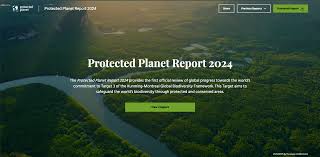
- 08 Nov 2024
In News:
The Protected Planet Report 2024, released by UNEP-WCMC and IUCN, evaluates global progress toward achieving Target 3 of the Kunming-Montreal Global Biodiversity Framework (KM-GBF). This target aims to conserve 30% of Earth's terrestrial, inland water, coastal, and marine areas by 2030.
Key Highlights of the Report
- Current Global Coverage
- Land and Inland Waters: 17.6% protected.
- Oceans and Coastal Areas: 8.4% protected.
- Progress since 2020: Minimal increase (<0.5% for both realms), equivalent to an area twice the size of Colombia.
- Remaining Challenges to Achieve Target 3 by 2030
- Land: An additional 12.4% of land area must be protected (equivalent to Brazil + Australia).
- Ocean: 21.6% more marine areas must be safeguarded (larger than the Indian Ocean).
- Key Gaps:
- Only 8.5% of protected areas on land are well-connected.
- Only one-fifth of the areas critical for biodiversity are fully protected.
- Biodiversity representation remains uneven, with some ecological regions having no protection at all.
- Governance and Effectiveness Issues
- Less than 5% of protected land and 1.3% of marine areas have management effectiveness assessments.
- Only 0.2% of protected land and 0.01% of marine areas have undergone equitable governance assessments.
- Indigenous governance covers less than 4% of protected areas despite Indigenous and traditional territories covering 13.6% of the terrestrial areas.
- Ocean Conservation Progress: Most progress is in national waters; however, areas beyond national jurisdiction (the high seas) remain underrepresented (<11% coverage).
- Data Deficiency: Insufficient data to measure biodiversity outcomes, equity, and governance in protected areas.
Importance of Target 3
- Biodiversity Benefits: Protected areas play a critical role in halting and reversing biodiversity loss.
- Ecosystem Services: These areas contribute to clean air, water, climate regulation, and food security.
- Cultural and Economic Significance: They uphold the rights of Indigenous Peoples and local communities, ensuring equitable governance and sustainable resource use.
Key Recommendations
- Accelerate Conservation Efforts:
- Expand protected and conserved areas with a focus on biodiversity hotspots.
- Ensure areas are ecologically connected and effectively managed.
- Strengthen Indigenous and Local Contributions:
- Recognize and support the stewardship of Indigenous Peoples and local communities.
- Ensure their voices and knowledge systems are integrated into conservation planning.
- Improve Governance and Equity:
- Address gaps in equitable governance and include rights-based approaches.
- Global Cooperation:
- Increase international financing to developing nations for biodiversity conservation.
- Foster cross-border partnerships and support data-sharing initiatives.
- Enhance Data Availability:
- Collect and disseminate data on the effectiveness of protected areas and their biodiversity outcomes.
India’s Role and Strategy
- Commitment to KM-GBF: India updated its National Biodiversity Strategy and Action Plan (NBSAP) to align with the KM-GBF goals, aiming to protect 30% of natural areas by 2030.
- Focus on Restoration: Prioritizes the restoration of forests, rivers, and other ecosystems to maintain essential resources like clean air and water.
- Indigenous Participation: India emphasizes integrating Indigenous territories into its conservation framework.
Okinawicius tekdi
- 07 Nov 2024
In News:
Researchers have recently discovered a new species of jumping spider in the Baner Hill area, underscoring the region's rich biodiversity and the growing need to preserve the natural landscapes around Pune.
About Okinawicius tekdi:
- The newly identified species, named Okinawicius tekdi, is a jumping spider that contributes to the growing diversity of India's spider population, now numbering 326 species of jumping spiders.
- The name "tekdi" comes from the Marathi word for "hill," reflecting the spider's habitat.
- The last time a spider species was identified in Pune was over three decades ago.
About Jumping Spiders:
- Jumping spiders belong to the family Salticidae and are known for their distinctive eight legs and remarkable jumping ability.
- These spiders possess a segmented body, a tough exoskeleton, and jointed legs.
- In addition to their agility, they are famous for spinning webs that they use to capture their prey.
World Cities Report 2024
- 07 Nov 2024
In News:
The World Cities Report 2024, released by UN-Habitat, highlights the urgent need for cities to address climate change, both as victims and major contributors.
Key Findings of the Report
- Temperature Increases by 2040: Nearly 2 billion people living in urban areas are projected to face at least a 0.5°C rise in temperature by 2040, exposing them to heatwaves and other climate-related risks.
- Urban Vulnerability and Climate Risk:
- Cities are disproportionately affected by climate change while being major contributors to greenhouse gas emissions, which exacerbates their vulnerability to events like floods, cyclones, and heatwaves.
- The urban population is facing a dual challenge: increased heat and extreme weather events such as flooding, cyclones, and erratic rainfall.
- Sea-Level Rise and Coastal Risks: Over 2,000 cities in low coastal areas, many located under 5 meters above sea level, are at heightened risk from sea-level rise and storm surges, potentially affecting more than 1.4 billion people by 2040.
- Riverine Flooding: Flood exposure in cities is growing 3.5 times faster than in rural areas, with 517 million people in urban areas projected to be exposed to riverine flooding by 2030.
- Investment Gap: Cities require between USD 4.5 trillion and USD 5.4 trillion annually to build and maintain climate-resilient systems, but current investments stand at only USD 831 billion, highlighting a massive funding shortfall.
- Decline in Urban Green Spaces: The average share of urban green spaces has dropped from 19.5% in 1990 to 13.9% in 2020, reducing cities' ability to absorb carbon, manage heat, and provide essential ecosystem services.
- Vulnerable Communities: Informal settlements and slums, often situated in environmentally sensitive areas, are disproportionately affected by climate impacts. These communities lack adequate infrastructure and are often unable to invest in necessary upgrades due to eviction fears or lack of legal recognition.
- Green Gentrification: While climate interventions like park creation can provide environmental benefits, they can also lead to green gentrification—displacing low-income households or increasing property values and rents, thus pricing vulnerable communities out.
Contributing Factors to Urban Global Warming
- Energy Consumption: Urban areas account for 71-76% of global CO? emissions from energy use, driven by dense populations, industrial activities, transportation, and high-energy demand for buildings.
- Industrial Activities: Urban industries and power plants release a variety of greenhouse gases (GHGs), including CO?, methane (CH?), and nitrous oxide (N?O).
- Land Use Changes: Urban expansion leads to deforestation and reduced carbon absorption, contributing to global warming. Urban land areas are expected to more than triple by 2050, accelerating environmental degradation.
- Waste Generation: Decomposing waste in landfills releases methane, a potent GHG, exacerbating the greenhouse effect.
- Urban Heat Island Effect: Urban Heat Islands (UHIs) occur when cities absorb and retain more heat due to their dense infrastructure (asphalt, concrete, and buildings), increasing local temperatures and energy consumption.
Impacts of Global Warming on Cities
- Heatwaves: Cities, especially in warmer regions like India, are experiencing more severe heatwaves and rising temperatures.
- Urban Heat Island Effect: UHIs increase the intensity of heatwaves, particularly in high-density cities, where buildings and roads trap heat, exacerbating energy demands and public health risks.
- Coastal Flooding: Rising sea levels threaten coastal cities with flooding and storm surges, displacing communities and disrupting economies.
- Wildfire Seasons: Warming temperatures and prolonged droughts increase the risk of wildfires in urban areas, particularly in forest-adjacent cities.
India's Climate Initiatives for Urban Areas
- Smart Cities Mission: Focuses on developing sustainable urban infrastructure, promoting smart technologies, and enhancing resilience to climate impacts.
- AMRUT Mission: Aims to provide basic infrastructure and sustainable urban development in cities, including water supply, sewage, and green spaces.
- Swachh Bharat Mission-Urban: Focuses on improving waste management and reducing pollution in urban areas.
- FAME India Scheme (Faster Adoption and Manufacturing of Hybrid and Electric Vehicles): Promotes electric vehicles to reduce urban air pollution and carbon emissions.
- Green Energy Corridor (GEC): Facilitates the integration of renewable energy sources into the national grid, encouraging clean energy use in urban centers.
IUCN’s First Global Tree Assessment
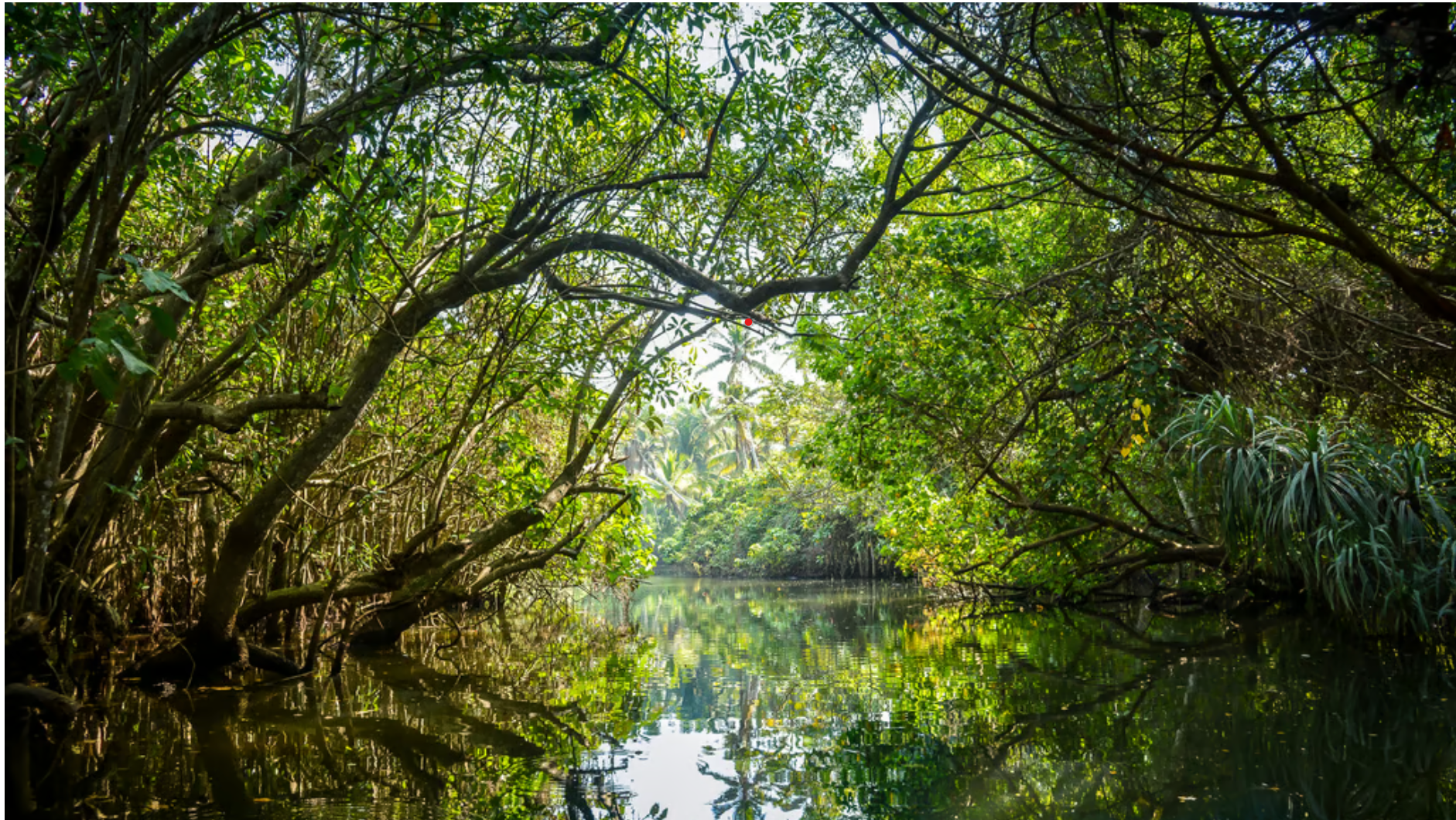
- 05 Nov 2024
In News:
More than one in three tree species threatened with extinction, finds IUCN’s first Global Tree Assessment
Key Highlights:
Global Tree Extinction Risk:
- 38% of the world’s tree species are now facing the risk of extinction — over one in three tree species is at risk.
- This means 16,425 out of 47,282 tree speciesanalyzed by the International Union for Conservation of Nature (IUCN) are under threat.
- Threatened tree species outnumber all threatened birds, mammals, reptiles, and amphibians combined, highlighting the urgent need for conservation action.
Key Drivers of Threat:
- Deforestation: The primary threat to trees is deforestation, driven by agriculture, livestock rearing, and urban development, especially in tropical regions.
- Climate Change: Rising sea levels and increasingly frequent storms exacerbate the threats, particularly in tropical regions and islands.
- Invasive Species & Pests: Non-native species, pests, and diseases are adding pressure to vulnerable tree populations.
Geographic Vulnerabilities:
- Islands are particularly vulnerable, with a high proportion of threatened species due to habitat destruction and urbanization.
- South America, which boasts the highest tree diversity, faces significant threats, with 3,356 out of 13,668 species at risk, mainly due to deforestation for agriculture.
Ecological and Economic Importance of Trees:
- Trees play a fundamental role in carbon, water, and nutrient cycles, and are critical for soil formation and climate regulation.
- The loss of trees poses a growing threat to thousands of other species of plants, fungi, and animals.
- Trees are essential for local communities, providing resources such as timber, medicines, food, and fuel. Over 5,000 species of trees are used for timber and construction, while more than 2,000 species are vital for food, fuel, and medicine.
Conservation Status:
- Tree species are threatened across 192 countries.
- The assessment is the first global analysis of the conservation status of trees, enabling better-informed conservation decisions.
Positive Actions and Strategies:
- Successful community-driven conservation efforts have had positive outcomes in places like the Juan Fernández Islands, Cuba, Madagascar, and Fiji.
- Some countries, including Ghana, Colombia, Chile, and Kenya, already have national strategies for tree conservation.
- Ex-situ conservation, such as seed banks and botanical gardens, is also crucial to safeguard species that may not survive in the wild.
Urgent Call for Action:
The IUCN Global Tree Assessment underlines the urgent need for enhanced conservation efforts, including:
- Habitat protection and restoration.
- Ex-situ conservation through seed banks and botanical gardens.
- Diversified and species-focused reforestation strategies.
- Supporting community-led conservation initiatives to safeguard vulnerable tree species.
Asia-Pacific Climate Report 2024
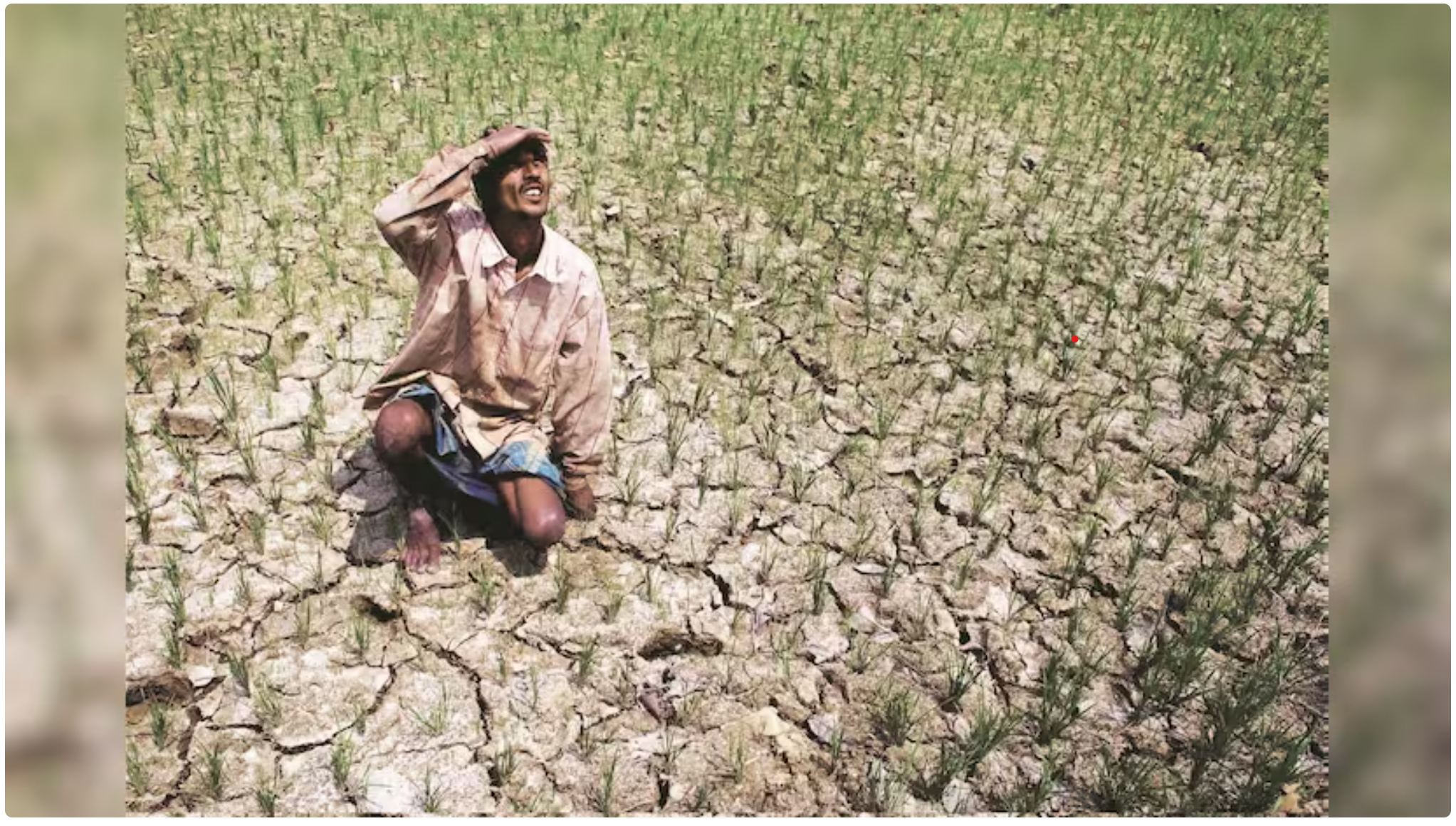
- 05 Nov 2024
In News:
Climate change to put APAC GDP on thin ice with 41% melt by 2100.
Key Highlights:
- Economic Losses Due to Climate Change:
- APAC Region: High-end greenhouse gas emissions could reduce GDP by 17% by 2070 and 41% by 2100.
- India: Projected to experience a 24.7% GDP loss by 2070, with neighboring countries like Bangladesh (30.5%), Vietnam (30.2%), and Indonesia (26.8%) facing even steeper declines.
- Major Drivers of Economic Losses:
- Sea-Level Rise: Up to 300 million people at risk of coastal flooding by 2070. Annual damages could reach $3 trillion by 2070.
- Labour Productivity: The APAC region could lose 4.9% of GDP from reduced labour productivity, with India facing a sharper 11.6% loss.
- Cooling Demand: Rising temperatures could reduce regional GDP by 3.3%, but India's cooling demands could cut its GDP by 5.1%.
- Flooding and Storms: Increased rainfall and storm intensity will exacerbate flooding and landslides, particularly in mountainous regions like the India-China border, where landslides could rise by 30-70% under severe warming.
- Impact on Key Sectors:
- River Flooding: By 2070, annual riverine flooding could cause $1.3 trillion in damages across the APAC, affecting over 110 million people. India could face over $1,100 billion in flood-related damages annually.
- Forest Productivity: Climate change could reduce forest productivity by 10-30% by 2070 across APAC. India could see losses over 25%, making it one of the hardest-hit countries, alongside Vietnam and Southeast Asia.
- Climate Risks and Vulnerabilities:
- Coastal Flooding: Coastal flooding could lead to widespread economic damage, with India expected to suffer significant losses, particularly in coastal areas.
- Ecosystem Threats: Intensified storms, rainfall, and landslides will affect ecosystems, forests, and agriculture across the region.
- Climate Change and Adaptation Needs:
- Investment Requirements: Developing Asia requires $102–431 billion annually for climate adaptation, far exceeding the $34 billion tracked from 2021 to 2022.
- Private Investment: The report highlights the need for greater private climate investment and regulatory reforms to attract capital for adaptation initiatives.
- Renewable Energy: APAC is well-positioned to embrace renewable energy for a net-zero transition, and the use of carbon markets could help achieve climate goals cost-effectively.
- Regional Net-Zero Goals and Progress:
- Net-Zero Targets: 36 out of 44 Asian economies have set net-zero emissions targets, but only 4 have legally committed to these goals. India and China target 2070 and 2060, respectively, while many OECD countries aim for 2050 targets.
- Policy Gaps: Developing Asia needs clearer policies and increased financing to meet climate ambitions. Institutions like ADB are crucial in supporting these efforts.
- Action Plan for the Future:
- Urgent Climate Action: The report stresses the importance of coordinated action to address escalating climate risks.
- Enhanced Adaptation Finance: There is a need to scale up adaptation-focused finance to tackle the growing climate challenges facing the region.
India's Vulnerability and Climate Challenges:
- Labour Impact: India is expected to experience a 11.6% GDP loss due to declining labour productivity, the highest among APAC countries.
- Cooling Demands: A 5.1% reduction in GDP due to increased cooling demand.
- Flood Damage: India’s flood-related losses could surpass $1.1 trillion annually by 2070, with damages to residential and commercial properties.
Kodo Millet
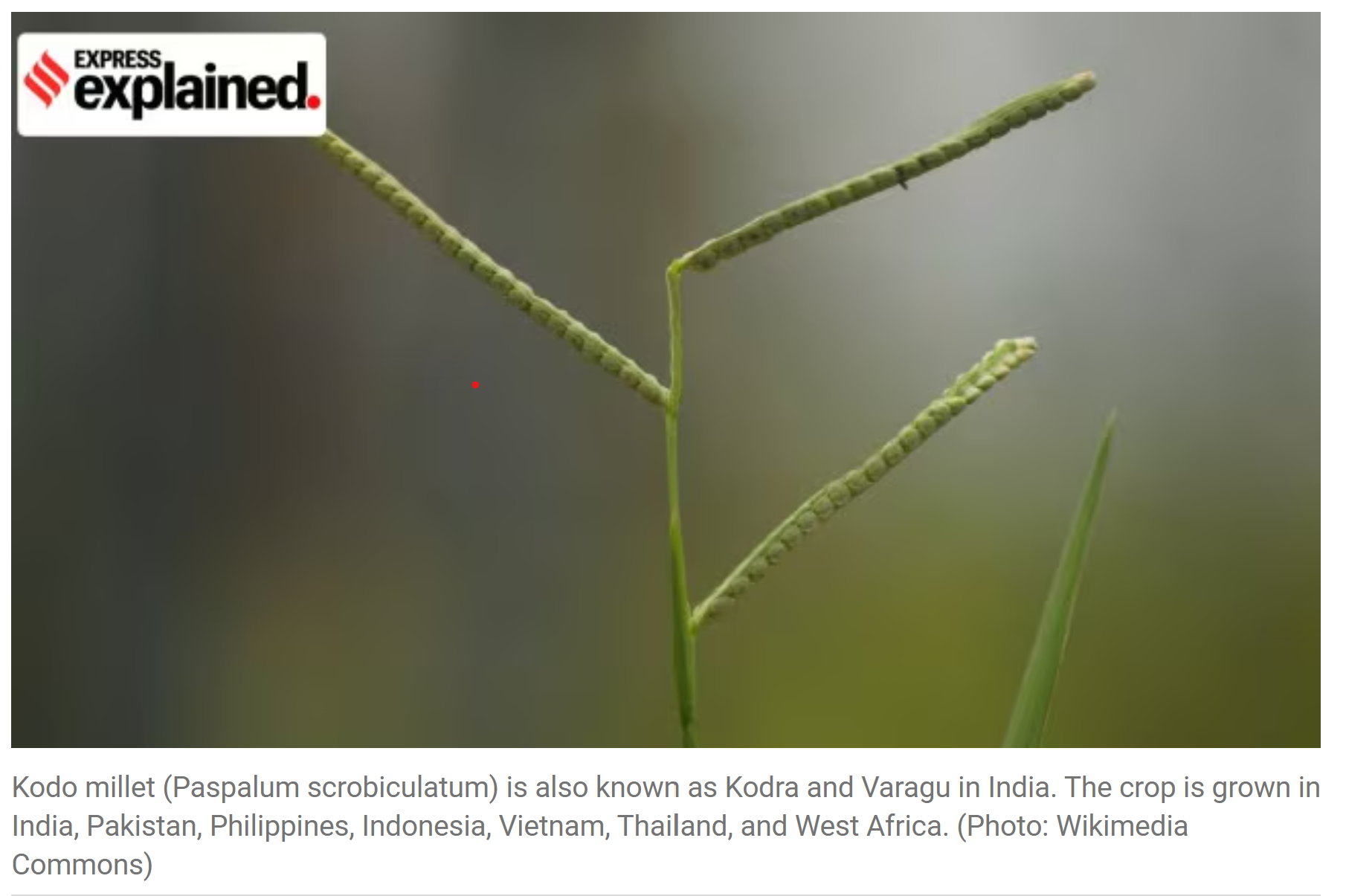
- 03 Nov 2024
In News:
Kodo millet is a staple food for many tribal and economically weaker sections in India. It is one of the 'hardiest crops, drought tolerant with high yield potential and excellent storage properties,' according to researchers
Background on Kodo Millet:
- Kodo millet (Paspalum scrobiculatum), also known as Kodra or Varagu, is a hardy, drought-tolerant crop widely grown in India, especially in Madhya Pradesh.
- It is a staple food for many tribal and economically weaker sections of India and is used to make various dishes like idli, dosa, and rotis.
- Kodo millet is valued for its high yield, nutritional benefits (rich in vitamins, minerals, antioxidants), and storage properties.
Incident in Bandhavgarh Tiger Reserve:
- 10 elephants from a herd of 13 died over three days in Madhya Pradesh’s Bandhavgarh Tiger Reserve.
- The cause of death was suspected to be mycotoxins associated with kodo millet, particularly Cyclopiazonic Acid (CPA), which is toxic to animals.
Historical Cases of Kodo Poisoning:
- The first human cases of kodo poisoning were reported in 1922 in the Indian Medical Gazette.
- Animals, including elephants, have also been affected by kodo millet consumption, with documented deaths as early as 1983.
- Cyclopiazonic Acid (CPA), a mycotoxin, was identified as the cause of kodo poisoning in the 1980s.
Why Does Kodo Millet Become Poisonous?
- Kodo millet is grown in dry and semi-arid regions and is vulnerable to fungal infections, particularly Ergot fungus, which produces CPA.
- When the crop encounters rainfall during maturing and harvesting, fungal infection can lead to "poisoned kodo," known locally as 'Matawna Kodoo' or 'Matona Kodo'.
- The mycotoxins in the infected millet are stable and resistant to standard food processing techniques.
Impact of Mycotoxins on Animals:
- Symptoms of poisoning: Vomiting, giddiness, unconsciousness, rapid pulse, cold extremities, limb tremors.
- Nervous and cardiovascular systems are primarily affected, causing liver dysfunction, heart damage, and gastrointestinal issues.
- In severe cases, consumption of infected kodo millet can cause death due to cardiovascular collapse and organ failure.
- Similar symptoms of depression and loss of mobility were observed in animal studies, including in mice.
Solution to Kodo Toxicity:
- Biocontrol agents (organisms that fight harmful pathogens) can help reduce fungal growth and mycotoxin production in kodo millet.
- Good agricultural practices: Sorting, proper storage in airtight containers, and avoiding moisture exposure during threshing can minimize contamination.
- Post-harvest management: Removing infected grains is crucial to preventing the spread of the disease.
Detection of Mycotoxins in Kodo Millet:
- Challenges: Mycotoxins are often undetectable by sight, and traditional methods like chromatography are time-consuming.
- Rapid detection tools: Enzyme-linked immunosorbent assays (ELISA), lateral flow assays (LFAs), and biosensors offer faster, on-site methods for detecting mycotoxins in kodo millet.
Centre for Science and Environment

- 03 Nov 2024
In News:
Centre for Science and Environment release a report on Extended Producer Responsibility (EPR) for Plastic Packaging
Key Findings:
- EPR Guidelines (2022) were a step towards enforcing the "polluter pays" principle, but the system faces significant issues in its implementation and registration processes.
- Centre for Science and Environment (CSE) report, released on October 29, 2024, highlights gaps in the EPR system for plastic packaging and suggests corrective actions.
EPR Guidelines Overview:
- Issued by: Union Ministry of Environment, Forest and Climate Change (MoEFCC).
- Objective: Hold producers, importers, brand owners (PIBOs), and plastic waste processors (PWPs) responsible for managing plastic packaging waste.
- Key Requirements:
- PIBOs must register on a centralized portal and set targets for collection, recycling, and reuse of plastic packaging.
- Registration involves compliance with targets on end-of-life recycling and recycled content usage.
Problems Identified in the Current EPR System:
- Low Registration and Enrollment:
- 41,577 registrations on the EPR portal, but a significant discrepancy in the type of stakeholders registered.
- 83% of registered entities are importers, 11% are producers, and only 6% are brand owners.
- Producers contribute 65% of the plastic packaging in the market but have low registration.
- Absence of Key Polluters:
- Manufacturers of virgin plastics are notably absent from the portal, despite being required to register.
- Fraudulent Practices:
- 700,000 fake certificates were generated by plastic recyclers, far exceeding the actual certificate generation capacity.
- The Central Pollution Control Board (CPCB) found that such fraudulent activities are undermining the integrity of the system.
- For example, end-of-life co-processing units (e.g., cement plants) claimed to have processed 335.4 million tonnes per annum of plastic waste, while their actual capacity is just 11.4 million tonnes per annum.
- Underreporting and Mismanagement:
- Despite 23.9 million tonnes of plastic packaging being introduced into the market, the CPCB’s estimation of plastic waste generation (4.1 MT annually) is underestimated.
- Lack of Stakeholder Representation:
- Urban local bodies and informal waste collectors—key contributors to plastic waste management—are not included in the EPR framework, which limits their incentives and support.
Recommendations for Improvement:
- Incorporate the Informal Sector:
- Recognize informal waste collectors and waste management agencies in the EPR framework to improve traceability and ensure better waste management.
- Eliminate Fraudulent Practices:
- Strict actions need to be taken against fraudulent recyclers and fake certificate issuers to restore credibility to the EPR system.
- Establish Fair Pricing for EPR Certificates:
- Undertake baseline cost studies to determine the true costs of plastic waste management, ensuring fair pricing for recycling certificates and preventing undervaluation.
- Standardize Packaging:
- Focus on product standardization to ensure that packaging materials are uniform and easily recyclable.
- Strengthen Monitoring:
- Improve oversight on the registration process and ensure that all polluters (producers, importers, brand owners) comply with the system’s guidelines.
EPR and Plastic Waste Management: Context and Importance
- Extended Producer Responsibility (EPR) is a policy approach where the responsibility of managing the entire lifecycle of plastic products (from production to disposal) lies with the producer.
- It is an essential part of India’s Plastic Waste Management Rules (2016), which mandate the recycling and proper disposal of plastic packaging waste.
Key Elements of EPR:
- Producer Accountability: Producers are responsible for the take-back, recycling, and final disposal of plastic packaging.
- Waste Minimization: Encourages reducing waste at the source by promoting sustainable packaging designs.
- Lifecycle Approach: Considers the entire lifecycle of the product, focusing on sustainability from production to disposal.
- Polluter Pays Principle: Ensures that the cost of waste management is borne by those responsible for generating the waste.
National Biodiversity Strategy and Action Plan (NBSAP) 2024-2030
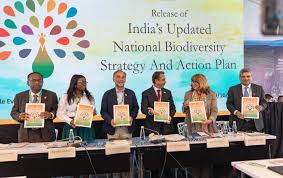
- 03 Nov 2024
In News:
The updated NBSAP was released by India at the 16th Conference of Parties (COP16) to the Convention on Biological Diversity (CBD).
Overview of the NBSAP (2024-30):
- Title:Updated National Biodiversity Strategies and Action Plan: A Roadmap for Conservation of India’s Biodiversity.
- Objective: To provide a comprehensive roadmap for biodiversity conservation, aligning with global frameworks like the Kunming-Montreal Global Biodiversity Framework (KMGBF).
Key Features of the Updated NBSAP:
- Alignment with Global Frameworks:
- The Kunming-Montreal Global Biodiversity Framework (KMGBF) adopted in 2022 aims to halt and reverse biodiversity loss by 2030.
- India’s updated NBSAP aligns with KMGBF’s goals, focusing on biodiversity conservation, sustainable resource use, and ensuring fair benefit-sharing.
- 23 National Biodiversity Targets:
- The targets are focused on three key themes:
- Reducing threats to biodiversity
- Ensuring sustainable use of biodiversity
- Enhancing tools for biodiversity implementation
- The targets are focused on three key themes:
- Key Domains of Focus:
- Area-based conservation: Protecting ecosystems and habitats.
- Ecosystem resilience: Enhancing the ability of ecosystems to withstand environmental stressors.
- Recovery and conservation of threatened species.
- Conservation of agrobiodiversity: Ensuring the sustainability of agricultural biodiversity.
- Sustainable management of biodiversity.
- Enabling tools and solutions: Including financial and technical support for implementation.
- Financial Plan and Expenditure:
- Biodiversity Expenditure Review (BER) estimated an average annual expenditure of Rs 32,20,713 crore (FY 2017-2022) for biodiversity conservation.
- Future funding requirements (FY 2024-2030) estimated at Rs 81,664.88 crore annually at the central government level.
- Biodiversity Finance Plan suggests financing solutions, including public finance, corporate social responsibility (CSR), Ecological Fiscal Transfer (EFT), and Access and Benefit Sharing (ABS) mechanisms.
- Capacity Building:
- The NBSAP stresses the need for capacity building across various levels—national, state, and local.
- Focus on skills acquisition for biodiversity management and enhancing knowledge to implement conservation strategies.
Implementation Framework:
- Multi-Level Governance:
- At the national level, the Ministry of Environment, Forest, and Climate Change (MoEFCC) will oversee implementation with involvement from 22 other ministries.
- State-level: Involves State Biodiversity Boards and Union Territory Biodiversity Councils.
- Local level: Community-driven efforts through Biodiversity Management Committees.
- BIOFIN and Resource Mobilization:
- India is recognized as a leading country in the implementation of the Biodiversity Finance Initiative (BIOFIN).
- Encouragement for private entrepreneurs, businesses, and international donors to invest in biodiversity through innovative financial instruments like:
- Green Bonds
- Green Funds
- Payment for Ecosystem Services (PES)
- Incentives for Financial Solutions:
- India aims to explore funding from corporate social responsibility (CSR), ecological fiscal transfers, and access and benefit sharing mechanisms to meet the financial needs for biodiversity conservation.
Challenges and Strategies:
- Challenges India Faces:
- Habitat fragmentation
- Pollution
- Illegal wildlife trade
- Adverse effects of climate change
- Strategic Responses:
- The updated NBSAP provides strategies to address these challenges, ensuring comprehensive conservation and sustainable use of biodiversity.
Wildlife Crime Control Bureau (WCCB)
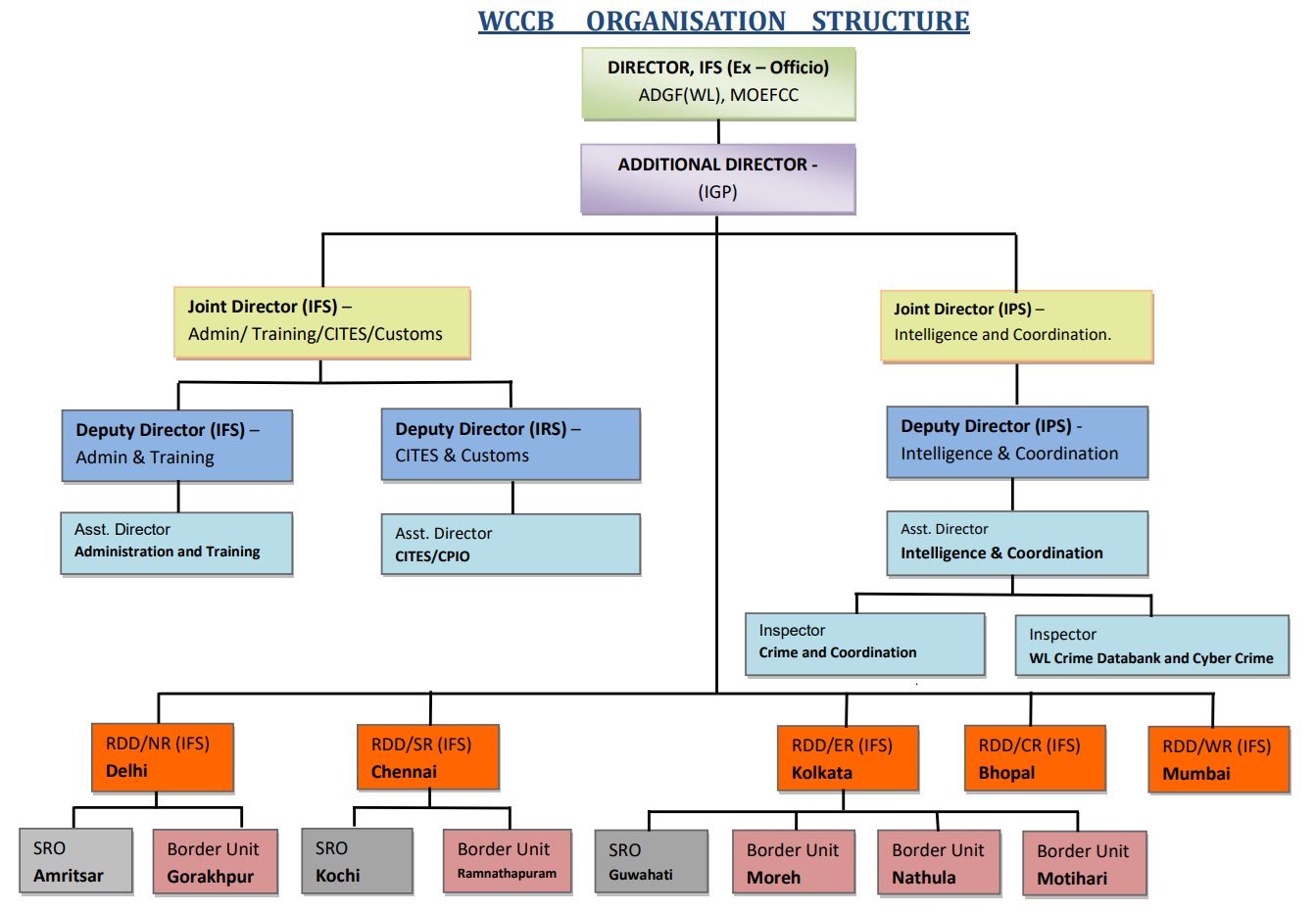
- 03 Nov 2024
In News:
The Wildlife Crime Control Bureau (WCCB) of the Ministry of Environment, Forest and Climate change has constituted a team to enquire into the death of ten elephants in Bandhavgarh Tiger Reserve of Madhya Pradesh. The team is conducting an independent enquiry in the matter.
- Incident Overview:
- Ten elephants found dead in Bandhavgarh Tiger Reserve, Madhya Pradesh, between October 29-31, 2024.
- Preliminary cause of death suspected to be poisoning; final cause pending postmortem and toxicological analysis.
- Government Actions:
- Union Government:
- The Wildlife Crime Control Bureau (WCCB) has set up a team to conduct an independent investigation into the deaths.
- Madhya Pradesh Government:
- Constituted a five-member State-level inquiry committee, headed by the Additional Principal Chief Conservator of Forests (APCCF, Wildlife).
- Committee includes members from civil society, scientists, and veterinarians.
- The State Tiger Strike Force (STSF) is conducting field investigations, combing surrounding areas for further clues.
- Other Involved Authorities:
- The Principal Chief Conservator of Forests (PCCF) and Chief Wildlife Warden of Madhya Pradesh are directly supervising the inquiry in Bandhavgarh.
- Senior officials from the National Tiger Conservation Authority (NTCA) have visited the site for discussions and investigation.
- Union Government:
About Wildlife Crime Control Bureau (WCCB):
- Mandate:
- Combats organized wildlife crime through intelligence gathering and coordination with enforcement agencies.
- Develops wildlife crime data and assists in prosecutions.
- Provides capacity building for wildlife crime enforcement agencies.
- Operations & Initiatives:
- Conducts operations like SAVE KURMA, THUNDERBIRD, WILDNET, and more to counter wildlife crimes.
- Nodal Ministry: Ministry of Environment, Forest and Climate Change.
- Headquarters: New Delhi.
Melanistic Tigers
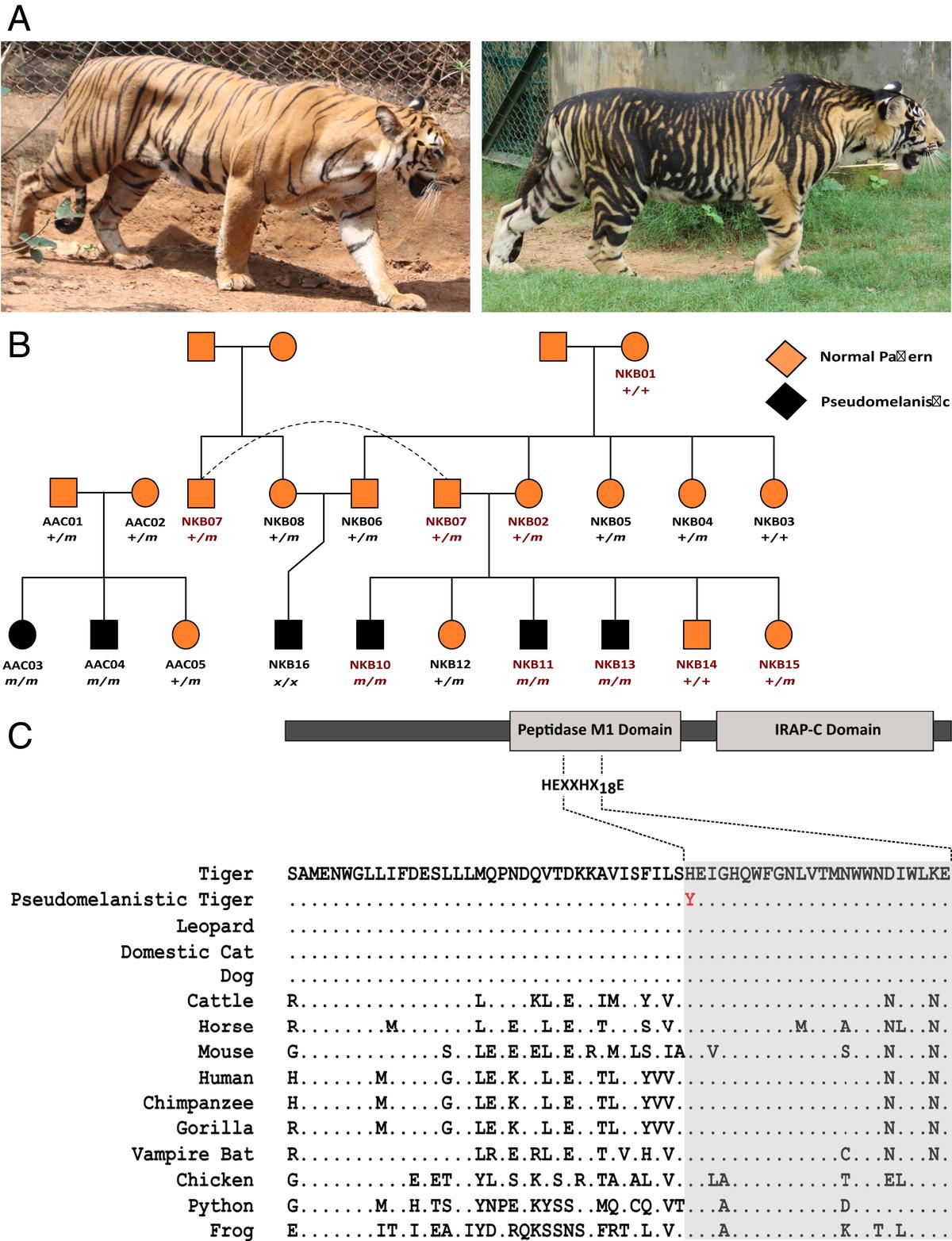
- 01 Nov 2024
In News:
- Odisha government relocated a tigress from Maharashtra’s Tadoba-Andhari Tiger Reserve to Similipal Tiger Reserve, Odisha, to address inbreeding issues among the tiger population.
- The tigress is part of a genetic diversification plan to remedy the increasing number of pseudo-melanistic tigers in the region.
Pseudo-melanistic Tigers:
- Pseudo-melanistic tigers, often referred to as "black tigers," exhibit a darker coat with broader, more prominent stripes.
- The mutation leads to the appearance of a mostly black fur, with occasional white-orange stripes.
Genetic Basis:
- This coloration is due to a mutation in the Taqpep gene, which causes the widening and darkening of stripes on the tiger's coat.
- The mutation is linked to genetic drift and inbreeding within the isolated Similipal population.
Historical Context:
- These tigers were once considered mythical until the 1700s, with sightings only being documented in the 1990s and 2017-18.
- The first confirmed genetic evidence of the black tiger appeared when a cub was born in captivity at Oklahoma City Zoo in the 1970s.
Distribution and Prevalence:
- Pseudo-melanistic tigers are predominantly found in Similipal Tiger Reserve, with 27 out of 30 tigers in Odisha exhibiting the trait.
- Other instances of such tigers exist in captivity, such as in Nandankanan Zoological Park (Bhubaneswar) and Arignar Anna Zoological Park (Chennai), both tracing ancestry to Similipal.
Genetic Studies:
- A 2021 study by the National Centre for Biological Sciences (NCBS) linked the Taqpep gene mutation to the unique appearance of these tigers.
- The mutation causes a missense change in the gene, replacing Cytosine with Thymine (C1360T), altering the tiger’s coat pattern.
High Frequency of Mutation in Similipal:
- Genetic analyses indicate a high frequency of the Taqpep gene mutation in Similipal tigers, with a 60% chance that a tiger born there will carry the mutated gene.
- Inbreeding and genetic isolation have contributed to this phenomenon, as Similipal’s tiger population is geographically cut off from other populations.
MhadeiWildlife Sanctuary
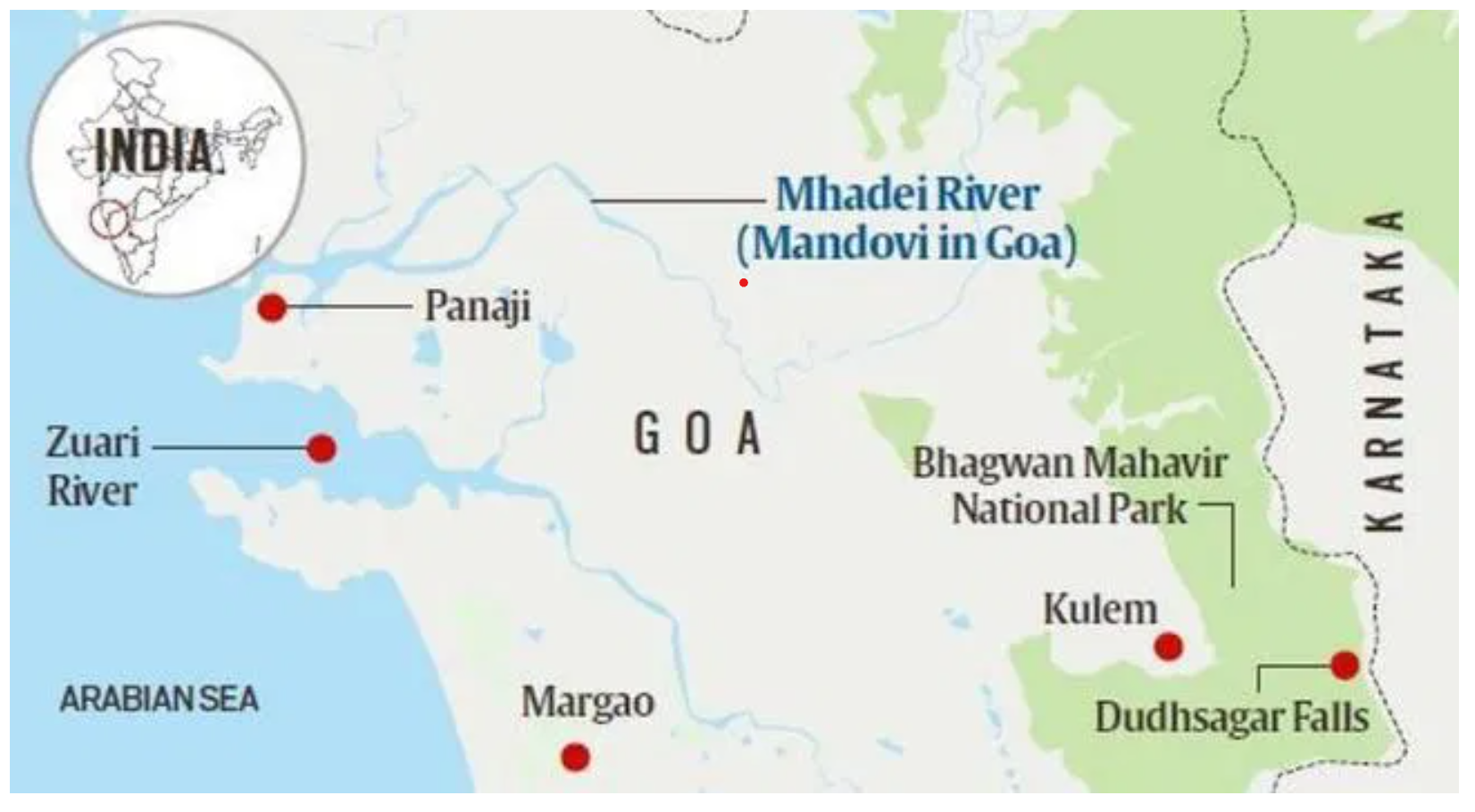
- 01 Nov 2024
In News:
An adult tigress and three cubs have been spotted in the Mhadei wildlife sanctuary in Goa marking the first time evidence of the species has been recorded in the forests bordering the states of Maharashtra and Karnataka since 2020.
Key Highlights:
Location and Geography:
- It is located near Chorla Ghat, between North Goa and Belgavi, and borders Maharashtra and Karnataka.
- The sanctuary is traversed by the Mhadei River, which meets the sea at Panaji, Goa.
Ecological Significance:
- It is part of the Western Ghats, a UNESCO World Heritage site, and shares this ecosystem with Mollem National Park and other protected areas in Goa.
- The sanctuary is integral to wildlife corridors connecting the Sahyadri Tiger Reserve (Maharashtra) and Kali Tiger Reserve (Karnataka), critical for tiger conservation.
Flora and Fauna:
- It is home to diverse wildlife, including the critically endangered Long-billed vultures that nest at Vazra Falls.
- The region supports a variety of flora and fauna due to its biodiversity-rich Western Ghats ecosystem.
Conservation Status and Recommendations:
- Goa is the only state in India to have its entire portion of the Western Ghats under state protection, with Mhadei WLS being a key area.
- The National Tiger Conservation Authority (NTCA) has recommended that Mhadei WLS be designated as a tiger reserve to enhance protection efforts.
- The sanctuary is a potential candidate for inclusion under Project Tiger.
- In 2020, a Royal Bengal tigress and her cubs were tragically poisoned due to human-animal conflict.
Mahadayi Water Dispute:
- The Mahadayi (Madei, Mandovi) River is a source of dispute between Karnataka and Goa regarding water sharing.
- Karnataka seeks to divert water from the river to the Malaprabha River basin for drinking water supply in several districts, through the Kalasa-Banduri Nala project.
- The matter is currently being heard in the Supreme Court.
Report of The Lancet Countdown on Health and Climate Change, 2024

- 30 Oct 2024
In News:
The 2024 edition of The Lancet Countdown on Health and Climate Change presents critical insights into the intersection of health and climate change.
Key Findings from the 2024 Report
- Air Pollution and Mortality in India:
- In 2021, air pollution was responsible for 1.6 million deaths in India.
- Fossil fuels (coal and liquid gas) were identified as major contributors, accounting for 38% of these deaths.
- India was ranked as the second-highest emitter of PM2.5 globally in 2022, contributing 15.8% of consumption-based and 16.9% of production-based PM2.5 emissions.
- Impact of Heat Stress:
- In 2023, India experienced 2400 hours (or 100 days) of moderate to high heat stress, particularly during light outdoor activities like walking.
- Heatwaves have become more frequent, with adults over 65 years experiencing 8.4 heatwave days per year, a 58% increase from 1990-1999.
- This increased heat exposure has led to a loss of 181 billion labor hours globally, translating into an economic loss of approximately $141 billion.
- Global and National Trends in Air Pollution:
- PM2.5 is particularly hazardous because it is fine enough to enter the lungs and bloodstream, leading to severe health risks like respiratory and cardiovascular diseases.
- Nitrogen Dioxide (NO?), Sulphur Dioxide (SO?), Carbon Monoxide (CO), and Ozone (O?) were identified as other pollutants contributing to poor air quality in India.
- Health Impact of Extreme Weather:
- The 2023 heatwave was one of the hottest years on record, exacerbating health risks worldwide, especially for the elderly.
- Droughts and heatwaves also contributed to a rise in food insecurity, affecting millions globally.
- Disease Transmission and Climate Change:
- Dengue transmission potential rose by 85% from 1951-1960 to 2014-2023.
- Coastal areas suitable for the spread of Vibrio pathogens, which cause cholera, expanded by 23%, affecting over 210 million people.
- Health Effects of Fossil Fuel Pollution:
- Continued reliance on fossil fuels worsens air quality, leading to health problems such as respiratory diseases, cardiovascular issues, and adverse pregnancy outcomes.
Government Efforts to Tackle Air Pollution in India
- National Clean Air Programme (NCAP):
- NCAP is a national strategy to reduce air pollution across India, with specific action plans for 131 non-attainment cities. The initiative is supported through various central government schemes such as:
- Swachh Bharat Mission (Urban)
- Atal Mission for Rejuvenation and Urban Transformation (AMRUT)
- Smart City Mission
- Faster Adoption and Manufacturing of Hybrid and Electric Vehicles (FAME-II)
- NCAP is a national strategy to reduce air pollution across India, with specific action plans for 131 non-attainment cities. The initiative is supported through various central government schemes such as:
- Bharat Stage VI (BS-VI) Emission Norms:
- BS-VI standards aim to significantly reduce vehicular pollution, lowering permissible limits for NOx and particulate matter (PM) emissions from vehicles.
- System of Air Quality and Weather Forecasting and Research (SAFAR):
- SAFAR measures air quality and provides forecasts for metropolitan cities based on real-time data, helping authorities take preventive actions.
- Promotion of Renewable Energy:
- India achieved a record 11% of electricity from renewable energy in 2022. However, 71% of India’s electricity still comes from coal, underscoring the need for a faster transition to cleaner energy sources.
Greenhouse Gas Levels Hit Record High in 2023: World Meteorological Organization (WMO)

- 29 Oct 2024
In News:
According to the WMO, the last time the earth had a similar CO2 concentration was 3-5 million years ago, when temperatures were 2-3°C higher and sea levels were 10-20 metres higher than they are now
Key Highlights:
- Record High Greenhouse Gas (GHG) Levels:
- In 2023, annual mean carbon dioxide (CO2) levels rose by 2.3 parts per million (ppm), reaching a new record of 420 ppm.
- This marks the 12th consecutive year with an increase of over 2 ppm in CO2 levels.
- Historical Context:
- CO2 levels not seen in 3-5 million years, when temperatures were 2-3°C higher, and sea levels were 10-20 meters higher than they are today.
- Key GHGs at Record Highs:
- The globally averaged surface concentrations of CO2, methane, and nitrous oxide all reached new highs in 2023.
- Contributors to the Increase in CO2:
- Natural Variability: Natural factors such as large vegetation fires and reduced carbon absorption by forests contributed to higher CO2 levels.
- Human Activity: High fossil fuel emissions from human and industrial activities also played a major role.
- El Niño Phenomenon: The El Niño event led to higher temperatures and drier conditions, exacerbating the rise in GHG levels through increased wildfires and reduced carbon absorption by land sinks.
- Climate Feedback Loop Concerns:
- The WMO warned of a vicious cycle:
- Climate change could cause ecosystems to become larger sources of GHGs.
- Wildfires could release more carbon, and warmer oceans may absorb less CO2, leading to more CO2 remaining in the atmosphere, accelerating global warming.
- The WMO warned of a vicious cycle:
- Radiative Forcing:
- Radiative forcing (the warming effect on climate) from long-lived GHGs has increased by 51.5% from 1990 to 2023, with CO2 contributing 81% of this increase.
- Methane Concerns:
- Methane saw its largest three-year increase between 2020 and 2022.
- This increase was linked to warmer temperatures and wetter land conditions during the 2020-2022 La Niña conditions, which caused an uptick in methane emissions from natural wetlands.
- Long-Term Impact of CO2:
- Given CO2's long atmospheric lifetime, even with rapid emissions reductions, the warming effect will persist for several decades.
Emissions Gap Report 2024

- 28 Oct 2024
In News:
The United Nations Environment Programme (UNEP) recently published the Emissions Gap Report 2024, in anticipation of the COP29 meeting of the UNFCCC to be held in Baku, Azerbaijan.
Key Highlights:
- Current Trajectory of Global Warming:
- If countries continue with current environmental policies, global temperatures are expected to rise by 3.1°C above pre-industrial levels.
- This is significantly higher than the Paris Agreement target of limiting global warming to well below 2°C, with an effort to cap it at 1.5°C.
- Paris Agreement at Risk:
- Even if all Nationally Determined Contributions (NDCs) are fully implemented (including both unconditional and conditional emissions reduction targets), the world would still experience 2.6°C of warming by 2030.
- This presents a major challenge to achieving the Paris Agreement’s climate goals.
- Urgent Need for Action:
- To limit global warming to 1.5°C, greenhouse gas emissions must peak before 2025 and decline by 43% by 2030.
- The report highlights the emission gap between current pledges and what is required to meet the 1.5°C goal.
- Record High Emissions:
- Global greenhouse gas emissions hit a record 57.1 gigatons of CO? equivalent in 2023.
- This represents an increase of 1.3% compared to 2022, continuing the upward trend from the previous decade.
- India’s Emissions:
- India’s greenhouse gas emissions grew by 6.1% between 2022 and 2023.
- Per capita emissions in India were 2.9 tCO?e in 2022, significantly lower than China (11 tCO?e) and the U.S. (18 tCO?e).
- G20 Countries’ Contribution:
- G20 countries, excluding the African Union, contributed 77% of global emissions in 2023.
- The six largest emitters (including China, U.S., and India) were responsible for 63% of global emissions.
- This shows a significant imbalance in emissions, with developed countries having much higher per capita emissions compared to developing nations like India and Africa.
- Necessary Emissions Cuts:
- To keep the 1.5°C target within reach, global emissions need to be cut by at least 7.5% annually until 2035.
- Cost of bridging the emissions gap: Achieving net-zero by 2050 will require USD 900 billion to USD 2.1 trillion annually, approximately 1% of global GDP.
- Emission Reduction Pathways:
- Renewable Energy: Scaling up solar and wind energy technologies could contribute up to 27% of the required emissions reductions by 2030.
- Forest Conservation: Protecting and restoring forests could provide 20% of the required emissions reductions by 2030.
- Other crucial measures include improving energy efficiency, transitioning to electric vehicles, and focusing on fuel switching in key sectors like transport, industry, and buildings.
- Disparities in Emissions:
- Despite changes over the past two decades, large disparities remain between emissions across regions.
- Developed countries have three times higher per capita emissions compared to the global average, while India, the African Union, and least developed countries continue to have much lower emissions.
- Call to Action:
- UNEP Executive Director Inger Andersen urged countries to act now, stating: “No more hot air, please.” The urgency is to ramp up climate pledges and ensure stronger actions in the upcoming COP29 talks in Baku, Azerbaijan (November 2024), where nations must work to get on a 1.5°C pathway.
United Nations Environment Programme (UNEP)
- Established: 1972, following the United Nations Conference on the Human Environment in Stockholm.
- Headquarters: Nairobi, Kenya.
- Governing Body: The United Nations Environment Assembly (UNEA), which is the world’s highest-level decision-making body on environmental matters, with 193 Member States.
- Programs & Initiatives: UNEP leads global efforts on climate action, ecosystem restoration, clean seas, and supports the Sustainable Development Goals (SDGs).
- Reports: UNEP publishes crucial assessments like the Emissions Gap Report, Global Environment Outlook, and Adaptation Gap Report, influencing global environmental policies.
Hong Kong Discovers Dinosaur Fossils
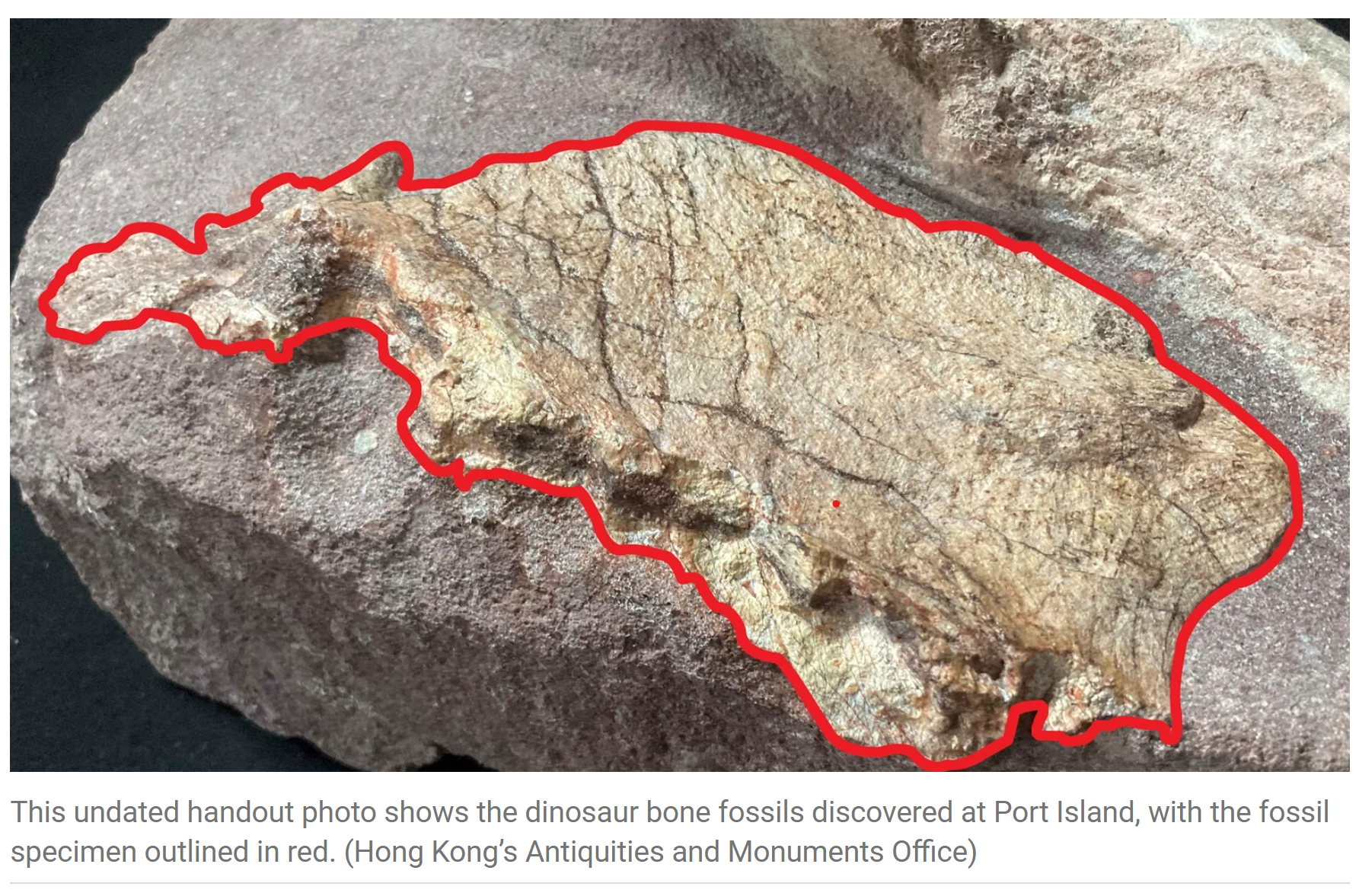
- 28 Oct 2024
In News:
Hong Kong discovers dinosaur fossils for the first time
Key Details:
-
- Significance: This marks the first-ever discovery of dinosaur fossils in Hong Kong.
- Time Period:The fossils date back to the Cretaceous Period, approximately 145 million to 66 million years ago.
- Fossil Details:The fossils belong to a large dinosaur, but further studies are required to determine the exact species.Initial analysis suggests the dinosaur may have been buried by sand and gravel after death, later being washed to the surface by a flood before being buried again.
- Site and Protection:Port Island, part of a geopark, is closed to the public to facilitate ongoing fossil investigations and excavation work.
- Geological and Archaeological Importance:The discovery underscores the significance of Hong Kong's geoparks and its role in preserving and showcasing natural history.This finding contributes to global understanding of prehistoric life, especially in the Cretaceous period.
2024 Global Nature Conservation Index (NCI)
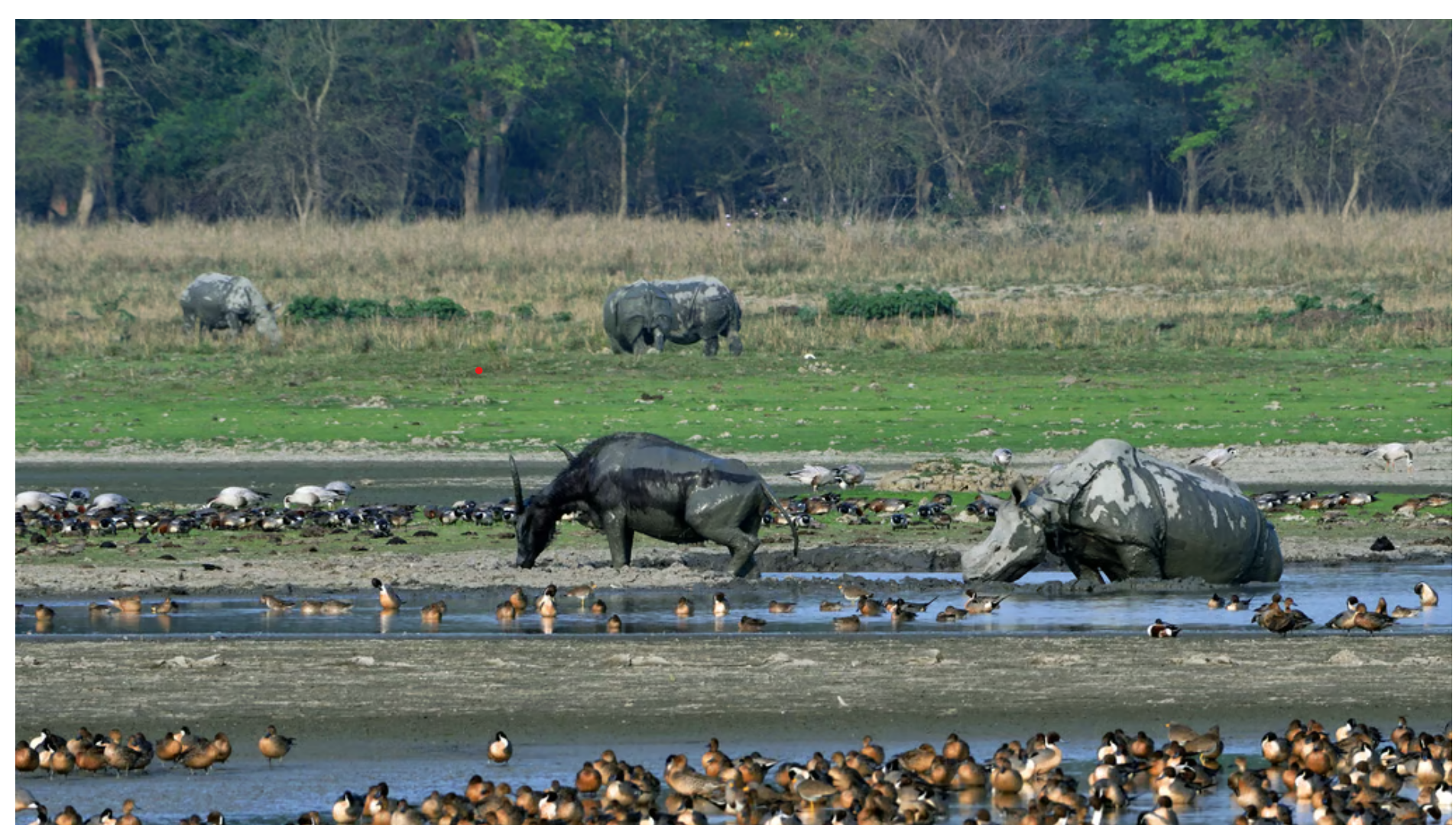
- 28 Oct 2024
In News:
India with an abysmal score of 45.5 (out of 100) has been ranked 176th in the Global Nature Conservation Index, 2024.
India's Ranking and Score:
- Rank: India ranks 176th out of 180 countries.
- Score: 45.5 out of 100.
- Context: India is listed among the five "worst performers," alongside Kiribati (180), Turkey (179), Iraq (178), and Micronesia (177).
Key Factors Affecting India’s Ranking:
- Inefficient Land Management: The main contributing factor to India's low ranking.
- Threats to Biodiversity: Rising threats due to habitat loss, deforestation, climate change, and pollution.
- Deforestation: Between 2001 and 2019, India lost 23,300 sq. km of tree cover, exacerbating biodiversity loss.
Focus Areas of the Nature Conservation Index (NCI):
- Land Management: Inefficient land use practices, with 53% of land converted for urban, industrial, and agricultural purposes.
- Biodiversity Threats: Habitat loss, fragmentation, and declining populations of marine and terrestrial species.
- Governance and Capacity: Challenges in enforcement of laws and governance structures that support conservation.
- Future Trends: India faces both opportunities and challenges, given its high population density and rapid development.
Key Findings:
- Land Conversion and Urbanization: High rates of land conversion (53%) for development purposes, contributing to habitat loss.
- Soil Pollution: Issues with pesticide use and soil pollution (low nitrogen index of 0.77), affecting soil health.
- Marine Conservation: Only 0.2% of national waterways and none within the Exclusive Economic Zone (EEZ) are protected.
- Deforestation Impact: Loss of 23,300 sq. km of forest between 2001-2019.
- Biodiversity Decline: Despite 40% of marine species and 65% of terrestrial species in protected areas, biodiversity continues to decline—67.5% of marine species and 46.9% of terrestrial species face population decreases.
Marine and Terrestrial Conservation:
- Marine Areas: Need for greater investment in marine conservation, as India's marine protected areas (MPAs) are limited.
- Protected Areas: While 7.5% of India’s terrestrial area is protected, significant threats like climate change and habitat fragmentation persist.
Biodiversity and Climate Change:
- Climate Change Risks: Impacts on vulnerable ecosystems, including coral reefs and alpine regions, further threaten biodiversity.
- Population Growth: India’s rapidly growing population (one of the highest in the world) places constant pressure on natural resources and ecosystems.
Illegal Wildlife Trade:
- Global Ranking: India is the fourth-largest illegal wildlife trader globally, with an annual trade worth approximately £15 billion.
- Call for Action: Stronger enforcement of wildlife protection laws and international cooperation are crucial to combat illegal wildlife trade.
SDGs and India’s Conservation Challenges:
- SDG 14 (Life Below Water) and SDG 15 (Life on Land): India faces significant challenges in meeting these Sustainable Development Goals, particularly in protecting marine life and terrestrial ecosystems.
Recommendations for Improvement:
- Stronger Political Will: Political commitment is essential for passing laws that promote sustainable development and biodiversity conservation.
- Enforcement and Funding: Increased funding for environmental initiatives and better enforcement of conservation policies are necessary to address the conservation challenges.
- Sustainable Development: Integrating sustainable land use practices and improving governance structures for conservation are key areas for focus.
Pandemic Fund Project
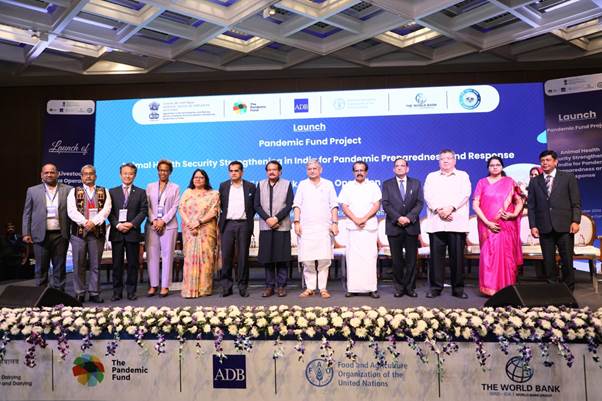
- 27 Oct 2024
In News:
Recently, the Union Minister Shri Rajiv Ranjan Singh, Ministry of Fisheries, Animal Husbandry and Dairying launched the Pandemic Fund Project on "Animal Health Security Strengthening in India for Pandemic Preparedness and Response"in New Delhi.
Key Highlights:
Launch of Pandemic Fund Project
- Objective: Strengthening animal health security in India to enhance pandemic preparedness and response.
- Funding: $25 million initiative funded by the G20 Pandemic Fund.
- Location: New Delhi, Ministry of Fisheries, Animal Husbandry, and Dairying.
Context and Importance
- Livestock Sector: Crucial for socio-economic upliftment, contributing to employment and rural development.
- Growth in Livestock Sector: Significant progress in the last 9 years through schemes like the National Animal Disease Control Program (NADCP).
- Key Diseases Targeted:
- Foot and Mouth Disease (FMD): Aimed at eradication, with over 90.87 crore vaccines administered.
- Brucellosis: Over 4.23 crore vaccines administered.
Objectives of the Pandemic Fund Project
- Enhanced Disease Surveillance: Includes genomic and environmental monitoring for early warning systems.
- Laboratory Infrastructure Development: Upgradation for better diagnosis and disease management.
- Cross-Border Collaboration: Strengthening partnerships for global monitoring of zoonotic diseases.
- Integrated Monitoring System: Creation of a robust system for managing zoonotic diseases, with a focus on early detection and containment.
Documents Released for Strengthening Animal Health
- Standard Veterinary Treatment Guidelines (SVTG):
- Best practices for veterinary care to improve livestock health and productivity.
- Supports national action plans, especially for combating antimicrobial resistance.
- Crisis Management Plan (CMP) for Animal Diseases:
- Framework for effective response and containment during animal disease outbreaks.
- Ensures timely mitigation of animal disease crises.
One Health Approach
- Integration of Human, Animal, and Environmental Health: Key to preventing and managing future health crises.
- Zoonotic Risks: The project emphasizes reducing zoonotic disease transmission from animals to humans, crucial given the origins of many recent public health emergencies.
Implementation and Collaboration
- The project will be executed in collaboration with global institutions:
- Asian Development Bank (ADB)
- Food and Agriculture Organization (FAO)
- World Bank
Great Indian Bustard (GIB)
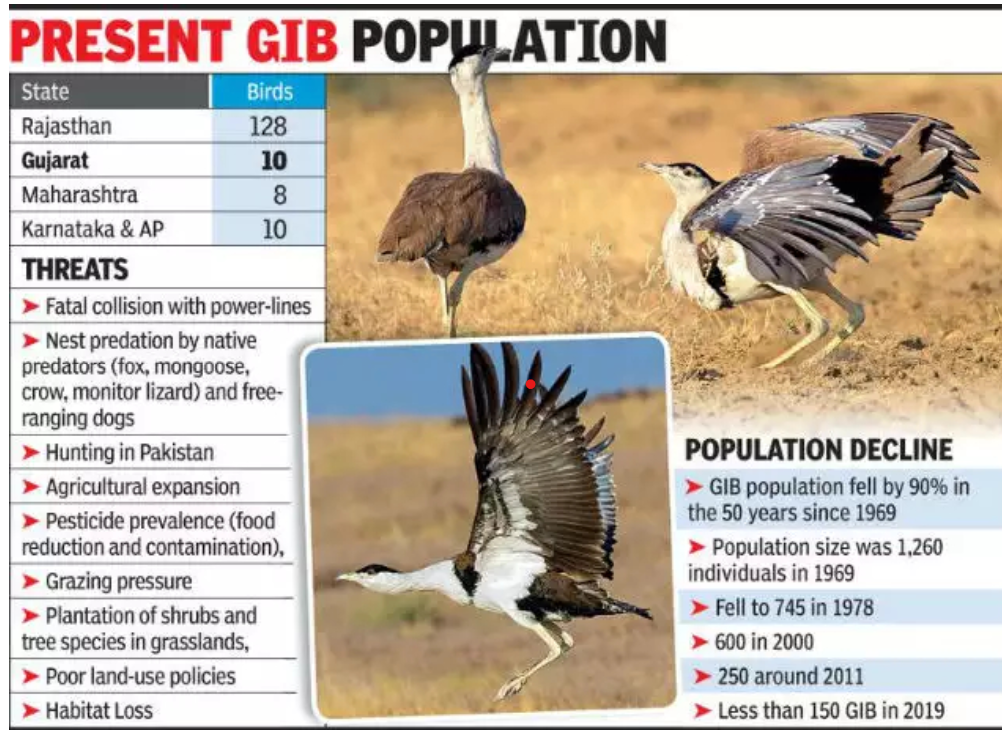
- 25 Oct 2024
A critically endangered Great Indian Bustard (GIB) chick was successfully born through artificial insemination (AI) at a breeding center in Jaisalmer, Rajasthan, marking a crucial step in efforts to save the species.
Endangered Status:
- The Great Indian Bustard is classified as critically endangered with fewer than 150 individuals left in the wild in India.
- About 90% of these birds are found in the desert areas of Rajasthan, with smaller populations in Gujarat, Maharashtra, Andhra Pradesh, and Karnataka.
Main Threats to the Species:
- Habitat Loss: The primary threat is the loss of habitat, which is often perceived as wasteland and is diverted for infrastructure projects like roads and development.
- Slow Reproductive Rate: The bustard’s low reproductive rate exacerbates its risk of extinction.
Conservation Efforts: Bustard Recovery Program
- In 2016, the Union Ministry of Environment, Forests and Climate Change launched the Bustard Recovery Program to focus on captive breeding and creating a sustainable environment for the reintroduction of GIBs into the wild.
- A dedicated GIB breeding center was set up at the Desert National Park in Jaisalmer, Rajasthan, as part of this initiative.
- Protection Status of GIB:
- IUCN: Critically Endangered
- CITES: Appendix 1
- Convention on Migratory Species (CMS): Appendix I
- Wildlife (Protection) Act, 1972: Schedule I
- It is also the state bird of Rajasthan, emphasizing its importance in the region’s biodiversity.
Tenkana

- 23 Oct 2024
In News:
- A team of arachnologists has discovered a new genus of jumping spiders, Tenkana, found across southern India and northern Sri Lanka.
- The discovery includes two previously known species, Tenkanamanu and Tenkanaarkavathi, and introduces a new species, Tenkanajayamangali, from Karnataka.
Name and Origin:
- The name Tenkana comes from the Kannada word for "south," reflecting the geographical region where all known species of this genus are found—southern India and northern Sri Lanka.
- The genus belongs to the Plexippina subtribe of jumping spiders, which is distinct from related genera like Hyllus and Telamonia.
Key Findings:
- Tenkanajayamangali was first discovered in Devarayanadurga reserve forest, Tumakuru district, Karnataka, at the origin of the Jayamangali river.
- The new species was identified through genetic analysis and physical examination, showing it did not match any known species.
Physical Characteristics:
- The male and female Tenkanajayamangali exhibit distinct physical differences.
- The male has pale hairs covering most of its carapace, while the female is grey with a pattern.
- The ocular area of T. jayamangali is uniformly covered with white hairs, in contrast to T. arkavathi and T. manu, which have distinctive markings.
Habitat and Distribution:
- Tenkana spiders are typically ground-dwelling and prefer dry, open habitats like short grasses, leaf litter, and rocky outcrops.
- These spiders have been observed in Tamil Nadu, Puducherry, Karnataka, Telangana, Andhra Pradesh, and some areas in Sri Lanka.
- The male and female spiders of T. jayamangali were discovered in different regions, 2 km apart, at the hilltop and foothills of the same forest.
Ecological and Behavioral Insights:
- The Tenkana genus is considered endemic to India, with species observed in diverse regions such as Bengaluru, Yercaud (Tamil Nadu), and Bannerghatta (Karnataka).
- These spiders are found in complex microhabitats, like shaded short grasses with dry leaf litter or rocky outcrops in relatively dry habitats.
- The movement of Tenkana spiders resembles that of Stenaelurillus, another ground-dwelling spider species.
The case for a nature restoration law in India

- 22 Oct 2024
In News:
The Nature Restoration Law (NRL), which was enacted by the European Union (EU), is an inspiring model from which India can draw points to tackle its growing environmental crises.
Background of the NRL in the EU
- The Nature Restoration Law (NRL) was enacted by the European Union (EU) to restore ecosystems and combat biodiversity loss.
- Adopted on June 17, 2024, by the EU’s Environmental Council.
- Key objectives:
- Restore 20% of EU’s land and sea areas by 2030.
- Achieve full restoration of all ecosystems by 2050.
- Part of the EU’s Biodiversity Strategy for 2030 and European Green Deal.
- Target Areas:
- Forests, agricultural lands, rivers, urban spaces.
- Restoration measures include:
- 25,000 km of free-flowing rivers.
- Planting 3 billion trees by 2030.
- Global Impact: NRL is a critical tool in reversing Europe’s biodiversity loss, where 80% of habitats are in poor condition.
Environmental Crisis in India
- Land Degradation:
- 29.7% of India’s total geographical area is affected by land degradation (as per ISRO’s Desertification and Land Degradation Atlas, 2018-19).
- 97.85 million hectares of land degraded, with a significant increase since 2003-05.
- Major desertification hotspots in Gujarat, Karnataka, Maharashtra, and Rajasthan.
- Desertification: A growing concern, affecting 83.69 million hectares in 2018-19.
- Ongoing Efforts:
- Green India Mission, Pradhan Mantri Krishi Sinchayee Yojana, and National Afforestation Programme have had positive effects.
- Integrated Watershed Management Programme is the second-largest watershed programme globally.
Need for a Comprehensive Nature Restoration Law in India
- The scale of India’s environmental challenges requires a comprehensive nature restoration law similar to the EU’s NRL.
- The law should have legally binding targets to restore degraded landscapes and ensure ecosystem sustainability.
Key Features of an Indian Nature Restoration Law
- Restoration Targets:
- 20% of degraded land to be restored by 2030.
- Full restoration of ecosystems (forests, wetlands, rivers, agricultural lands, urban spaces) by 2050.
- Wetland Restoration:
- Target restoring 30% of degraded wetlands by 2030.
- Priority wetlands like Sundarbans and Chilika Lake play critical roles in biodiversity and carbon sequestration.
- Biodiversity in Agriculture:
- Promote agroforestry and sustainable agriculture practices.
- Use biodiversity indicators (e.g., butterfly or bird index) to monitor progress.
- River Restoration:
- Focus on free-flowing rivers such as the Ganga and Yamuna.
- Address pollution, obstructions, and ecosystem damage in major rivers.
- Urban Green Spaces:
- Ensure no net loss of urban green spaces.
- Promote urban forests in cities like Bengaluru and Delhi, where urban heat islands and air quality degradation are prominent.
Economic and Social Benefits of Ecosystem Restoration
- Global Economic Impact:
- Nature restoration could generate $10 trillion annually by 2030 (World Economic Forum estimate).
- Benefits for India:
- Agricultural Productivity: Restoring degraded land will enhance farm productivity.
- Water Security: Improved land restoration will contribute to better water availability.
- Job Creation: Millions of rural jobs could be created through ecosystem restoration efforts.
- Contributing to SDGs:
- The law would help India meet SDG 15 (sustainable management of forests, combating desertification).
- Climate Change Mitigation:
- Restoring ecosystems can help India enhance its carbon sinks, which is crucial for meeting Paris Agreement targets.
- Degraded lands lose their capacity to absorb carbon dioxide, contributing to global warming.
IAEA’s 2024 Climate Change and Nuclear Power Report
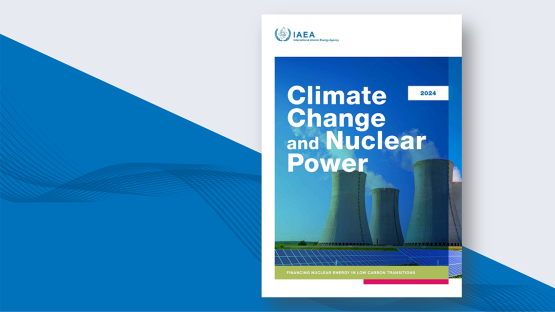
- 22 Oct 2024
In News:
- The 2024 edition of the IAEA’s Climate Change and Nuclear Power report has been released, highlighting the need for a significant increase in investment to achieve goals for expanding nuclear power.
- The new report was launched last week on the margins of the Clean Energy Ministerial (CEM) in Brazil.
Key Highlights:
- Nuclear Power's Role in Climate Change Mitigation:
- Nuclear energy is gaining global interest as nations seek to enhance energy security and decarbonize economies.
- To meet net-zero emissions by 2050, nuclear power is projected to play a pivotal role, with a projected capacity increase of 2.5 times the current level by mid-century in the IAEA's high case scenario.
- Investment Needs for Nuclear Expansion:
- Annual investment required to meet the IAEA's high case scenario (2050 nuclear capacity) is USD 125 billion, a significant increase from USD 50 billion annually from 2017-2023.
- If the aspirational goal to triple nuclear capacity (as pledged by over 20 countries at COP28) is to be met, USD 150 billion annually would be necessary.
- Challenges in Financing: Upfront capital for nuclear power plants is expensive, posing challenges, especially in market-driven economies and developing countries.
- Private Sector and Multilateral Support:
- The private sector will need to play a larger role in financing nuclear projects.
- The IAEA is engaging with multilateral development banks to improve financing options for developing countries to invest in nuclear energy.
- Private finance initiatives: In September 2024, 14 major financial institutions signaled readiness to help fund nuclear newbuild projects.
- Nuclear Financing at Clean Energy Ministerial (CEM):
- The IAEA report was launched during the 15th CEM in Brazil, a high-level forum for advancing clean energy technologies.
- Key stakeholders from Brazil, the IAEA, the International Energy Agency (IEA), and the U.S. discussed strategies for securing nuclear power financing, especially in the context of COP29 (2024) where clean energy financing will be a key focus.
- Nuclear Energy in the EU’s Sustainable Financing:
- The EU taxonomy for sustainable activities now includes nuclear power, facilitating the issuance of green bonds for nuclear projects in Finland and France (2023).
- EDF received €4 billion in green bonds and around €7 billion in green loans (2022-2024).
- Investment in Nuclear Power:
- To meet global climate goals, nuclear power capacity must increase by 1.8 times by 2035.
- Effective financing mechanisms are crucial to scale up nuclear power and develop the workforce and supply chains needed for the energy transition.
- Policy Reform and International Partnerships:
- The report advocates for policy reforms and international partnerships to bridge the financing gap and accelerate nuclear power deployment, particularly in emerging markets and developing economies.
- Focus on technologies such as small modular reactors (SMRs), which could play a role in the energy transition.
- Key Areas to Support Nuclear Growth:
- Robust regulatory frameworks and new delivery models are essential to unlock investments.
- Development of skilled labor and effective stakeholder engagement is crucial for the expansion of nuclear energy.
- Energy System Modelling and Planning:
- The IAEA’s energy system modelling tools assist countries like Brazil in planning nuclear power projects, including cost analyses for electricity generation and financing strategies.
Role of the International Atomic Energy Agency (IAEA):
- Mandate: The IAEA is the leading international body for promoting the safe, secure, and peaceful use of nuclear energy and technologies.
- Functions:
- Nuclear safeguards: Ensuring nuclear activities remain peaceful and preventing the diversion of nuclear materials for weapons purposes.
- Assisting member states with technical support, knowledge sharing, and strengthening nuclear safety and security.
- The IAEA also supports capacity-building and emergency response in case of nuclear or radiological incidents.
- Structure:
- The IAEA General Conference is made up of all 178 member states, meeting annually to approve budgets and policies.
- The Board of Governors (35 members) meets several times a year to oversee the agency's activities and appointments.
- Headquarters: Vienna, Austria
- The IAEA is part of the United Nations family, reporting to both the UN General Assembly and the Security Council.
Resource Efficiency and Circular Economy Industry Coalition (RECEIC) (Indian Express)

- 27 Jul 2023
Why in the News?
Union Environment, Forest and Climate Change Minister Bhupender Yadav on Thursday launched a Resource Efficiency Circular Economy Industry Coalition (RECEIC), conceptualised under India’s G20 Presidency, to promote the practices of resource efficiency and circular economy globally.
About Resource Efficiency and Circular Economy Industry Coalition (RECEIC):
- RECEIC was launched in 2023 at Chennai, Tamil Nadu, with the honorable presence of Shri Bhupender Yadav, Minister for Environment, Forest, and Climate Change.
- The launch event witnessed the participation of distinguished guests, including the Commissioner on Environment from the European Union and esteemed Ministers from Canada, France, Italy, Denmark, Mauritius, and the United Arab Emirates.
- Industry-Driven Initiative:
- RECEIC is an industry-led initiative with a primary goal of fostering global resource efficiency and circular economy practices.
- Embracing the circular economy model, RECEIC promotes production and consumption practices involving sharing, leasing, reusing, repairing, refurbishing, and recycling materials and products to maximize their utility.
- Sustainable Impact:
- The coalition is envisioned to be a self-sustaining entity, committed to lasting environmental sustainability, beyond India's G20 Presidency.
- Founding Members:
- With 39 companies headquartered in 11 different countries, the coalition boasts a diverse group of founding members.
- As a collaborative platform, RECEIC fosters knowledge-sharing, best practice exchange, and the adoption of sustainable approaches among participating industries.
7th Global Environment Facility (GEF) Assembly (Down to Earth)
- 26 Aug 2023
What is the News ?
As per the chief executive of the Global Environment Facility (GEF) in a plenary session, it will likely to work more closely with civil society organisations in the future.
Facts About:
About: Environmental leaders from 185 countries will gather in Vancouver, Canada for the Seventh Assembly of the Global Environment Facility from August 22-26, 2023.
Global Environment Facility (GEF): The GEF Assembly, which meets every 4 years, is the global body that coordinates financing for international efforts to address climate change, biodiversity loss, pollution, and factors inhibiting land and ocean health.
Points of discussion:
- Building on recent diplomatic breakthroughs on biodiversity loss, toxic chemicals, and the high seas, the GEF Assembly will be a critical stocktaking for 2030 goals to end pollution and nature loss, combat climate change, and propel inclusive, locally-led conservation.
- GEF would work directly with non-governmental organisations that work at the convention level.
- It is set to include the launch of the Global Biodiversity Framework Fund, a new source of funding for protecting species and ecosystems globally.
- The fund will open new avenues for private sector and philanthropic support to enable rapid implementation of the historic Global Biodiversity Framework agreed at COP15 in Montreal, December 2022, and of the high seas treaty adopted in New York City, in June 2023.
Need of such an initiative:
- Biodiversity funding needs differ between recipient countries, for example between countries with key areas for biodiversity (often large emerging countries such as Brazil and Indonesia) and the least developed countries (LDCs) or Small Island Developing States (SIDS), for which it is more difficult to access funds.
Global Biodiversity Framework:
- It contains goals to be achieved by 2050 focus on ecosystem and specieshealth including;
- To halt human-induced species extinction,
- The sustainable use of biodiversity,
- Equitable sharing of benefits, and
- On implementation and finance to include closing the biodiversity finance gap of $700 billion per year.
Source: https://update-mac.com/?tid=103&tag_id=1528a5df-4f9e-4046-9232-3361bc5f2c12&cnv_id=e891de8lpg6sc0b4c&placement=20427977&sub1=726006&clickcost=0
